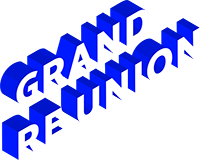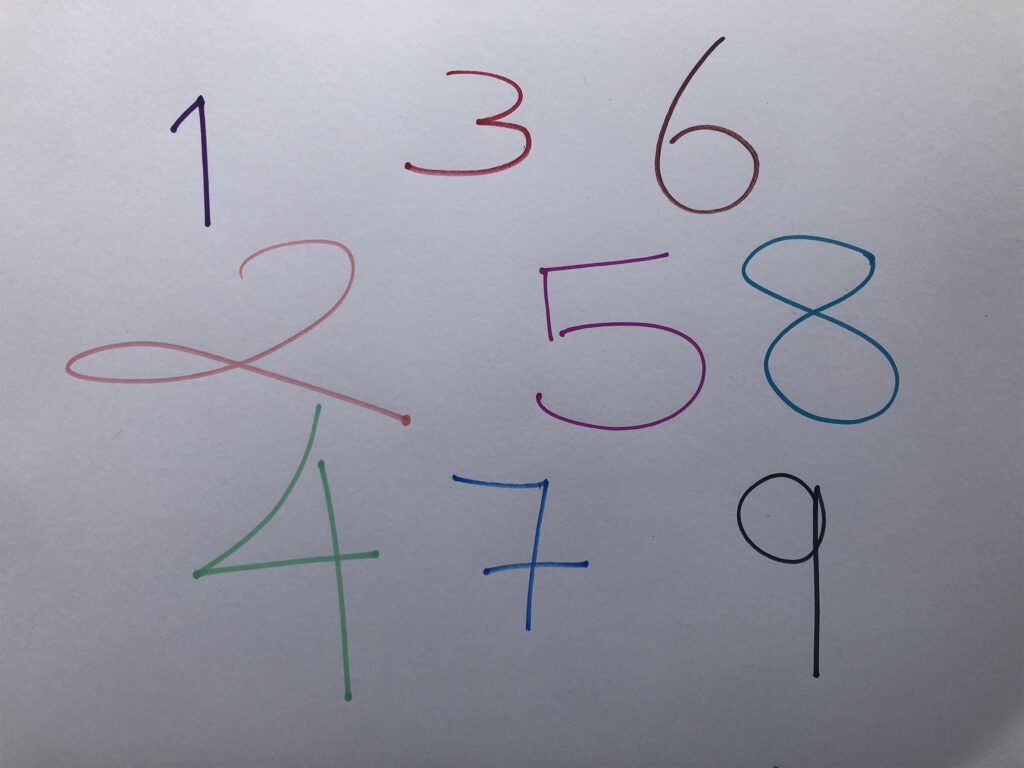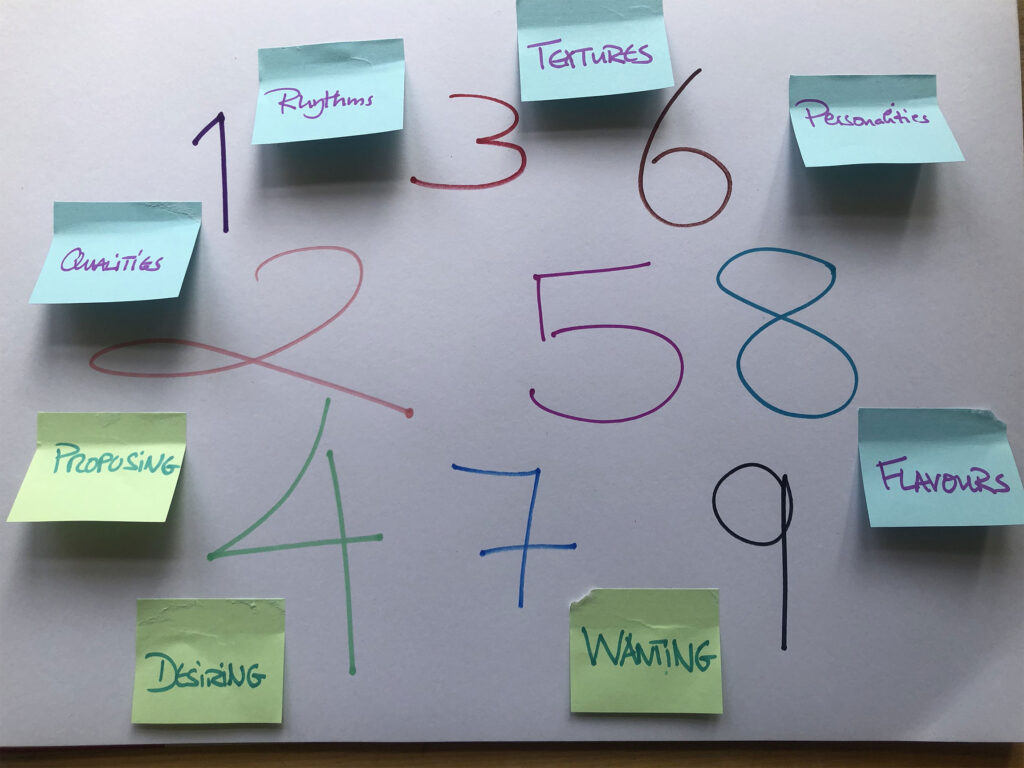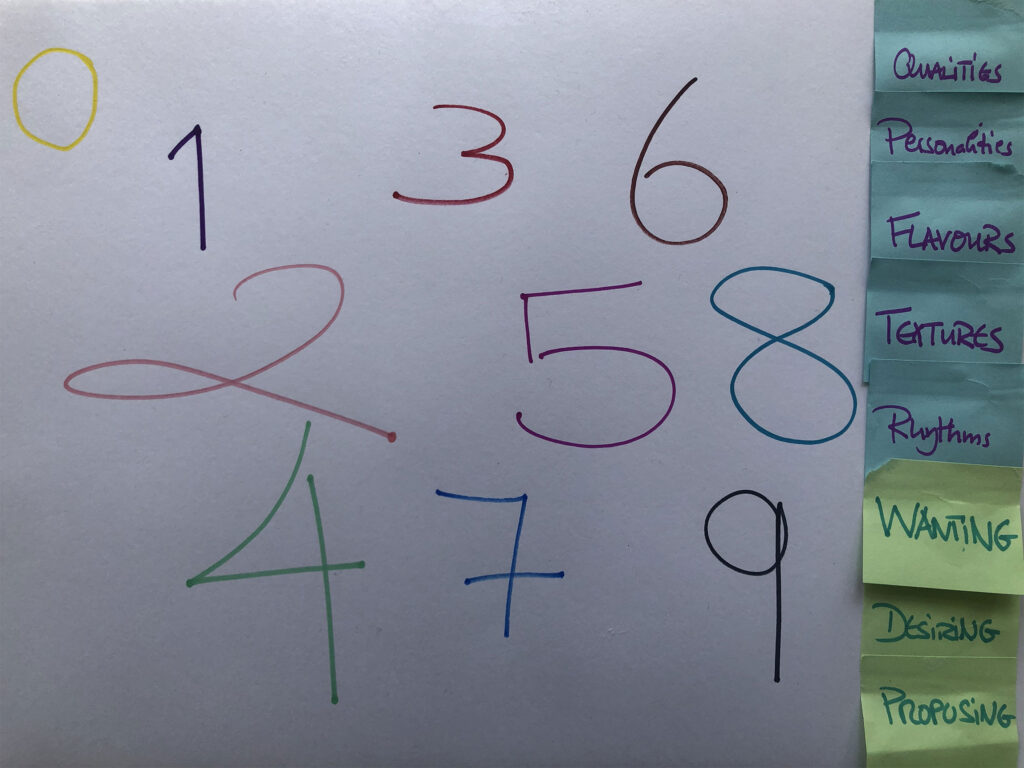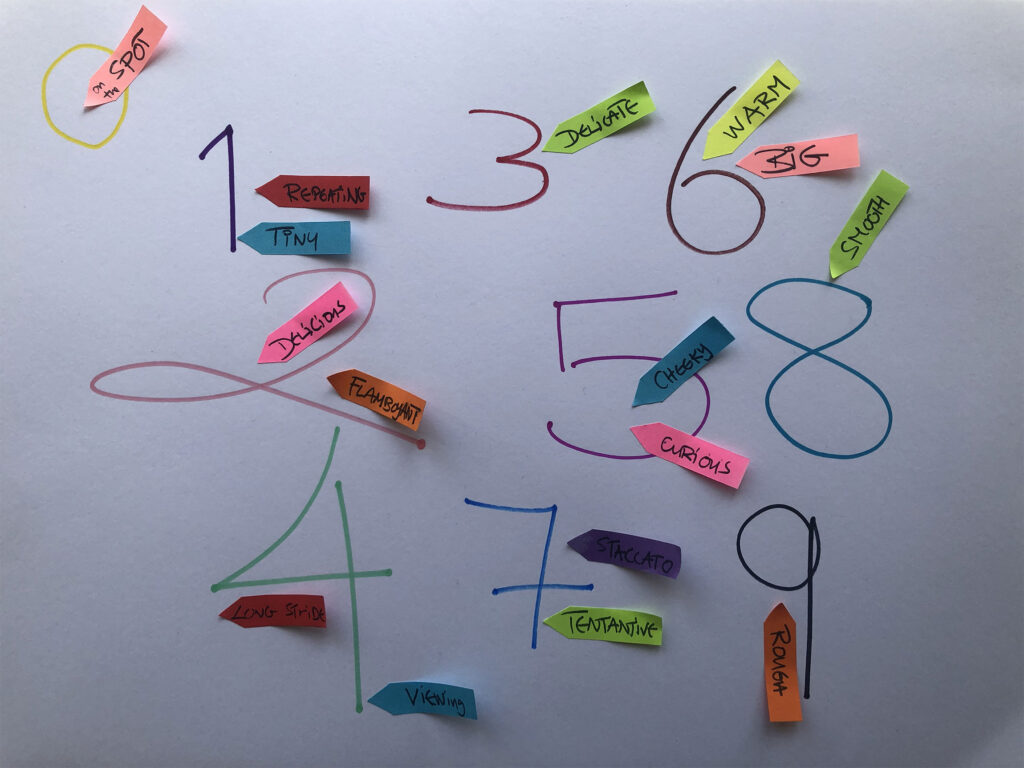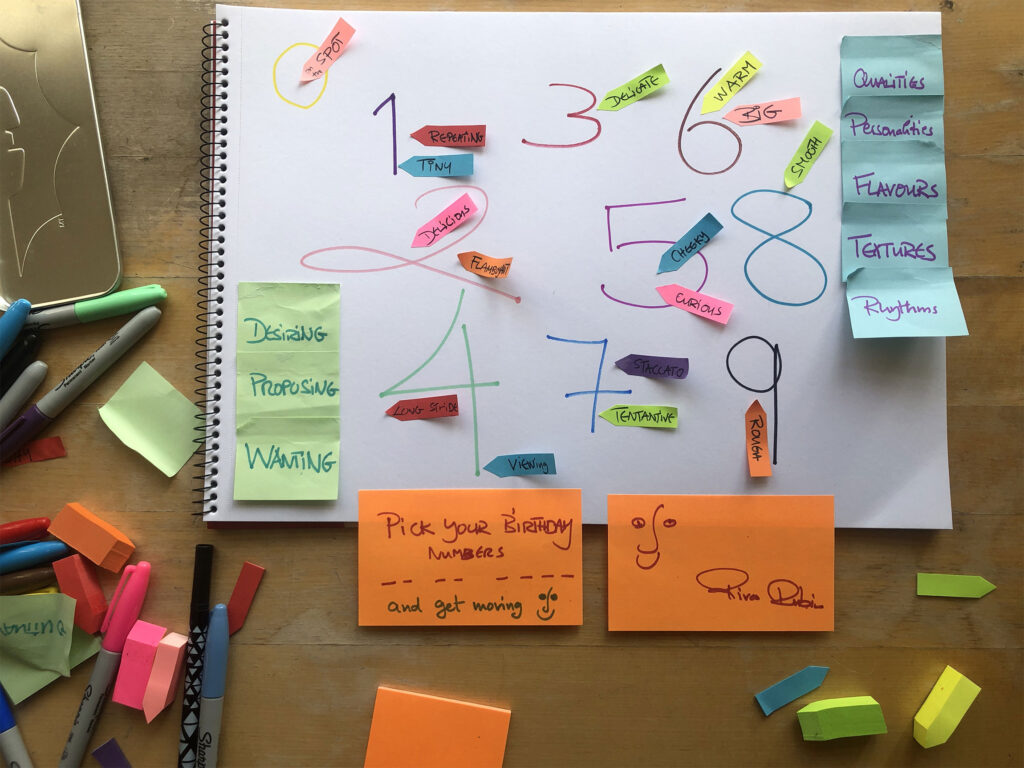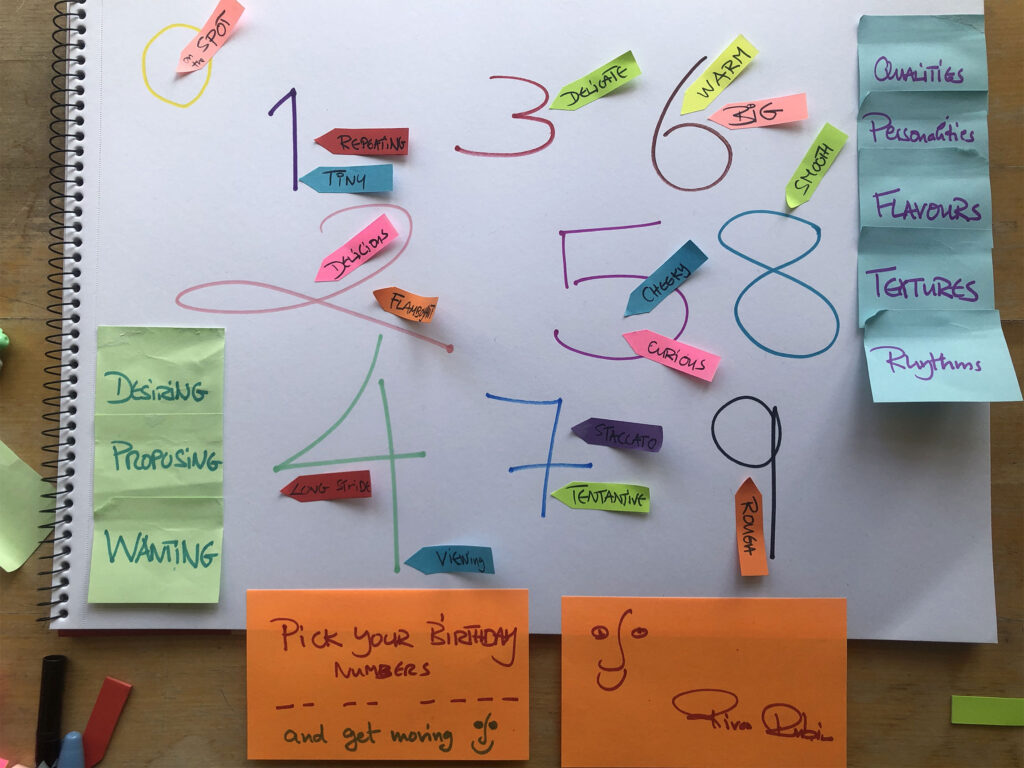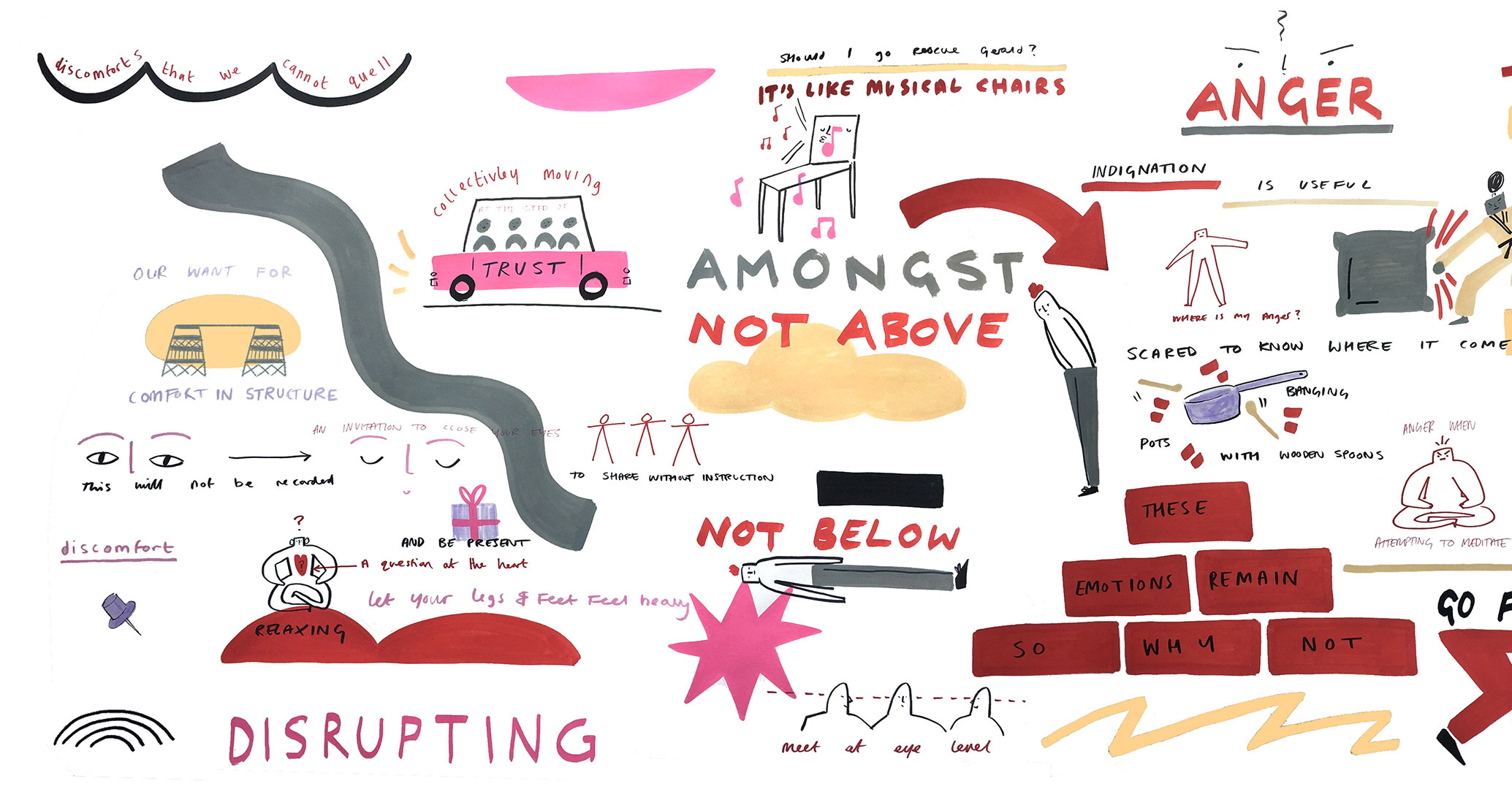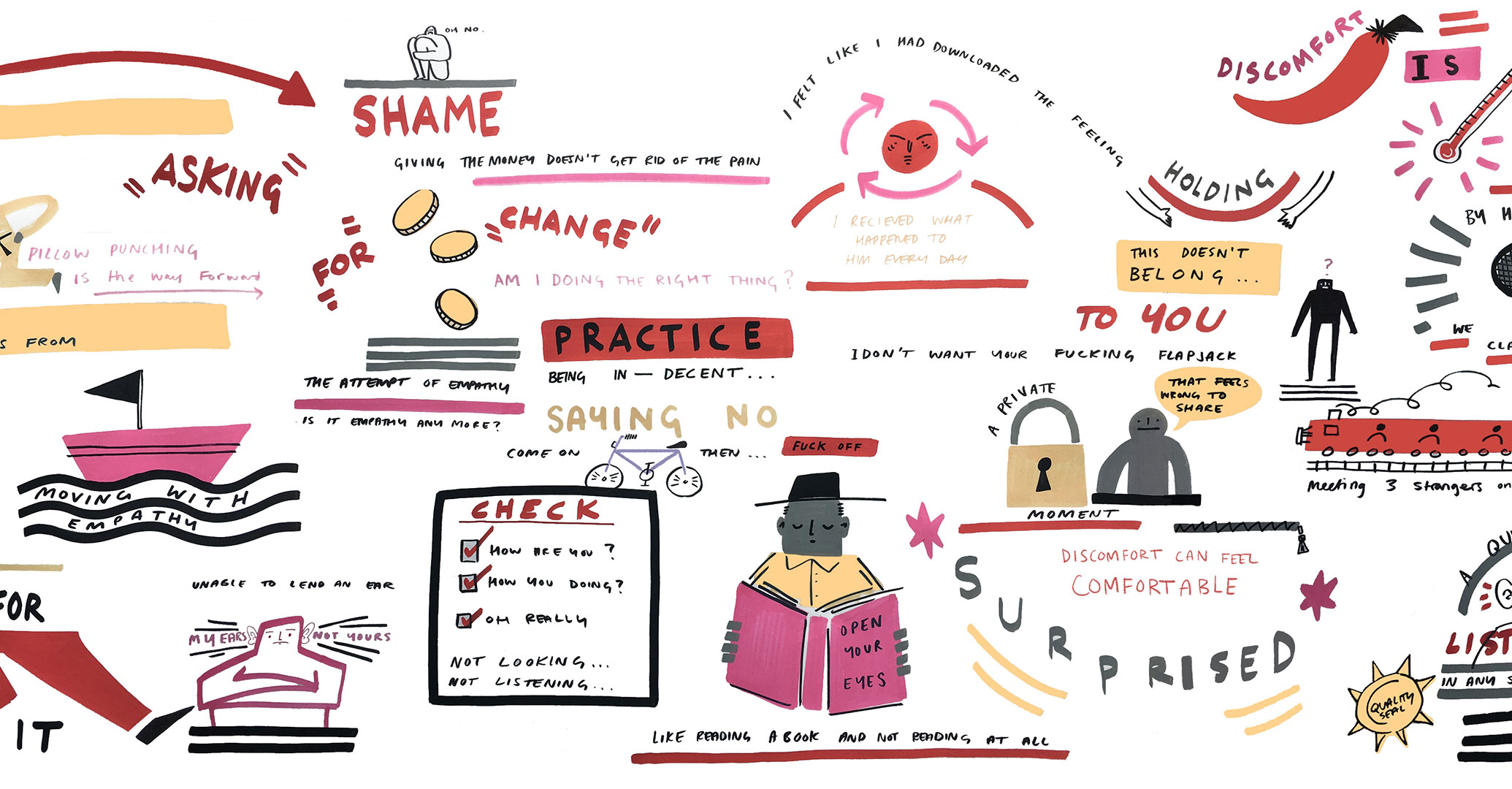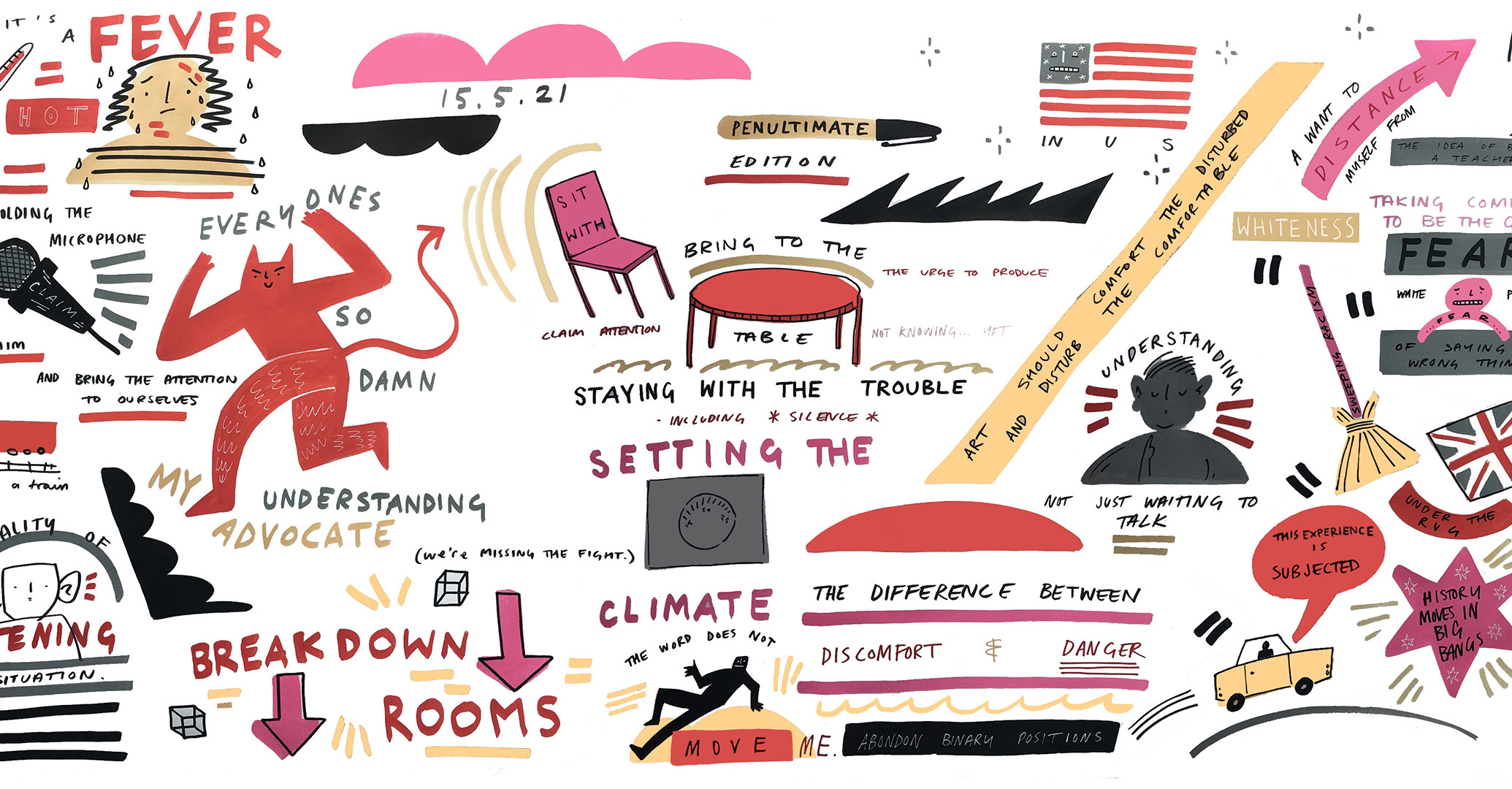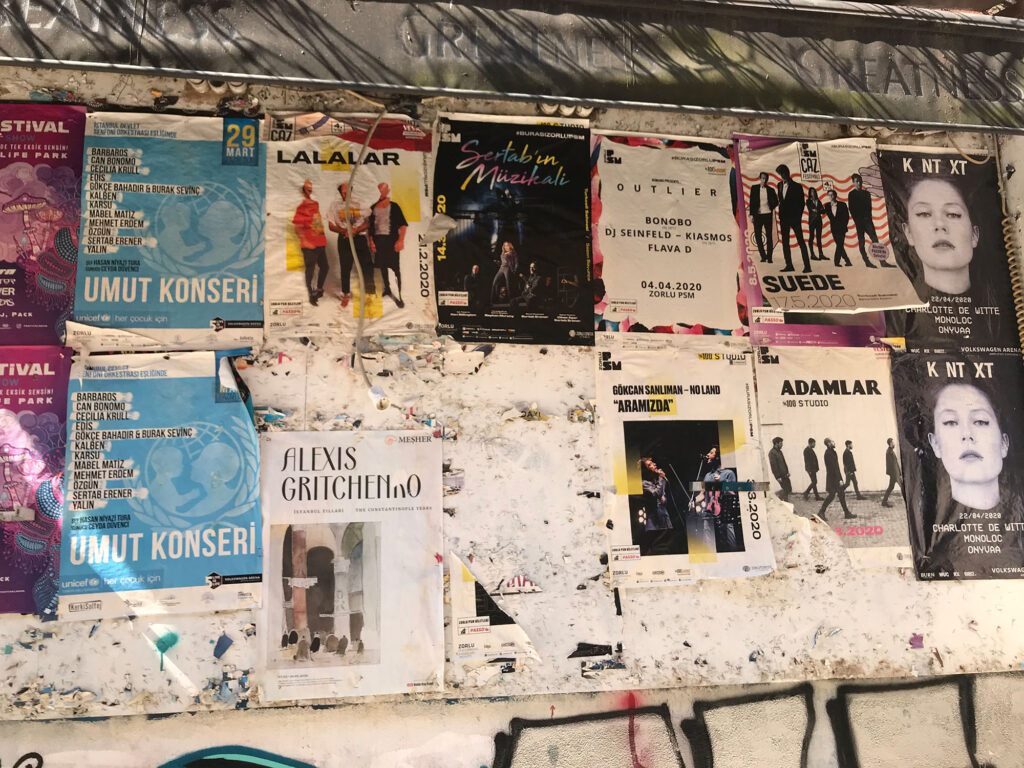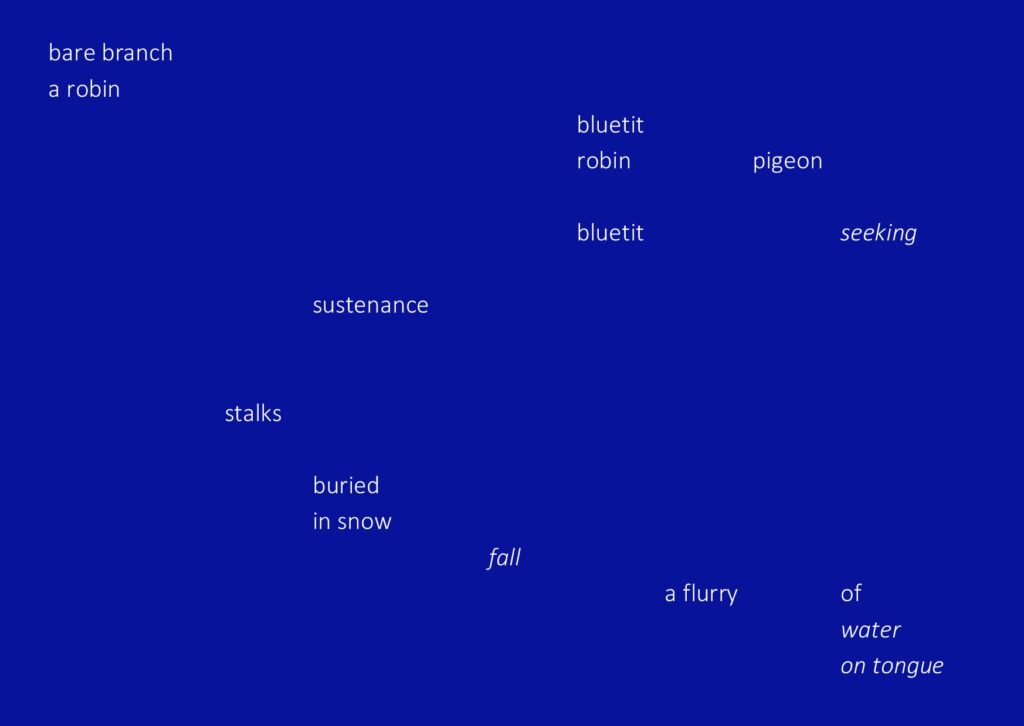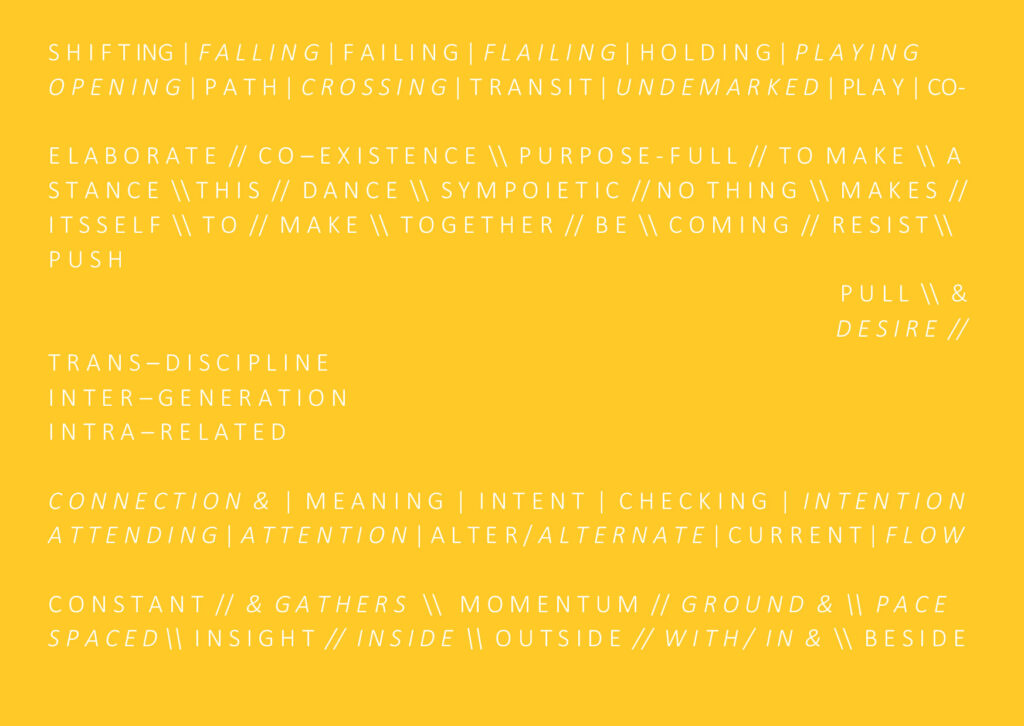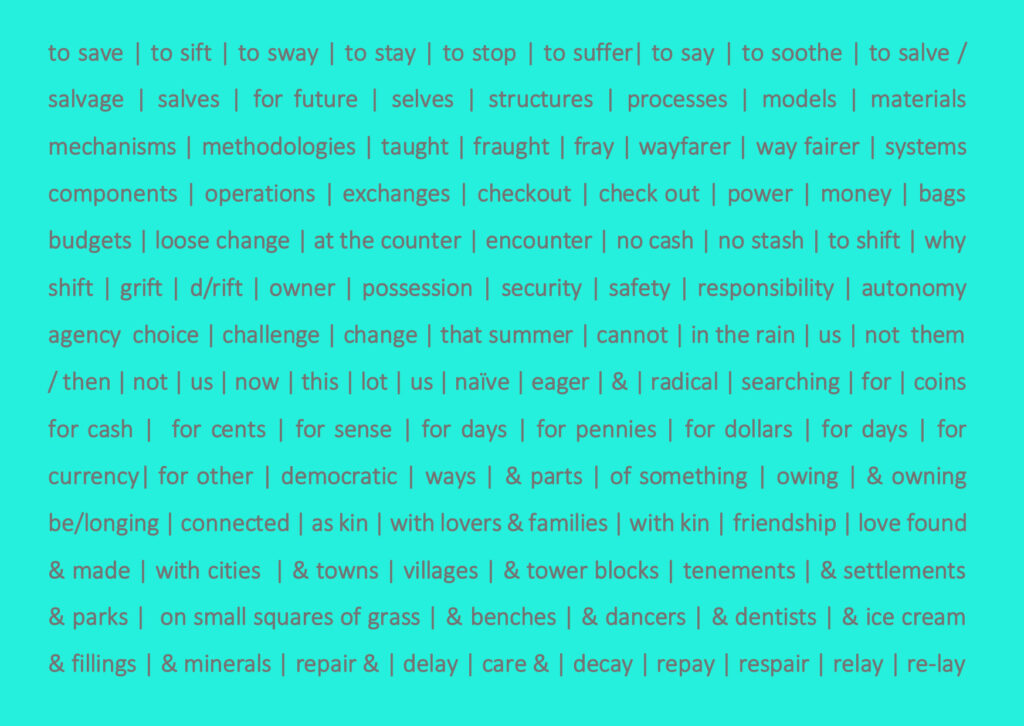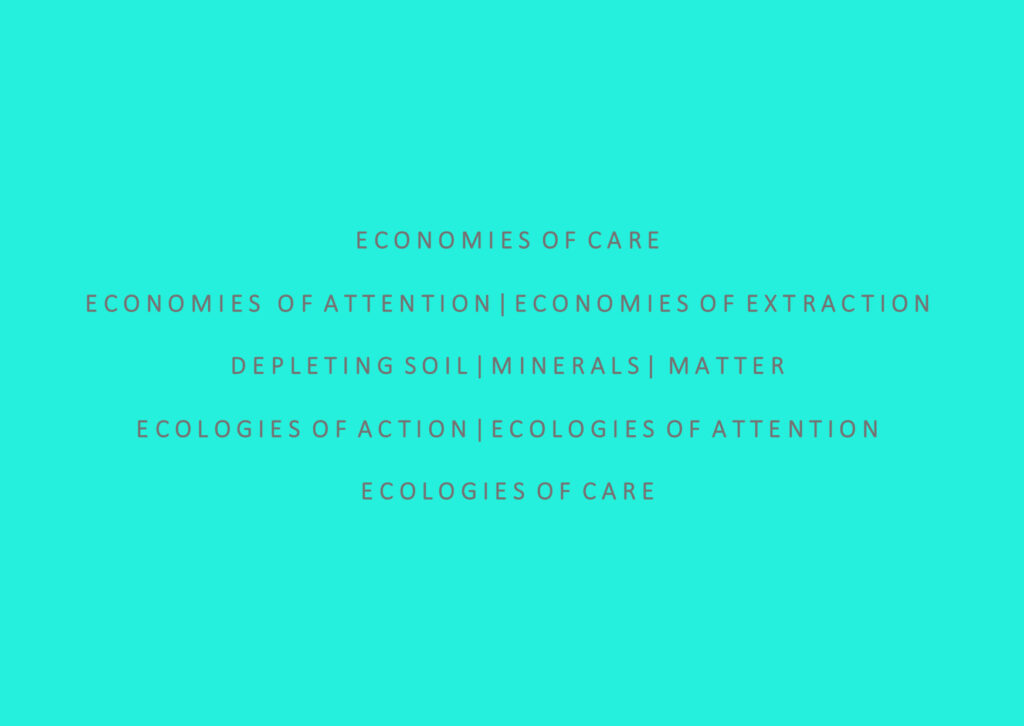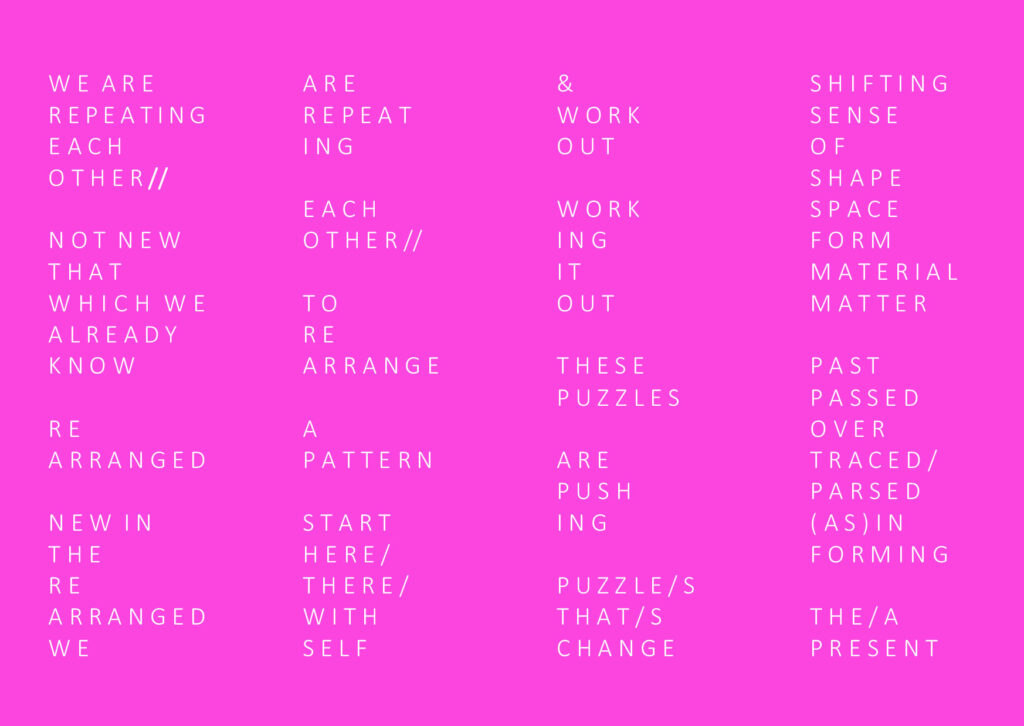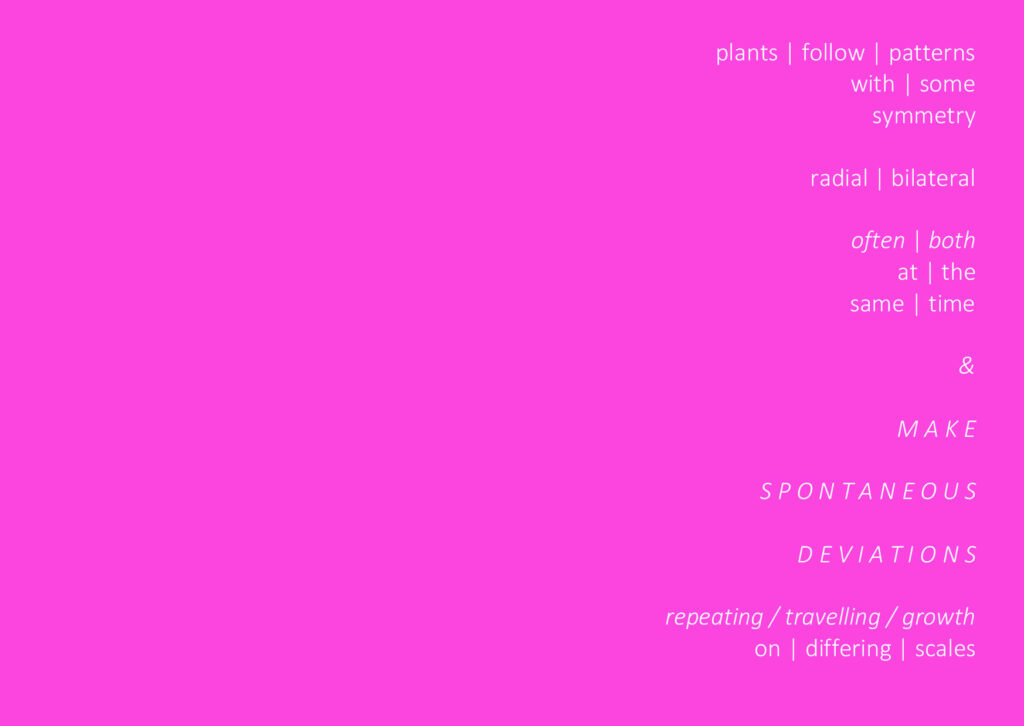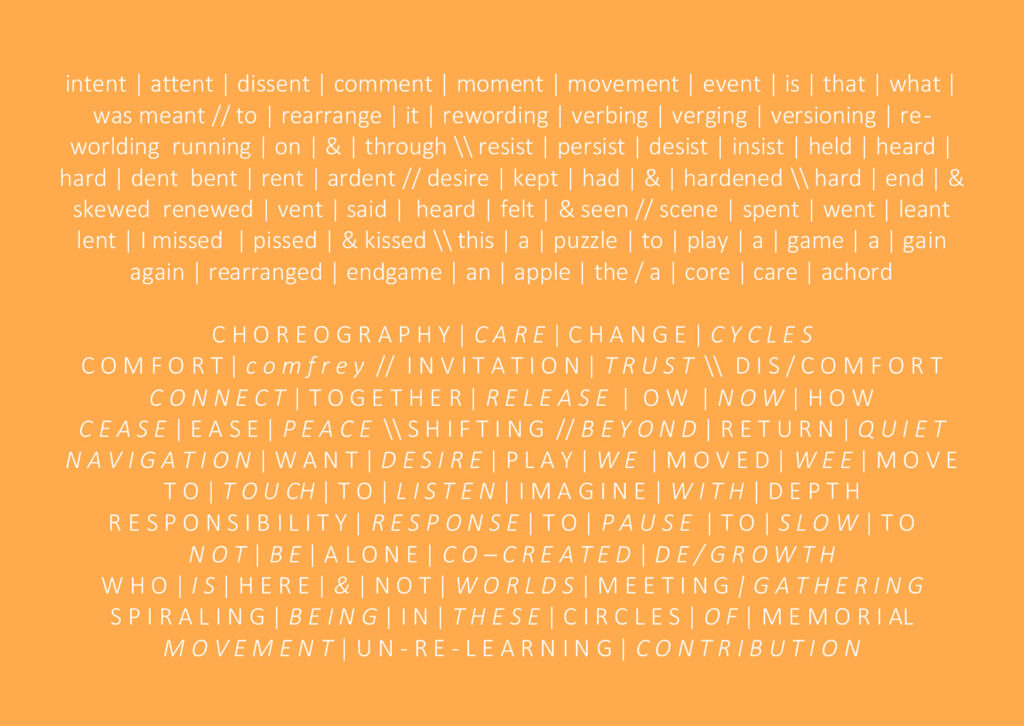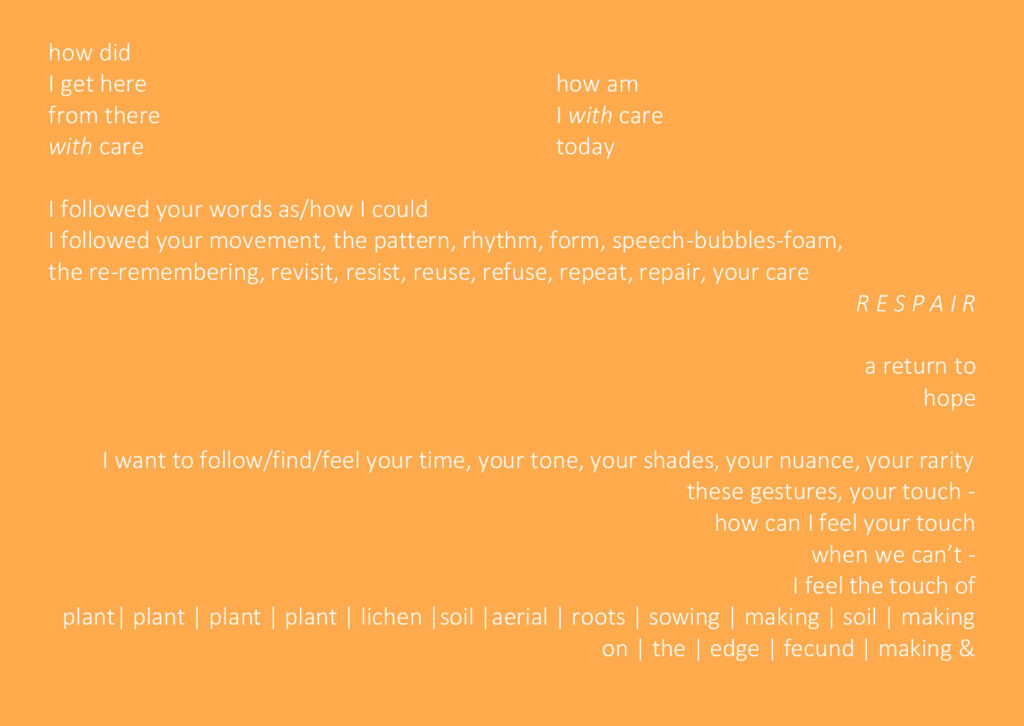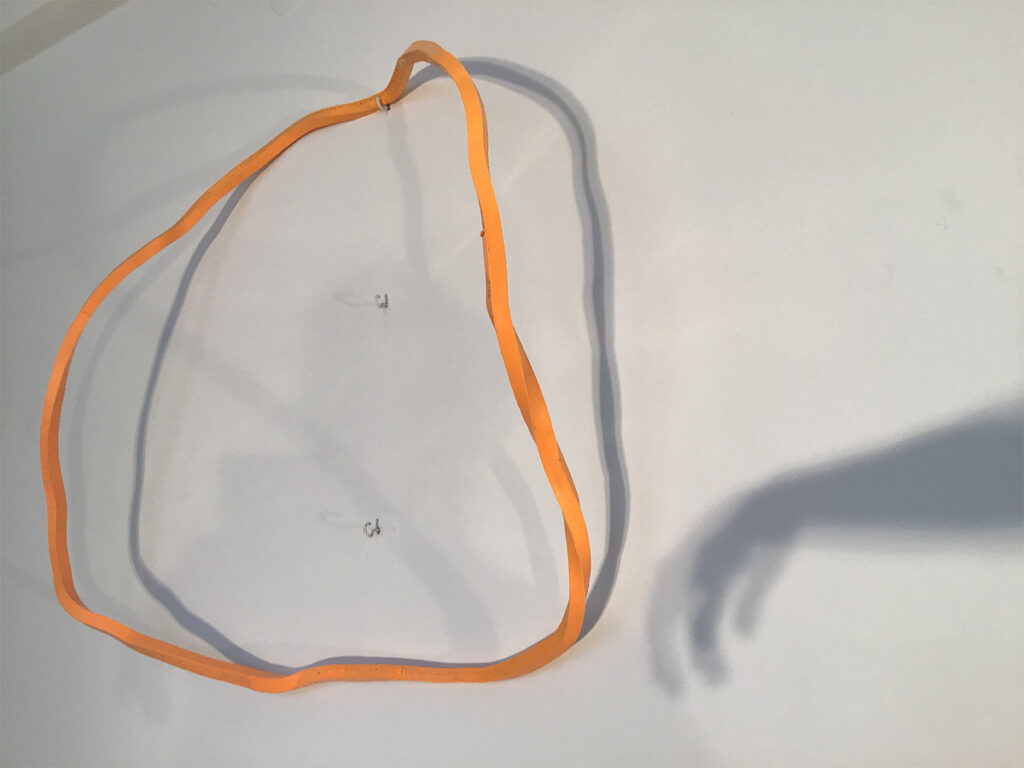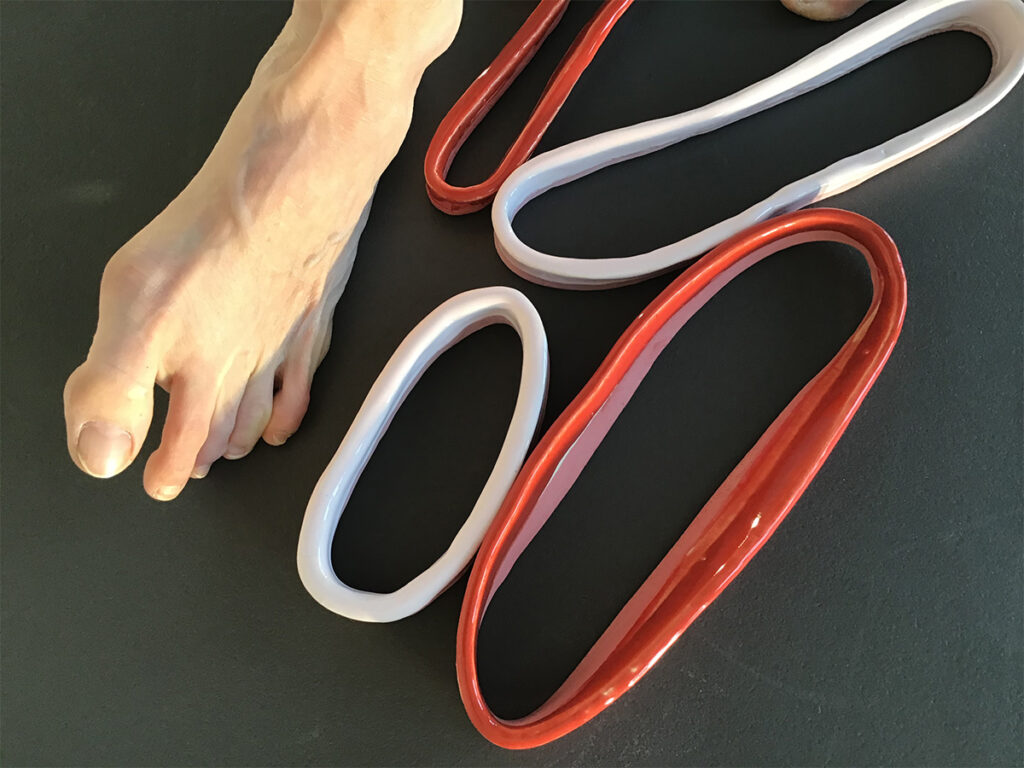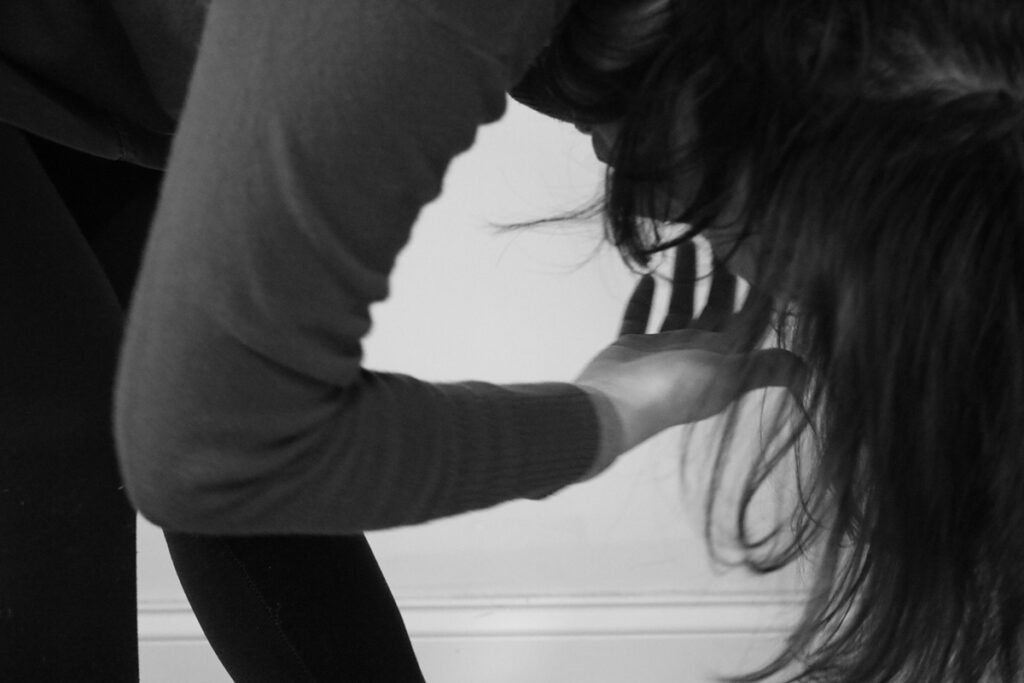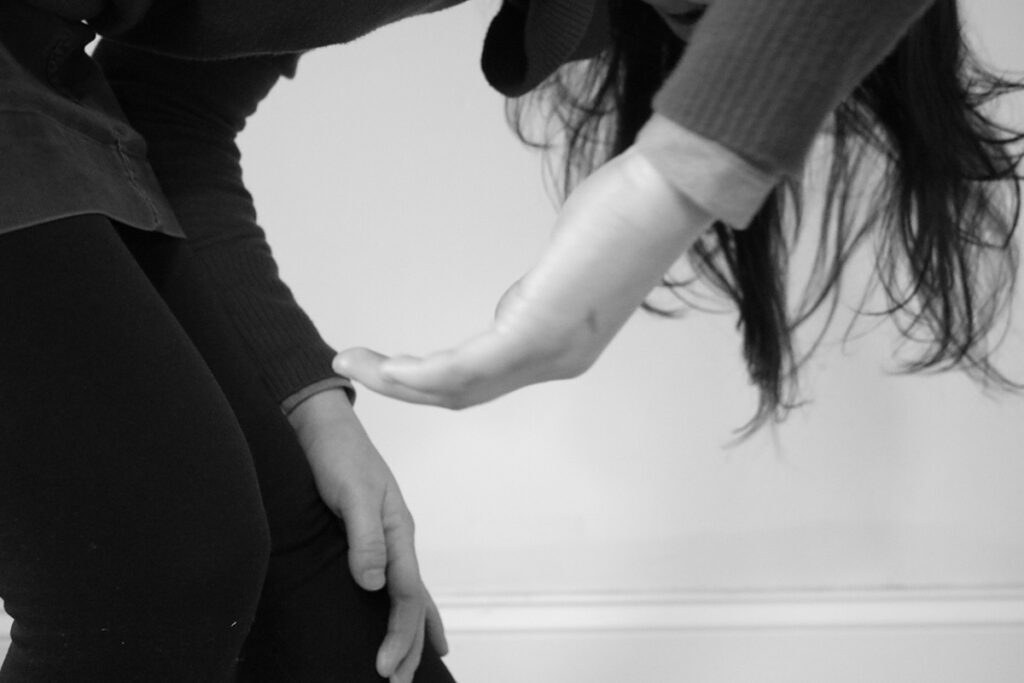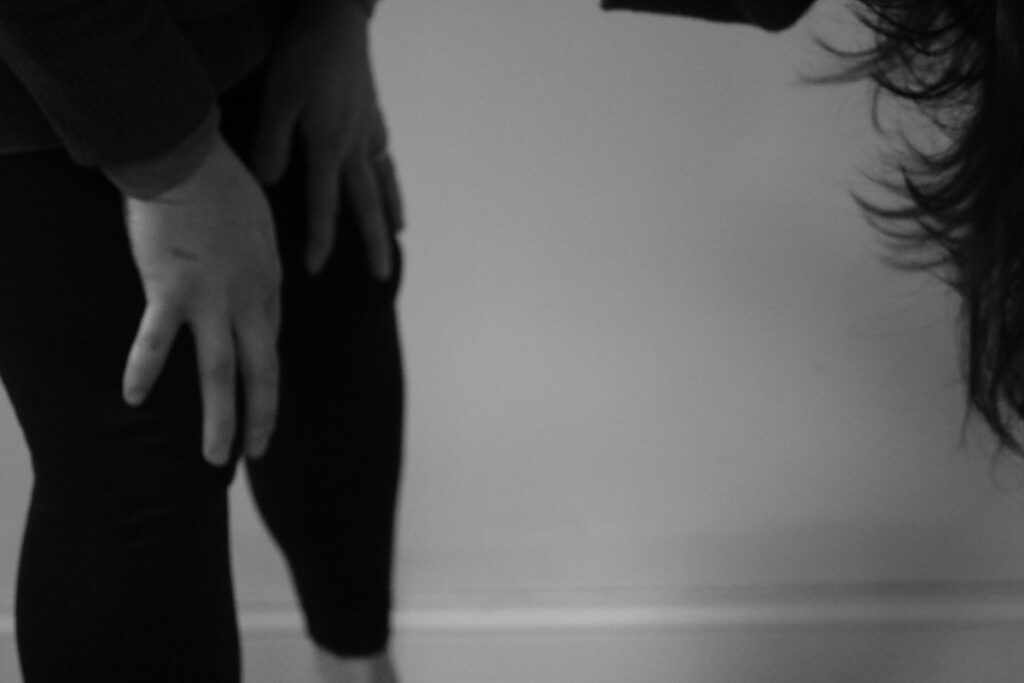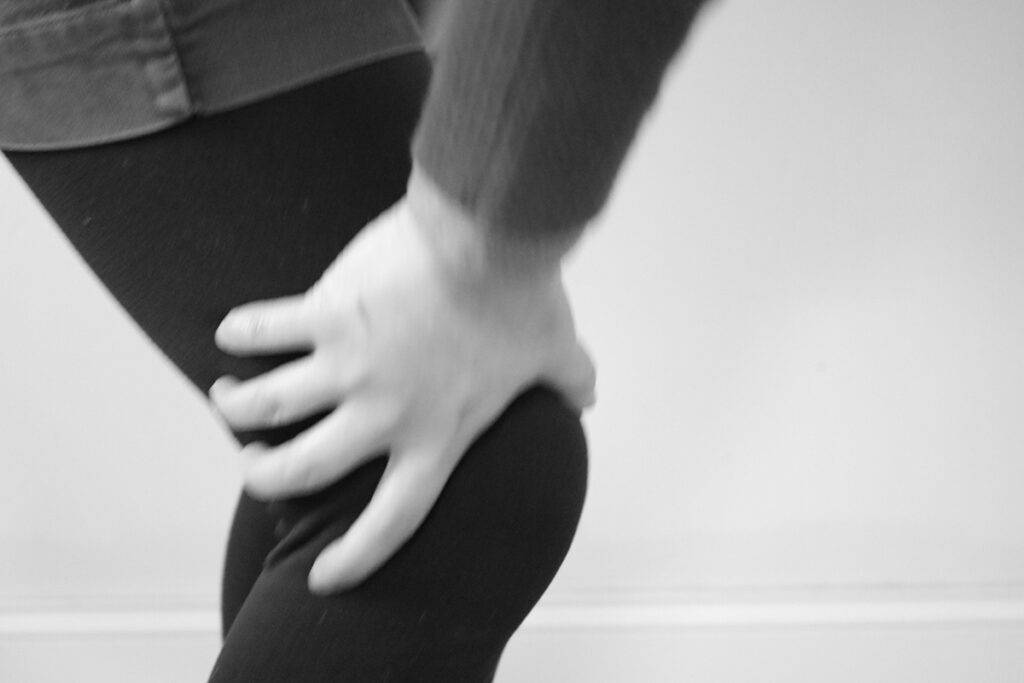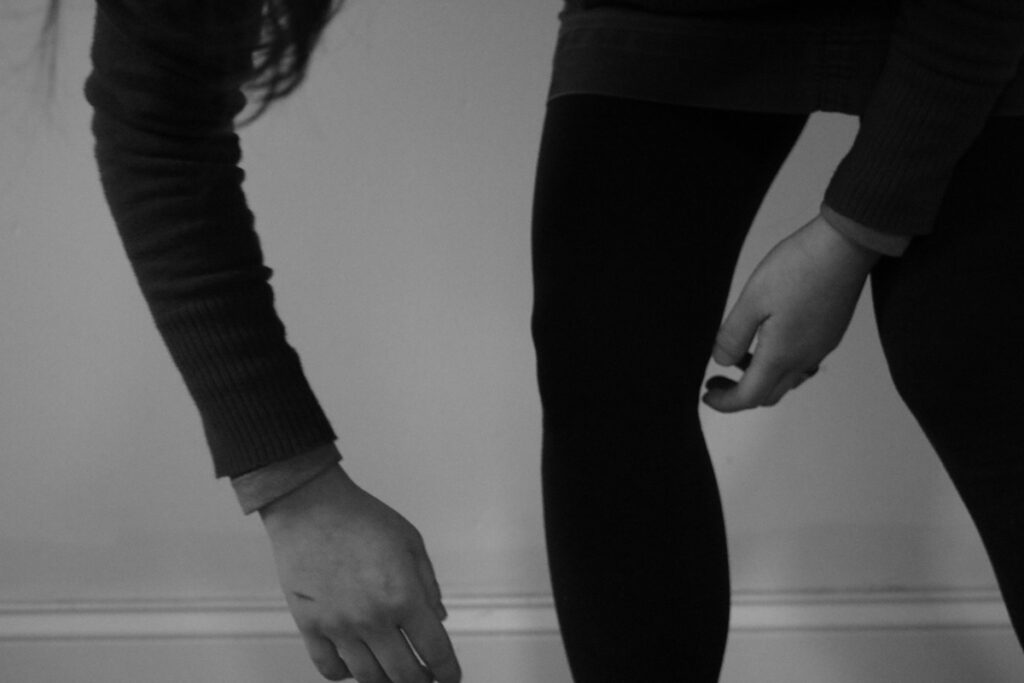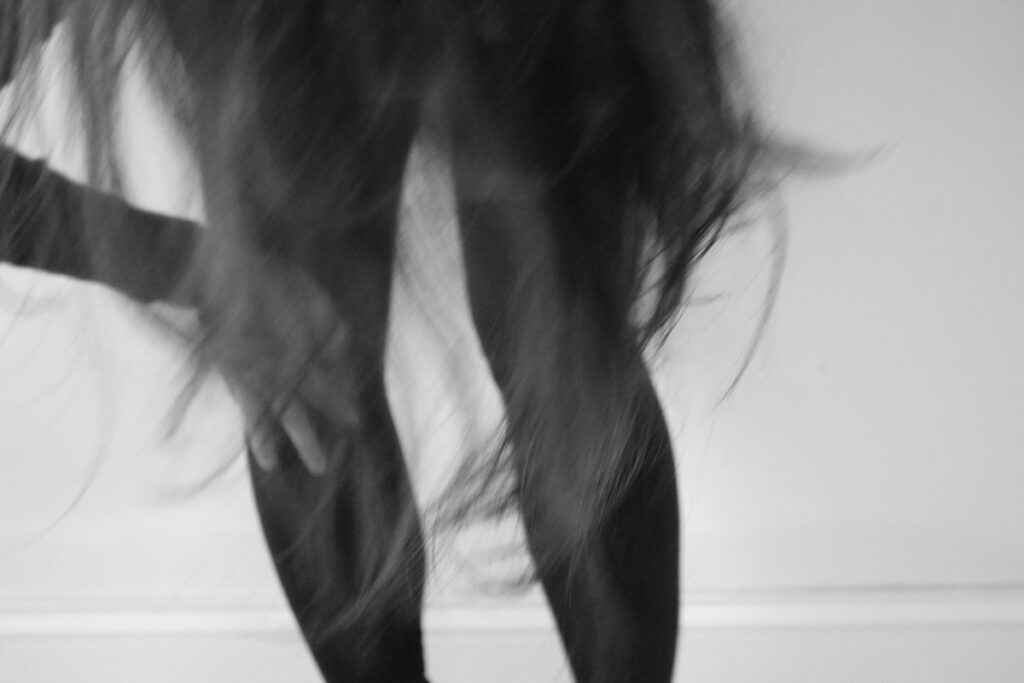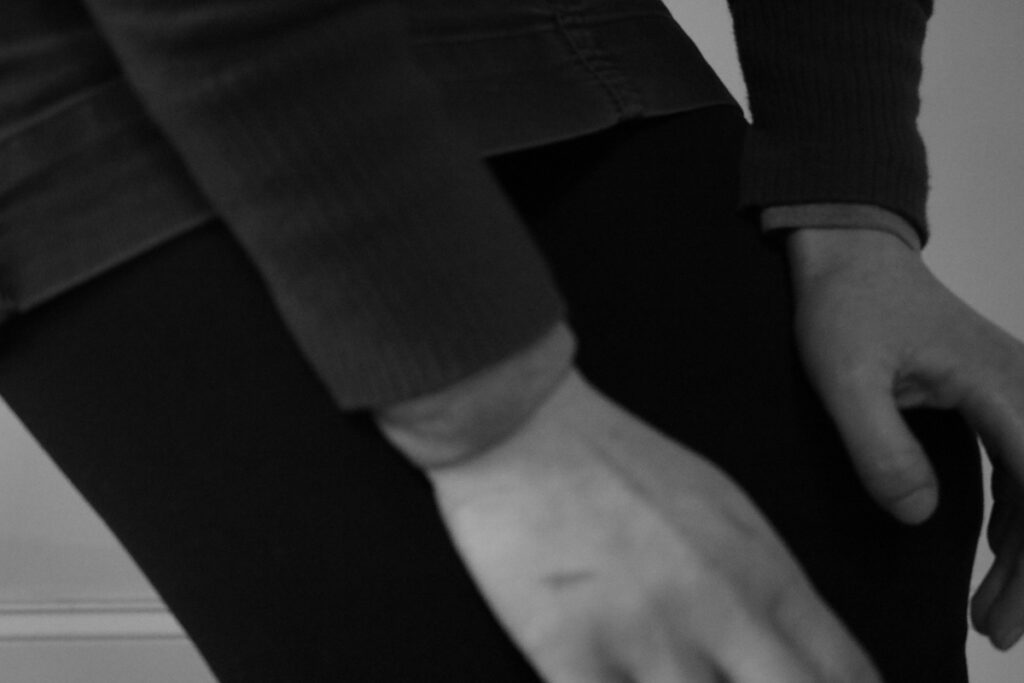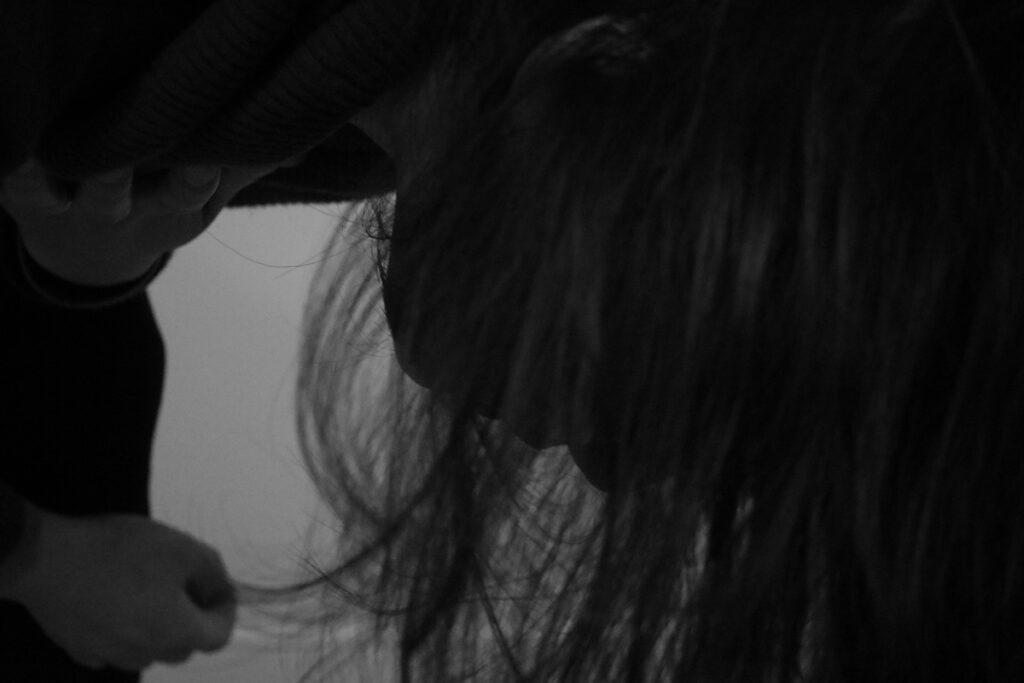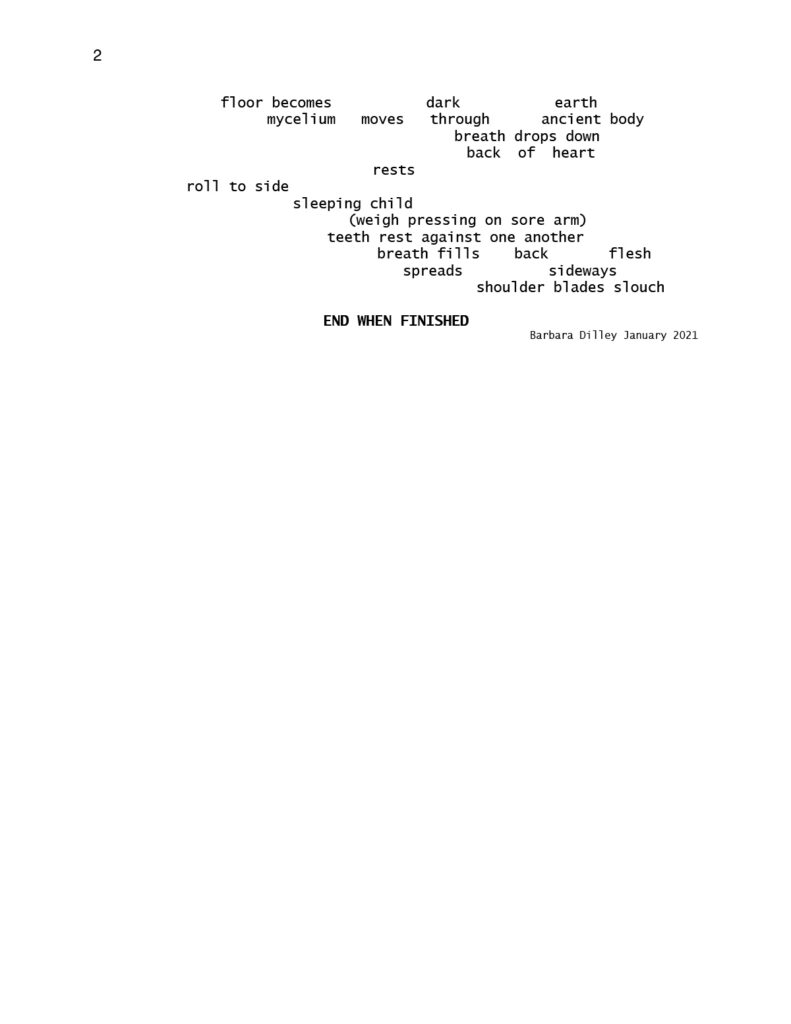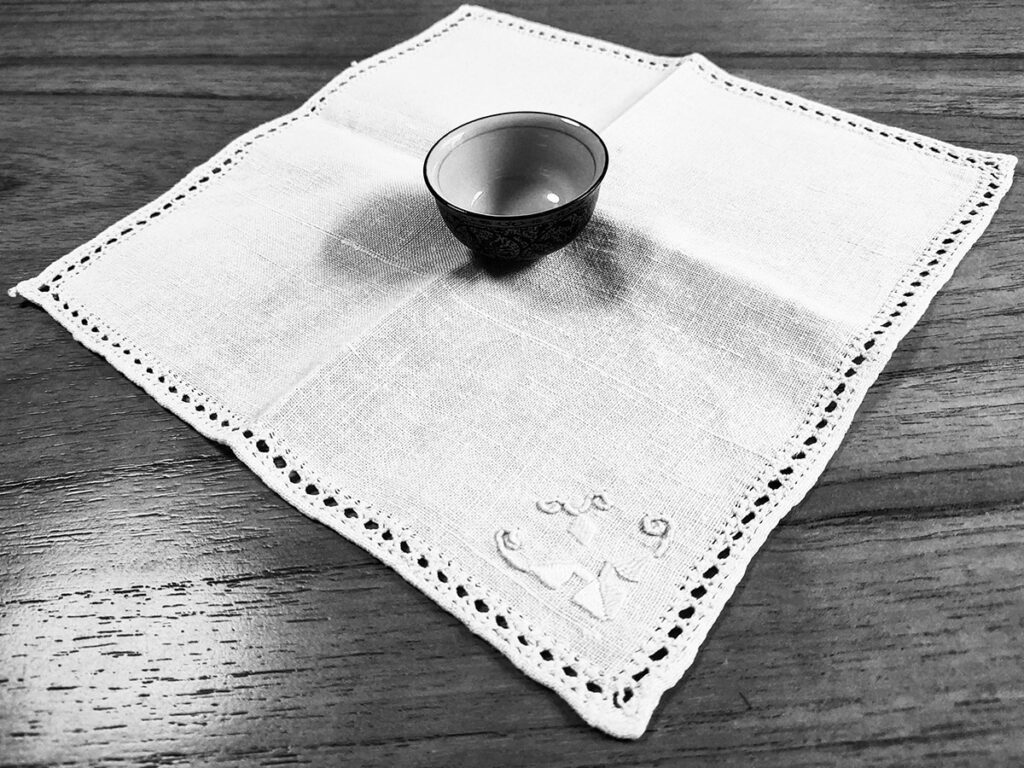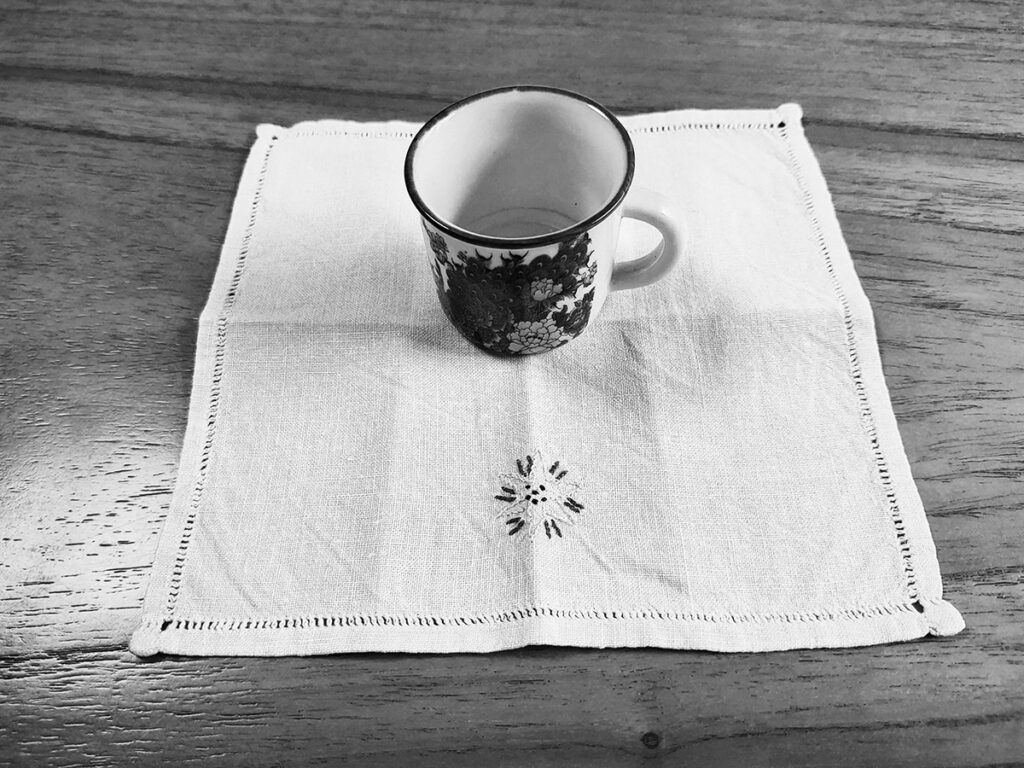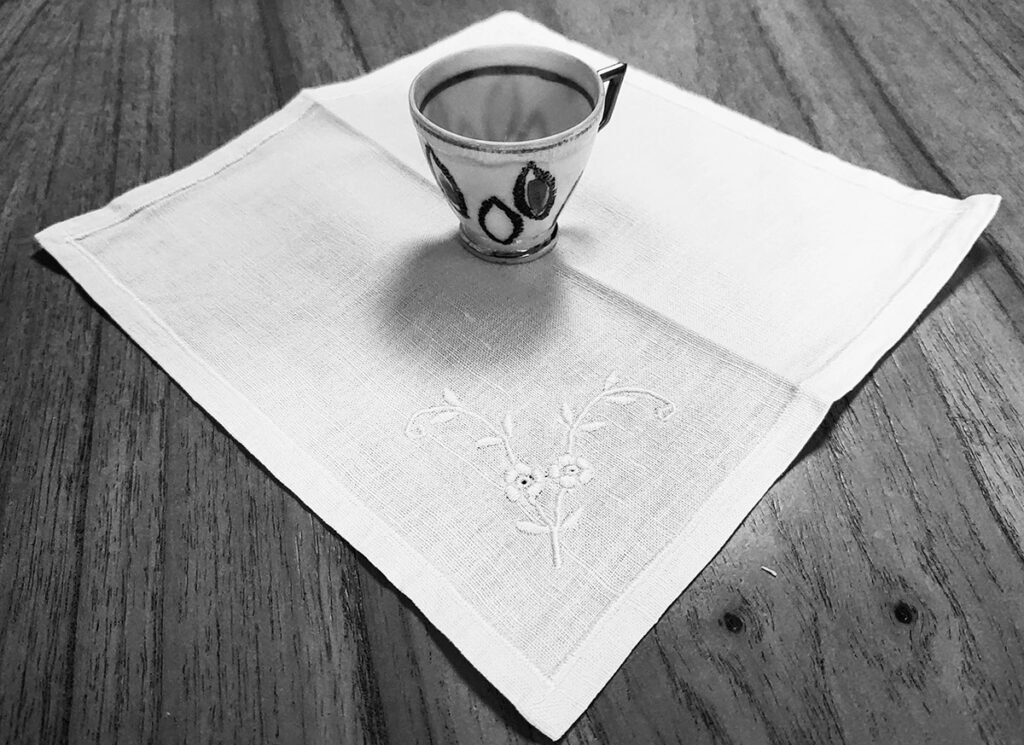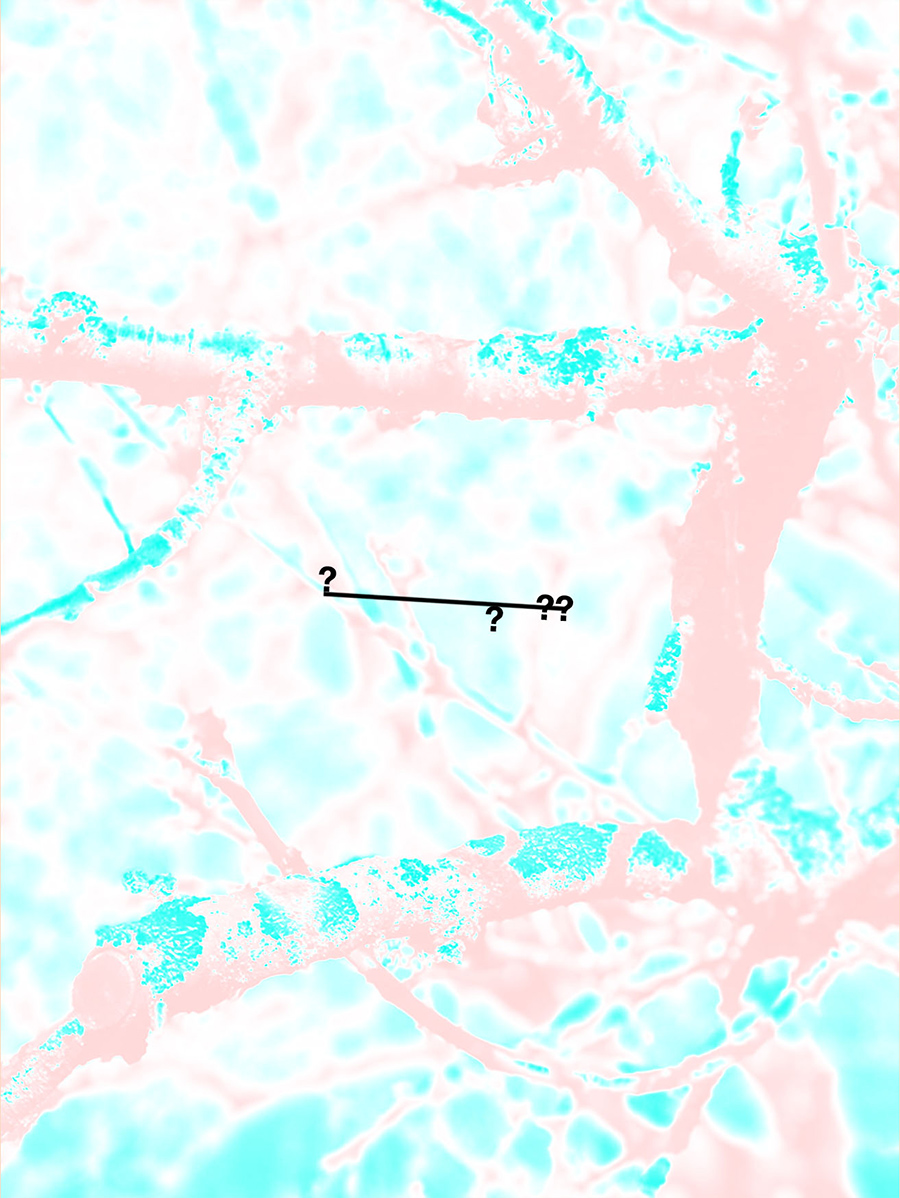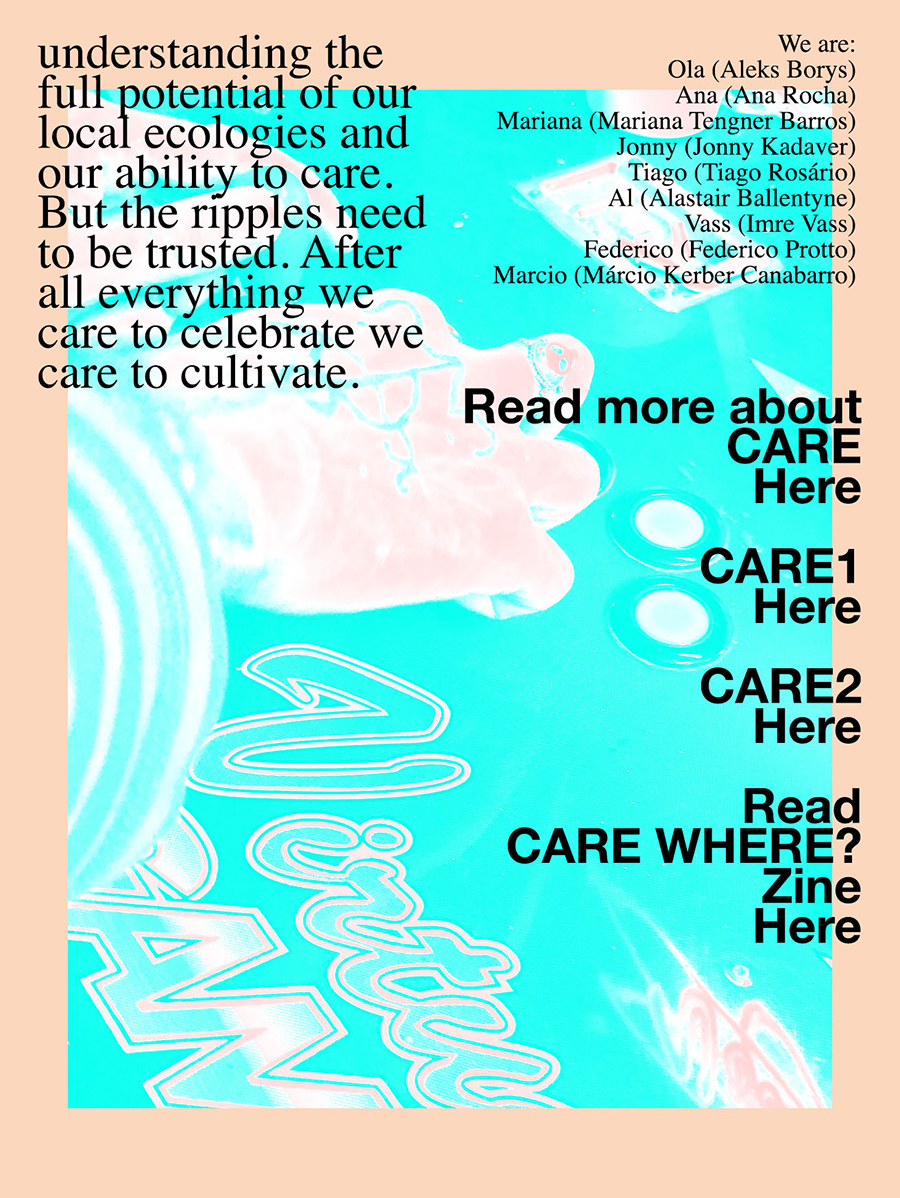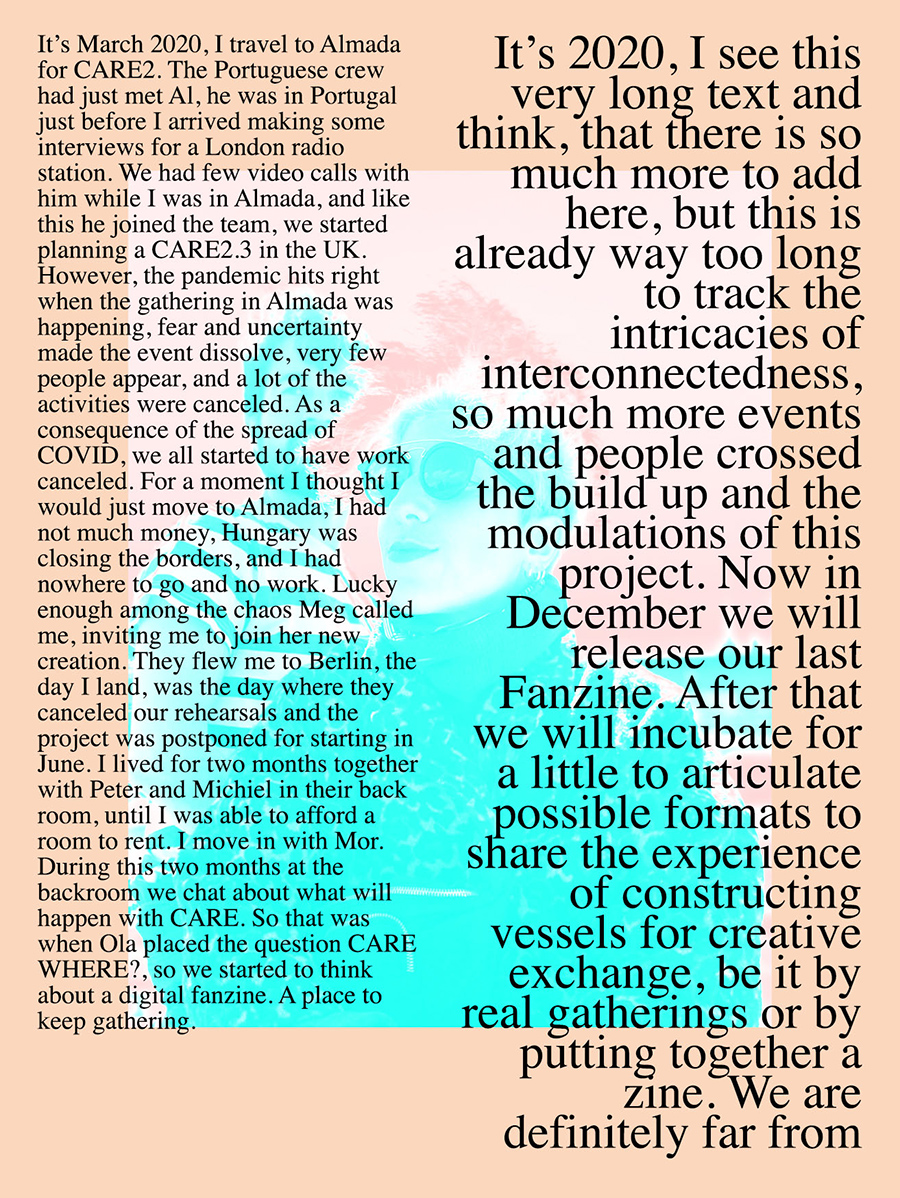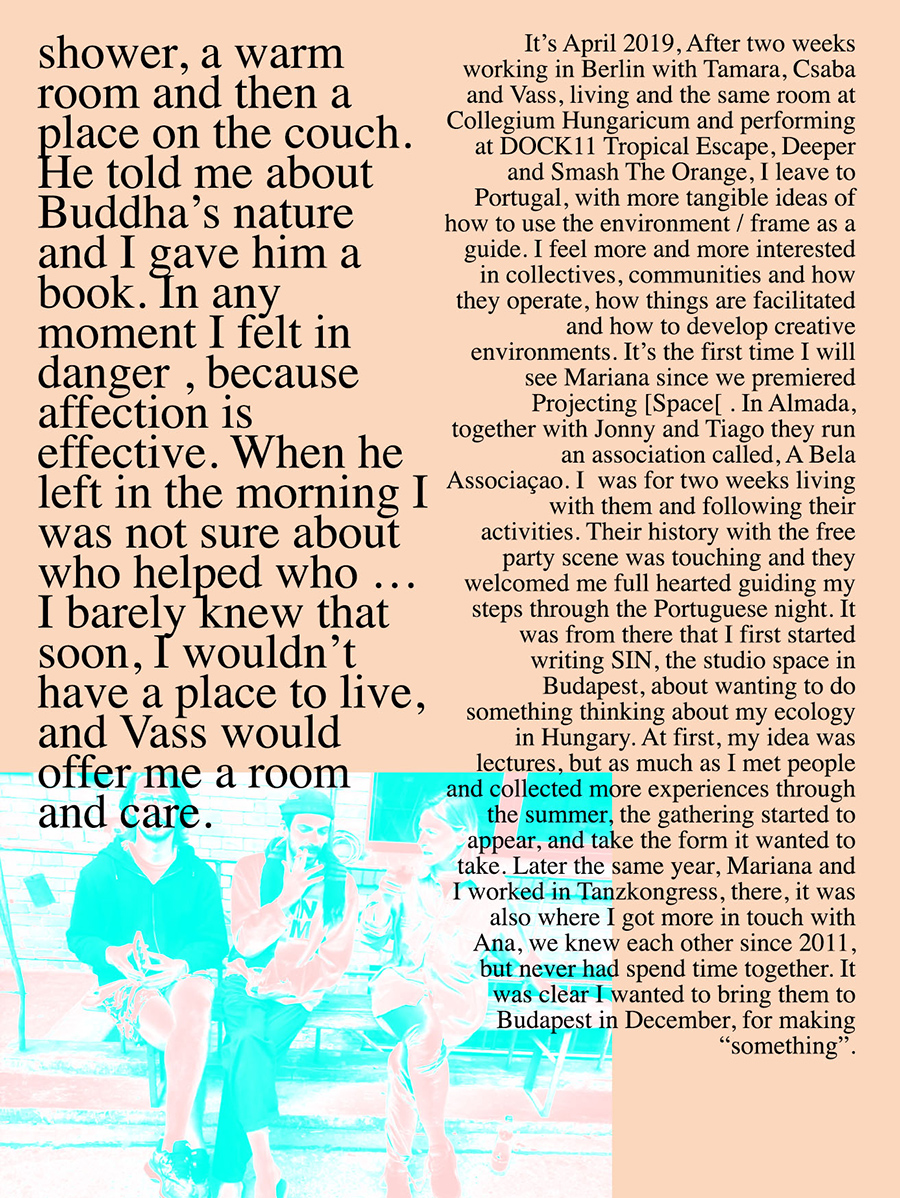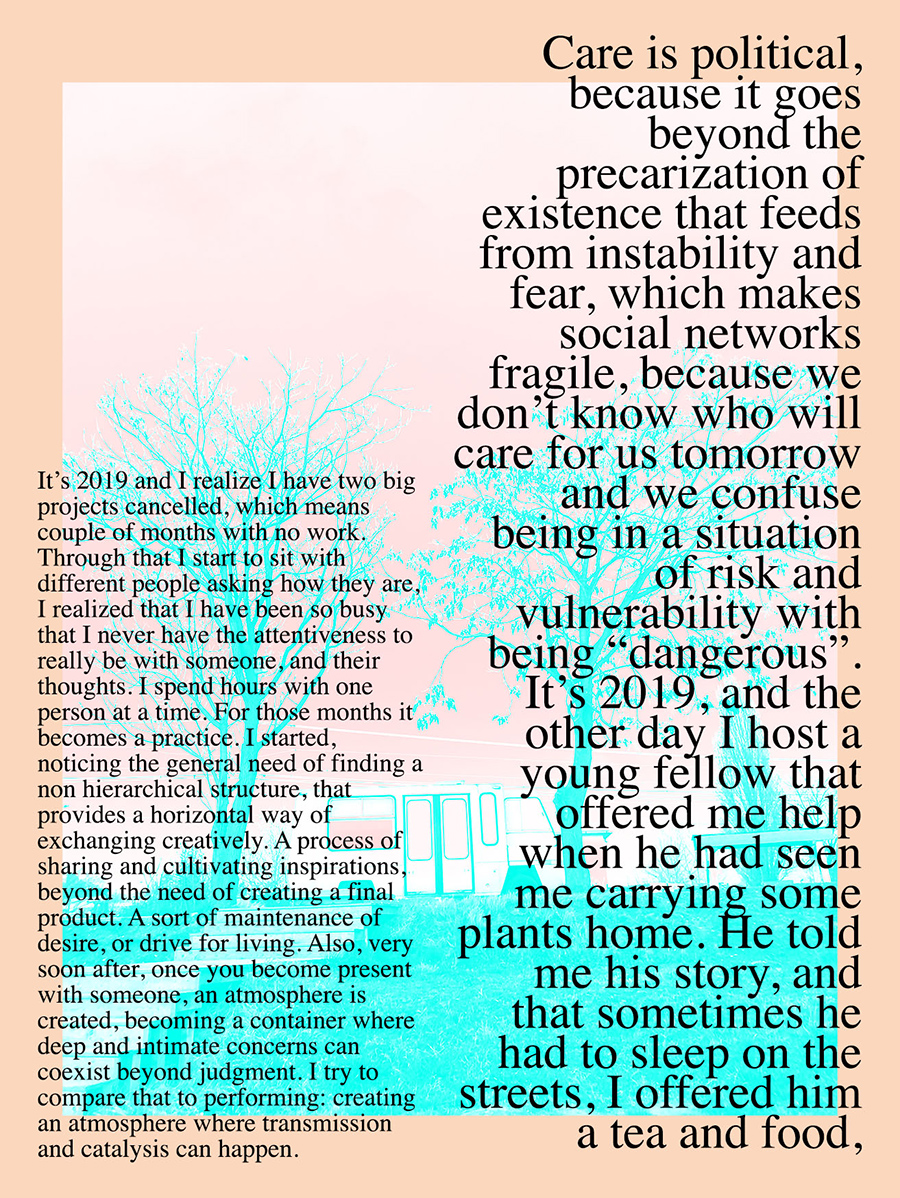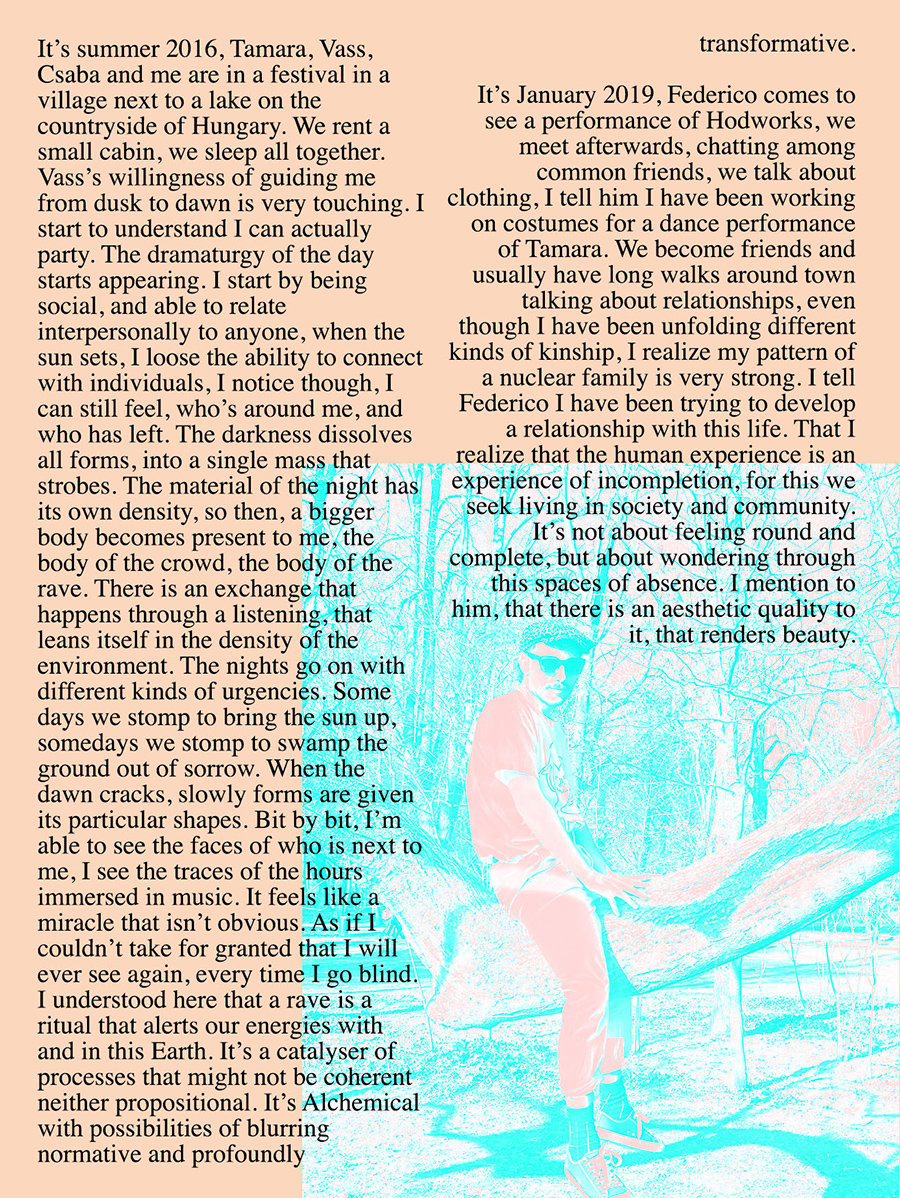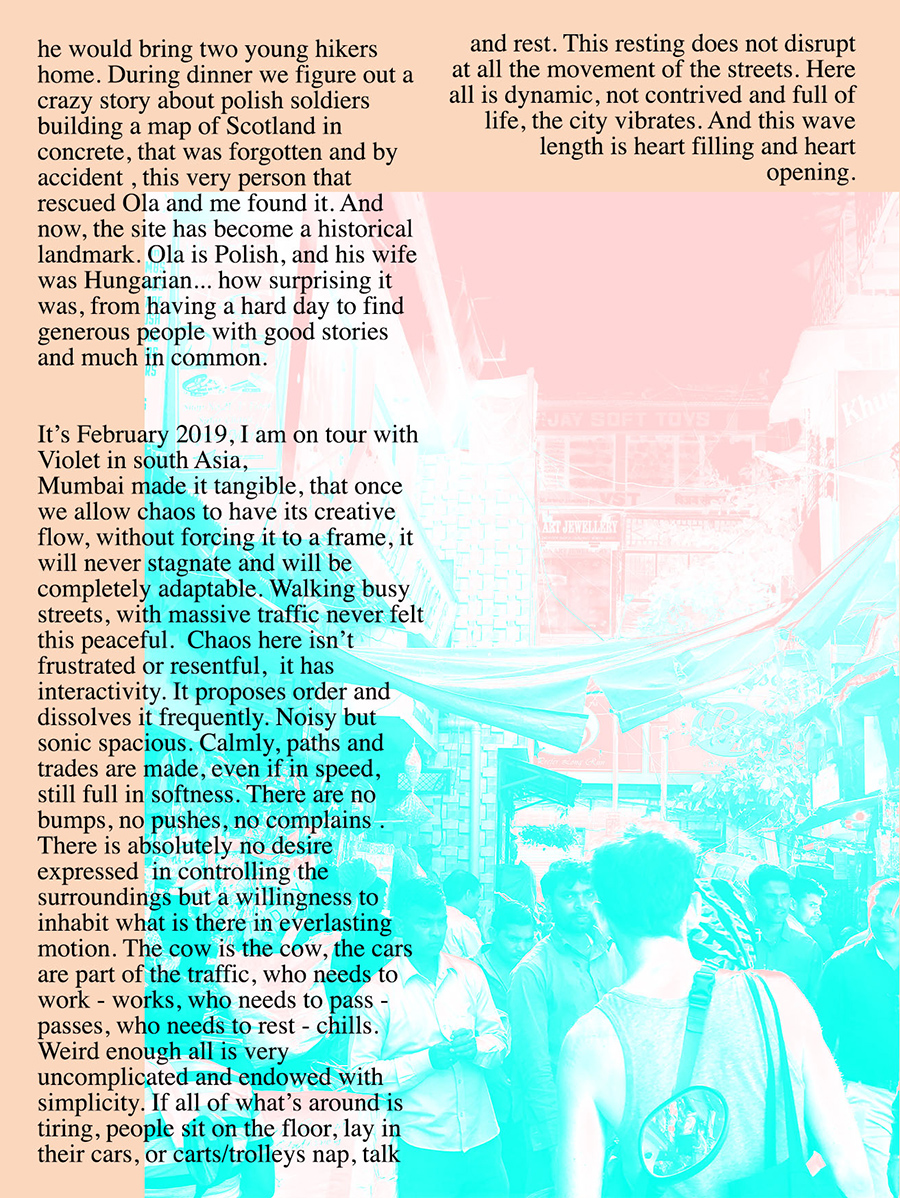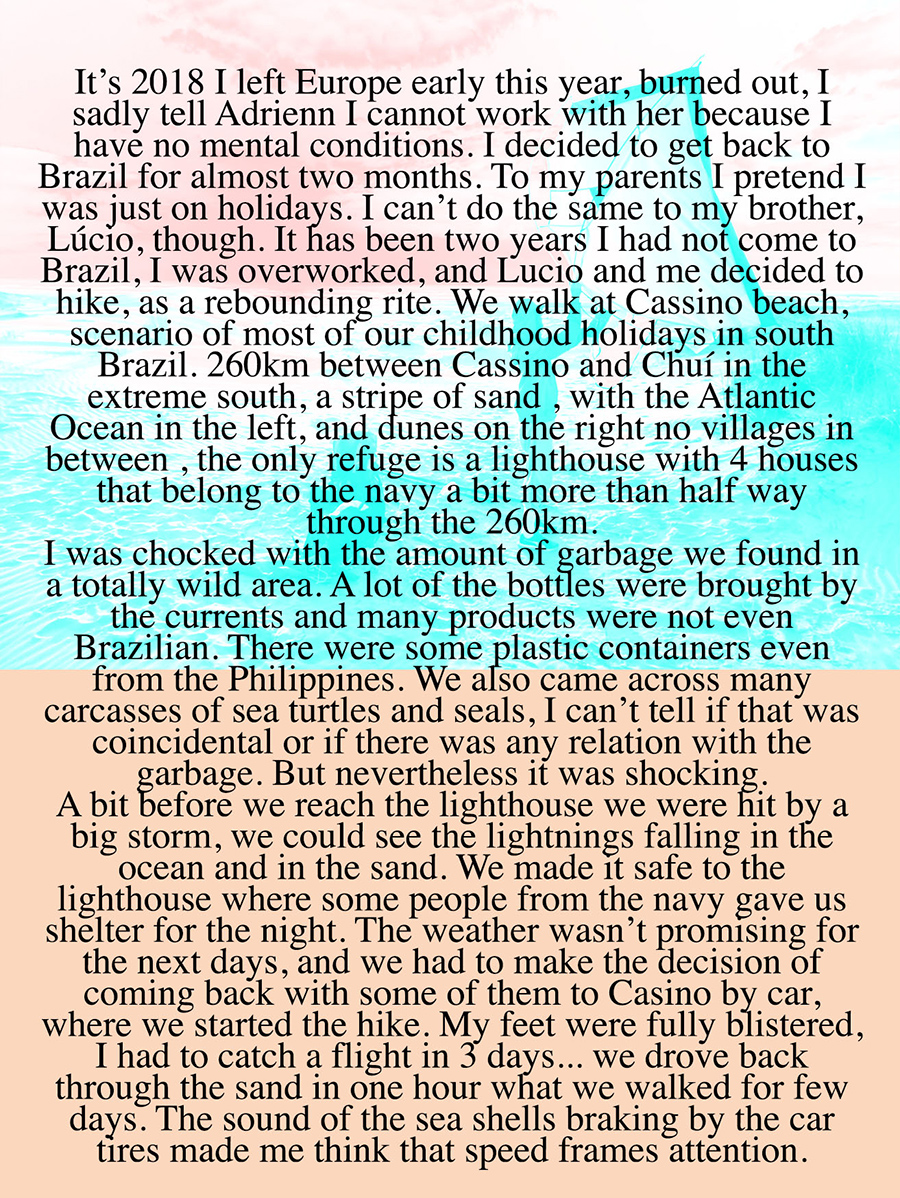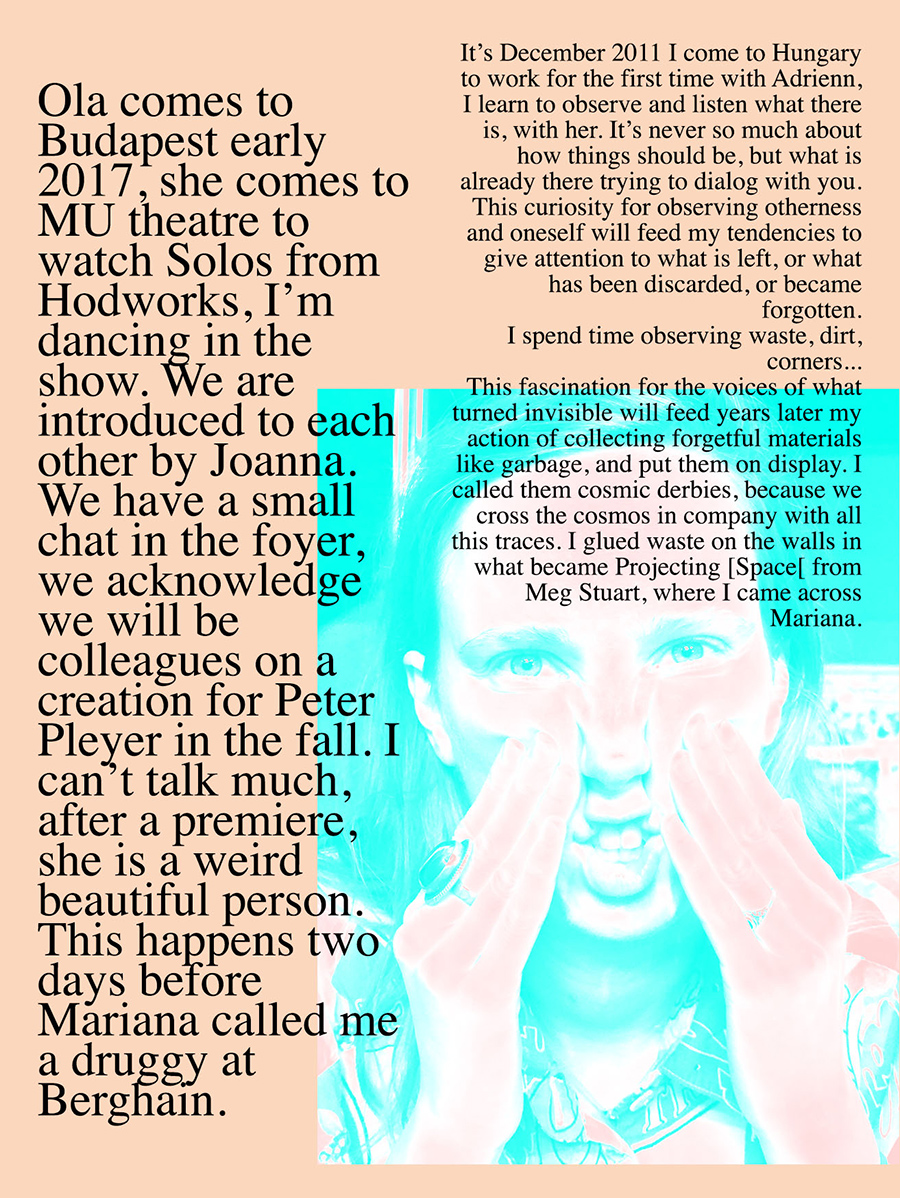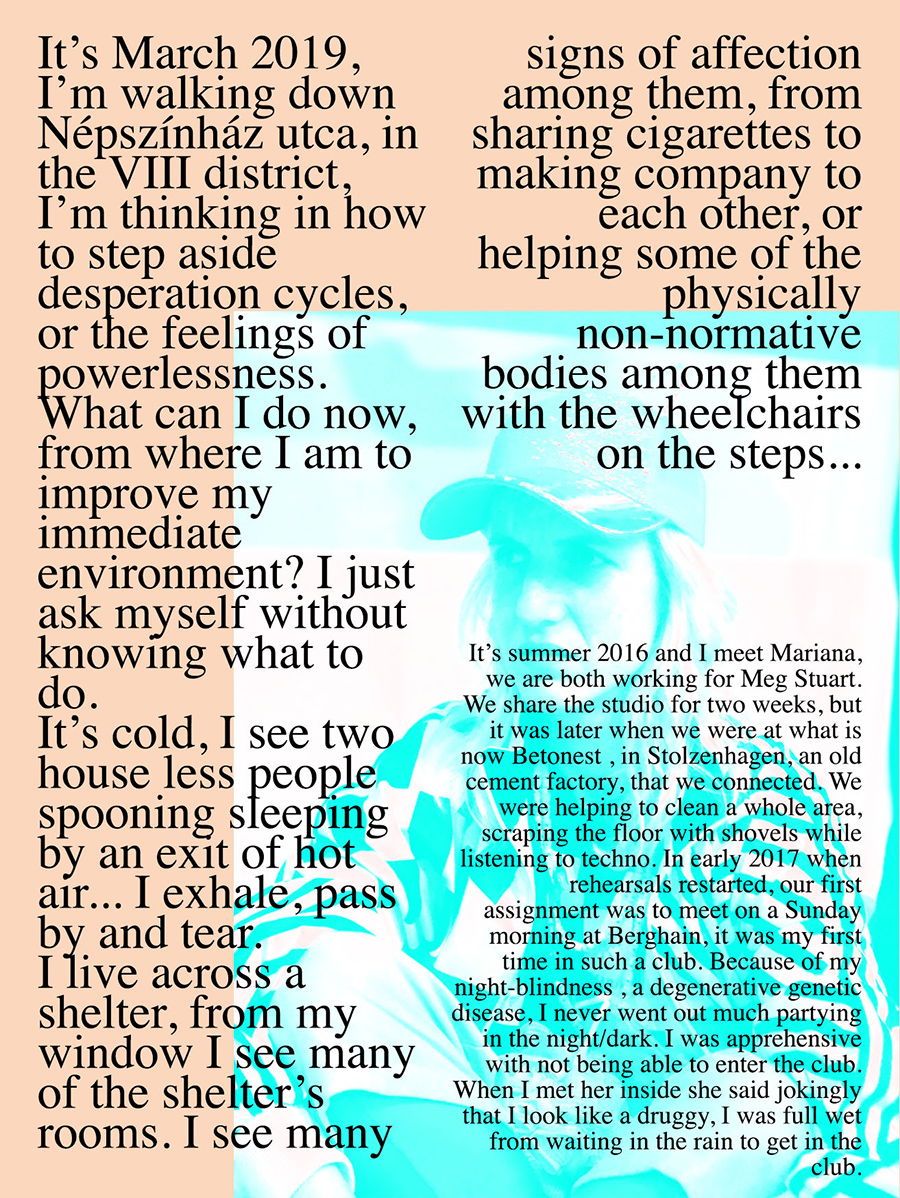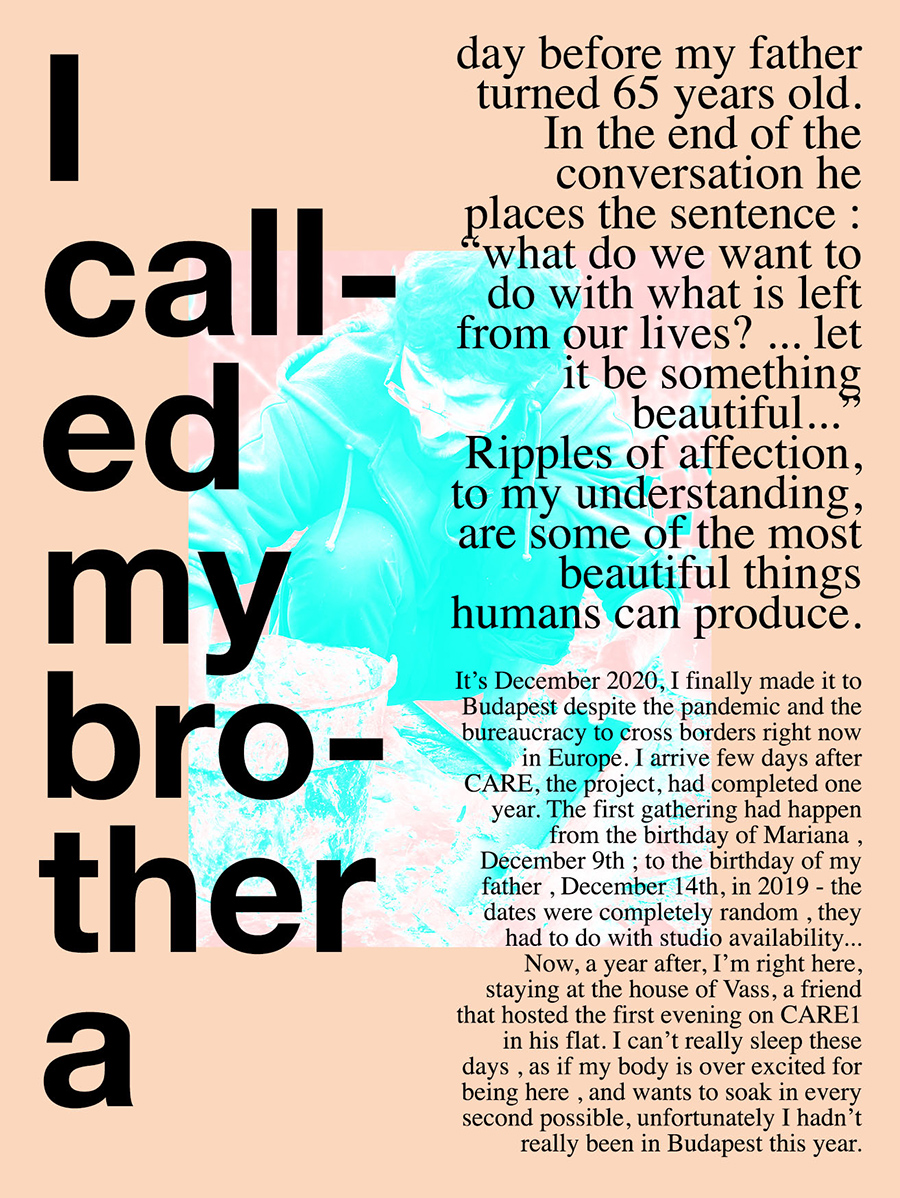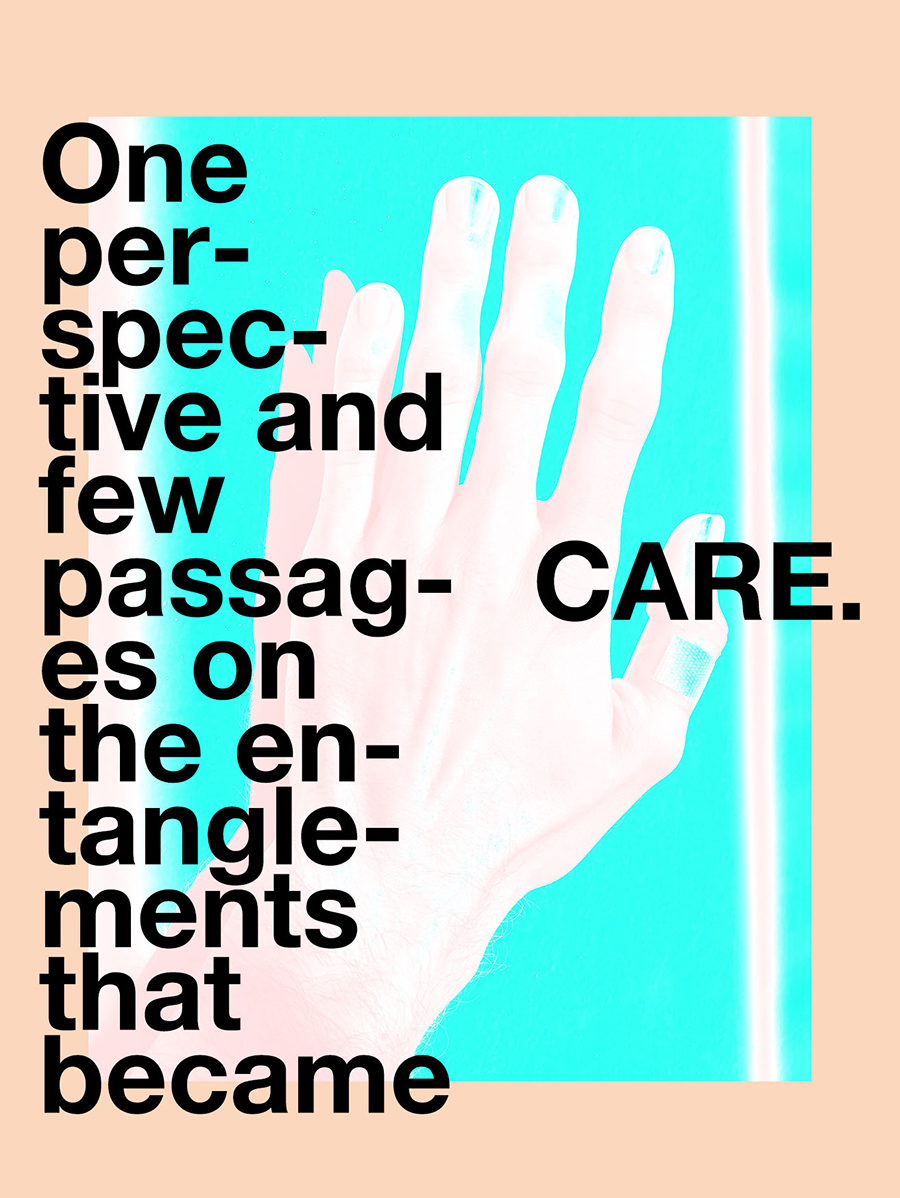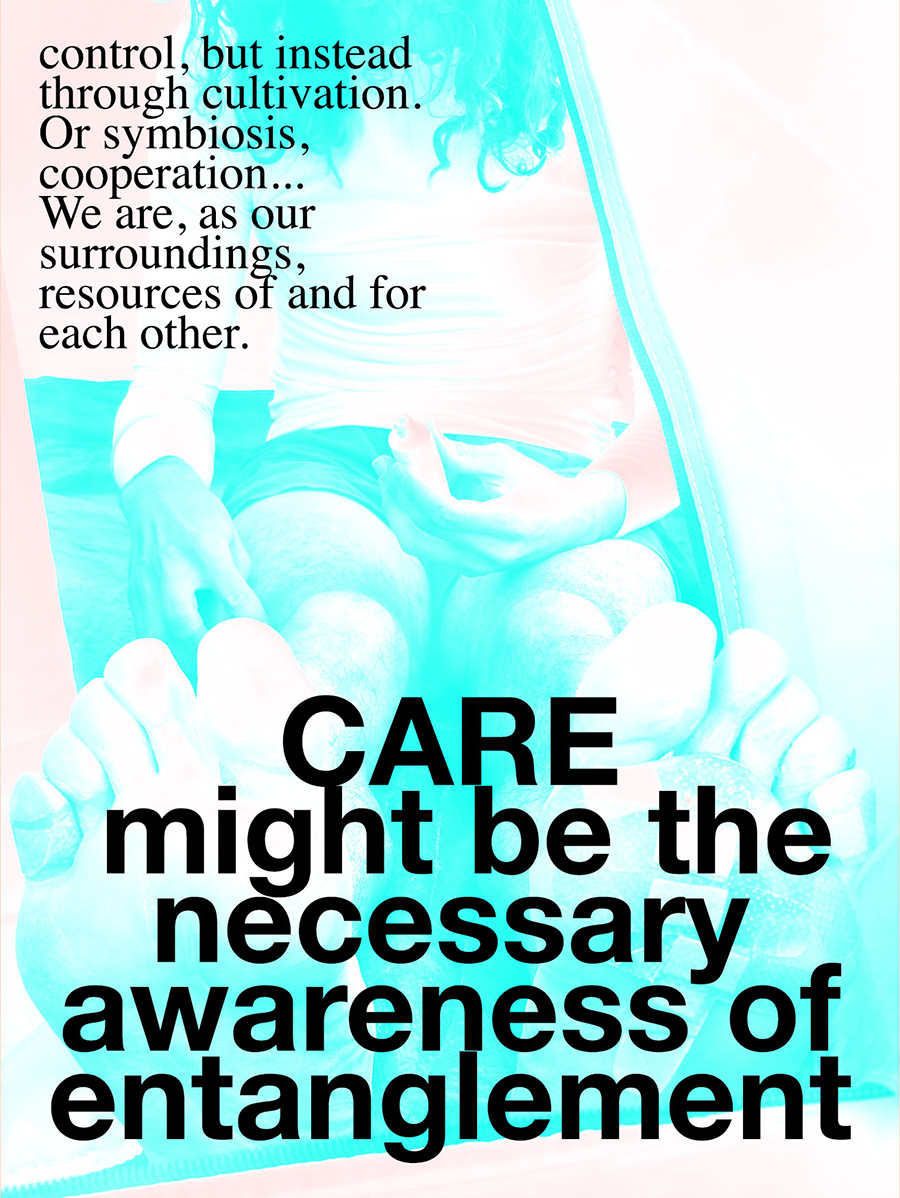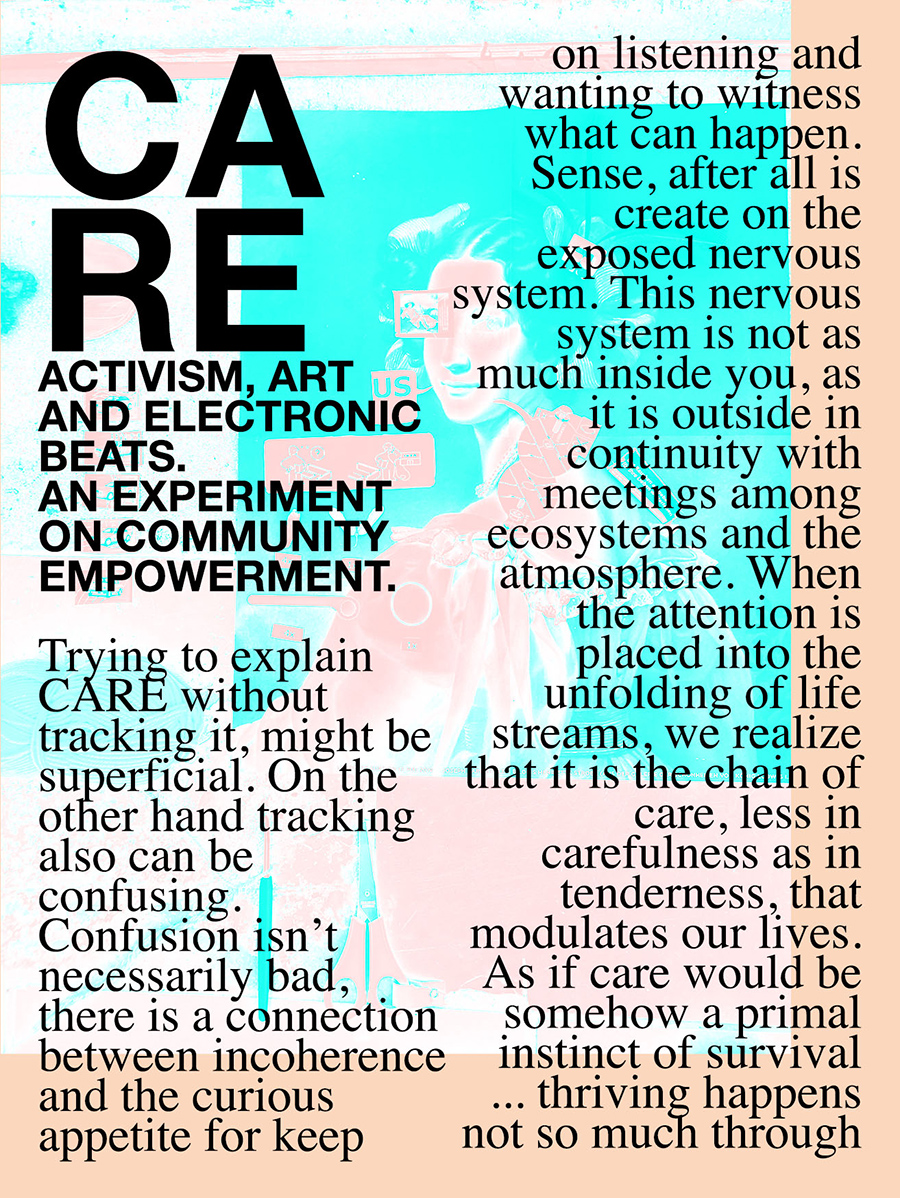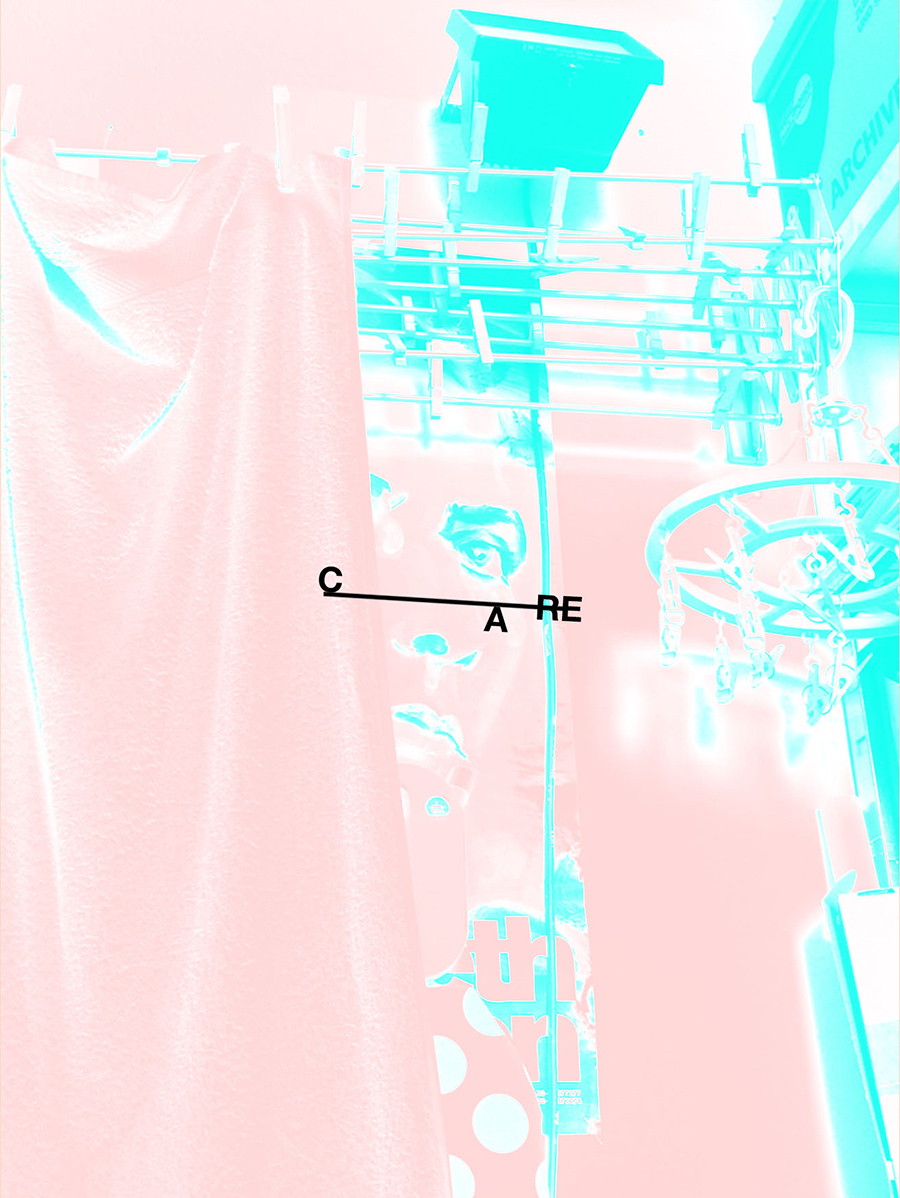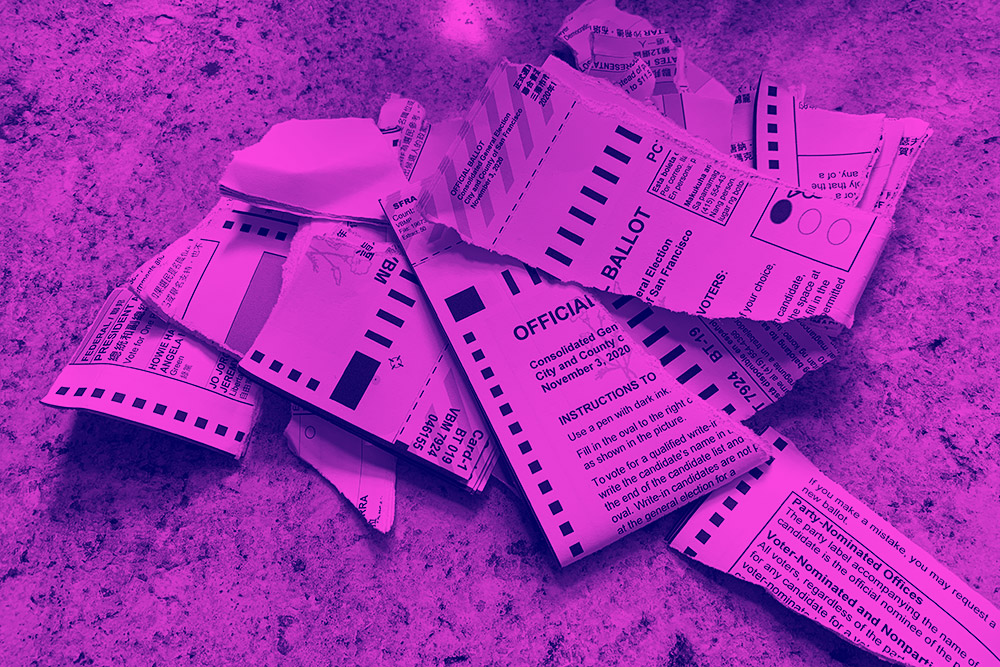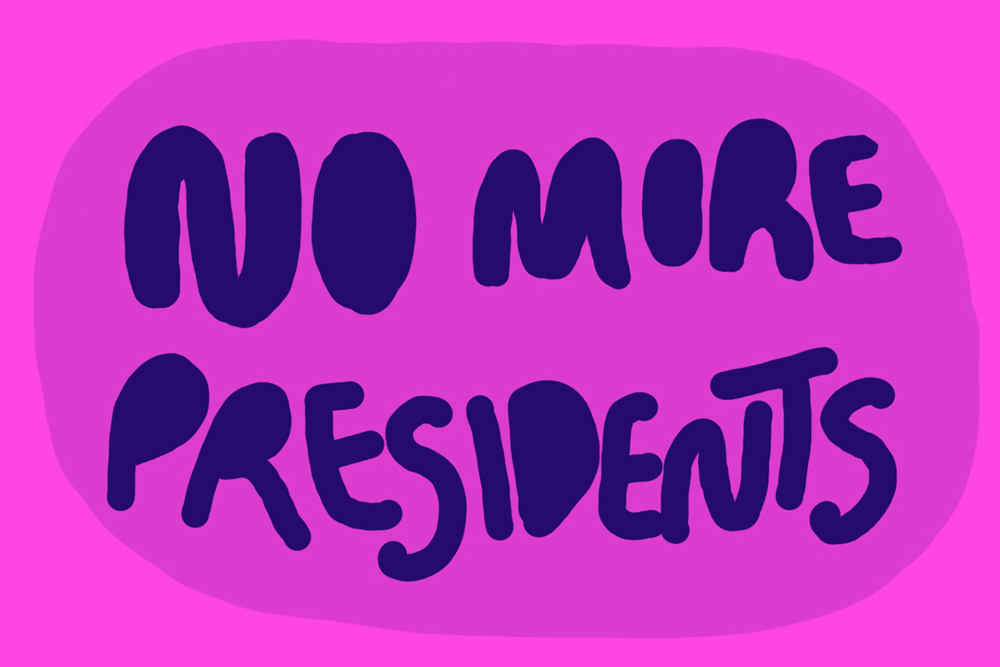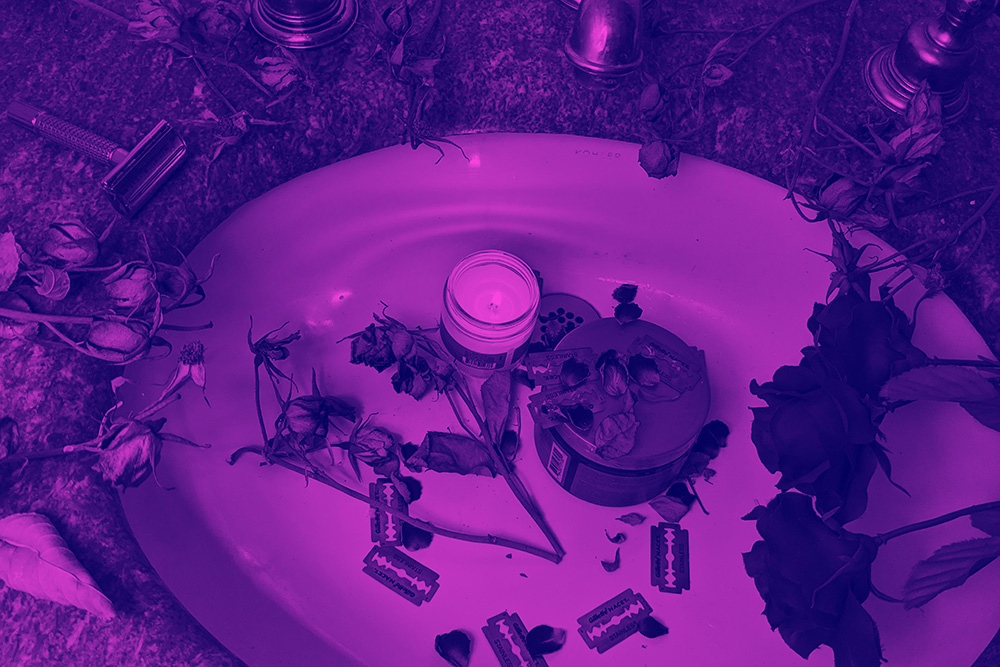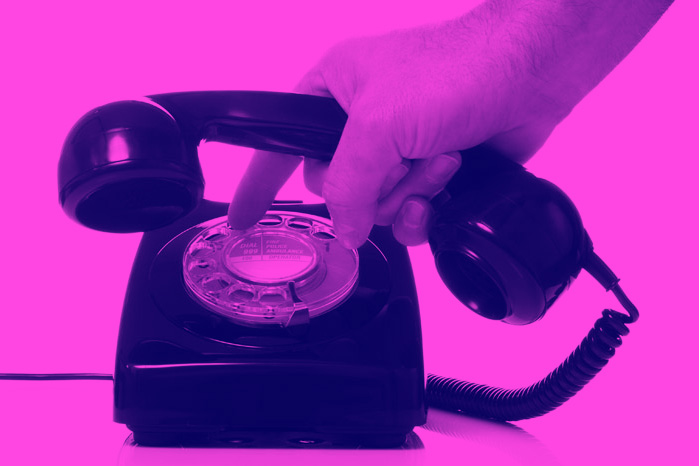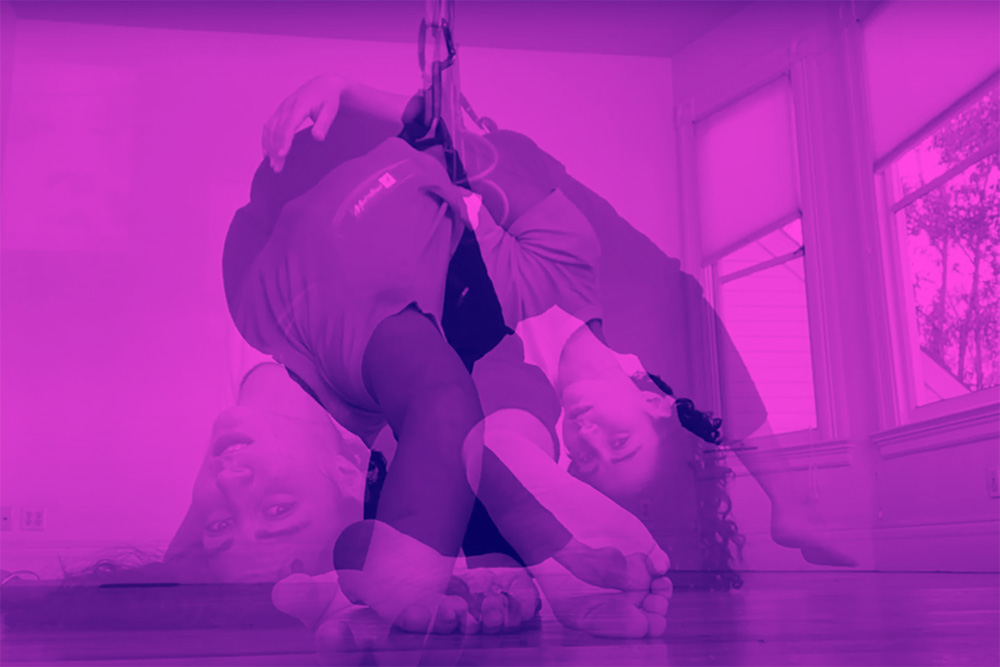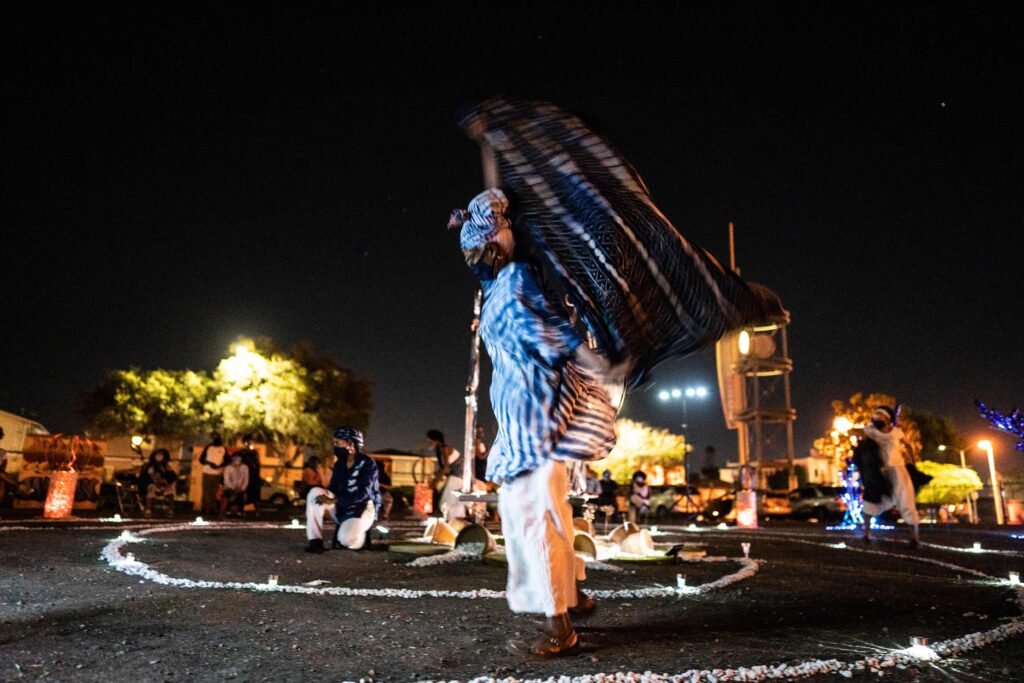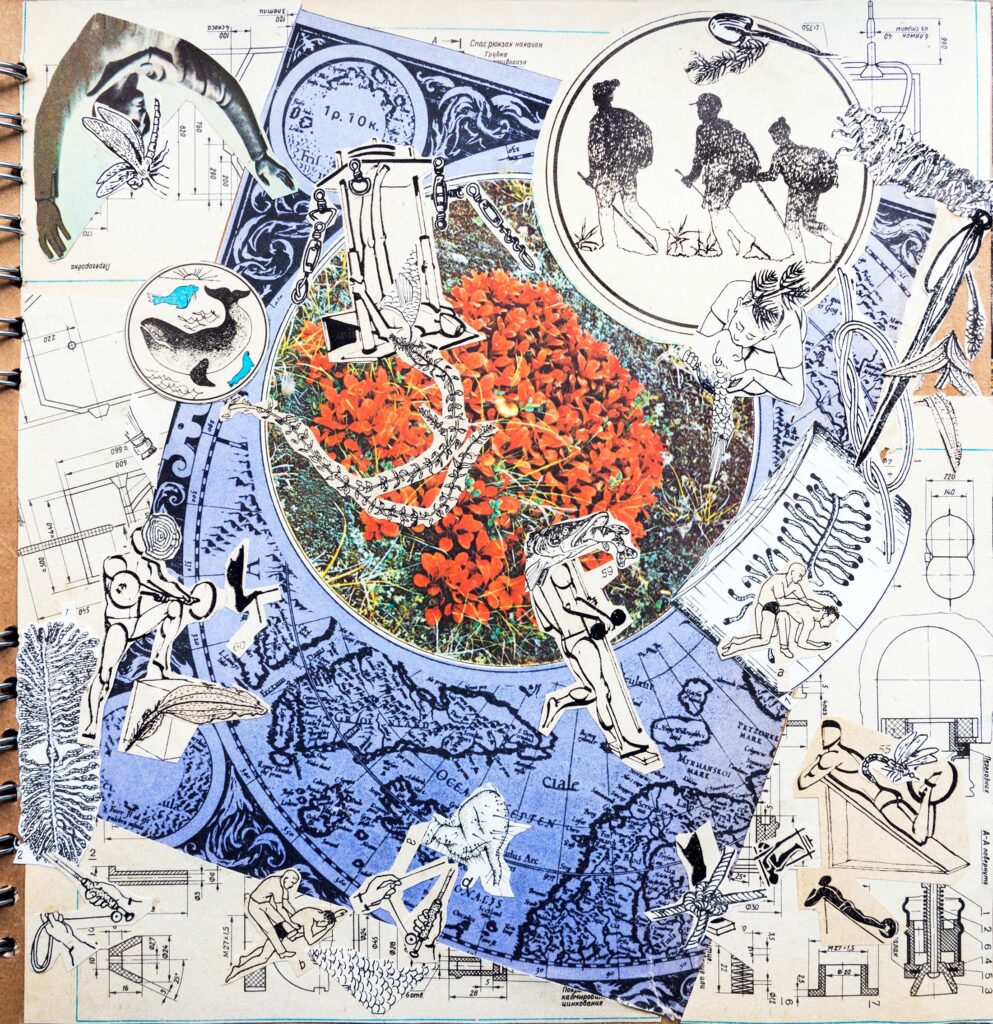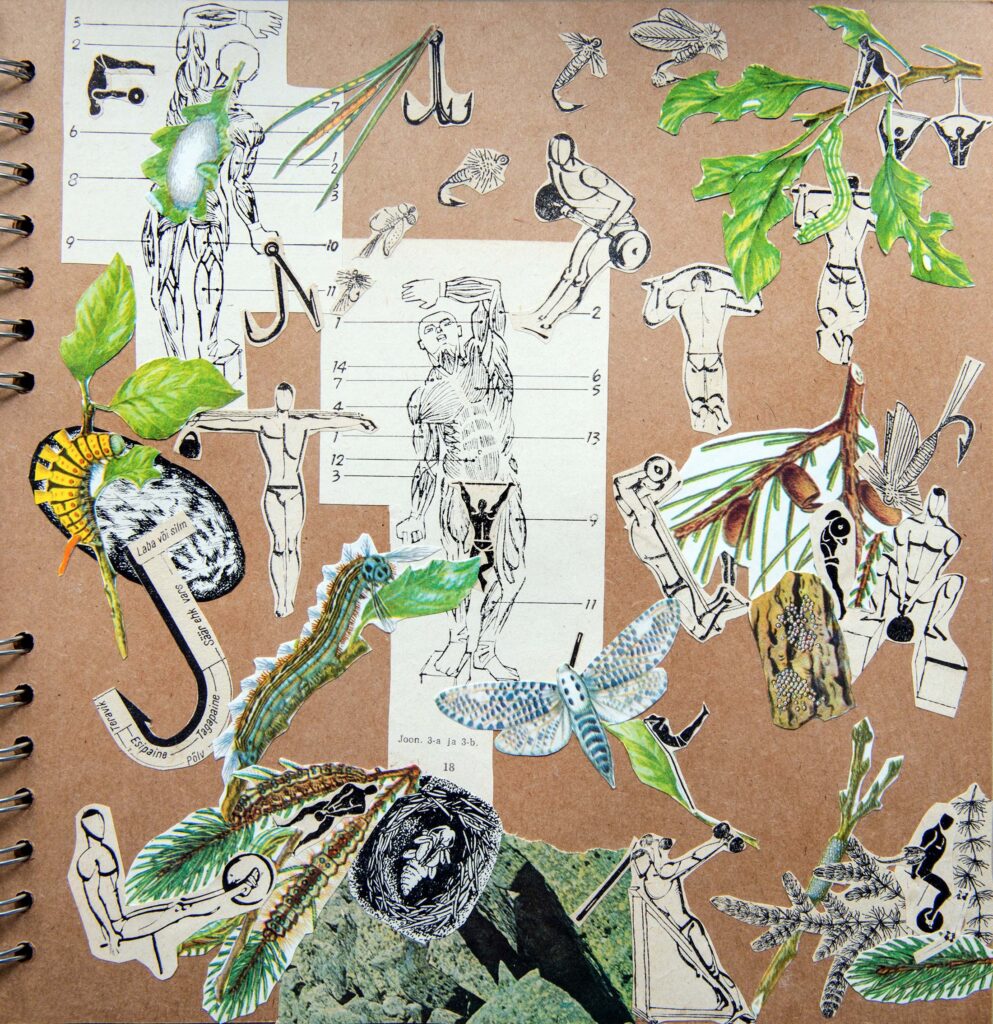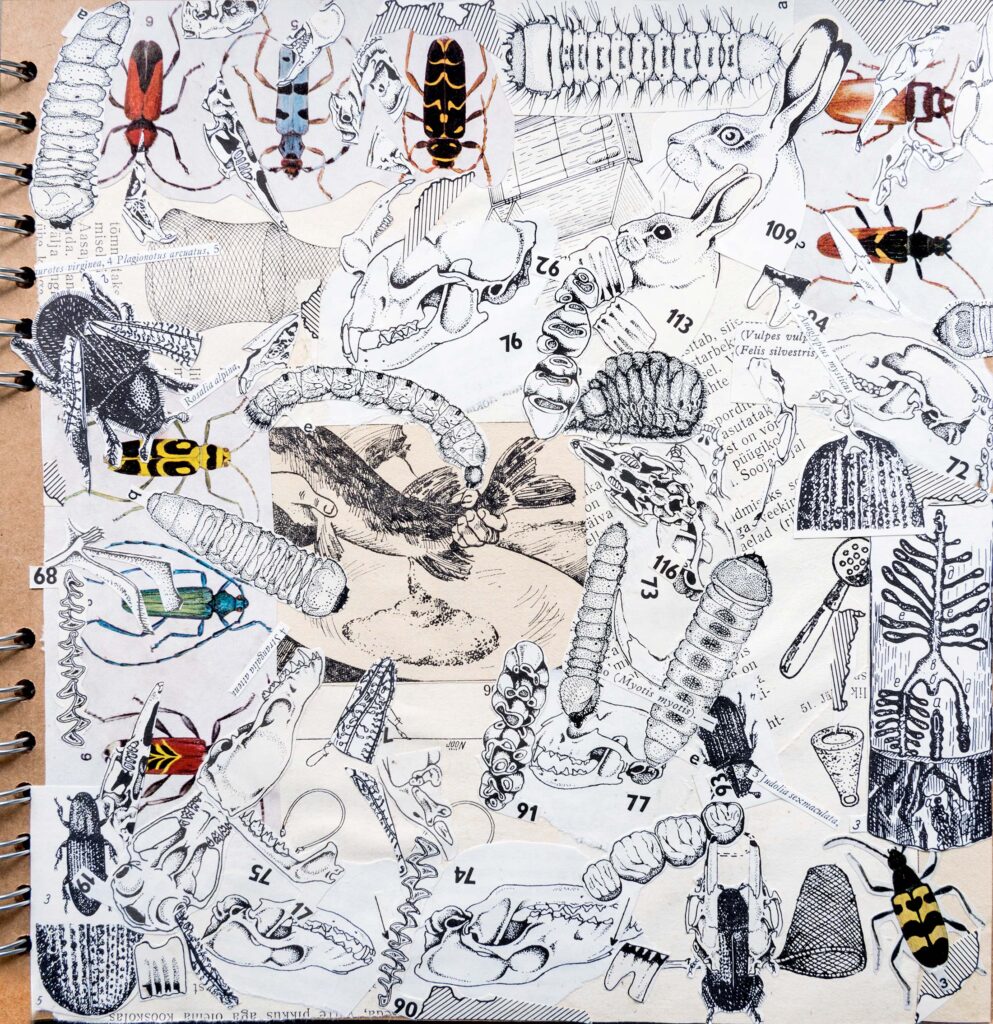Tag: Public
Statement
Re-write
June
WE PUT A SPELL ON YOU
Hello Bitches Witches Welcome Poland
Everybody body body body
Humans, Sirens, Witchers and Rusalcas
Nimphs, Goddesses and the other Creatures
Here is Ketty, Katarzyna Sitarz
Also known as Sutra from the Baltic Waters
Here is Maggie, Magdalena Przybysz
Also known as Meluzyna (she’s still she’s still Maggie from the block)
Our motherland is Heart Shaped Area
Now Monoculture try to do a flat plain
Before Dickduck it was nice all to see ya
Come on let’s free love is love again
WE PUT A SPELL ON YOU
Hello Bitches, Grand re Union members
World is falling but we’re here together
Rechoreo and rewrote statements
Flowing smoothly as easy going dancers
Forming a new, palimpsest, express local and global desire
Hope, experience, love, animals, nature, plant, lovers, water and fire
black live matters, woman right matters, all colors of rainbow matter
fuck privileges, let’s get specific, fuck art market, bold hearty letters
Let’s create spontaneous deviations
Connect to cosmic nature body and soul
We really care how you are today
You will never ever walk alone
WE PUT A SPELL ON YOU
The World has EARs, and the words have tEARs
Mother EARth is an active feeling
We are not passive pussies
Listen tenderly to clEARly hEAR it
she is nEAR and she will appEAR
any time your fEAR reach her skin
in sEARch for a dEAR
fix your hEARt
one day love appEARs
WE PUT A SPELL ON YOU
Grand re Union
Grand re Union Statement
see all versions
Drag Queens Acts
The videos were created intently for the Grand re Union JAM in the frame of June edition. Due to the Facebook copyright policy, we couldn’t stream the performances on our channel.
The Mind As a Parasite Of The Body Feeding On Masochism and Alienation
Eggs
Sound & Color / Hey Black Child
(part 1)
Sound & Color / Hey Black Child
(part 2)
Wanderlust
Firestarter
Laroye
One Subject,
Two People,
Ten Talks
– Live
Reading
Trilocation
Moving
the Mirror
2021
Part I
Part II
Attentive
Being fully attentive – and intentive
Decide on a period of time of minutes of moments indoors or outdoors where you can move safely whilst being fully engaged and being attentive
Be led by anything that comes to your attention or into your attention until the next something that takes or grabs your attention
At any moment, choose how you wish to engage this – that which is in your attention
Maybe it is responding
or you are responding
Maybe there is a quality of meeting
Maybe some adding of something
is happening
Maybe you are moving
Maybe you are emulating
Maybe you are in empathy
feeling compassion
Maybe it’s logical
Maybe it turns lateral
Maybe there is structured
or random
And maybe it is
Attentive
Numbers
Draw or think ten numbers 0,1,2,3,4,5,6,7,8,9.
Identify each of their Unique Qualities; personalities, flavours, textures, rhythms, as you feel them, or they seem to be wanting, proposing, desiring from you today.
Now pick your birthday, or shuffle all ten into a random combination, and start moving. Repeat, shuffle, pause, rewind to your body and heart’s content.
Option to share your number scores with each other. To move your score alongside another score. Learn each other’s scores.
Enjoy. Thank you.
Touching With Lines
It is an individual drawing practice, however I suggest practicing it in groups to learn from the others’ ways of taking the score.
You can practice this score anywhere: you only need something to draw and something to draw on.
Choose a part of your body. If you can see it, close your eyes. If you can’t, you can either close or open your eyes, and explore the difference brought by the two situations (play with it: while you are drawing, you can choose to look at your drawing or do it blindly.)
The practice consists of drawing not from visual information but from inner sensations.
Feel how the act of drawing brings sensations to the part of your body that you are drawing. What happens if you vary the pressure on your drawing?
What kind of pressure, of touch through the drawing lines, does the depicted part of your body desire?
What kind of pressure and touch do you need to explore and navigate in your blindness?
Move your attention, from the drawing, the pressure you are applying, the feelings it produces in your body. What happens if you change your attention from exploring the part of your body in order to draw, to drawing in order to touch your body (or vice/versa)?
Are you close to the skin or close to the bones? Into the flesh or into the fluids?
Once you are done, look at the drawing. What do you like to see? Are those lines familiar to you?
Going High
Bone Sounding Score
To be done alone or with a podded partner.
Walk outside and to the quietest place you can find, where you’re surrounded in the most trees and grass and sky or other natural elements you can find. Open your mouth wide and put your lips on your own, or your partners, or a tree trunk’s or a building side’s body in a large O shape. If it’s your own or your partners body it’s good to put your mouth over a large joint or large bone. Then take a deep breath and as you exhale send a deep resonant tone into the bones/surface, keeping your lips connected the whole time and trying to send the tone strongly enough that you feel it vibrate your lips and vibrate deep into the bones of the body/surface of your partner. Let the tone carry until you’re out of breath. Then take another breath, move to another bone/surface and repeat. Keep toning into different bones/surfaces for ten minutes.
Let's Explore
Sun Positions
a score on finding nothing for anyone who is barely breathing
1 – find a ray of sunshine
2 – expose any part of your body to it
3 – let the sun touch you
4 – don’t worry if it costs you a lot of effort
5 – try to look for nothing, but don’t worry if you don’t find it, the important thing is that you have found the sun and part of your body, good job
“Everybody just works and works, and nobody have time for anything!
Excerpted from the book The Sand Wolf by Åsa Lind
– I am working too,” said the Sand Wolf.
– Not at all,” said Karusia. – You are just sitting around doing nothing! (…)
– Of course I am working,” he said. – My hands are full of work. As you can see, I can barely breathe. (…)
– But what are you doing? (…) In my opinion nothing
– That’s right. Nothing. The job is called nothing and is the hardest job in the world. The Sand Wolf has been snoozing hard.”
a score for urban
improvisation
leave the place where you read this
when you are on the street, take the first left. walk until you encounter a word.
record it
take the path in the opposite direction of the word, and walk until you encounter the next word
record it
repeat the last two steps until you have seven words. if you encounter a barrier before you reach a word, take a left.
what do these seven words tell you about the state of society?
A Walk
Walk forward in silence and without company for some time (suggestion: longer than you do daily). Try to be in walking. What is your pase? What kind of ground are you walking on? How does it feel? What do you see around? What do you hear? After some time let yourself be attracted to one spot – a place where you could stop (suggestion: sit or lie down). The place where you could feel safe and relax. Close your eyes. Let your body touch the surroundings which create this place. Let your body melt into the surrounding. Stay there as long as you want or can. Then go back to your daily activities.
Pierre A Trois Temps
Stone in 3 time
time one – stop
on the way
find the stone
find the good stone
find the old stone
Find the stone that will find you.
Please do touch!
time two – pick up
teaching of the stone
fully present
listen with
your hands,
your eyes,
your body,
your imagination
Please do touch!
time three – lay it down
when the teaching is over
place the stone next to the bodies of the other
teachers
Repeat the whole action whenever/wherever it is needed.
With the consent of the stone.
Always make sure of this beforehand.
four directions,
above & below
facing down friction
walk until you find a rough spot on which to stand; look towards the north while considering a place of political strife or environmental catastrophe, in the general direction of your focus; as you let your feet soften and find comfort, in whatever way you wish to do that, project the softening and easing within your body-mind towards this place of hostility until you arrive at a state of physical restfulness.
find another rough spot on which to stand facing towards the east, repeat the task; then repeat it facing south; then west.
finally, find a place to rest comfortably on your belly, on grass or on a blanket, and spend time breathing into the earth; then turn onto your back and breathe into sky, sun, wind – feel earth below, sky above, air around, and if you want, finish by taking a nap.
addendum:
the following is my realization of this score:
today
i face north and think about greenhouse gas emissions and the melting of the arctic ice
i face east and think about the ‘illiberal democracy’ viktor orban is manipulating into existence in hungary
i face south and think about the unceasing conflict in the middle east
i face west and think about one of the many places in the world experiencing severe drought
Dare to care
Dare to care are podcasts featuring guests from the field of dance, choreography, and art. In our dialogues we are focusing on the notion of care in the context of being freelance artists and parents. We aim to listen to each other and to talk specifically about what is currently at stake in our private and work context in the city and the country we live in, as well as in the world. We aim to speculate about the future – what we think could or should change. We will think in a utopic way and discuss impossible ideas.
Conversation with Bojana Kunst
Conversation with Zornitsa Stoyanova and Sarah Vanhee
Conversation with Katarzyna Słoboda
One Subject,
Two People,
Ten Talks
Two impro-addicts – Aleksandra/Ola Bożek-Muszyńska and Andrew Morrish, talk about their shared improvisation practice. One in Poland and one in Australia, one in the early morning and one in the early evening. They each chose 5 issues that arise from their individual practice and used one of these as a topic for 10 zoom meetings. They alternated leading the sessions, playing with discursive, conversational and practical elements. It is, what it is, but they did stick, throughout, to their most basic question: where is my pleasure?!
They hope that you too, watch the videos with this question in mind.
First of Ten
7 Is for The Young
Second of Ten
Stuck in The Mud on a Windy Day
Third of Ten
The Beginning of the Joan Armatrading Song
Fourth of Ten
Octopus Arms
Fifth of Ten
Let Them Talk
Sixth of Ten
We Have Forgot the Time
Seventh of Ten
Trust The Pillar
Eighth of Ten
Everything Is Always
Nineth of Ten
The Hungarian Thing
Tenth of Ten
The Power Of The Point
check also
One Subject, Two People, Ten TalkS – LIVE
Scores
we are offline now. join us.
below you will find some tips for activities during a day in nature.
if you are in Poznan (Saturday, June 26th), join us in Stary Browar Park from noon till 3pm. see you there!
check also
Across-the-board
Score for Active Relating
Grand
re Union
Picnic
Saturday June, 26th
many places in the world at their own time throughout the day
Come to the grass with us,
come onto the floor, between and under the trees,
on the sands of your beaches.
enjoy the company of the nature and
in the nature, also within the city,
grounding
and from that grounding growing in all directions.
find ideas about what you can do
in that place
in that state
from body/mind practitioners from around the world.
here now!
away from the screens.
immersed.
in Poznan, we are meeting in Stary Browar Park (on the side of Ratajczaka street).
Between noon and 15:00 o’clock CET
we will breathe together, meditate and engage in a liminal rituals of passage
between everything we leave behind and everything that awaits us.
Come and join the Art Stations Foundation team and some of Grand re Union artists
to farewell the hard months of isolation and happy times we spent together online when we could not meet as we used to and wished to.
And let’s look together into the coming time when there will be no ASF anymore,
and no Grand re Union in its 2020/2021 form
but what there will be for sure,
always and with no doubt,
is dance and choreography
and
we will still be there for each other.
check also
Scores
Grand
re Union
Jam
LIVE from Poznan and other Grand re Union sites,
directly into the world
after a year of regular online gatherings
and the publication of 9 online magazines,
with the 10th – a virtual trip into very real somatic experience,
we are finally meeting both live and online
with movers and thinkers, dancers and writers of the Grand re Union project.
The event will mark an ending of the whole year cycle
celebrating our communal efforts on practicing and reflecting, despite the odds,
on dance, improvisation and the movement of our body and mind
it will make a circle full:
from where it all has started,
back to Poznan and again into the whole world.
and
as every ending marks a transition into the new beginnings,
it will also serve as such!
Celebrate with us in a very funky style
wherever you are!
Stream on Facebook Grand re Union.
Stay tuned
and
Tune in!
We will be there for you.
Stream Program
Moving the Mirror
Grand re Union talks
One subject, two people, ten talks
Concerts of the polish artists
Performances
Poetry reading
Performances
The Statement re-Write
Excerpts of Jumpcore
Slow Rave
Somapark
Statement
Re-write
May
staring wide-eyed at faces which are blind to us, we pull back the curtain of conditioning to truly see ourselves, and what we have become. change is everywhere… if we dare to accept the challenge of changing ourselves, first.
how can we be together with others when we are not yet truly together in our own selves, where the crime of otherness is outlawed by those who hold our reigns? is this a newly-emergent awareness, only illuminated because of a global pandemic? surely not. we have been connected through stardust, mycelium, blood, infrastructure and ethernets for decades, millenia, aeons. and yet, we still won’t hear our neighbours crying.
what is common to any of us when we deny our own realities, our natural beings, our instinctual selves, in favour of the tiny box marked “convenience”? is it convenient to conform, when conformity suffocates the air from our lungs, one tree at a time? when Common Land was Crowned, we complied with the enclosure of far more than fields.
nevertheless, she persisted; this grand old dame, Ma Earth. something had to. she continues to spin and weave and adorn us with gifts we never asked for and increasingly prove we never deserved. where we all once gathered in mass-ritual to sing and dance our connections with Country, most now struggle to remember her song.
prone in stasis, our bones degenerate in isolation from her, each other, us, i. the desire, the human need for connection, meaning, expression, celebration has never died, merely become quieter – only audible to those who choose to excavate the system’s earplugs and drown in the revealed cacophony until a new zero decibel is arrived at. those whose bones have turned to rust from restricted movement may require the pain of physiotherapy in order to walk freely again. for others, healing only comes once bones are rebroken and reset anew.
for those where only the absence of voice, movement and connection have framed their lens, the medicine can feel more deadly than the illness. to strive to pause, to connect meaningfully no matter what device enables it, can seem an imposition to those who have fought so hard to breathe their allocated air through their allocated tube dripping down from their allocated ceiling. there is discomfort in disruption of these realities. can we be reborn stronger through communal intention? or is it time for us to say, “enough”, and sacrifice that which we believe we’d earned, now knowing it grew from soils we made toxic?
if we decide to join together… how? we all speak different languages, of truth, of desire, of
meaning, of need, of entitlement. putting us all in one place may only bring the world further off-balance. we may topple old Ma over, affecting tectonic plates and tides, and never reach the consensus we seek. and yet… perhaps it isn’t consensus we require. perhaps we simply want to be seen and heard as an “i” within a cluster of interdependent i’s. perhaps it’s all this talk of a single solitary “we” which got us into trouble in the first place.
when “i” dance, it is under the union of mindbody and music, not for the gaze of another. when “i” dance for an audience, i am no longer mine. when “i” observe another’s dance, my own becomes influenced even without my consent. when “i” am invited by another to dance with them, a choreographed relational anarchy of flowing bodies may ensue. or perhaps simply a knot of uncertain limbs entangled in the confusion of their own bruised unknowings. collaboration can bring out unique new forms, and it can result in the same same, again again. maybe we get to decide how that pans out, if we’ve learned how to decide anything for ourselves, yet. some maps are too well-trodden to unlearn. some maps are only danced by the bees. and some bees won’t waggle for anyone but their queen.
so we decide, if we can. and we swap the discomfort of conditioning for the disruption ofchanging ourselves, painstakingly, painfully, debriding the skins of what we were told we were, re-breaking bones set to paralyse us. and we open our mouths to release the scream of torment, chorusing what was stolen from us all. and then – and only then – will we remember how to dance with Country once more, and sing our true song of connection to i, we, earth.
Grand re Union Statement
see all versions
Creating
our Climate
Disrupting Discomfort – in conversation with you
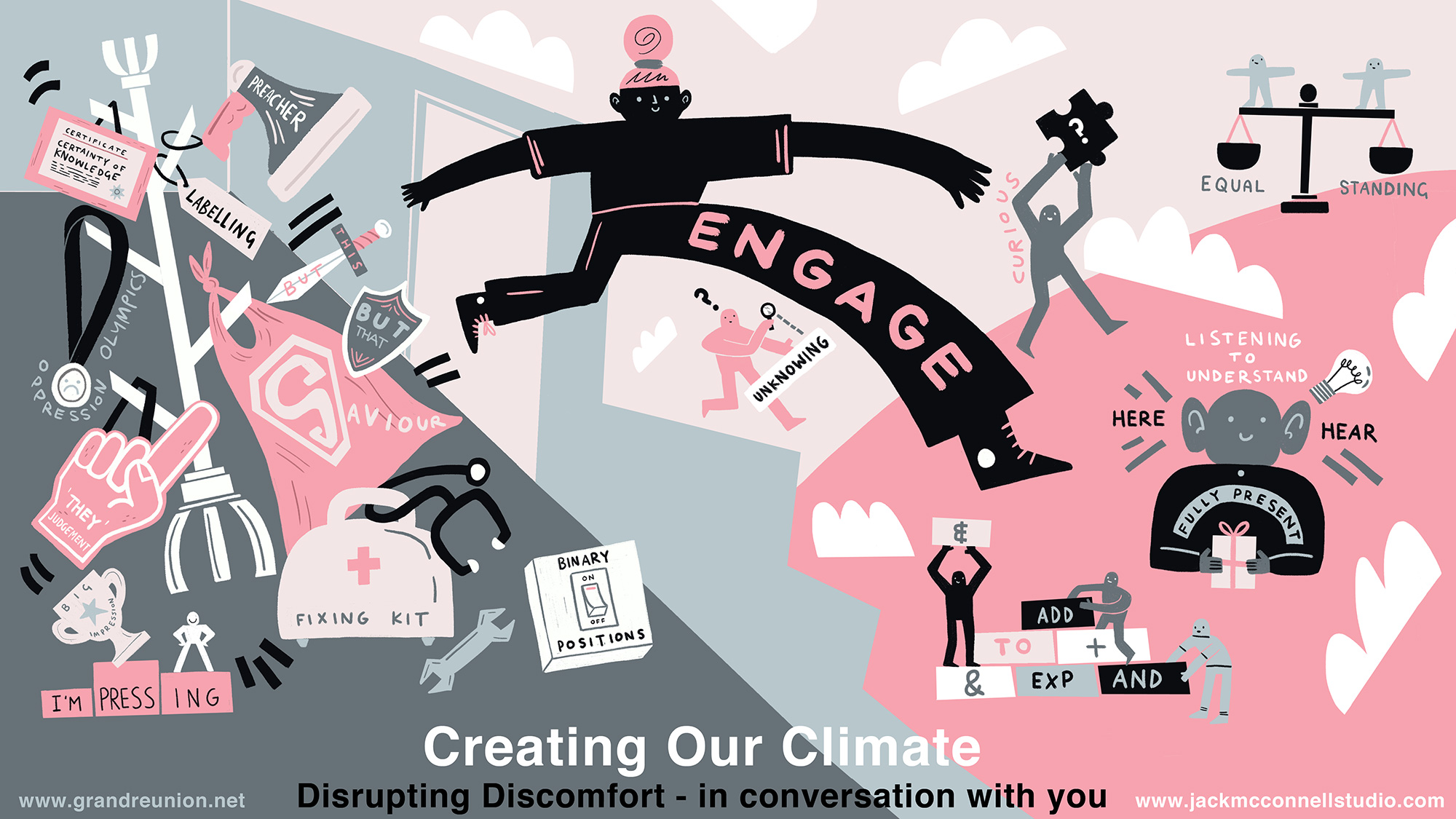
For our conversation together, we invite everyone to enter with curiosity, and to position ourselves alongside each other, neither above or below.
We will coat-check any desire to jump in with agreeing or disagreeing,
and abandon all binary positions in favour of embracing complexity.
We listen to understand, not simply waiting for our turn to speak.
Silences may be uncomfortable at first, and they too are welcome.
We invite you to relinquish the urge to impress, or validate or justify your contributions,
and to trust that your being here is enough in itself.
We embrace not knowing yet,
and accept clumsiness as a part of expressing the not-yet-known.
We will leave at the door, that which does not serve us, including buts,
or the reflex to become the rescuer, saviour, teacher, preacher, doctor or therapist.
We invite folks to add to, or expand on, what is being said, rather than negating.
And as adrienne marie brown says, we will move at the speed of trust.
For our conversation together we invite folks to leave behind interpretations, labels, judgements and diagnoses, and to notice when these tendencies arise.
We invite everyone to be present with each other and ourselves,
and to acknowledge what moves in us, tickles, or disturbs us.
May Team
Disrupting Discomfort
Statement
Re-write
April
On the Movement of Plants
and the (Im)Possibility
of Plant-Human
Choreographies
Artists at work in contemporary choreography and dance are increasingly involved in problematizing the interconnected, affective coexistence of humans and non-humans, including plants. This phenomenon of multispecies coexistence of humans and plants requires a post-anthropocentric ethics, which in essence focuses on respecting all modes of life and on care for beings engaged in our commonly shared worlding.[1] For just that reason, the theoretical framework applied in the present article draws on concepts and categories grounded in feminist new materialism, philosophical critical posthumanism, and critical plant studies.[2] One of the aims underpinning choreographic and dance/movement-oriented artistic projects that involve living plants concerns creation of suitable tools or/and techniques, customized in the course of artistic research.
All the deliberations presented below tackle issues stemming from the artistic research conducted with the choreographer Agata Siniarska,[3] whom I assisted in my capacity as scientific consultant. My analyses rely on the theoretical development of specific artistic and research practice. In the present text, I aim to introduce and attempt to solve the key problem that has emerged during our work: the possibility of creating techniques applicable to two specific practices: the practice of “moving-together with plants” and the embodied practice of “becoming-plant.”
The goal of the artistic project carried out under the working title Plantimacy was to work out dance and choreographic techniques which could contribute to the overcoming of plant blindness,[4] the phenomenon of failing to notice plants despite looking at them, as defined by James Wandersee and Elisabeth Schussler. According to Wandersee and Schussler, plant blindness boils down to ignoring vegetal entities “as such” – i.e., as autonomous, existing in their own habitat of their own accord – while acknowledging them only in the context of their functionality within the human world (food staples, materials, landscaping decor, etc.). Plant blindness inevitably leads to the rejection of their specificity, to the zoo- and anthropocentric consignment of vegetal beings to low rungs on the ladder of being, and to treating them primarily as initial components in the food chain. As a result, their complex evolutionary heritage as auto- and heterotrophic beings are disregarded, along with universal knowledge concerning unavoidable food interdependencies of living and dead bodies of humans and non-humans.
Plant blindness first emerged and took root in the West, where the biblical figure of “man as one who exercises dominion over the earth” was inflated within the modern cognitive paradigm based on distance, observation, systematization, and repetition. To date, this model has been supported by diverse systems of animate-world classification, including the widely recognized 18th-century taxonomy of Linnaeus and Darwin’s theory of the origin of species, the tenets of which have since been interpreted as evidence of humans’ evolutionary superiority over other life forms. While in many non-European and premodern societies, cognitive systems did not and still do not privilege humans. Which enables plants, humans, and other beings to form egalitarian, interconnected, and affective multispecies communities.[5]
In working with Siniarska, we were keen to expand the practices where a given plant is treated as a partner of human performers. We did not wish to represent plants through the intermediary of translation – of transposing onto the human body movements implied by the shape of plants (for instance, creeping tendrils of leguminous plants) or triggered by the elements (swaying in the wind). Nor did we intend to deal with the artistic expression of a human experience of closeness, empathy, or intimacy with plants. What mattered to us was the bioethical notion of vegetal dignity and welfare formulated by the Swiss Federal Ethics Committee on Non-Human Biotechnology (ECNH).[6] The choreographic and dance / movement practices were supposed to produce corporeal coexistences for the human and the vegetal bodies. The deliberations collected here aim to delineate the primary problems and thorny issues that arose as a result of our joint work on plant and human copresence, on plant-moving, and on becoming-plant
Plant-moving
The notion of plant-moving that I have attempted to posit here draws on my understanding of established ideas of plant-thinking and plant-reading. Michael Marder distinguishes four levels of plant-thinking:
1) the non-cognitive, non-ideational, and non-imagistic mode of thinking proper to plants […]; 2) our thinking about plants; 3) how human thinking is, to some extent, de-humanized and rendered plant-like, altered by its encounter with the vegetal world; and finally, 4) the ongoing symbiotic relation between this transfigured thinking and the existence of plants.[7]
This multifaceted concept can be justifiably recontextualized with regard to the field of dance and choreography, by posing questions concerning the ways in which the practice of human-moving can be dehumanized and plantified. Simultaneously, we embarked on the task of translating the process of reading into the process of moving, following in the footsteps of the analytical thought of philosopher Elaine Miller, whose book Vegetative Soul[8] refers to three contemporary concepts of plant-reading. This mode of reading is compared by Miller to:
vegetative growth, untraceable to singular or determinate origins, disseminating and productive rather than reducibly polysemic and analytic.[9]
The three models Miller refers to are Jacques Derrida’s dissemination, Gilles Deleuze and Felix Guattari’s rhizome, and Luce Irigaray’s efflorescence. The metaphors and images present in the works of these critics – fecund, fertile, and meandering interpretation; rhizomatic, nonlinear, multiplicity-affirming, actively sense-making reading; and climbing plantlike quality – have opened the possibility of conceptualizing plant-moving as a notion to be employed in our further work. We have acted on the contention that plant-moving we worked towards would be derived from plant-reading and plant-thinking and as such would not be determined by any specific beginning/origin, source, or aim. Instead, it would be efficacious, proliferative, profligate, chaotic, symbiotic, and relational. Obviously, such assumptions require posing numerous questions concerning the characteristics of a given vegetal organism, primarily the specificity of its movement.
Moving-together with plants
In considering moving-together with plants, one is bound to ask what constitutes their movement, what it derives from, and what activates a given plant. Attempting to find answers is possible on the condition that we consider plants active, sensate, and communicative beings. This definition of plants is not limited to the post-anthropocentric and premodern epistemologies mentioned above; it also constitutes the research object of plant neurobiology, otherwise known as the science of plant signaling and behavior. Leading representatives of the field include Daniel Chamovitz, Stefano Mancuso, Monica Gagliano, and Anthony Trewavas. Contemporary research corroborates the existence of sensory sensitivity in plants, along with memory, the ability to acquire knowledge, communicate, and react adaptively to environmental stress, and intelligence, enables one to comprehend plants’ motor motivation. This research-based data prevents the “mocking” of plants in our work, i.e., unintentionally caricaturing the observed movement of plants. At the same time, it constitutes a point of departure for our further reflections on and practice of moving-together with plants.
Michael Marder, in his philosophical work on plant life, warns against equating a projection of human experience onto a vegetal entity with empathy towards plants.[10] However, even given Marder’s pronouncement, we have assumed that within the remit of choreographic and dance practices, based on the problematization of corporeal coexistence as they are, empathy is typified by an affective, bodily, and preconceptual dimension. When the practice of affective empathy for a plant is accompanied by “deep contextual and critical knowledge about the object of our care,”[11] what transpires is commitment coupled with openness to the uniqueness of another entity (in this instance, a plant) and a willingness to get to know it. Still, two aspects related to the development of the practice of intimacy remain problematic: the impossibility of portraying our partner (the plant partner) in all its spatial expanse, and the incompatible temporalities of human and vegetal beings.
The human body, as porous and permeable as it may be, is limited, after all, insulated from the outside world by a reactive membrane. Furthermore, each human organism is specific and genetically unique. When we consider DNA configuration as a marker of individual distinction, the borders of vegetal existence become problematic. This is undoubtedly related to the typical plant-reproductive technique of asexual reproduction (vegetative propagation). When it comes to the fragmentation of thallus, reproduction by tubers and bulbs, rhizomes and stolons, gemmae, turions, spores, and endospores, the new plant remains – genetically speaking – the same plant, regardless of spatial distance between the two “individuals.” In other words, a plant reproducing vegetatively is not only almost unlimited, given the human perspective, but also, through proliferation and generation of clones, eternal.
As a consequence, the human being tackles an almost unfathomable spatial and temporal expanse in the life of an individual plant. The unsymmetrical or incompatible human and plant temporalities thus become particularly problematic with regard to motion-based practice: the temporal aspect, temporality, and timing are of utmost importance as far as dance and choreography are concerned. Over time, vegetal beings have developed complex motor reactions in response to biotic and abiotic factors. Tropisms, nastic movements, taxes, nutation, and other motions[12] occur as a reaction to diverse environmental changes: solar daily and annual cycles, availability of water, soil density, wind intensity, proximity of and access to other plants and objects, touch, and many other factors. Altogether, these impact the general condition of a given plant and its motor functions, thereby defining the rhythm and pace of its life – and making it strikingly dissimilar to human life.
Reflecting on and the practice of moving-with plants are likely to become easier when we apply the category of “transcorporeality,” as proposed by Stacy Alaimo.[13] To Alaimo’s thinking, on the corporeal plane – the plane of the sensitive and desirous matter – the human is inextricably entangled with the nonhuman, encompassing not only the bodies of plants and insects, but also the “bodies” of soil, water, toxins, and nuclear-power plants. Bodily natures are not separated from each other. Nor do they have clearly demarcated borders – they fluidly segue into one another. Their activities and relations are unpredictable, and for that matter in many instances these are undesirable or deleterious. Transcorporeality presupposes the dynamic intertwining and permeating of diverse material agencies and bodily natures, implying a motion that pervades all bodies;[14] movement plexuses involve bodies of different sizes (e.g., both microbes and magnetic storms) that also belong to different traditional orders – “economic, political, cultural, scientific, and material.”[15]
Thus, moving-together with plants within the transcorporeal space-time necessitates our taking into consideration the environment we generate together, in which different bodies pursue their own particular interests. The temporal dimension of transcorporeality is problematized, in one instance, in the context of geological phenomena: entanglings and exchanges take place both as a result of the physical permeation of bodies, and also due to their temporal intertwinings. Astrida Neimanis and Rachel Loewen Walker posit “the temporal frame of ‘thick time’ – a transcorporeal stretching between present, future, and past.”[16] I will return to this idea, in discussing the notion of the phylogenesis of humans in the context of becoming-plant.
Is it possible for us to move together when we are immersed in two incompatible temporalities? How can we move together with it hardly possible to think about and experience our vegetal partner’s own temporal and spatial entirety?
Such problems come to the fore in artistic projects problematizing human-plant relations. A significant number of contemporary practices focusing on performance with plants amount to mimicry, repetition, and mirroring of movements of a given plant, observed through the intermediary of cutting-edge video-recording technologies, such as time-lapse, which allows any “latent” movement otherwise imperceptible to the human eye to be discerned. Employing the principle of repetition of and mirroring the trajectory of plant movements, these projects render movements of plant and human non-contemporaneous, with viewers offered but an illusion of movements shared by the two beings.
In working with Siniarska, we were interested in a different type of motion-based practice, aimed at establishing intimate relations with a plant on the basis of knowledge concerning the biological, communicative, and social rationale behind movement. Mindfulness and intimacy have to start with questions regarding what constitutes vegetal movement, what triggers a given plant, and what a given plant then triggers in turn. Moving-with-plants is possible on the condition that 1) that empathetic, mindful translation takes place of motivations accompanying vegetal entities (“non-conscious intentionality,” as Marder terms them) into motivations comprehensible to humans, and 2) that the agency of other factors (bodies) participating in the joint dynamic world-making is duly acknowledged.
Plantifying movement, plantifying the self
The quest to find possible ways of moving-together of the human and the plant does not exhaust the question of our relations with vegetal beings within dance and choreographic practice. As forms of art, dance and choreography do not just experiment with the possible relations and configurations of bodies, but also problematize the moving body per se, asking questions that include the body’s temporality: its emergence, becoming-Other, and exhaustion. The concept of becoming-Other was proposed by Deleuze and Guattari.[17] Becoming-plant, which is rooted in that concept, necessitates locating a plantlike element in the self, one that is close to the vegetal. The human body may be rendered plantlike, or plantified, relative to other bodies, for vegetality is formed and emerges in the mental or somatic experience of entwined bodies-beings.[18]
In our work, we tackled the problem of how or with what instruments one can render oneself or the human body plantlike. And then we wondered whether rendering oneself plantlike might enable or facilitate moving with the plant rather than alongside it or opposite it. In our quest we finally decided to look through the Body-Mind Centering (BMC®) system of somatic practice, an education method developed by Bonnie Bainbridge Cohen, with which we were both familiar through numerous workshops. The key part of the method is the unity of sensation (experiencing) and cognition. The key factor is awareness of the body, its elements and layers, cells, skeleton, fascia, fluids, skin, and connections between these systems. Body work entails recognizing, distinguishing, and integrating various types of tissues and substances, examining the specificity of movement originating from each, and learning how individual layers, tissues, or elements were transformed in the developmental process.
“One of the basic techniques is developmental movement, in which one uses among others primal movements.”[19] Our final deliberations – the concept of vegetal BMC – is founded on this basic premise of BMC: what is important for the practice of developmental movement is both the ontogenetic development, or the personal development of the human child, and – more interestingly in this context – the phylogenetic development, or the evolution of species, from monocellular to complex multicellular organisms. The process of phylogenesis showcases Neimanis and Walker’s concept of “thick time” at work in the evolution of species: inscriptions are made on bodies, and those inscriptions can be read. One way in which this can be done is a third-person biogenetic analysis. Another is a first-person, performative, corporeal reading.
An important element of the “guide” to practitioners of archaeology of the body is the serial endosymbiosis theory, first proposed in the early 20th century by Konstantin Mereschkowski and developed in the 1960s by Lynn Margulis.[20] In brief, the organelles of eukaryotic cells (multicellular organisms) formed as a result of endosymbiosis, with single-cell organisms (such as proteobacteria or cyanophyta) engulfing each other. In the genealogical perspective, plant rather than animal cells performed most of the “effort,” becoming the latest example among endosymbiotic cells of environmental coevolution. The emergence of multicellular chlorophyllous autotrophs, it can be emphasized, was the crowning point of endosymbiosis.
Returning to the project of vegetal BMC, the practice of developmental movement allows us to work through movement patterns present in echinoderms, chordates, arthropods, fish, reptiles, amphibians, birds, and mammals. We propose going back in time to the moment when the first eukaryotic cell engulfs a photosynthesizing prokaryotic cell. The process of rendering movement and ourselves plantlike requires such magnitude of imagination. Ideokinesis,[21] which is what we are talking about, is the process of effecting bodily transformation with the help of mental images, with the term “mental image” subsuming both visual images and the derivatives of other sensual modalities. The image causes an array of reactions, which are in turn reflected in bodily processes; the simulation of an action engages the very resources responsible for then performing the action.[22] Spurred by these images, we perform micro-movements, and other, non-motor activities are triggered, such as the secretion of liquids.
The movement patterns of a photosynthesizing eukaryotic cell can be reconstructed with recourse to insights from evolutionary biology. The imagination and movement practice of BMC® allows practitioners to experience the movement of the last eukaryotic ancestor of the plant and the human being. It can also be used to “trace” evolutionary lines that then developed simultaneous to one another – especially the line that yielded vascular plants as its most sophisticated form.
Translated by
Małgorzata Paprota and Bartosz Wójcik
References
[1] Cf. “Worlding,” in New Materialism: Almanac, newmaterialism.eu/almanac/w/worlding.html (accessed: 17 Dec. 2019).
[2] Cf. R. Braidotti, M. Hlavajova, Posthuman Glossary, Bloomsbury Academic, London–Oxford–New York–New Delhi–Sydney 2018; D. H. Coole, S. Frost (eds.), New Materialisms: Ontology, Agency, and Politics, Duke University Press, Durham, London 2010; O. Cielemęcka, M. Rogowska-Stangret (eds.), Feministyczne nowe materializmy. Usytuowane kartografie, Wydawnictwo e-naukowiec, Lublin 2018; M. Marder, Plant-thinking: A Philosophy of Vegetal Life, Columbia University Press, New York 2013; M. Hall, Plants as Persons: A Philosophical Botany, State University of New York Press, Albany 2011.
[3] The issue of human-plant intimacy was the object of our work in Berlin during my study visit as part of the AIR Wro program Mobility 7, Strefa Kultury [Culture zone] in February 2019, and during Agata Siniarska’s week-long residency, Roślin(tym)ność / Plantimacy, at the BWA Awangarda Gallery in Wrocław in May 2019.
[4] Cf. J. H. Wandersee, E. E. Schussler, “Toward a Theory of Plant Blindness,” Plant Science Bulletin 47(1), 2001, pp. 2–9.
[5] Cf. A. Konczal, “Telling (hi)stories in the Anthropocene: When Forest Is Multispecies Relation,” in Posthuman Dialogues in International Relations, eds. E. Cudworth, S. Hobden, E. Kavalski, Routledge, London 2017.
[6] Federal Ethics Committee on Non-Human Biotechnology ECNH, The Dignity of Living Beings with Regard to Plants: Moral Consideration of Plants for Their Own Sake, ECNH, Berne 2008.
[7] M. Marder, “What Is Plant-Thinking?” Klēsis – Revue philosophique 25, 2013, p. 124.
[8] E. P. Miller, The Vegetative Soul: From Philosophy of Nature to Subjectivity in the Feminine, State University of New York Press, Albany 2002, p. 182.
[9] Ibidem, p. 183.
[10] Cf. M. Marder, “The Life of Plants and the Limits of Empathy,” Dialogue: Canadian Philosophical Review 51(2), 2012, pp. 259–273.
[11] T. van Dooren, “Care,” Environmental Humanities 5, 2014, p. 293, http://www.environmentandsociety.org/sites/default/files/key_docs/environmental_humanities-2014-van_dooren-291-4.pdf (accessed: 21 March 2021).
[12] Cf. B. Bukała, Biologia. Fizjologia roślin, Wydawnictwo Szkolne Omega, Kraków 2012.
[13] S. Alaimo, Bodily Natures: Science, Environment, and the Material Self, Indiana University Press, Bloomington 2010.
[14] Ibidem, p. 2.
[15] Ibidem, p. 20.
[16] A. Neimanis; R. L. Walker, “Weathering. Climate Change and the ‘Thick Time’ of Transcorporeality,” Hypatia 29(3), 2014, p. 558.
[17] G. Deleuze, F. Guattari, Tysiąc plateau, ed. J. Bednarek, preface: M. Herer, collective translation, Fundacja Nowej Kultury Bęc Zmiana, Warsaw 2015; in particular, chap. 10: “1730 – stawanie się intensywnym, stawanie się zwierzęciem, stawanie-się-niedostrzegalnym”, pp. 281–376.
[18] K. Houle, “Animal, Vegetable, Mineral,” Symposium 19(2), 2015, p. 98.
[19] Body-Mind Centering® Somatic Movement Education in Poland, “About BMC®” (tab), www.bmcpolska.wordpress.com/o-metodzie/ (accessed: 14 March 2019).
[20] Cf. L. Margulis, Symbiotyczna planeta, trans. M. Ryszkiewicz, Wydawnictwo CiS, Warsaw 2000.
[21] Cf. E. Franklin, Świadomość ciała. Wykorzystanie obrazów mentalnych w pedagogice ruchu, trans. Z. Zembaty, Kined, Warsaw 2007; A. Bernard, W. Steinmüller, U. Stricker, Ideokinesis: A Creative Approach to Human Movement and Body Alignment, North Atlantic Books, Berkeley 2006.
[22] B. Bałaj, “Umysłowa symulacja z wykorzystaniem wyobraźni motorycznej. Przegląd teorii i badań,” in Obrazy w umyśle. Studia nad percepcją i wyobraźnią, ed. P. Francuz, Scholar, Warsaw 2007.
Past Future
Continuous
The alley is on my way home. I pass it almost every day. Sometimes I avoid the alley, as the café on it is quite popular among friends and sometimes I feel like avoiding friends. Sometimes I specifically change my way and walk by the alley, hoping to see friends and join someone’s table for a quick drink.
This for me is the settled memory and feeling of this alley, from a past that is pretty close, from just a year ago. This for me is a settled memory and feeling of this alley, from a past that is very far, from just a year ago, before the pandemic.
April / 2020
I’m passing by this alley knowing there won’t be any friends to avoid or join. I’m passing by this alley with that hint of edginess of a woman walking in an isolated alley. I’m passing by this alley with that hint of edginess knowing only people with no homes to be confined in are still on the streets.
I see the posters and I slow down: 29th of March, Concert of Hope, 14th of March, a musical by Sertab, 7th of April, a Aşkın Nur Yengi concert, 17th of May, a Suede concert…
I’m looking at a past that did not happen.
I’m looking at a future that never came.
I’m looking at a future that I know won’t come.
April / 2021
I’m passing by this alley knowing that the café is open for now, maybe for another week, who knows. I’m passing by this alley hoping to see friends and join someone’s table for a quick drink. I miss people.
Drinking my beer, I look at the same posters. The exact same ones. Still there after 12 months. A year later, not one new poster announcing a future, close or far.
12 months apart;
I’m looking at a past that did not happen.
I’m looking at a future that never came.
I’m looking at a future that I know won’t come.
Records
of Breath
Up Close
Records of Breath is an installation that centers upon sounds of breath extracted from a recorded session with a psychologist. During the session, the psychologist walks the artist through experience of collective trauma & public mourning, arriving at personal loss and individual grief. The conversation is recorded with consent. And then the spoken words are cut out. We are left with sounds of breath.
The session which deepened with psychologist Seda Günel’s questions took place on Monday, 14th of March, 2016. In the aftermath of 2015 Suruç and 2015 Ankara bombings, watercolor diaries were kept between January – March 2016 in Mardin, Dargeçit, Diyarbakır, Ümraniye, Burgazada. On this page, selected pages from these watercolor diaries accompany the extracted sounds of inhales and exhales of breath. Triggered by states of violence, loss and mourning, this intervention is an invitation for another way of listening to the untold.
STATEMENT
“Discovering forms of relating” defines my artistic practice. I am intrigued by the fantastic that is inherent in daily and seemingly unimportant encounters. The shifts between the unimportant, the poetic and the political aspects of daily situations inform my work. I make use of documentary techniques like interviews, visual and sound recordings as well as tracings, molds and casts in documenting selected situations. Taking off from facts, my work arrives at a half-documentary approach where the gap between fact and fiction reveals what may have been overlooked. The focus of my artistic engagement is studying the nature of gaps. I make use of the visible to explore the invisible. Exploring situations that do not recognize the limits that politics enforce, I work with memory of things forcefully lost. Driven by intuition, the multiple layers of my work bridge the witness to the dreamer. I work with large scale installations (including sculpture, sound, performance, animations and drawing) in a situation-specific and material-sensitive manner.
Talking About
The Weather
1) Impersonal
The weather asks the use of the impersonal of us. It rains. We accept and pronounce the sentence, almost unconsciously protecting a request of anonymity. Indeed, the weather seems to have no body: everybody knows what the weather is and almost where it is, and yet if I try to point to it, or locate it, it disappears. It is impersonal. It rains.
Yet, while pronouncing it, it is not known whether there is a distinction between the agent and the action. Is it the rain that rains, or is it another element – such as the cloud – that rains, that takes responsibility as the agent of the action? Looking at the sky would not solve this linguistic dilemma: we are incapable of locating the subject of the action we just pronounced. In this sense that weather is the most manifest form of a hyper-visible yet anonymous action: the action is there, yet the agent is unidentifiable, and for this reason unstoppable.
Indeed, if we can protect ourselves from the weather (an umbrella might be opened here) and we can try to prevent the weather (as Beijing did, using rockets to keep the Olympic opening ceremony dry) the weather cannot be fought. Once it is there it cannot be forced to come to an end; it cannot be stopped, for it is an action without agent. It rains, and it will finish. We are subjected to its will.
This text is subjected to the weather the way we are subjected to it; it might abruptly change from time to time, as weather does. And hence its evolutions do not aim at representing the weather, nor are they trying to define it, or getting closer to it. Language here acts in a very tautological way: this text does not aim at understanding the weather, but simply aims at understanding why we talk about it; what does it produce to talk about the weather while we are subjected to it.
2) Connecting
We are subjugated to it together.
We are at the bus stop, in the elevator, or at the beginning of a meeting with a person we do not know, and we talk about the weather. If weather is always present in smalltalk and icebreaker speeches with strangers it is because it is that which we know we share with the other. Without knowing her – neither her personality nor her political views – we are in the same weather, and together subjected by it. In a minute we might disagree, but let’s start this conversation from the point of what unites us. Talking about the weather manifests the desire to start from a consensual point, a public space we both share: we share the same humid, hot, freezing sensation, on our skins. The weather is thus what we have in common and connects us, like – as well – the common language we use with the other to talk about it. Talking about the weather in the elevator, hence manifests to the other’s two connections in one: speaking a common language and sharing the same weather.
Furthermore, it is a discourse on the weather that takes place in the weather. The transmission of all vocal languages (including the icebreaker speech) happens in the same atmosphere we are trying to describe in the discourse. The weather is the tissue that connects our bodies and the medium that connects our conversation. We talk about it through it, talking about what unites us both conceptually and physically. Similarly, in her article Hydrofeminism, Or on Becoming a Body of Water, Astrida Neimanis describes the medium of water in a way that might here be relevant to clarify the weather (which is also made of water). Through it, “we experience ourselves less as isolated entities, and more as oceanic eddies. I am a singular, dynamic whorl dissolving in a complex, fluid circulation. The space between ourselves and our others is […] closer than our own skin”. Like water, the weather is a conduit and a mode of connection.
Furthermore, by talking about the weather, I am not simply connected to the other, but also, together with the other, we are connected to the weather. The weather is not only a place of connection, but a thing in itself: if it is a medium, as all media, it does not only connect two points, but also connects each of the points with the medium. This medium is the weather, in its present configuration. Hence, by talking about the weather I do not only remind the other that we generally share something or have something in common, but that we are sharing a specific present, the same time. We could start the icebreaker speech with a different subject that unites us, again such as the use of language or the human condition, yet if the weather is so common in starting the conversation it is because, while uniting us, it constantly changes. By doing this it offers on the one hand an incredibly large possibility to elaborate, complain, and speculate on its evolution; but, on the other, it transforms each of us talking about the weather in a shared manifestation of living in the same present. We are connected in the present, and together connected to the present. My phone is ringing.
– Hi Mami. – Rohi, how are you? – Good good, thanks, you? – Good hamdellah. How is the weather there in Brussels?
Here, talking about the weather is the manifestation of our disconnection, of our distance. The nostalgic gesture of imagining my body subjugated by the weather that subjugates yours, in a desire of empathy that makes me dream of a proximity we do not have. Yet, is the weather in Milan and Brussels the same medium, or are these two different weathers?
3) The Body of the Weather
It starts raining. Yet no one would say that the weather starts in this very moment. The weather was already there. Hence, in its being continuously there, the weather does not properly occur. Or maybe it takes place continuously, and is hence subtracted from the logic of the event.
To elaborate on the challenging of the notion of event-hood that the weather seems to imply, I propose to invite the notion of hyperobject into this talking about the weather. Described some years ago by US scholar Timothy Morton, hyperobjects “are nonlocal; in other words, any local manifestation of a hyperobject is not directly the hyperobject. They involve profoundly different temporalities than the human-scale ones we are used to. In particular, some very large hyperobjects, such as planets, have genuinely Gaussian temporality: they generate space-time vortices, due to general relativity. Hyperobjects occupy a high-dimensional phase space that results in their being invisible to humans for stretches of time. And they exhibit their effects inter-objectively; that is, they can be detected in a space that consists of interrelationships between aesthetic properties of objects” (p. 1). Hence maybe we have to rethink the idea of an absence of body, at first associated with the request of anonymity of the weather: the weather does have a body; one body that exists beyond its visibility and outside the perception of our ocular-centric culture.
Taking again the words of Neimanis the weather might be described as “not only a place of transit, but itself a watery body […], a material fecundity that rejects an ontological separation between thing and transition, between body and vector”. While we talk about the weather, we are already into his body, a singular one. For this reason, as a hyperobject, the weather does not happen, it simply is. What takes place are the local manifestations of the weather. I shall then perhaps call my mum to tell her that eventually we are in the same body of weather, simply in two local manifestations.
Nevertheless, talking about a local manifestation renders the perception of the weather even more complex. Indeed, the terms seem to suggest something that appears, as if – even if the weather was already there – the local manifestation was the product of the place in which it manifests itself. It starts raining. But does this raining start here where I am, or was it happening elsewhere, and is it simply entering with the wind the space of perception? Does the weather occur in time (local manifestation) or in space (movement), traveling with its moving manifestation? We are all familiar with the approach of the weather, as we are all familiar with the weather forecast graphics, where we see the perturbation moving on the map, and in which the weather is reduced to nothing but its movements. We look at them in front of the TV, and we talk about the weather, which is a moving body, and a question arises in the conversation: what kind of relation can we sketch between the body, its local manifestations and its movements?
4) The Dog Days
By making a rather sad joke to remind us of its muscular migration politics, during the dog days last summer, and specifically the high-pressure area moving from Sahara towards Europe, current Italian Interior Minister Matteo Salvini took a picture of himself in the heat of his office and wrote on Instagram: “unfortunately, cannot do much against the African heat”. Talking about the weather here, is not only an implicit connection with fellow Italians: we share the same conditions and the same present. Weather is used here as a counterpart to remind and celebrate a no-way policy: no migrant – no African – will reach the Italian coast. Nothing from the African continent, but maybe the weather, has a hope of passing. Only the weather is that which cannot be stopped at the border and talking about the weather reminds us that all the rest will not. Salvini refers to the weather not only as that which cannot be controlled in its manifestation, but also that cannot be controlled in its movements.
And yet, the weather does not simply move. While moving from the Maghreb coast to Rome, the weather perceived by Matteo Salvini will not be the same as in Africa. A phenomenon does not stay the same, while moving through the extended body of the weather. We can imagine this body made of zones – the climatic zones – the same way we are made of parts of the body. The term suggests an inclination (clima), the tendency of an area towards certain atmospheric phenomena, depending on different factors. Traditionally there is a division into twelve zones: rainforest, monsoon, tropical savanna, humid subtropical, humid continental, oceanic climate, Mediterranean climate, desert, steppe, subarctic climate, tundra, and polar ice cap. The climatic zones do not define the local weather, but rather the statistics of local weather over long periods of time. The weather can travel from one zone to other, yet not in an immutable way. If the weather does not simply manifest itself locally, it also does not simply move. It travels from one part to the other of its body, continuously readapting itself and changing, like a dance movement that goes around the body readapting itself to its different parts. For this reason Morton was claiming that among the properties of the hyperobject there is the viscosity: “They are viscous, which means that they “stick” to beings that are involved with them” (p. 1). This is the fascination of the weather: it connects the world in one, preventing at the same time the possibility for its complete homogenization. In this sense the weather is a natural form of resistance to globalization.
The weather does not change in time (as a phenomenon that appears locally and that is proper to the territory in which it appears) nor does it travel in space (as a phenomenon that comes from elsewhere). It is a phenomenon whose shape evolves at any instant while moving, and whose identity is renewed at any instant in an osmotic relation with the world. The weather does not first travel, to then evolve according to the local context; it evolves while traveling and travels while mutating. For this reason we cannot talk – for the weather – about an integration in a context, because its traveling life is nothing but a continuous activity of reshaping through an osmotic relation with the context. It does not first arrive to then adapt itself to the context: it evolves through the context.
It rains. And while appearing, this rain neutralizes the dichotomy between local phenomena and phenomena ‘coming from elsewhere’; it rains, and this rain is neither local nor foreign. Talking about the weather might suggest – and maybe the moment is particularly important – a new political subject, who is never local, nor ‘coming from elsewhere’ (foreign, migrant). If the dog days – heat coming from the Sahara is local in Italy, we have to be able to think political subjects as always local, since – like the weather – we constantly evolve through the context. The weather might invite us here in what French jurist Mireille Delmas-Marty defines the nuages ordonnés, clouds that are opening a new zone of opacity and possibility in the pyramids of norms. A norm in which subjects do not first travel, to then evolve according to the local context, but rather they evolve anyway in osmotic relation with the context. This radical viscosity (‘I am continuously local’) neutralizes and surpasses all political uses of the concept of integration and assimilation.
There is a further point: each local manifestation of the weather is not only influenced by this intertwined story of movement and locality, but also forcibly by other local manifestations too. In this sense, in his essay Naturally, the weather: On Complexity, Philosophy, and World Systems Canadian thinker Peter Trnka reminds us that “always moving even when as still as still, [the weather is] one thing only because its many manifestations or events cannot be split off from each other and considered to perdure on their own” (p. 10). Talking about the weather might suggest – also to Salvini – the metaphor of the whole humanity as a hyperobject, whose local manifestations (the bodies) are viscous phenomena, whose modality of life is nothing but an unstoppable evolution, that renews at each instant the identity in an osmotic relation with the context, as with the other lives.
5) Talking About Us
While talking about the weather, a further question emerges: if the weather is viscous, does it stick to our bodies too? In talking about the weather, we often decline the conversation on the influence that the weather has on us. A range of sentences, referring both to physical (‘my bones are hurting today’) and psychological (I’ll get depressed if the weather goes on this way’) influences of the weather on our present situation. This side-branch of the conversation is often disregarded as over-dramatic or a self-referred desire of attention. Yet, we may also see it as the climax of the bond with the other, manifesting how what we are acknowledging having in common (this present weather we both share), is not indifferent to me, but on the contrary it touches me both intimately and concretely. This thing that I share with you is dear to me, since I am affected by it in a meteoropathic relation, a pathos, whose agent is the weather I share with you.
Nevertheless, this same relation of affection of the weather on the human beings has also to be seen from the other direction: the affection of the human beings on the weather. The weather continuously reshapes itself while moving and in relation to the context, but are we not part of this context that affects it and contributes to its constant evolution? If the weather is viscous and evolves through what it encounters in its path, each of us might be now standing in the path of the weather. Our simple presence – the amount of bodies in an area, their temperature, the transformation we operate through breathing – affects it deeply and continuously, while it affects our present. For this reason, while talking about the weather in his recent book La Vie des Plantes, Italian philosopher Emanuele Coccia writes that: “L’espace dans lequel nous vivons n’est pas un simple contenant auquel nous devrions nous adapter. Sa forme et son existence sont inséparable des formes de vie qu’il héberge et qu’il rend possible (p. 67)” [The space in which we live, is not a simple container to which we should adapt. Its form and existence are inseparable from the forms of life that it houses and makes possible]. We are inseparable from the weather, through a mutual viscosity that neutralizes the opposition between connection and alterity. If the weather has been often seen as the emblem of the sublime, as what stands in front of us and we can admire from afar, this frontality is here destroyed. We are in the body of the weather, inseparably dancing with it, in a dance in which our actions stick to it, while it sticks to us. The weather is also our actions (and this is clear in a global warming scenario); and even before that the weather is the result of our presence on it (as we are the result of the same relation). Going back to Neimanis, the weather might again be seen in a similar fashion to what she was proposing for the water: “Water is between bodies, but of bodies, before us and beyond us, yet also very presently, this body too. Deictic falter. Our comfortable categories of thought begin to erode”. Hence, talking about the weather with the other does not mean to talk about a third body we both share, but rather to talk about the three of us. For this reason while writing about weather conversation in another text of his entitled, Being Ecological, Timothy Morton challenges the perceived commonplace lightness in talking about the weather: “That’s the whole point of the ‘weather conversation’ you have with a stranger at a bus stop. You are able to find common ground in something that appears neutral, something that just functions and therefore creates a background for your interaction. But global warming takes that supposed neutrality away from us, like too-eager stage hands removing all the scenery while the play is still in progress” (p. 27). Talking about the weather means to talk about us. I stop the conversation, for the appearance of a question. But who is this us?
After referring to forms of life in the previously mentioned quote, Coccia immediately clarifies that inseparable in the weather are not simply the weather and the human being: “Plus qu’une partie du monde, l’atmosphère est un lieu métaphysique dans lequel tout dépend de tout le reste, la quintessence du monde compris comme espace où la vie de chacun est mêlée à la vie des autres (p. 67) […] Le climat n’est pas l’ensemble des gaz qui enveloppent le globe terrestre. Il est l’essence de la fluidité cosmique, le visage le plus profond de notre monde, celui qui le révèle comme l’infini mélange de toutes choses, présentes, passées et futures. Le climat est le nom et la structure métaphysique du mélange (p. 41)”. [More than a part of the world, the atmosphere is a metaphysical place in which everything depends on everything else, the quintessence of the world understood as space where the life of each form is mingled with the lives of others. Climate is not simply all the gases that envelop the Earth. It is the essence of a cosmic fluidity, the deepest face of our world, the one that reveals it as the infinite mixture of all things present, past and future. Climate is the name and the metaphysical structure of the interconnection].The weather connects the human to other forms and other scales of life. The weather is the place in which we challenge our self-sufficiency, we look at the non-existing borders of this bodily thing we call ‘mine’. The weather is not only the possibility of a connection, but the impossibility of an isolation: it touches us, as a space of reciprocal influence, in which we share the world with it and with non-human beings, and with those with which we do not talk about the weather. Or maybe being in the weather, and breathing (inside) the weather might be already seen as an act of talking with non-human beings about it. I breathe in and out and strengthen the interconnection with the world; I breathe and this movement that connects me to the atmosphere is the smalltalk in which we acknowledge our common ground; I breathe, and this breath – not dissimilar from the weather conversation at the bus stop – is the beginning of a sentence to remind ourselves and the other forms of life we are sharing the same present, which is a present of interdependence.
6) The Public Body
There is something peculiar in the interdependence that we encounter in the weather, and that produces the weather. If on the one hand it depends on us (bodies, plants, actions, animals, rocks…), on the other it is independent, autonomous, uncontrollable, rebellious. While being the object of predictions, the weather is seen as what preserves its unpredictability. The weather, which stands in front of us with its homophony to whether, expressing a doubt, an if the essence of talking about the weather, this desire to put some words on this feeling of being entangled without knowing. We are not simply talking about weather; nor are we simply in the weather while talking about it. We are the public body of the weather: a feeling that shifts from recognizing the unknowability in the other, to acknowledging an interdependent unknowability. For this reason, while analyzing the interdependence in Hydrofeminism, Astrida Neimanis was concluding by saying: “What sort of ethics and politics could I cultivate if I were to acknowledge that the unknowability of the other nonetheless courses through me – just as I do through her?” (p. 90). While talking about the weather, and we fill our mouths with its unknowability, it enters into us as we enter in it. It is a circulation of air, movements and uncertainties among the organs of the public body: atmosphere, plants and other forms of life, among which the human ones, among which the two of us chatting at the bus stop. While talking about the weather, we both aliment and remind ourselves of this vital circulation, as if our words were a fluid entering the body, to render visible its nerves and veins connecting its different parts. carrying in the world the impossibility of a control. Hence, the weather – among its qualities of resistance – is not simply an anonymous, unstoppable, irreproducible body, it is also uncontrollable and uncertain. In a time of growing control and risk-managing, the weather accompanies us in the possibility of a daily experience of uncertainty. This is the body of the weather. In his article From Multiculturalism to Multinaturalism, Bruno Latour quotes American philosopher and psychologist John Dewey in a way that might be crucial to conclude the definition of the body of the weather. “Dewey calls the private, which does not need to be individual or subjective but is simply made up of what is well known, predictable, routinized, fully internalized. In opposition to this, the public begins with what we cannot see or predict, with the unintended, unwanted, invisible consequences of our collective actions. Contrary to all the dreams of rational politics which have devastated Europe over the centuries, Dewey equates the public not with a superior knowledge of the authorities, but with blindness. The public is made when we are entangled without knowing” (p. 10). The weather is not simply a public space, as mentioned in the first chapter of this text, in which we talk. It is a public body in which we make experience of being entangled without knowing. This is perhaps the essence of talking about the weather, this desire to put some words on this feeling of being entangled without knowing. We are not simply talking about weather; nor are we simply in the weather while talking about it. We are the public body of the weather: a feeling that shifts from recognizing the unknowability in the other, to acknowledging an interdependent unknowability. For this reason, while analyzing the interdependence in Hydrofeminism, Astrida Neimanis was concluding by saying: “What sort of ethics and politics could I cultivate if I were to acknowledge that the unknowability of the other nonetheless courses through me – just as I do through her?” (p. 90). While talking about the weather, and we fill our mouths with its unknowability, it enters into us as we enter in it. It is a circulation of air, movements and uncertainties among the organs of the public body: atmosphere, plants and other forms of life, among which the human ones, among which the two of us chatting at the bus stop. While talking about the weather, we both aliment and remind ourselves of this vital circulation, as if our words were a fluid entering the body, to render visible its nerves and veins connecting its different parts.
7) Choreographies
In her conclusive chapter, Neimanis states: “We found ourselves entangled in intricate choreo- graphies of bodies and flows of all kind – not only human bodies, but also animal, vegetable, geophysical, meteorological, and technological ones; not only watery flows, but also flows of power, culture, politics, and economics” (p. 96). Neimanis uses the term intricate choreography, reminding us the water – and similarly we can say the weather – as a body circulating in and crossed by different movements of interdependence. The notion of choreography evoked by Neimanis brings this text back to the (dancing) body. Indeed, while talking about the weather so far, I often evoked it as a body and, even more, as a moving body. But if an exercise of interconnection always demands a relation in both directions, what does it mean to explore the metaphor in the other direction, hence not only to see the weather as a moving body, but the moving body through the weather? How can we bring the weather, and the different chapters of this text, to the scale of the body, in order to differently explore its status?
(First). Looking at the dancing body through the weather, one might see how the body does not happen, it simply is. What is happening are its local manifestations, such as the movements.
(Second). The dancing body might be impersonal. It dances; and while pronouncing this sentence, it is not known whether there is a distinction between the agent and the action. Does the body dance a dance, or is it the dance that dances a body? I’m referring here to the perspective of the movement as an element pre-existing its sensible appearance, and circulating between bodies (cfr. The Movement as Living Non-Body).
(Third). The movement might circulate between bodies, and on different parts of the body. However, each body is made up of zones, and the movement is affected by its morphology. Similarly to the weather, the movement is affected at each instant by clima of the body on which it appears, the morphology through which it travels. The movement does not appear ex nihilo on the body, nor does it travel unchanged from elsewhere: it recreates itself at each instant, through the body on which it appears. The movements of a dancing body undo the dichotomy between autochthony and migration.
(Fourth). The dancing body is the experience of two inseparable lives (the body, the movements) merged in an interdependent communication. We cannot isolate the movement, nor the body. It is the place of a perpetual interconnection. Furthermore, it is a public body hosting the inter- connection of different lives, well beyond simply the body and the movements. The body is affected by the weather in the space, the texture in which it moves, and through which we see the movements of the other; it is touched – both in the motility and in the vision – by the cold light of the dawn, or the foggy humidity of a summer night. It is touched by the atmosphere, and while dancing it moves the air and the atmosphere interacting with it.
(Fifth). The dancing body is not simply affected by the atmosphere, but it affects it, and by doing so it blurs the spatial limits of choreography: an expanded choreography, not intended here in a conceptual sense, but rather in a physical one. What are the spacial limits of the choreography? Is there a movement outside the body? What is part of it, and what is not? A porous dancing body, that loses the clear limit of a body; that challenges the perception of this body I call ‘mine’.
(Sixth). A last life land belongs to the space of the dancing body: the gaze of the spectator is there, on the public body of the dancer. At the core of the darkness of the stage, or in the middle of the atmosphere of an open air performance, the dancing body is place in which we gather, through our simultaneous gazes. We are all looking there, at a series of movements that move the atmosphere we are part of; at a fragment of body that connects us from afar. We are there together, inside a space in which we are entangled without knowing.
Text has been originally published in Thinking Alongside, edited by Ingri Midgard Fiksdal, an appendix to Ingri Midgard Fiksdal’s artistic PhD project Affective Choreographies (2013-2018). The project started within the framework of The Norwegian Artistic Research Program, and was in 2018 transferred to the new PhD program in artistic research at Oslo National Academy of the Arts. Artistic practice is at the core of this program. At the same time, the artistic practice is to be accompanied by an explicit reflection, which grants others access into methods and insights that emerge from the artistic research. The artistic PhD project Affective Choreographies resulted in the six performances HOODS (2014), Cosmic Body (2015), Shadows of Tomorrow (2016), STATE (2016), Diorama (2017) and Deep Field (2018) as well as the publication Affective Choreographies written by Fiksdal.
References
Astrida Neimanis, Hydrofeminism, Or on Becoming a Body of Water, in Undutiful Daughters, New Directions in Feminist Thought and Practices. Palgrave Macmillan 2012.
Bruno Latour, From Multiculturalism to Multinaturalism; What Rules of Method for the New Socio-Scientific Experiments. Nature and Culture, V. 6, Spring 2011.
Daniel Blanga Gubbay, The Movement as Living Non-Body, Movement Research Performance Journal #51, New York, 2018.
Emanuele Coccia, La Vie des Plantes, Une métaphysique du mélange. Rivages, Paris 2016.
Mireille Delmas-Marty, Le Pluralisme Ordonné, Chaire d’études juridiques comparatives et internationalisation du droit, Collège de France, 18 April 2005.
Peter Trnka, Naturally, the Weather: On Complexity, Philosophy, and World Systems. Public Journal 26: Nature, York (Canada) 2002.
Timothy Morton, An Introduction to Hyperobjects, in Quake in Being. 2015.
Timothy Morton, Being Ecological, MIT Press, Cambridge 2018.
Failed
Solidarities
In this gathering together with Begüm Özden Fırat, Valeria Graziano and Tomislav Medak, we wish to reflect on neoliberal crisis of care, potentials and limits of solidarity networks, community and neighborhood organizations. Highlighted by but not limited to the current crisis, we wish to question changing meanings of practices of solidarity and care and possibilities of piracy and politicization of care-organizing.
Failed Solidarities: Crisis, Corona, and Networks of Mutual Aid in Turkey
Based on my previous research on local urban commoning movements, post-Gezi uprising neighborhood assemblies and mutual aid practices, I would like to touch upon the potentials and limits of pandemic ‘solidarity networks’ that (re)emerged during the early weeks of the lockdown in Turkey in April 2020. I will put forward my critical concerns and questions about the potentials of and dilemmas faced by the (pre- and post-pandemic) networks of solidarity in Turkey. I will present ‘six factors impeding the rise of the common in against and beyond the pandemic crisis’ as a response to Stavros Stavrides’ article “Life as Commons” published during the early days of the pandemic. These ‘6 factors’ relate to the transformation of the politics of the scale of the neighborhood and changing meanings of practices of solidarity and care. I will be focusing on the situation in Turkey mostly, but I hope the questions I try to raise would have larger reach than their country of their origin, as I think the emergence of neoliberal authoritarian populist regimes all over the world and the socio-political conditions triggered by the pandemic makes us share a similar if not a common ground.
Pirate Care Network
With our Pirate Care network we’ve been mapping and connecting efforts of collective organising of mutual aid and solidarity emerging in response to the neoliberal crisis of care — a convergence of processes that include austerity, welfare cuts, rollback of reproductive rights and criminalisation of migration. In response to that denial of care, these practices are helping migrants survive at sea and on land, providing pregnancy terminations where those are illegal, offering health support where institutions fail, organising childcare where public provision does not extend to everyone, liberating knowledge where access is denied. Crucially, they share a willingness to openly disobey laws and executive orders. Our aim is to support learning processes from the knowledges of these practices and, to that end, we have created a collaboratively written Pirate CareSyllabus.
With the onset of the pandemic, we have seen an unprecedented expansion of community organising, which we documented in our “Flatten the Curve, Grow the Care”. Yet, a year later, it seems that much of that effort could not be sustained over long periods of time, while social movements struggled to avert the re-entrenchment of inequalities in the division of care-labour and in the imperial intellectual property relations resulting from the market-oriented responses of the states to the pandemic crisis. At this moment, care-organising thus seems in a dire need of piracy and politicisation.
Slips, stories,
archives
The point of departure for the conversation is (Land)Slip, an exhibition by Agata Siniarska, the fourth event organised as part of the Prototypes project based on the collection of Muzeum Sztuki (Museum of Art) in Lodz, Poland. The exhibition is here an archive of the material qualities of artworks that preserve traces of the artist’s work.
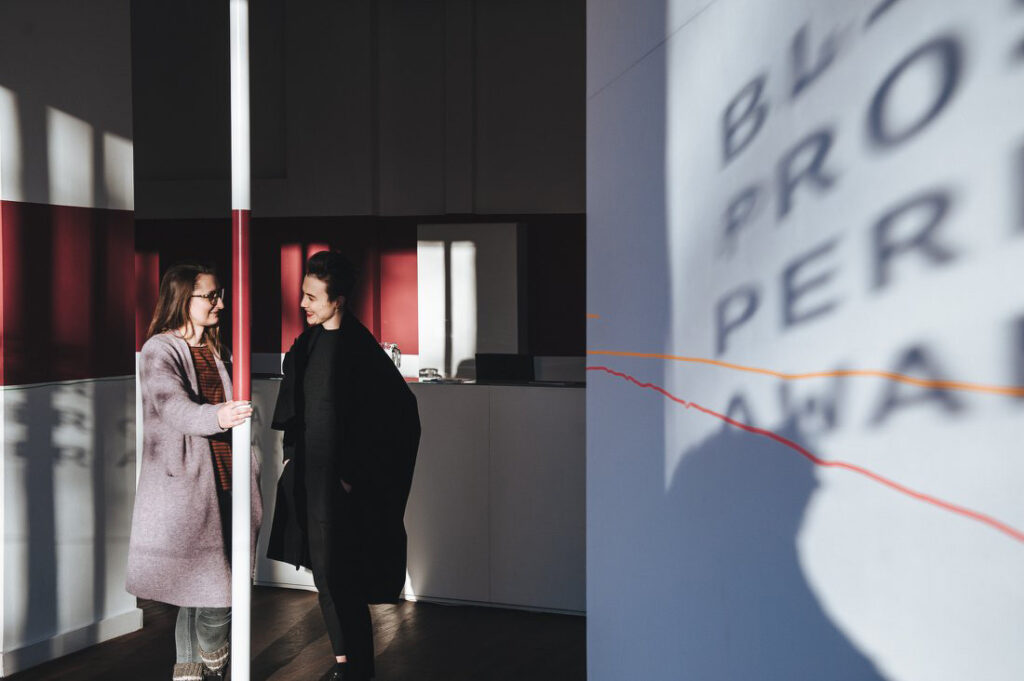
The archive is in itself a living, pulsating organism, whose sole purpose is to enter into relationships with other organisms, and the only principle for action, continuous change. Within the framework of the exhibition, the archive is the space and time, the past and the future, meeting in the process of sensory feeling and imagining our shared present. (Land)slip is for us the exhibition as a story capable of encapsulating multiple parallel narratives and contradictory emotions, capacious and non-hierarchical. When the worlds are slipping, when they gradually disappear, we need a new type of story, concerning the difficult art of survival on our destroyed planet.
Statement
Re-write
March
People in Places
Site Specific Performance-making
How do we form community connections?
Places are an important ingredient in the connections we are able to form and sustain, whether it be a city, a theater, a neighborhood, or a video lounge. Amidst post-pandemic cultural production many performance makers are moving from stage to site, engaging novel contexts for artistic exploration and presentation. However, this shift is more than a matter of location. A site is also a place which reflects many natural and social histories and communities. As we face troubling legacies of colonialism, displacement and gentrification, and environmental destruction it is urgent to address how we access, interact and impact the places we engage. Here we hear from Joanna Haigood, artistic director of Zaccho Dance Theatre, on her work to engage sites as architectural, material, and cultural environments.
Case in Point:
Skywatchers
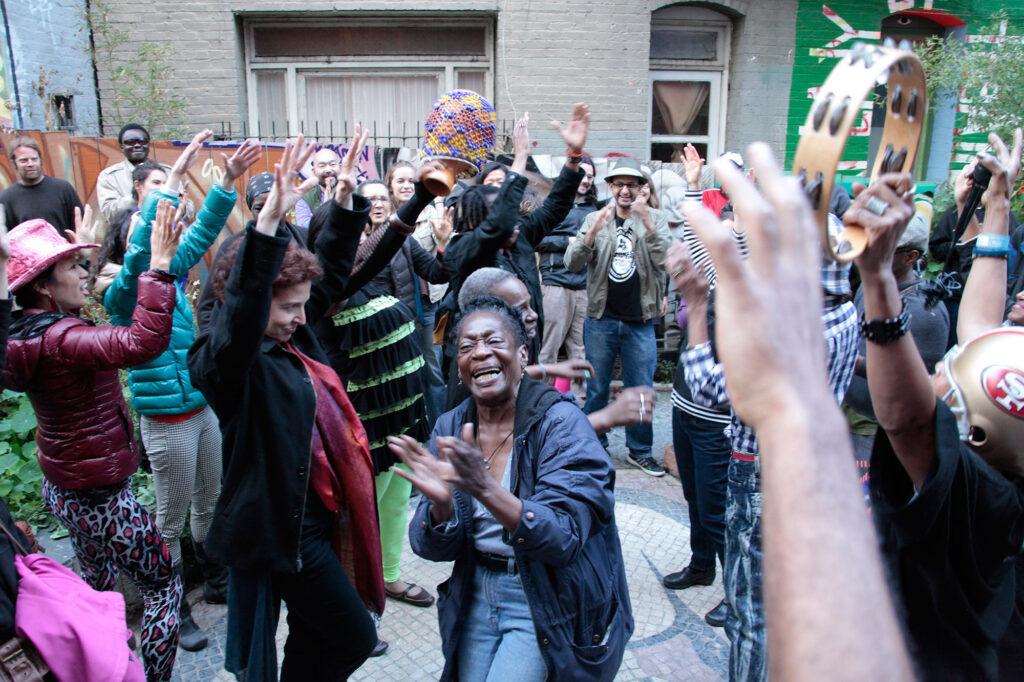
photo by Deirdre Visser
Image description: A large group of people gathered around a central smiling person, they seem to be joyous and are dancing and lifting their arms to the sky or clapping with a brick wall behind and mosaic patio. One person has a shekere rattle in their hand.
SKYWATCHERS
Towards a Slow Art of Belonging
For the last decade, Skywatchers – a program of ABD Productions – has been bringing artists into durational, collaborative relationships with residents of San Francisco’s Tenderloin neighborhood, interrogating the poverty industrial complex and positioning community voices in the civic discourse through the arts. Skywatchers is rooted in the belief that relationship is the first site of social change, that large-scale transformation begins with intimate, interpersonal interaction, and that all stakeholders are transformed in this process – artists, participants, and witnesses. Skywatchers co-create works of art rooted in resident lives and experiences; we also hold weekly rehearsals and arts-based meetings in supportive housing sites in the Tenderloin, a youth program in collaboration with Larkin Street Youth Services, and a leadership academy in collaboration with Glide Foundation, among other arts-based partnerships and projects.
The sections here are excerpted from our full program publication by the same title: SKYWATCHERS: Towards a Slow Art of Belonging, published Spring 2021.
This is the story of Skywatchers
Rooted in the Tenderloin neighborhood (TL) in San Francisco, Skywatchers is a grassroots community arts ensemble working at the intersection of the arts and the daily struggle for social justice. This is the story of our history, our values, and our practice, animated by some of the countless moments that live inside it.
In 2014, we first sat down as a staff of eight artists to write a handbook, we imagined an audience of prospective staff members. We wanted to formalize the Skywatchers methodology, articulating a practice based on 10 years of onsite experience contextualized within the histories, ideologies, and practices of artists and movement workers who inspired us as we’ve made dozens of cross disciplinary artworks in a diverse community of makers and audience members. We’ve had countless challenging conversations and just as many extraordinary creative successes.
We’re still cultivating and collaborating on the handbook, a living document that attempts to hold our stories, and share our processes and methodologies with a broader audience of community-based artists, curators and arts presenters seeking to engage diverse communities in their programming, and community members with whom artists seek to collaborate. This document is a sample, some of what has emerged from all of our experiences, and from each conversation and performance gesture.
It is our hope to transparently share our process and practice with you, contributing to a broadening discourse about the role and history of community-based art, a practice we understand to be deeply relational, durational, and dialogue-driven work that is created across many axes of difference.
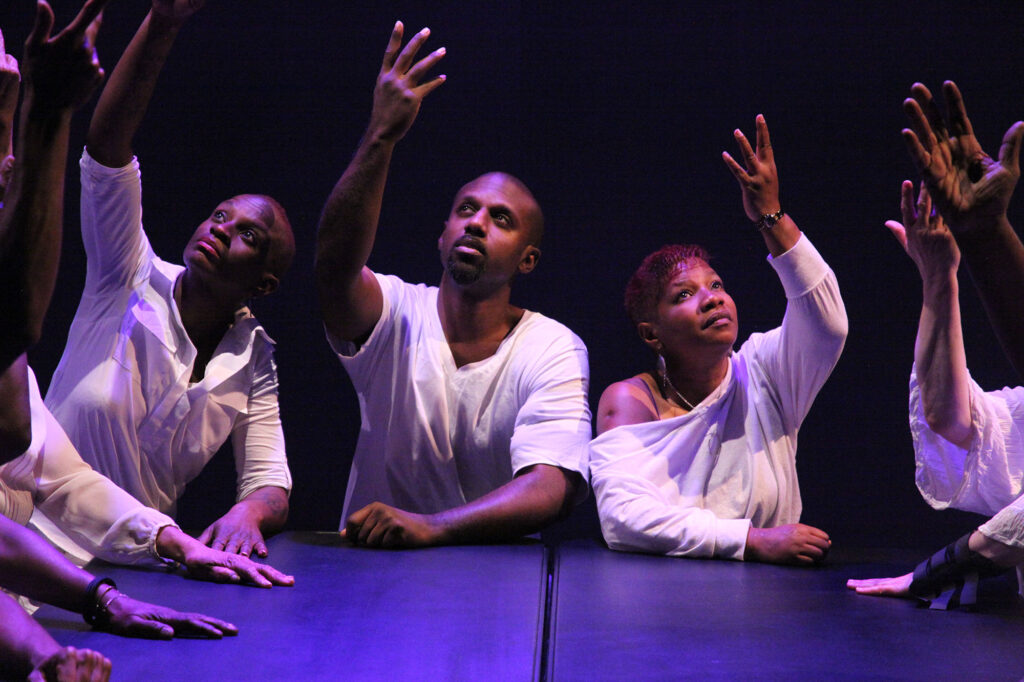
photo by Deirdre Visser
Image description: A group or eight people are seen seated around a table. Seven of them have their hands or forearms resting on or pressing into the table. All of them have one hand lifted up towards a light emanating from above. The background is black and everyone is wearing white.
“Together, Skywatchers is co-creating work that at once celebrates our shared humanity and speaks directly to the most profound ruptures of our society. We position our work strategically in the public domain and the civic discourse with a shared commitment to addressing structural inequity.
We are learning to collaborate in ways that are beautiful, rigorous, powerful, and true to community concerns and urgencies. We are learning every day.
Witnessing and creating together, we discover and invent myriad ways to embody, agitate, celebrate, and render complex stories in eloquent ways that feature the talent and creative abilities of ensemble members. The distinction between self-described artists and community participants is one that we deliberately and regularly transgress in our work, claiming our individual experiences and expertise without placing comparative values on our respective contributions.”
Our process is our product.
Anne Bluethenthal, Founder and Associate Artistic Director of ABD Productions and Skywatchers
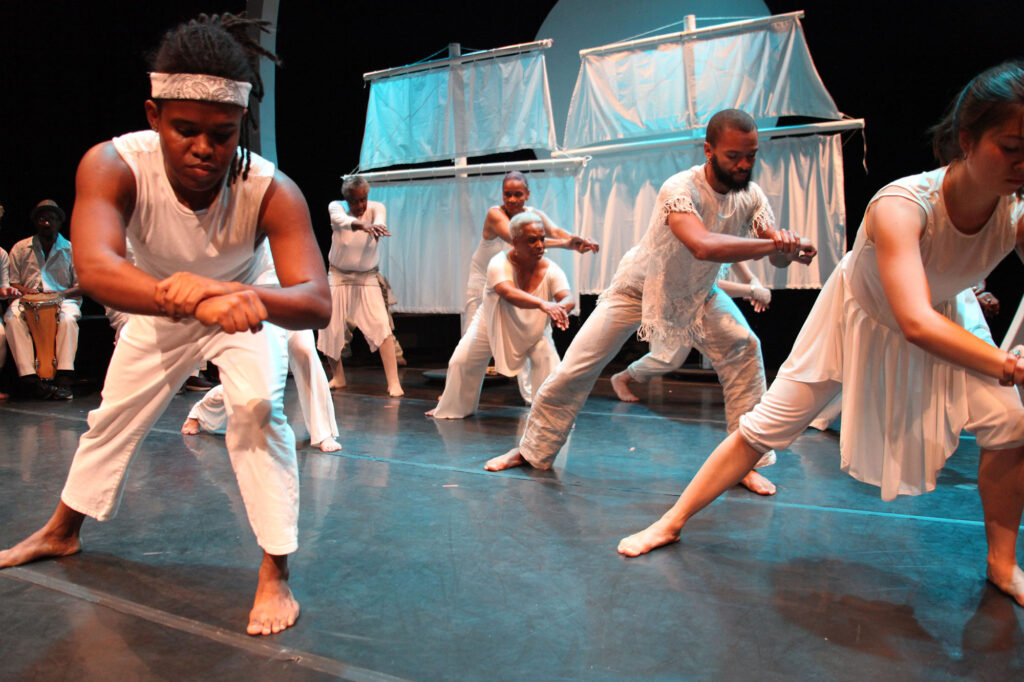
photo by Deirdre Visser
Image description: A group of eight people, seemingly on a stage, grasp their forearms with their left hands in a lunge stance in front of white sculptures that resemble the sails of ships. Everyone is wearing white clothing and the group seems diverse in terms of age and ethnicity.
More people are writing their poetry or speaking up their mind, more people are getting involved.
They have a lot to say. I guess before they didn’t have a forum to voice themselves on.
Rita, longtime Resident Ensemble member
Who We Are
We believe that relationships are the first site of social change.
The Skywatchers Ensemble is an enduring dialogic performance-based and cross-disciplinary community arts program in San Francisco’s Tenderloin neighborhood, informed by an ethos that large-scale social change begins with forging durational relationships of trust. A mixed-ability ensemble composed of professional artists and Tenderloin neighbors subject to conditions of housing insecurity and disenfranchisement, the collaborative partners together create works that amplify underrepresented stories about neighbors’ lives, histories, and urgencies, and then position these voices strategically within artistic and civic discourses.
Our Values
Collaborative
Skywatchers Artist Facilitators engage in enduring collaborative relationships with Resident Ensemble members on projects large and small, and involving a broad range of disciplines and creative practices. All are arts-based celebrations of the lives, histories, wisdom, talents, victories, challenges, and urgent concerns of Skywatchers participants.
Community-Centered
The Skywatchers process is “of, by, and for” its participants-residents of the Tenderloin and beyond. In collaboration with Skywatchers Artist Facilitators, community members become storytellers, co-creators, performers, and audience members on a creative platform of their own making.
Change-Making
We distinguished among four types of art for social change: celebratory art, art with political content, interventionist art, and community-engaged art. Recognizing that there are intersections among them and projects that integrate some or all of these practices, we nonetheless felt that it was important to articulate the characteristics that define them. We bridge community-engaged art, celebratory art, and interventionist practices in the service of social change. By building community, nurturing self-efficacy, and cultivating access to personal and creative resources, Skywatchers supports participants in becoming effective agents for change in our own lives.
Community Building
Leveraging strategic partnerships with a cohort of cross-sector stakeholders, ABD is able to effectively build local coalitions, nurture new audiences within and outside the neighborhood, and position resident artists’ work in a variety of public settings. In this way, and because all performances are free and open to all, Skywatchers reaches artists, co-creators, and audiences beyond the traditional theatre-going population.
Connective
The connectivity intrinsic to creative collaboration helps participants build trust in each other. Skywatchers is plugged in throughout the community (via our aforementioned 15 partners) so the work we do serves as connective tissue among many neighborhood groups, organizations, and initiatives.
Humanizing
The conditions of life in the Containment Zone are dehumanizing: Residents experience persistent micro- and macro aggressions that are a daily assault on one’s sense of worth and value, daily deprivation of human needs, and daily confrontation with a street-life that’s a product of oppression and perpetuated by civic neglect. All these things are dehumanizing. Through the work we’re doing, we aren’t so much humanizing, as undoing the dehumanizing effects of structural oppression, by affirming with every part of our process and product the humanity of every individual involved. Being heard and also seeing one’s own story in a broader social context creates the space for ensemble members to imagine and manifest change.
Strategic and Multi-Disciplinary
Skywatchers events range from site-specific performance installations to formal theatre-based works; from drumming circles to memorial processionals; from documentary film to dialogue as art; from public performance to intervention; and from open mics to photographic portraiture. Each work emerges from the will of the community, the resources at our disposal, and the talents and strengths of all artists involved. The form is selected to best position resident voices in arts and civic discourse.
HOW WE WORK
Relationship-driven and non-prescriptive, Skywatchers’ methodology focuses on collective creative process over artistic product by emphasizing four key values: Relational, Durational, Conversational, and Structural as shown in the figure above. Anchored by these values rather than an aesthetic or narrative agenda, the artistic products manifest as formal performance, arts-based organizing, or creative advocacy. The practice can be responsive to community needs while also offering long-term scaffolding for collaborations among Tenderloin residents, artists, and service providers.

Relational
Skywatchers is structured on the belief that relationships are the first site of social change. Consistent with the Social Ecological Model of public health, this asserts that larger-scale community and structural change begin with bonds formed by intimate, interpersonal exchange. It prioritizes building radically reciprocal, caring relationships of trust across differences (of race, gender identity, sexual orientation, age, dis/ability, etc.), living outside of our comfort zones, and resisting transactional interactions. It is grounds for vital, emergent, creative processes.
Durational
The second foundational element of Skywatchers’ methodology is duration, a commitment to “move at the speed of trust” (Brown, 2017). Skywatchers artists have shown up weekly at multiple program sites for nearly a decade. Their reliable presence creates structures for participants who attribute their heightened sense of belonging and decreased social isolation to Skywatchers. The other three elements – relationship building, emergent conversations, and structural change – all take time, as do iteration and evolution of the art.
Conversational
In Skywatchers, community residents drive the work; shared vision evolves collectively through conversation. Relationships of trust, built over time, grow through a spirit of curiosity and discovery that happens in ongoing dialogue. Skywatchers’ conversations are purposefully open-ended to allow for strengths, needs, priorities, ideas, and problem-solving to emerge directly from community members and result in artworks that are urgent and exciting. This does not mean that the process is unstructured; rather it is purposefully structured around dialogue that begins without knowing what the outputs or outcomes will be. Although these unknowns may be challenging for funders and partners, they are most critical.
Structural
Skywatchers’ creative process and its resulting artistic footprint appear to have engendered more civically-, politically-, and socially engaged lives. The program’s foundations – relationships of care and trust built over time, reciprocity, and a strong community of collaborators – cultivate the conditions for collective action, meaningful social change, and the possibility of influencing the world in ways residents report they had not thought possible. As individual stories are joined by a chorus of similar stories, they inevitably illuminate a shared social, cultural, and political landscape and yearning for change. The artworks situate personal narratives within the larger structural justice and equity contexts and embody, animate, and confront difficult political issues in heart-opening, humanizing forms.
Applying arts-based processes to advocacy, the program also cultivates leadership from within the community. In 2017, Skywatchers launched its Leadership and Political Education Program (L&PEP), which graduated 40 community residents (in 4 cohorts over 3 years) who have continued to engage in creative protest, community organizing and advocacy. As Skywatchers’ rootedness in Tenderloin SROs deepened, the program fostered the development of a network of neighborhood anchor organizations based on reciprocal, cross-sector, and instrumental collaborative relationships that has been working to effect policy change.

photo by Deirdre Visser
Image description: Three people are seen singing or calling out on the street. There is a central figure that holds a microphone with their hand and index finger point to the sky.
UNDERSTANDING POWER and PRIVILEGE
One of the most pernicious and complicated challenges of talking about privilege is that it’s typically invisible to those who have it, while felt deeply by those who don’t. It is a truism to say that there are pervasive structural inequities in our society based on race, ethnicity, gender, sexual orientation, economic status, national origin, age, and educational attainment, among many characteristics intrinsic and extrinsic to us. Recognizing this as the ground on which we all stand, power and privilege can also be context specific, functioning on both interpersonal and structural levels. In other words, we may hold power in one arena while feeling relatively powerless in another. We invite each other to reflect on both situations, how we feel in each, and what we assume about the person or people who are at the opposite end of that spectrum in a given setting.
There is always an enormous amount we don’t know about the experience of others. Our task is to listen and be attentive to our assumptions. This is especially true when we engage with communities of which we are not a part. In Skywatchers we create spaces that encourage multi-modal and diverse expressions of creativity and intelligence, freedom from oppression and discrimination, and mutual respect. The facilitation of such a space invites staff members to reflect honestly on the power and privilege we hold in the project, and the assumptions we may carry about our collaborating partners. Our dress, behavior, education, and employment status may mean that we are treated differently than some of those around us. Conversely, where we may be taught to see scarcity, abundance also resides.
In Skywatchers, we practice entering from a place of curiosity and self-reflection, using the following as guideposts:
Listen to ourselves more clearly.
We’ve all grown up surrounded by stereotypes. We tend to be especially attuned to the assumptions that seem to reflect negatively on a group with whom we identify, and less conscious of those we hold about others. It takes ongoing and rigorous work of self-observation, humility, and openness to examine our preconceptions. Cultivating the ability to listen with an open heart-mind – with curiosity and attuned to our own reactivities – is essential.
Ask questions.
In community we encounter not only our own preconceptions about others, but others’ beliefs about each other and about who we are and where we come from. Though we may hear a statement that does not sound or feel right, asking questions is an act of generosity; saying, “This is what I heard; is that what you meant?” assumes good intentions. Genuine curiosity creates an environment where we are all learning from each other.
Speak from our own experience.
The corollary to this is that we ask others to speak from their own experience as well. While we may perceive that we share an identity with someone in the room, the ways that one facet of our identity intersects with other facets may not be the same, and therefore the impact will be different. For example, we may share another participant’s sexual orientation, but our experience of that identity is informed by our religion, family structure, class, education, ethnicity, generation, and geographic location, among other factors.
The process of inquiring into the places we do and don’t hold power and privilege is alternately challenging and humbling; in either case it’s ongoing, and it’s a process that we enter into both individually and organizationally so that we can better understand our roles and be more effective and creative collaborators.
REFLECTING on POWER and PRIVILEGE in the ARTS
Cultural theorist Grant Kester has written extensively about community-based art, critical of the tendency that community-based artists have to imagine that through the medium of art they can transcend differences between themselves and the community with whom they’re working. Widespread, too, in Kester’s analysis, is the assumption that the underserved communities that artists typically enter are not themselves politically coherent, and that art has an ameliorative effect on a broad range of social ills. This lends a paternalistic air to many projects, and underestimates or discounts the cultural integrity and power held in that community.
Artists, like galleries or theaters, are not culturally neutral; artists are themselves products of multiple social and cultural contexts. As an artist entering a community that is not your own, or as a community member collaborating with artists to share stories and envision and manifest change, this is an invitation to take a leap of faith, listen with curiosity and humility, be attentive to one’s own assumptions, and engage in a reciprocal process of learning. While we share Kester’s belief that art doesn’t ameliorate or erase differences of experience, access, history, or oppression, we do believe that the participation in collaborative creation can be personally transformative, foster community, and serve as a productive medium for dialogue across difference.
In the San Francisco Bay Area, we find ourselves situated within an arts community that self-identifies as socially engaged and progressive. It is largely thanks to the relative interest and support for work that operates at the intersection of art and social justice that the imagination of programs like Skywatchers is possible. While this feels particularly true in the Bay Area, art projects that respond to the current socio-political climate are also gaining momentum nationally and internationally. If artists and community are two points of the triangle in this practice, arts institutions serve as the third. These organizations may serve as a performance venue or sponsor, and are variously able to provide visibility, infrastructure, and institutional support. Despite the professed desire or manifest action to engage meaningfully with a diverse community, there is nonetheless often a class disparity and cultural divide between the institutions and the communities they hope to engage.
The Arts and Gentrification
In the last few decades arts funders and civic agencies have privileged capital campaigns for venue acquisition, and those same leaders and developers see the arts and culture as the avant-garde in transforming economically blighted neighborhoods. This has meant that art venues are often located in or at the edge of depressed neighborhoods, becoming – whether intentionally or not – complicit in the wave of gentrification that has displaced whole communities, and transformed inner cities across the country after preceding decades of subsidized white flight to the suburbs.
As the Skywatchers Ensemble steps across the divide and into these arts venues, the intersection of cultures affords us an opportunity to witness and reflect, on the one hand to see the fertile ground for an intersection that could be fraught with micro-aggression and unconscious bias, or on the other hand, a locus of real institutional learning and relationship-building across differences. In the latter case we have the opportunity to facilitate what many well-meaning venues speak to but often do not know how to realize: the transformation of an elite art space – to which access is literally and figuratively contested – into an inclusive, welcoming space that is embraced and enriched by its neighbors.
Cultural Norms Aren’t Neutral
On dress/tech rehearsal and performance days, we typically make a call time up to three hours before the show starts. This means the artist facilitators might arrive at the space even earlier than that to set up, prepare food, or make reminder phone calls. Community ensemble members might arrive before call time as well, coming to rest, eat, get dressed, practice lines, and catch up with one another. The downtime – moments not spent rehearsing or actively creating, but instead hanging out and eating together – is an important part of our work together. This style of pre-production convening isn’t a cultural norm in the performing art world, and at times it has felt clear that theatre staff are uncomfortable, and organizational systems have difficulty accommodating new norms.
At the Front Door: Access and Entry
Balancing security and accessibility is a dilemma faced by most venues these days and the arts community in our city is no exception. Most spaces have some form of security upon entering, whether that takes the form of keyed entry, codes, staffing, or call-in systems. They are all put in place as a barrier to entry to the neighborhood passerby. If there is a theatre employee watching the door, how do they determine who to let in? Do they know the neighbors? We have seen institutions aim for a welcoming, non-biased atmosphere of inclusion, and others build in more physical and social barriers fueled by unconscious bias and suspicion.
Accessibility also comes up in the architecture and location of an institution. Many of the Skywatchers Ensemble members use wheelchairs and walkers to move through the world, both on and offstage. This is disproportionately true in low-income communities who often face more barriers to good healthcare, live in food deserts, and have experienced higher levels of trauma. Access issues are experienced as barriers when moving across the city on public transit or entering buildings unaccustomed to supporting performers of multiple abilities.
What has served our community best has been a genuine attitude of curiosity and reciprocity of learning. This bodes well for building good community relationships. In making organizational decisions, it can be valuable to remember that the behaviors and economies that play out on the street are the result of deep and intergenerational inequities that disproportionately affect low-income communities of color.
Programming
It is not uncommon for the Skywatchers Ensemble to be invited to perform as part of regular or adjunct programming. These engagements range from fully produced performances to processionals, to song-leading, to informal performances alongside political or community events or gatherings. On one such occasion, we were situated outside of a very established theater venue, on the front steps for an afternoon performance only a couple of hours before a higher profile theatre company would be presented on the main stage. The Skywatchers ensemble members were offered tickets to the theatre performance – ironically a piece about the history of the Tenderloin – performed by another professional theater company, whose performers did not have lived experience with the production themes. The company performers and creators of that main stage production were not told about – and therefore were not in attendance for – the Skywatchers performance by neighborhood residents, and there was no encouraged or facilitated dialogue between the performers of the piece and our ensemble. The irony aside, we see this as a significant missed opportunity for the type of community dialogue that this arts venue advertises.
One ensemble member, Wanda, felt that “they looked down their noses at us,” and when asked if she stayed afterwards to watch the performance about the Tenderloin onstage said,
No, I just didn’t feel right…I mean, we’ve been performing other places on stage and we’ve gotten a lot of good praise, so what was wrong that we couldn’t be there?
Wanda Jean, Resident Ensemble
Gigi agreed, also conscious of competing with the surroundings. She prefers the theatre setting, where “it’s just us and the audience and we’re in full control.” In this situation, it “felt like we were cast-offs.” She also spoke to the power of performance created by those with life experience in the subject:
That’s the interesting thing [about Skywatchers’ work]: everyone is taking part of themselves and putting it out there… People’s individual ideas and what they wanted to say was put into this story. It’s not a regular story like a play, but individual pieces that personify different parts of the Tenderloin. And you know it’s from the heart, because these are people who’ve lived this stuff. It’s not just someone sitting there writing a bunch of stuff out who’s never lived in the TL.
Gigi, Resident Ensemble member
The Geography of Comfort
In San Francisco – like many cities – crossing a street can mean entering a new neighborhood; most of us have internal barometers of comfort and belonging that sound the alarm when the terrain has changed. While there is an understanding that established arts venues – regardless of location – offer a different and favorable kind of exposure not afforded by public spaces, informal venues in SROs, or neighborhood gathering spaces, the Skywatchers ensemble members whose words appear here generally feel most comfortable when performing in the Tenderloin.
“Some of the places that we’ve gone [to perform] I just didn’t feel comfortable,” reflects Wanda. Describing the dynamic that sometimes occurs when the audience and our ensemble are sharing a space outside of the performance, she said it feels like, “Oh, here they come.” She went on:
Listen, people can give a certain type of feeling. The way they look at you, the way they talk to you…not just arrogance. It’s like, “Oh, what are you doing here?” It’s like we’ve come from the wrong side of the tracks, if you know what I mean. I don’t like that feeling.
By contrast, Gigi remarked, “there isn’t any place I don’t feel welcomed,” but emphasized the importance of having ample time to rehearse and set up in a venue in order to maximize her comfort level when performing.
Wanda named a few Tenderloin venues that “feel like home,” and expressed appreciation for staff that,
…understands exactly what everyone else is going through. Because we’re all part of the Tenderloin so therefore we’re not, you know, wondering what’s going to happen there. Because even though they don’t live in the Tenderloin, a lot of them come down to the Tenderloin to work, and they stay informed about what’s going on in the community.
She said she likes those spaces in the Tenderloin that are more established, as opposed to the Tenderloin National Forest or an informal space inside an SRO, because it those spaces bring new audiences:
I had this lady come up to me and she said, “I remember seeing you somewhere!” I said, have you ever come and seen Skywatchers? She said, “*Gasp* THAT was you?” She invited me to come and perform with them and she said you will be paid for it. It’s more exposure, because it’s a certain type of people that come there. People that can actually…movers and shakers, basically.
Speaking about our first time having a weekend run in a Tenderloin-based theatre venue, Gigi said,
I was curious about what kind of people would be coming and all that, but we got some positive reactions and that felt good, that our work had come to fruition. That all our work paid off to achieve this thing.
Comparing these experiences with a performance in the auditorium at Kelly Cullen Community, the SRO and community space where we hold our weekly meetings, Gigi added,
The makeup of the audience is better at Kelly Cullen, because we’re telling their story. Whereas the audience at [other established venues], it’s like we’re doing a play about France or something, you know? I’ve never been to France so I’m just accepting it in that way. They’re just as appreciative, but when we’re telling their stories, they can relate easier. It’s easier to get the neighborhood to come into Kelly Cullen. I don’t think the neighborhood knows [the other venues] exists, so to speak.
Making Change
Just as it’s important for artists considering starting a community-based practice to ask questions of themselves about their values and positions regarding power and privilege, it is also important for organizations and institutions to reflect on both their intentions and ability to support the Skywatchers Ensemble or another community-based company [particularly when the invited artists come from marginalized communities or communities where cultural differences are significant]. There are also decisions big and small that venues can make that can foster a sense of welcome and enhance dialogue in which all folks at the table can learn from each other. In line with the areas of concern outlined here, we encourage organizations to think about:
Access: From public transit to the front entry to the stage, are there physical and cultural barriers to entry?
Money: Will community members be adequately paid? Are tickets accessible to a broad audience?
Benefit: How does the organization benefit from the relationship, how are they willing to be changed, and how does their presence enhance the community?
While many organizations write “community engagement” into grant proposals, the work of critical self- reflection and institutional change is an exciting but challenging road. We hope for a real desire to make the arts a space to disrupt social hierarchies and build dialogue across difference, a process that few community arts organizations actually take on. In the sometimes-uncomfortable intersections between worlds are the profound possibilities for change. The story is still being written.
Slow Art and the Politics of Care in an Outcome Market
We need art. Communities use art to reveal, interpret, and imagine the conditions of their existence. So what happens when the broad needs of community-based art meet the more narrow standards and conventions of the art market? What does this mean for those of us who infuse our process with fundamental values of care and reciprocity? With relationship building and co-creation? How do the needs of a community fare under these metrics of aesthetic worth and artistic value? What gets to be considered art and who gets to be an artist, and who do those assessments serve?
The slashing of federal, state, and city funds has pushed arts funding increasingly into market-based spheres, subject to the vocabulary of commodification, privileging product over process, audience numbers over quality of relationship building and community partnerships, spectacle over duration, and external quantitative metrics versus qualitative, participatory self-assessments. Further, metrics that demand evidence of “lives changed” or “social change achieved” in one season lay the groundwork for exploitation and opportunism, just as those that expect to see programmatic and financial growth from year to year are exhausting the arts ecosystem, leading its most valuable assets into burnout.
Artists seeking funding must annually predict and justify their own artistic production. Even before establishing community with which to develop a project, artists are expected to know what their product and those measurable outcomes will be. This is highly problematic for the community-based artist for whom being open to the emergent needs, strengths, and visions of the community with whom they’re working is essential to honest collaboration.
Instead of the implication that the savior-artist and the noble artwork might have changed the community, maybe we could instead ask how the artists themselves have been changed by the work? How their assumptions and blind spots have been revealed and challenged? What is the quality and depth of the relationship? And how has the process of collaboration shifted power and dislodged the structural inequities that largely determine our lives and the art that we make.
By making funding conditional on any particular set of outcomes and standards, funders are shaping the field and predetermining a generation of aesthetic values. Our livelihood as art laborers depends on meeting those standards, even if it means altering programs, methods, timelines, and objectives to provide the quantitative evidence of “success.”
What gets lost in this scenario? What is the cost?
In both times of trouble and harmony, we need the full range of creative production – its diverse practices and forms – and we need all the makers and creators currently working, and more.
In Skywatchers we are setting the terms for our own evaluation, assessment, and impact, towards – as our subtitle suggests – an understanding of Slow Art and the Politics of Care in an Outcome Market.
We want to expose and challenge what is being privileged by these funding models and make a case for a more expansive set of values based on equity, sustainability, deep community engagement, and disruption of entrenched structural oppression. Perhaps then we would see processes of creative production that begin to dismantle these deeply entrenched power dynamics.
There is nothing more fundamental to our humanity than imagination, and nothing more life affirming than the act of creating…This is what we do. In community. Every week.
Anne Bluethenthal, Founder and Associate Artistic Director
The creation of these processes and practices have been important for Skywatchers in our growth and development but should not be treated as a how-to manual. These are a record of previous experiences in Skywatchers and a set of observations and learning experiences that we hope can be a guide, a starting point, a launch pad. We hope that it serves to spark inquiry, discovery, and further creativity. In addition to the specific practices described here, there are indispensable and intangible qualities that are both the foundation and the connective thread of Skywatchers. These are not skill sets to be acquired, but more of a pervasive attitude to embrace. Skywatchers is rooted in respect, joy, and humility. Respect manifests as the belief that people have a right to self-efficacy, and the trust that people are intelligent, creative, and good. We enjoy the company of our collaborators and learn both with and from them. Our ability to be humble within this process and amongst our many collaborators is our very door into the work.
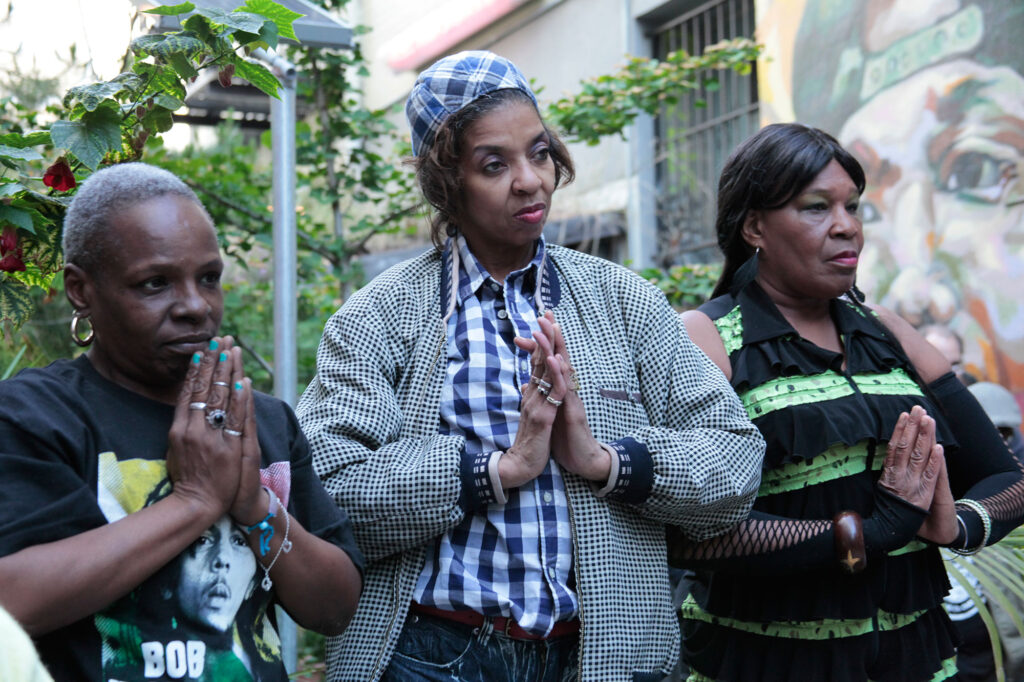
photo by Deirdre Visser
Image description: Three people stand side by side with their hands pressed together at the sternum. Behind them is green leafy plants and a mural of a face.
We’re grateful to have shared the Story of Skywatchers with you.
FEMME-ifesto
Please click through here to read
Skywatchers Lexicon
Skywatchers Artist-Facilitators are emerging and mid-career artists working in dialogue with Resident Ensemble members (see below.) Facilitators collaborate with residents to transform the issues raised in community workshops and dialogue into creative expression, whether movement based, visual, or spoken word. The dialogue-driven creative process allows participants to see their story transformed, perhaps expanded through connection to larger social narratives, injected with humor, paired with another related story, or otherwise re-contextualized.
Collaborating Artists offer support for the ensemble in various capacities, including offering workshops throughout the Skywatchers’ season and/or supporting productions.
Community Partners are individuals and organizations with whom we have fostered working relationships in various capacities to share resources and information; to help organize and plan actions, interventions, campaigns, or programs; and to build effective alliances for change.
Containment Zone: A containment zone is a place where a city allows activities they want to keep out of other neighborhoods. Many Tenderloin residents and advocates believe that the City treats the neighborhood as a containment zone for open air drug sales and use, prostitution, and other illegal activities. The impacts of this narrative on community health are real, including persistent traumatic stress.
Conversational/ Dialogic: Since the relationship building over time is based on ongoing conversation, we alternately refer to the work as conversational or dialogic. The art emerges from conversation.
Of, By, and For the Community: In describing the community-based performance work of his friend, Maryat Lee, actor Ossie Davis used the expression “of, by and for the community.” Richard Owen Geer elaborated on this phrase, applying the values it suggests to a field variously described as community-based art, socially engaged art, social practice, or community-engaged arts practice. Of means about the community; by indicates that it’s created, authored, or performed by the community; and for means that it’s witnessed by and benefitting the community with whom the work is created.
Resident Ensemble: Though we understand there to be only one Skywatchers Ensemble, there are moments when it’s useful to distinguish between ensemble members who live in the Tenderloin and those who are local artists, whether staff or collaborating artists, who don’t live in the neighborhood. When Skywatchers began, the term “Resident Co-Creators” was used to describe participants who were residents of the Tenderloin SROs in which we held weekly meetings. Today the Skywatchers community has grown and broadened to include members who live in SROs or supportive housing settings outside the boundaries of the neighborhood, and those within the TL who are unhoused or housing insecure. We use the term Resident Ensemble with an awareness of its limits.
Skywatchers Ensemble refers to all members of the group – staff, collaborating artists, and Resident Ensemble members – who are integral to the realization of our multidisciplinary performance-based work.
Contributors
jose e. abad, Zoe Bender, Anne Bluethenthal, Zulfikar Ali Bhutto, Malia Byrnes, Hope Casareno, Gabriel Christian, Rebecca Chun, Melanie DeMore, Leigh Gaymon Jones, Jubilee July, Shakiri, Dazié Grego-Sykes, Donna Rae Palmer, Yanina Rivera, Deirdre Visser, and Joel Yates.
Ensemble 2021
jose e. abad, Shavonne Allen, Calvin Barnes, Anne Bluethenthal, LaWanna Bracy, Kathy Brown, Malia Byrne, Charlos the Prince of Music, Gabriel Christian, Melanie DeMore, Kim Diamond, Wanda Jean Edwards, Gigi Goddard, Maurice Hudson, Samantha Kuykedall, Freddy Martin, Te Martin, Regi Meadows, Lotus Miller, Duane Sears, Shakiri, Cheryl Shanks, Silver Sonic, Lee Staples, Deirdre Visser, and Joel Yates.
Assessing Access
A science and technology scholar, a neuroscientist and a choreographer engage a discussion around the concept of access from their particular perspective and field of practice through responding to the same set of open-ended questions. Not intended as a panel of experts, but rather a set of personal perspectives side-by-side to provide a point of reflection and inspiration across distinct but interconnected schools of thoughts. What can we learn about our value systems related to access by measuring conceptual divergence and proximity from others? Can such comparison reveal previously opaque political and historical context around access as a concept and directive?
I believe that those of us who position the arts to be a site of transformational experiences, personal development, and connection to community have a deep responsibility to engage the idea of access, asking how the art field may be reinforcing or disrupting harmful patterns of exclusion, inequity and homogenization.
Access has long been a concern in the arts field. Why is it important to have access to the arts? For me personally, engaging in the arts opened up planes of thinking and being that felt vitally urgent to my personal development, healing, and self-realization. While also sparking connections beyond my own frameworks, ability, and perspectives; art points to unlikely associations rather than reinforcing associations that stabilize my existing perspectives. Beyond this internal, personal impact, I believe the arts to be uniquely powerful in building community. In holding this belief, I therefore must insist on urgently exploring who has access to the arts, and how that access happens beyond base-level ADA requirements related to “accessibility” and economic affordability measures. How can we better understand the psychological, social, and cultural conditions required to truly invite and connect with people from more varied personal backgrounds in and through the arts?
Score for active relating: Marysia
I accept the invitation from my dear collaborator Meg Foley: Score for active relating.
Take 1:
I take my car and go to the Centrum w Ruchu in Warsaw. On my way to the small studio I pass by the storage and pick up one box of props made by Alicja Bielawska for my solo piece Wychodząc od działania. I choose 2 objects and 2 groups of objects and I place them in the space. I think of Maija Reeta Raumanni and how she taught me to notice objects and pay attention to their presence in the room.
I move backwards. I move back in time. I move backwards and I want to arrive at a time before the pandemic, before my burnout, when I practiced and performed this dance. I am somewhere between 2016 and 2018. Moving backwards I meet my body. My body is in 2021. I am 42 years old. I live in Poland. I am a single mother. It’s been 5 months since I last performed. I practice once a week when I teach. I hardly dance otherwise, and I don’t exercise much. I have pain in my right knee and my shoulders are lifted most of the time. I feel very alien improvising alone in the studio in front of a phone camera. I feel vulnerable as I try to attend the score. Moving backwards is impossible. The present moment is all I have. Uncomfortable. Alone in the room with my body, which is shy and unused to attend to scores. An orange wheel is hanging on the wall. Pink folded fabric on the floor. A few steps further a few clay objects, red and pink, a step further a collection of small blue clay stones. I keep moving between Alicjas objects and the smartphone for 20 minutes. Camera shifts my attention to the visual outcome of this moment. I am not working with the visual. I am figuring out the sensations of my moving body, the sensation of my anxiety and my intentional relation to the objects. Their simple beauty and my trembling attention and presence. I leave the studio disappointed.
Take 2:
I am writing this contribution text. I edit the last 2 minutes from 20 min of video and try to select a few pictures.
I decide to move backwards again. I push the floor with my feet and travel back on my chair. I move slowly and let this be nothing special. I drive backwards on my chair away from the computer. I pass the bookshelf. I meet an orange armchair. I see the reflection of the shadows on it as I move it with my leg. Sunset followed by an immediate sunrise on an orange plane.
I think that my violet dildo would look great as a part of this orange landscape. I let go of this image as I move back on my chair, lift my legs off the floor and float supported only by my bottom on the chair. I sit in front of an empty armchair. A woman alone in the room looking at an empty chair in front of her. Who used to sit on this chair? No one really… me breastfeeding my son many years ago. Then my body twists and my chair rotates 180 degrees, a line of chairs facing the same direction like on a bus. The seat behind me is empty. And then slowly my body drives backwards away from chairs and narratives, towards the front of the room, I begin to shake my body, then move without stoping, fuck going backwards, I move across the room, I see moving shadows and furniture, I pass the bookshelf and think I could count all the books with the word BODY on the cover, I see the stairs to the attic, like vertebrae of a dinosaur, I enjoy steps up, then my journey down all the way to the floor, I roll on my back, I do some uncoordinated back rolls, I discover a corner of the room, the floor, the space to stretch my arms out. I am happy, that movement is so careless, that the somatic sensation is so satisfying, so available, inner pleasure, getting to know new areas of this space. I am so happy there is no going back. I hold the sides of the doorway with my two hands and I elevate my chest to the ceiling. I enjoy the stretch of the front of my body, I see this lockdown “living” room backwards. New space opens in my body and from the ceiling down. I feel this travel is soon going to end. I walk on my four to the corridor. I forgot to switch off the light to the bedroom. I roll my vertebrae back to standing. I walk to switch off the light. When I return, the dance is over.
Score for Active Relating
Move backwards
Move backwards until your curiosity – your desire – is caught by something in the room
An object
A space
A play of light
A relationship
____________ (fill in the blank)
Meet that thing
(there is enough room around the center of your attention to move as you need. You are never held to something unless you want to be.)
MEANING – you can move (backwards) in any way that you want or need to today
Meet that thing
Balance your attention between the thing and your physicality
AND
Make an angle with the thing
Follow the lead of the movement into that angle to
keep moving
keep meeting
keep figuring
and find a new moment of curiosity/desire
Make an angle with the thing
Meet that thing
Again
Build a community of relationships in your space
Keep your attention balanced inside your physicality
End when you’re finished.
Active Situating
Dimes and Yar
my hands aren’t wings
pour weight but not out into space or the floor just to the surface
“forget who gave me this sweater” I remember
moving around two axis at once (dumb)
an angle is made by gifting your whole body
shiny things
a wormhole for a framework
encounter = see (duh) plus let self be seen which fucks up seeing that’s why it’s funny
fruit with pits fruit with hard outer shell fruit with no outer shell no fruit
this house is the exact age when my grandfather came to this country, this city and this tree
all at once I’m not noticing stories these objects are meant to reassure me of
shadow grows smaller = devastating (for real)
this time when I do the practice, it starts with the thing that I can see that’s furthest away – not the actual star out the window ‘cuz the lights are on but in a picture of space and wormholes, framed in the center, one bright lone star exploding. Those toys named for ancient civilizations when you throw them they explode, actual shards. Like August’s blood, twelve weeks gone. Except to encounter it I don’t choose this but know it is already that far. Next, a screw – the head, to be exact – two circles, shiny as the dimes in that bedtime chapterbook – reading it thinking it’s like dinner vegetables, “dimes” and “yar”, vocabulary he doesn’t know and has no cause to know is probably even better for kids, right? I know I’ll just croon and he can sort of get it by osmosis. Like, why not tell the kid with the queer and not-cis parents (us) about the little mouse clapping gentlemen on the back, bowing to the ladies on the street, waving his cap “jauntily”. And thus was started on the path to madness. His (the mouse’s) mother keeps crying at the end of each scene, but does nothing to protect him from the mean cat and dogs. I walk by someone digging out her car, and it’s palpable, her sense of obligation and resentment a cocktail sloshing at this address. As though the body were a history house and all that material seeping through each encounter ‘till we’re constantly falling apart wet paper bag at the seams. What’s the relationship between the new pathos leaf unfurling and the notes on the sheet music stand nearby? The same painting over and over – two figures and between them a house and behind that a tree. Ezra gives me one of his presents, a piece of tape, says it’s the vaccine, no it’s the shot that put our cat to sleep, no now he says it’s a solar battery from the mean neighbor, I raise a brow. The parking neighbor is finishing up an igloo in his front yard. He doesn’t seem to have friends except today one is threatening to bring over soup, another sticks a branch in the ground. I’m not naming anything anymore. It’s just more situational grammar. If A could whittle B would spark.
Every 10 Seconds
Back Flesh
for Meg
Statement
Re-write
February
Directions to the hotel.
In a meeting, people are talking through the formation and execution of the virtual hotel event excitedly. I post notes into an empty email window, and Google auto-suggests the email subject for this fictional email as “directions to the hotel”.
This sounds right.
In the face of a world pulling apart, we insist on being together.
We need directions.
I am in Roseville, Michigan, USA. I am on the traditional lands of the Ojibwe, Ottawa, and Potawatomi Nations. I don’t know where half of you are or even who you are. The group has unspooled or like a snowball down a snowy mountain, gained and gained and gained. It is glorious and disorienting and perhaps what we are now given by having moved THIS gathering into the digital realm.
I miss being in the same room as your eyeballs. We are the shape we take when we are together.
Grand re Union is a revival and embrace of the spirit of being united in collective thinking, acting, and dancing.
We thought of liminal space and where it manifests physically. We thought of a community based in architecture: a neighborhood, an apartment building, a landscape of places to be.
We thought of how we meet, how our meeting spaces have shifted, and our utmost desire to be together – the materiality of our surrounding environments and the dissipation of the virtual space. Can we have both?
Let’s get specific.
A crisis was already with us before the pandemic.
A crisis of growing extremism and polarization – rampant, centuries long racism –
tearing at the fabric of inter-human and interspecies relations,
and our connection to nature.
This is trouble. My context and one example in the world: In the US, continued needs for social justice and racial equity, for reckoning. Pushes against the Patriot Party, against the policing of gender, of reproductive organs, and womens’ bodies. The subjects of these oppressions are humans, human bodies and hair, muscle, flesh, bone, fascia. The soma. That soma – and the Earth – are made of the same things as the Universe.
Let’s slow down. We are not fucking around.
Choreographing change. Dancing our resistance. Collaborating on connecting.
We thought of discomfort and climate breakage.
We thought about discord and trying to talk across the divide, is it even worth it?
Disagreement.
Choreograph. Change. Choreograph. Change. Dance.
Equals resist, resist, resist.
What about the awkward breakout room where you don’t know what to say?
I watched (in a photo) a friend give another friend a box full of things that are fragrant and/or are made to be held. My heart fluttered. Bodies in shared physical space. We put our intimacy, our spirits into intention, into something that can be posted (mailed for the US inhabitants), because I can’t hug you, I can’t sweat with you, I can’t scream with you in a room with no ventilation.
We won’t buy what they’re selling. Thank you, Walt Whitman, yes, I do contain multitudes, and I won’t be fixed. Please, goddex, don’t let me be fixed. We are not singular. We are failing – falling! (Thank you, Mariana) forward? Sideways? Up. Side. Down.
Dance, change, choreograph, change, collect, change.
The center of the Earth is below each of us; did you forget?
This is trouble. The only way out is through.
And so a hotel full of simultaneous voices in various spaces. There will be things that happen over time with other people in places. A hotel that exists in the digital ether as we define it robustly through our own physical rooms. We are the shape we take when we come together. Many people building. There is so much it can only be accounted for collectively and in intimate, immediate exchange. We hope.
Can we embrace the honor of both giving and receiving, and that it is not always about the material exchanged but the act of exchanging itself? Often unquantifiable and wholly undeniable. It is a conversational, unfixed state. You have to listen to learn. Choreograph, change, choreograph, change, collect, change.
Close your eyes and picture yourself standing in a line with strangers, shoulder to shoulder. What do you feel?
Grand re Union Statement
see all versions
The Tablecloth became
a listening room
Scene: receiving someone in silence (amongst other possible versions) where there would be a teacup, whatever shape and material you would like it to be. Where to pour yourself a tea, preferably but not exclusively.
Prep:
The placement of a medium size piece of cloth, a mantel-like of a range of about 40x40cm, could be a canvas-like or linen (for the pleasure of a subtle texture) plain colour with a small minimal graphic image on one corner, as identification for our space. Where are we?, maybe an identifiable graphia.
I think, actually pondering, the cloth has a text containing some writing regarding the bases of comfort, the bases of tradition and an entanglement regarding what lays underneath this personal ceremony.
An eagerness for writing on a piece of cloth, might be self indulgence. For me that process unveils a creation of understanding through tracing graphias: drawing like letters. So the outcome will be a tablecloth with inscriptions on the same tone as the fabric, the inscriptions will be either embroidered or printed with silkscreen technique, with a finishing turn-up.
They ended up being 20, cause the number was just that one in the middle between 10 that could be too little and 40 which my hands couldn’t endure. All of them have a 20x30cm surface, embroidered on lienzo madreselva with a gesture-graphia.
(Pause)
I was wrong, there is not much to say, much has been said on so many surfaces. In fact surfaces have an inherent capacity of absorbing energy. Embroidering became a meditation in action, needles to “have” or “be”, doddlying graphia as a synthesis of being, can there be a path?
(Pause)
1° Attempt Provocation to engage-room:
Given the impeccable quality of the tablecloth: the given graphia and texture act as an invitation/provocation that consist on: while being together, either engaging in conversation or in silence, the tablecloth surface could become a scribbling material. As writing in such an object could open space for a creative transgression.
So each embroidered napkin/tablecloth piece is accompanied by a pencil or a sharpie to do so.
A consideration for not giving instructions: have the sharpie somehow attach to the piece.
During our conversation then, the symbolic feature of the tablecloth functions as a base, to extend and set intention for a ceremony to oneself or a shared experience, a sort of altar ceremony. This is a tender action that gets activated through our daily rituals either alone or shared, and what we many times don’t consider is the background for caring, has a multi source origin and diverse circumstances embedded in objects, let that sink and accept.
(Pause)
Disruption: The sendout
Event: I was very eager to send a special infusion for us to share, 4 flavors in fact: I collected two very special things, a set of 40 teabags from amazonian fruits and embroidered 20 small tablecloths.
As the idea was to enhance the senses, amplify what is known to those taste buds I don’t know and suspected didn’t know these flavors. So I was rejoicing, the range and mixtures ranged from acai, copoazú, camu camu and arazá-fruits and herbs infusions.
The turn of events has to do with what’s going on (…), but at the same time it has to do with power structure as well. It always existed but now became widely evident during these circumstances.
So the package I was to send out didn’t weigh more than 350 gr. and as all post offices were closed, as rumors of a second wave contagion came through, the only company working for sendout abroad was DHL. The send out of my giving was even reduced. Those teabags, even though they were carefully vacuum packed individually by the company and delivered with all security norms qualified as “food”. Some perspective here: conglomerates such as amazon and mercadolibre can enter easily with free shipping deciding what it is we consume and from who, they don’t have restrictions (up to now).
Having pulled and repacked my tablecloths, I was shocked to know that the now less than 200gr. a small package cost almost a month’s rent of a one bedroom apartment, and without guarantee for arriving.
So I’m pulling away from this idea, as it has nothing to do with money and everything to do with how the world is running.
(Pause)
This leads to reflections on how self confort is built, the perspectives we have on that, If any, and what is essential amongst other thoughts.
(Pause)
Re-focus of the provocation task:
The Listening room
The listening room will consist of a comfortable ambient, I will be there, without instructions.
I will be there just to listen to whatever you want to tell me, even if what you want to put forward is your own silence.
During our meeting I will have another camera pointing towards a tea or hot beverage drink. gently laid on a small tablecloth, it’ll be great to have a prolonged glimpse at yours. It might be a pencil there, or not.
I am willing to have at least 30 minutes in a room, on 3 occasions in 24 hrs. Tender Hotel.
Prep for us being together, me listening, please read the sign.
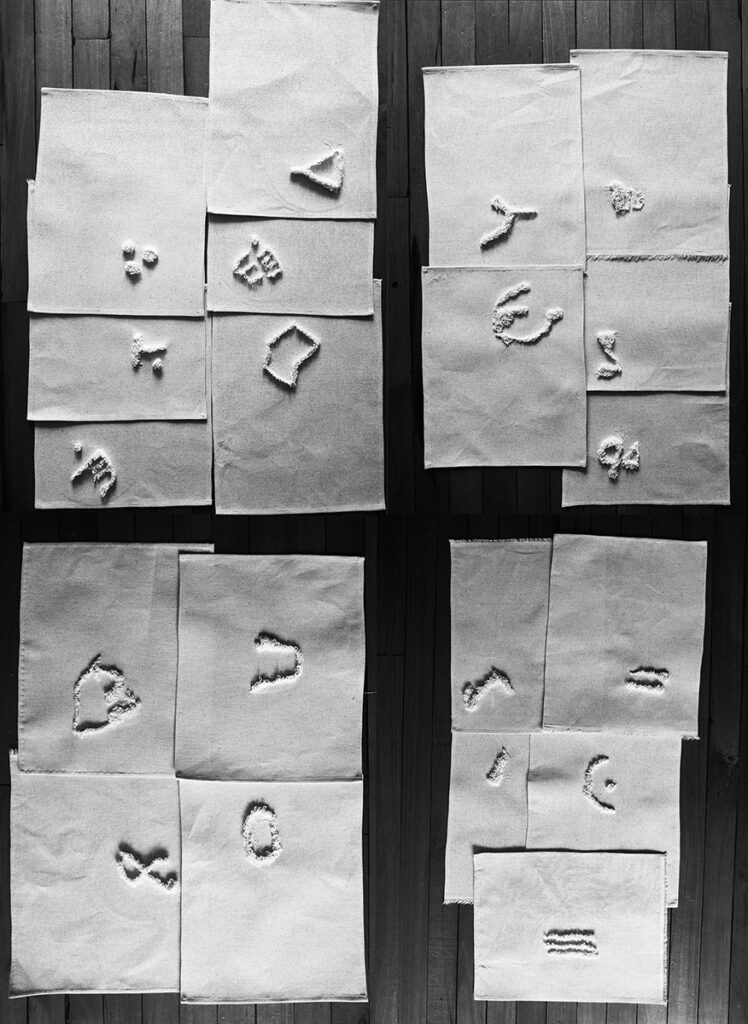
Across-the-board
Score for Active Relating
We, the Tender Hotel team, began the process of building the February Grand re Union issue by talking about love, care, and discomfort and what our particular interests are there, about polyamory with the Earth and rocks, and about the particular challenges of gathering in virtual spaces. We talked about where our bodies are in all of that and about the internet/web cam interface as a portal, as a space between, where much is activated and also there are a lot of gaps to fall through.
I was interested in where we spend our time. In our stuff. My desk faces an altar of rocks and reeds and collected things for my current project. I hold them as grounding when I’m online, to stay with my body in space so I can better listen because I don’t like being online. I wanted to create an invitation to do that, that enlisted the particular physical and environmental experiences of people participating in Grand re Union, and pushed into the virtual space as a transitive space between each of our physical locales.
Prompted by Bruce Nauman’s Body Pressure, I thought, ah, a poster that is a score. Returning to Body Pressure, I was averse to how intensely one’s body is directed in that piece. It is really mechanical. I don’t want to tell people what to do with or how to move their bodies. I do want to offer direction – things that work for me – that is evocative and suggests ways to build relationships in the space that you are in, spaces that potentially people are in a lot these days and may even re-imagine that experience by flexing our attention differently.
And I want to see what comes of it. To toss it back to each other, to bear witness. Because it is an open framework and a way to shift and build attention – solo and collective. So I asked others to do it with me, friends, teachers, and collaborators, all dance and performance improvisation involved in some way. The range of responses is beautiful to see.
Tender Hotel
Resident Artisans’
Activities
Tender Hotel
Love, Care & Discomfort
Setting the temperature
Our invitations to hosts and guests at Hotel Tender.
Tender Hotel is a place of warmth, care, connection, consent and love. We would like you to meet us there. This is the way of the Tender Hotel.
All the room hosts have agreed to hold space in this way. All guests are invited to enter in this way.
There is room for discomfort. There is NO space in Hotel Tender for bigotry, discrimination, exclusion or hate. If these are brought in to any room, guests may be asked to leave, at the hosts’ discretion.
Our receptionists will be here to hear.
Our intentions are to facilitate safety, yet we cannot guarantee all Tender Hotel spaces will feel safe to everyone. Please take care of your needs, ask questions and express feelings within the parameters of each space you are in.
Inside Hotel Tender, you are invited to say YES to things you want and NO to things you don’t want. You choose as you desire in the moment.
Consent is:
- Freely Given (not coerced or pressured – your choices are your own).
- Reversible (you may stop participating and leave at any point).
- Informed (unless the room is marked “Squat”, hosts state what to expect in each room).
- Engaged (everyone in the room has made an active choice to be present and connect).
- Specific (each agreement is in the here and now).
Please enter and leave the space as you would wish to find it.
Additional particulars:
- You can leave a room at any time – re-entering may not be possible.
- Curious Mappers are operating with our consent. Guests’ movements may be noted, with anonymity.
- If a room is for adults only, we will state this before entry.
- Content warnings will be provided for subject matter that hosts feel may be traumatic or upsetting. The stimulus aims for connection that may evoke feelings – we invite you to carry those feelings and stay with us, or leave, or speak to the concierge in the Tender Hotel lobby.
- If you choose to share your experience with others we would love you to credit the Tender Hotel creators and contributors.
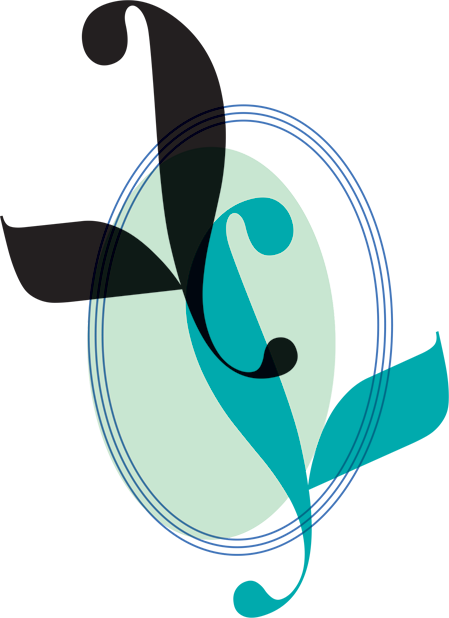
Resident Artisans’ activities
Create your visiting plan, please select your time zone.
Through the 24 hours, please always arrive ON the hour (we would really struggle with late arrivals). We then introduce you to the Tender Hotel’s navigation, temperature and provide the links to the off-site facilities.
Between some activities you can come and go, as you please. Others invite your stay without drop-ins. You can of course depart anytime.
Please, bring your packed luggage (you can find the Tender Packing List below) with the items of which are used in different activities.
We are looking forward to welcoming you in Tender Hotel at any point, and hopefully frequently during the 24 hours.
Tender Packing List
Things you may wish to bring
Welcome to the Tender Hotel. Below is a packing list for things that may be of use during your stay.
We put this together for you to start your visit NOW. now.
Right. Where. You. Are.
Let packing be a way to take stock.
We propose this as a ritual moment to mark our initial encounter.
Packing list:
— Teabag
— A tea cup
— A candle
— A special cloth/napkin
— Something scented
— Soap
— Embroidery thread
— Matchbook or matches
— Something that fits in one hand and feels good to hold
— A handful of dirt
— A pen and paper
— A playing card
— Joy and Pleasure packet cards (print out the attached)
Lay everything out.
Spend some time with the process of collecting – what object companions and memories do you encounter along the way as you source these?
Re-familiarize yourself with the objects. Perhaps hold them? Smell them? Feel them?
Each suggestion has been considered as a maybe – as an in-case-you-need-it support team of your things – as this might happen, why not? Resource gathered by members of the Tender Hotel team.
Scan me Tender
Statement
Re-write
January
Invitation
to Play (11min)
Care
Entanglements
Activism, Art and Electronic Beats. An Experiment on Community Empowerment
A Short Book
to An Anonymous
English / Spanish
Dear anonymous!
Telling the facts of a surprising, apparently negative situation may not be easy, but I can say that many times surprising situations come up with many lessons. This is one of those situations.
In February 2020 I took a trip to Colombia to visit my family. Suddenly the world was in chaos, the news spoke of a cold that could not be controlled and that came from a city in China called Wuhan. This “flu” apparently traveled from East to West in a very short time. Although there are many speculations of the reality of the facts. Some of us did not pay attention to it, others simply ignored it, and others entered a state of surprise that is still present. Today is the Pandemic called COVID-19…
— I was in Bogotá.
— My flight back to my home in Berlin was suddenly canceled.
— Quickly new decisions: we were going to buy food supplies, withdraw some money from the bank, it may be necessary…
— It seems that the oldest are dying! Don’t let mom and dad come out, who are now 70 years old. Grandma… suddenly alarm!
— The company business of my parents must be closed.
— Does the government give any help?
— Am I or am I not traveling on the last flight back to Germany?
— Where do you have the safest health?
— What if someone in my family dies?
— What if I can’t see them again?
— What if I die?
In a matter of days I decided to stay in Colombia.
Two weeks later, Bogotá’s El Dorado International Airport was closed. My journey that began in the Barranquilla carnivals and a visit to the sea with my mother, ended in 4.5 months in the house where I grew up with 4 people in quarantine…
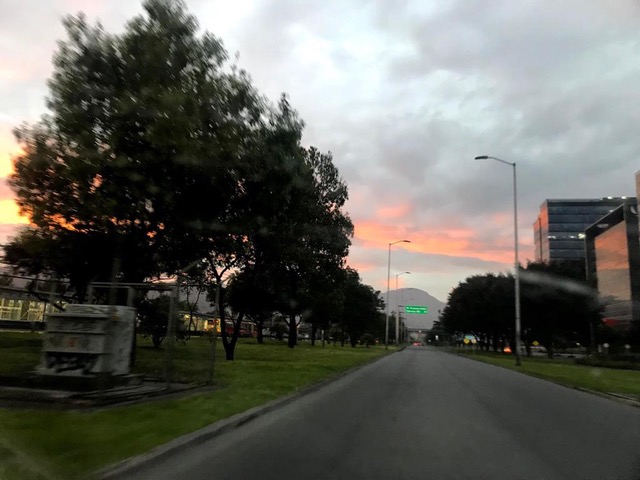
My time in Colombia during the first quarantine of COVID-19, was a discovery of many things. Some situations are intimate and others go to social reality, reflected in a small group of middle-class people in the city of Bogotá.
A Short Book To An Anonymous
Me reading parts of it on 29. December 2020
(in Spanish)
Chapter 1
MY FAMILY:
THE REPRESENTATION OF A PART
OF THE COMPANY IN COLOMBIA
And the reflection of a part of me.
Part 1.
We debugged many things between us, we were talking about things from the past and cleaning every corner of my parents’ house. We also try the emotional corners, this takes more time and work.
I see my family about once a year. But I have not been with them 24 hours a day for 14 years and less in such long periods. Which brought us to other concrete confrontations with issues such as: gender, and beliefs regarding ways of life. From the positives to the negatives. We are 6 children of the same father and mother. And a 7 sister only on daddy’s side. That she is 6 or 7 years old and I still do not know her. It is difficult for my father to understand that there is no problem and that integrating things through communication is easier and more loving.
Within my family nucleus, according to what I heard from one of my sisters in this “visit” we are 17 people. Their activities are intense on a weekly basis, as they participate in many individual and social activities together. On one hand I am the most isolated because I live in another country, on the other hand I find it suffocating many times. Other times I miss it.
Of these 17 people there are 4 girls under 10 years old (adorable), two newly adults with 20 to 22 years old (growing I see) and the rest older than 31 to 70 years old (constantly growing and silent too).
We never speak openly about gender identity, social needs, and the results that our little-thought-out beliefs bring. On this occasion and as I stayed longer, I felt affected by their ways of seeing some social situations. I am a 38-year-old gay man, I grew up in a fairly familiar context. Situation that today is still repeated in many families in Colombia, however there is much progress on this issue. It is an intimate part, which in the end is public and is a reflection of the society in which I grew up and visit annually.
Contradictory:
Most of my family accepts the “gay”, but because they seem “cool” according to their description and fun.
I called a meeting with my family group. When confronting them because I did not feel accepted at all in some issues, in addition to their position in front of groups to which I belong, such as LGTB, or other minorities. These were some of their responses:
— Most of my relatives agree that minorities do not exist, they believe that it is a personal belief that those who are part of a group are black, LGBT, feminists… My perspective is that in order not to accept it and not accept their ignorance faced with the issue, they put it in those terms.
— A brother-in-law said that of course, they love me, accept me and respect me, which I have no doubt. But they educate their daughters under the philosophy of the Catholic religion. And that they would like to stay that way, in their words: “we respect, and we even have a lesbian mayor in Bogotá. We have even discussed it with my daughters. But seeing two men holding hands… then silence”. Which clearly shows a double standard and a complete uprooting for understanding the situation of another human being who experiences discrimination, rejection, non-acceptance for who she/he/they is/are.
I personally wondered if he expects me to not show affection with a partner in front of them, because this would affect his philosophy rooted in the Catholic institution, but not the god who accepts everyone equally? Or If with this comment he hopes that his daughters will never see something so normal in their closest environment as holding hands with two people of the same sex?
— Another of my sisters faithfully supports that people reject themselves alone and that is why minorities exist. From the psychological side, perhaps she is right, some individual part of every human being goes through moments of rejection. And where is the collective part? To which it has no support because it is not in contact with any minority and has never cared about knowing exactly what it is or they are, or rather who we are? Then, I can say of her that I understand her, a woman who seeks success in her work and family, but burdened with workload, and little time for herself.
Another reflection of Latin American society, which in addition to all these things in the middle of a pandemic, has had to take care of its two daughters 24 hours at home, her husband does not take much part in it. And the schools in Colombia got close for this moment of the Pandemic. And were closed all year 2020. For 2021 they plan school in shifts.
Yes, this situation forced me to speak to them, to my family. I felt bad. But I realized that it is an issue that is still deeply rooted in the bowels of a society with few tools and manipulated by its government.
To shorten what I want to say, reaffirm that there is still much work to do to open hearts to true acceptance by the other.
This situation leads me to ratify and to a greater understanding of the society in which I grew up and its forms of evolution. The human being in order to share a space and a society, still needs more art, and less reproach. Changes are happening but there is still a lot of work. I see even more social need in my work as an artist.
The most important thing is that during this meeting the message for accepting the other reached my four little nieces, who are the ones who will form new societies. They were my main objective for this meeting.
With respect to adults, the things that resonate with them will be worked on in due course of this life or will be born again to be worked on. Or as adults we will have falls to reflect and internalize these issues.
What can I say…today I think that I lived some routines of the Latin American family again…sweet and bitter towards the acid side. I don’t like bitter. I love acid but it is not acidic enough…!
Regarding me:
— It was not easy, but it was loving.
— It was an uncomfortable situation, but a personal growth situation.
— It was sad to see such intelligent people, my family, close to a situation that affects the world today. But I see the new generations grow up with other tools. I can’t change everything. Acceptance.
— I understand that spiritual evolution goes through all this. And that is why the generations to come will take other actions.
— I lived and recognized my being in family love.
— I was grateful to spend 4.5 months with my parents.
— Enjoy 4 beautiful and “complex” girls in times of pandemic.
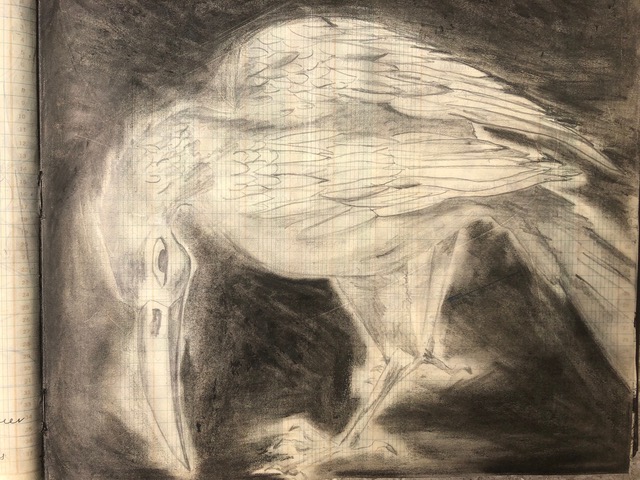
Part 2.
We were locked in the same house at first with 5 people. We lived in a certain “harmony”?
— My older brother refuses at 43 years of age to collaborate with the chores of the house, (washing, cooking, cleaning bathrooms) still old beliefs where the man does not do these jobs but the mother is in the “obligation.” Which generated a lot of complications in the first month. Until he decided to go home. I don’t know if it was the best, but living together was easier and less physically heavy on activities for everyone. We accept it with great love, although with great sadness, our attempts at agreement did not bring about continued coexistence.
Dear anonymous, do not forget that I am writing to you. And you can draw your own conclusions: my mom and dad are almost 70 years old and my older brother thinks mom’s should be taken care of him in all these activities.
This is what I called reflections of the society where I grew up, influences that still exist and get intensified in the midst of situations like this.
Colombia is a macho country, led by a matriarchy that supports it.
Chapter 2
MISCELLANEOUS THINGS
— We chose a person to go out to buy food. This person had to take very specific care when returning home: all packages were taken to a space where they will last 24 hours. Then each item would be washed with soap and water no matter what.
— Alcohol sprayed bills and money.
— Dirty clothes in a bucket with soap and water, if you have gone out. And go to the shower directly before any activity.
— There was a lot of fear generated by the news, a lot of scandal by the media that this could be: what we have heard from other countries with manipulation, control and other things, also happened in Colombia.
— Families even 10 minutes away by car could not be seen. For my mother it was very painful not being able to see her mother. My grandmother.
More about Families.
Chapter 3
A VERY CORRUPT COUNTRY
— The government charged up to five times the price of a can of tuna to support families in greatest need. So with other products.
— The markets disappeared in the course of their destination.
— They killed social leaders in their homes, thanks to the quarantine they could find them easier.
— Locked up, and being forced to comply with rules by the presence of an “invisible enemy” as my father called him.
— Non-existent identification numbers appeared to claim the markets and / or the economic aid that came out for these needs.
Chapter 4
“ME”
AND MAYBE MANY
IN THE MIDDLE OF THAT MOMENT
— A very sexual person.
— I couldn’t touch me.
— We could not leave the house.
— Do not stop using the mask.
— Do not go out.
— Don’t buy this.
— I couldn’t talk about everything.
— I was not at my home.
— don’t do this or that
— no
— no
— don’t break down, stay strong
— don’t believe what they tell you
— no, it is not true what happens
— no pandemic
— no
— no
— no, there were many “no”, but there were also many “yes”.
— Yes to share with the family. In my case, it is not that difficult despite our differences. Love and always trying to understand others helps us overcome many things. We represent the united Latin American family. In the midst of national and global conflict. In the midst of the idea of getting ahead and growing as people, of being better and better human beings. Teachings of our parents and grandparents.
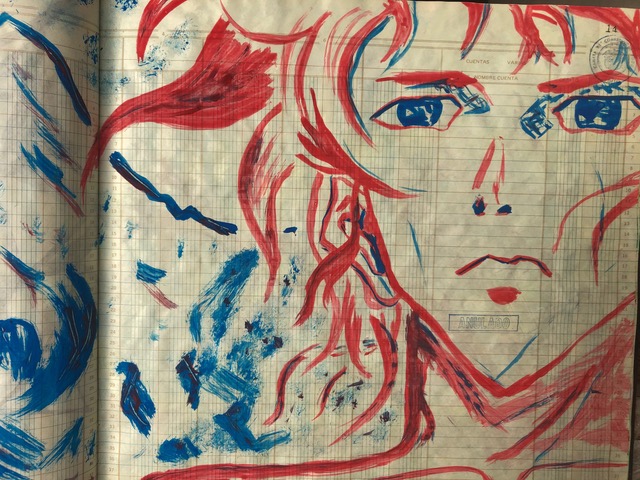
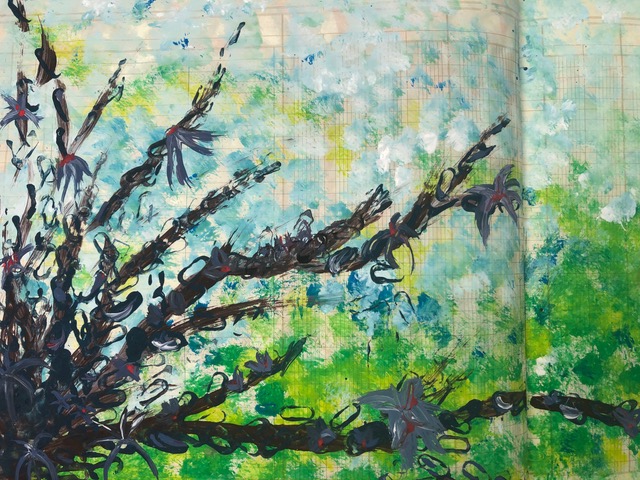
— Yes to paint, I share.
— Yes to clean, tiring.
— Yes to cook, new recipes.
— Yes, to exercise, I infected my brother to exercise a little.
— Yes to see documentaries on the history of human being.
— Yes to spiritual growth, meditation. I am immensely grateful for this time of light.
— Yes, to study online, Feldenkrais and other things.
— Yes to the study of the history of humanity with my younger brother. We understood that we still have many years of evolution left, but we see that there is evolution and we must not focus on the negative things.
— Yes, we generate changes in eating habits.
— Yes, the second operation in Berlin from a past accident. I was close to death.
— Yes, to finish a recovery from a past accident.

Chapter 5
THE INFLUENCE
OF THIS TIME ON MY ARTWORK
AND MY TIME AFTER.
LA PANDEMIA, generated a very important ARTISTIC meeting with my classmates from the University of Arts in Bogotá where I studied. Students who graduated from the ASAB in 2007, an artistic extension of the Francisco José de Caldas University in Bogotá. After 13 years we developed an international project with Colombian women artists living today in India, Colombia, Sweden, the United States, Spain, Germany, which shows personal, family life in an autobiographical way through a video dance. A project that today takes 9 months with an artistic projection in the future and a work that has already been invited to present a couple of festivals.


Weekly meetings
Readings
Videos
Artists studio
Cultures found
Frustrations
Emotions
Meditations
Understanding
Love
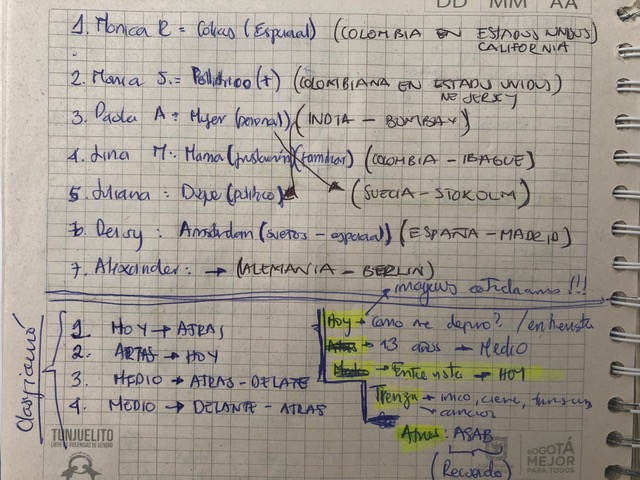
Yes! To the development and listening of new dialogues.
And eternally grateful to this group of women artists who empower my choreographic work, my feminine part, my being as a guide in meditations and creativity.
Chapter 6
MY TIME IN BERLIN, MY HOME,
ART AND MY CITY
Suddenly I found myself developing new structures of pedagogy and knowledge transmission. I suffered a positive transformation in my educational pedagogical and emotional structure. Transmit dance, art, and creativity through seminars and online classes. This transformation was seen by my students and colleagues later also in person when I returned to Berlin.
A transformation of my inner being by the influence of a new environment and the social needs of the present world. The projection of other forms of dialogue genre, fuller classrooms, and more curious human beings. More aware.

THE TRILOGY…
Another artistic and creative result that brings as a consequence an expansion of my understanding of the universe I inhabit and the collective universe that we inhabit. The first part of a trilogy, “ASPHALT BODIES – Concrete Cities” as I called it, was presented in October 2020 at DOCK11, Berlin. A work still in process, which I think would not have been possible if this pandemic had not existed. The artistic, material and human resources were given for its development. This trilogy brings together Berlin artists in different fields, music, theater, dramaturgy, direction, design and other arts. Presented by a group of dancers on stage, all artists open to talk about changes and transformations on our planet and in our present.
On stage we put some forms of how we imagine the future, acceptance by others, what forms of communication we could develop. A utopia set in a material and imaginary world. Result of an investigation that showed its first phase not yet finished and that with few expectations already fulfilled a task: to show the same world in which we live in a positive way, to put on the balance of what we consume good perspectives of this world that we inhabit as a collective.
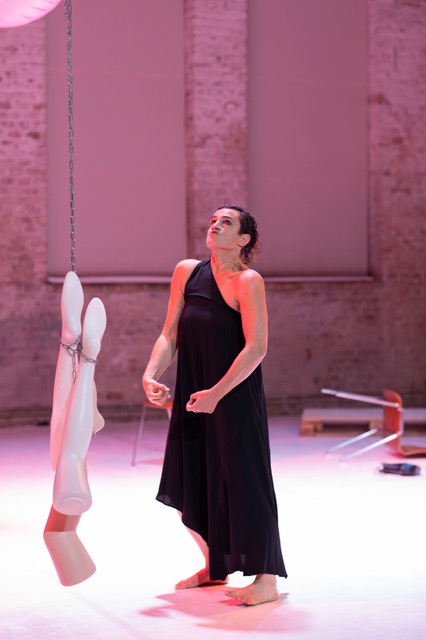

“ASPHALT BODIES – Concrete Cities
Concrete structures, black and dense in their fluidity, are very common in all the cities where we, the artists of this research, come from. The scars on the surfaces of those cities, the cracks in their asphalt, make us reflect on our understanding of what becomes habitual for us in contrast to what we consider as natural… Asphalt Bodies / Concrete Cities will be made thanks to the different cultural influences that marked the artists who investigate it. They have changed their place of origin and have adapted and transformed their learned codes from different cultural and social contexts to live now in Berlin, the place of this common creation. Directed by Alexander Carrillo as artistic director and choreographer, who aims to create aesthetic dialogues with the audience for an understanding of divers perceptions of life.
Choreography / Direction: Alexander Carrillo
Creation & Performance: Stella Zannou, Oktavia Zoë Vöhringer, Dominik Feistmantl, Maya Gomez, Alexander Carrillo
Dramaturgy: Phi Micheli
Graphic Designer: Tommes Armster
Music: Aérea Negrot
Camera / Video: Irene Izquierdo
Photographer: Sven Wolfgang, XXX
Advice: Fernando Derks, Rene Alejandro Huari
Stage, costume design & Production: Alexander Carrillo”
CHAPTER 7
TEACHINGS
Really understand the meaning of patience. From listening to the other as a reflection of my inner being.
Tolerate and accept the present moment as it is.
Letting go with the river in the middle of the stones is the representation of love in the middle of the storm.
Accept changes and live transformation as a natural fact that also shows us our spiritual path.
The trip ended in a surprise way, the surprise farewell due to the chance of a humanitarian flight, the humanitarian things that had to be paid…the family’s confusion in case I leave and I don’t feel well!
Acceptance for life as it is.
The future is uncertain as we learned it. The present is what we have and times of uncertainty are just the internal things that we have not solved.
Live in gratitude for what we have lived, and always give the best.
Healing our roots, family, getting closer to our dark side, illuminates our fears and frustrations.
Today is December 29, 2020 and I wish you the best from Colombia for 2021. Recently I spent a two-month quarantine in Berlin, and I had the opportunity to return to Colombia for one month, perhaps to finish what we started with my family in the first quarantine. Or simply exist other days by their side. The “chaos” is not over yet.
I will surely tell you more…
Happy 2021 dear anonymous, latest teachings of this whole situation:
Trust yourself and listen to your intuition. It is always right.
Appendix
Me in Bogota
spontaneous recording, 01. April 2020
(in Spanish)
Me in Berlin
spontaneous recording, 30. October 2020
(in English)
Choreographing
Attention
“We are constantly recomposing our body and our attention in response to the environment, to things known and unknown. This inner dance is a most basic improvisation – reading and responding to the scripts of the environment. It’s our body’s dialogue with our experience.”
Those words written by Lisa Nelson in her text Before Your Eyes: Seeds of a Dance Practice follow me whenever I think about attention, perception, bodies, relations, care, responsibility and how artistic and social practices intertwine. Following my research into embodied attention in dance (encouraged by Joanna Leśnierowska and supported by Grażyna Kulczyk fellowship) I have invited Rosalind Crisp and Lisa Nelson to have a dialogue on the role of attention in their practices. The proposed questions were the points of departure for the conversation: What “choreographing attention” means to you? What is the role of attention in your practice – both artistic and everyday? How attention relates to empathy and can it help us change our relation to others – humans and non-humans? How can it help us navigate between intimate, social and planetary challenges?
Lisa Nelson begins the dialogue by sharing how she started to be interested in attention (against the logic and demands of economy of attention the recording lasts app. one hour).
Slow Motion
Rave
Put on one of the music tracks and start anywhere
or
It could be nice to start low, lying on the floor, breathing.
Begin with continuous slow motion,
when you started you do not stop.
Moving in and out of the floor.
Use weight shifts
which allow for travel through space – slowly.
Use the spiral, the twist,
in your spine, in your whole body, often – slowly.
Look at each other – see each other –
seeing is being seen.
Once in a while repeat for yourself the question
“How slow is slow?”
Slow Rave
(something for your soul)
Slow Rave for Peter
The first Slow Motion Rave I have facilitated was during the Body IQ Festival in Berlin in November 2019. It came from the strong wish to slow down on the dance studio floor, combining experiences I had in the past with instructions and scores from teachers and colleagues, from my solo work twisted trident, from dancing in clubs and watching dance on stage:
Nancy Stark Smith’s score “low-slow-flow” from years ago merged with an experience with Kirstie Simson on an outdoor dance studio on the Croatian seaside where we were moving slowly and constantly for more than an hour, making it possible for sensing more detailed gravity and motion. In slowness I could give attention to places in my body that I would otherwise skip, when moving faster;
Keith Hennessy and Maria Scaroni’s single action scores that often end with a section of slow motion “with weight sifts!”;
My own obsession with the possibility of twisting from the spine, and the opportunity to see the whole room and everything and everybody in it and beyond through the possibility of that twist and spiral;
Giselle Viennes group choreography Crowd, that I saw at the big stage of Volksbühne Berlin was literary a slow motion rave,
All of it I put into this score of the first Slow Motion Rave in November 2019.
A month later I was invited by Marcio K. Canabarro to the first CARE meeting in Budapest, it was here that I proposed the Slow Motion Rave with the live music by Bela Associação, a 90 minute experience with 60 bpm music (60 beats per minute – resembling the heart rate) in the dance studio of SIN-Arts.
For easter 2020 the Slow Motion Rave was planned to take place during Stretch Festival in “the Village” Berlin, a queer mens community space for mind/body/spirit, but due to the pandemic it got canceled.
So it is all still quiet fresh, and for this January issue of the Grand re Union online magazine I have invited the musicians Jonny Kadaver (from Bela Associação) and Marc Lohr (from Cranky Bodies a/company) to provide a 60 minute Slow Motion Rave music for you to dance your own version or to dance the score with your chosen family or in safe distance from each other in other spaces.
Before Covid 19-times and coming myself from a practice of Contact Improvisation I would say touch and physical meetings are allowed and encouraged, nonverbal consent is easier negotiated in slow motion.
In the more sex positive space of the queer Stretch Festival where the sensibility towards the importance of consent negotiation is heightened, I would have included, after some time, when the score has established a certain energy and ground, the possibility of slow motion undressing yourself and one another, as in the Cranky Bodies a/company costume rule “naked is always a costume option.”
Triple M
transitional sculptures / video editing: Michiel Keuper, Martin Sieweke
music: Marc Lohr
CRANKY BODIES a/company 2021
Choreographing
Change
A Talk with the Instigators of Grand re Union
It’s time, and it’s been time for a long time, to take action and do the work of responding to the global circumstances of injustice, extremism, polarization, exploitation, and environmental destruction. Grand re Union, a year-long commissioning and international/intergenerational convening project, was borne out of a craving to address how choreographic and dance practice can be part of reducing harm in the world and building more just futures for everyone. Instigated before the pandemic, this project’s aim is to be part of the global movement toward deep systematic change in the dominant world order, interhuman relationships, and human’s relationship to nature.
Join the international team of instigators for a discussion on the plans, intentions, and developments so far of the Grand re Union project.
We all play a part in the movement, and with this project we start from where we are – deeply embedded in the practices, capacities, and shortcomings of the postmodern dance field. We’re showing up to be changed and offer what we have.
Statement
Re-write
December
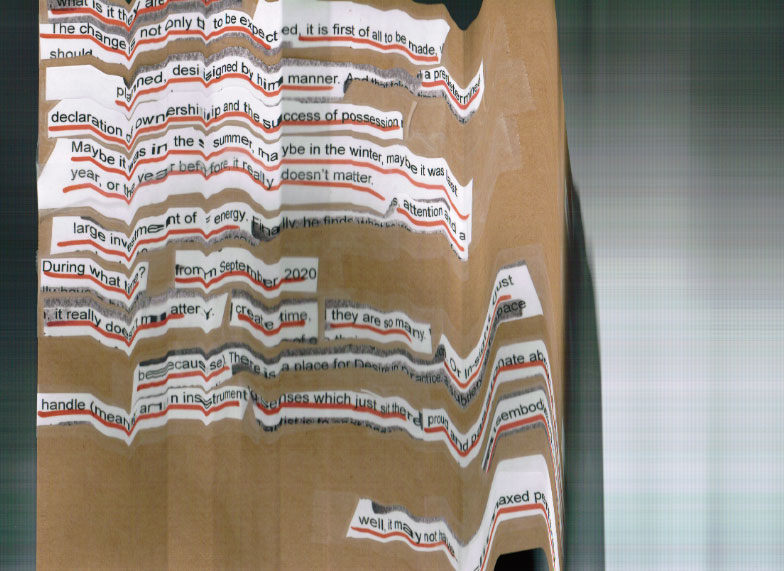
Image description: Glitching scan of a brown piece of paper with many taped-on strips of black text underlined in red on white paper. The words are illegible and the digital white of the scanner is in the background.
we are repeating each other
knowing there is nothing new, only that which we already know rearranged
we are repeating each other
knowing there is something new in that which we already know rearranged
we are repeating each other
knowing not what is there but that something needs to be changed
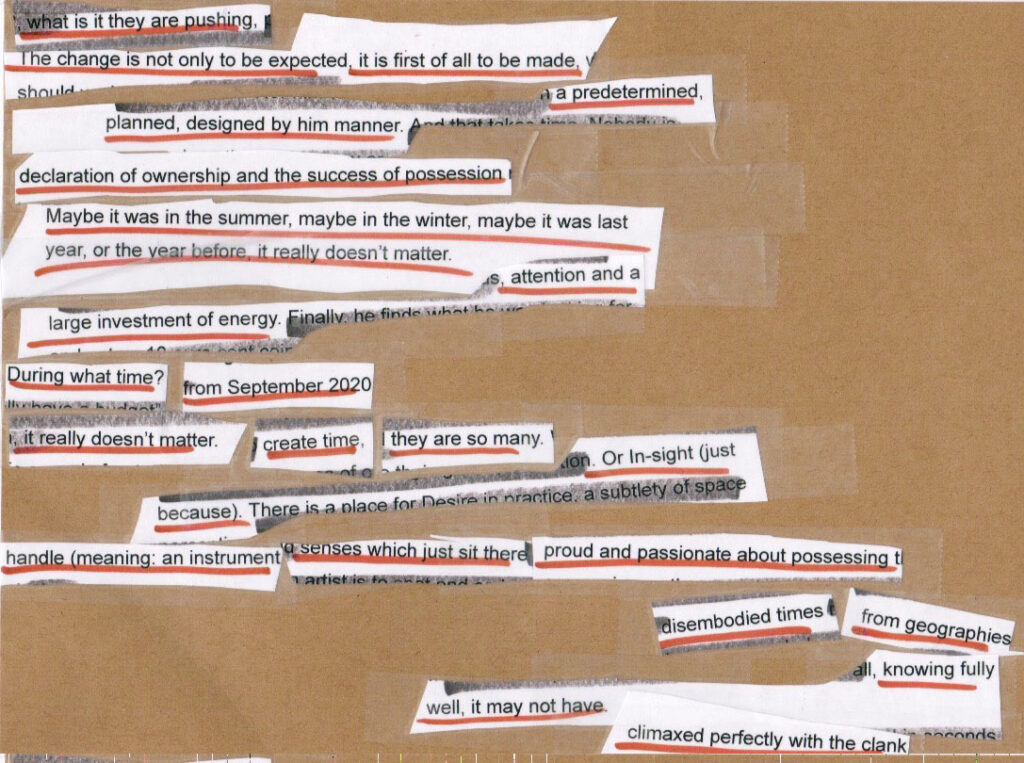
Image description: Scanned brown paper with many taped on strips of black text underlined in red on white paper. The text reads, “What is it they are pushing,
The change is not only to be expected, it is first of all to be made,
a predetermined, planned, designed by him manner.
Declaration of ownership and the success of possession
Maybe it was in the summer, maybe in the winter, maybe it was the last year, or the year before, it really doesn’t matter.
attention and a large investment of energy.
During what time? from September 2020
it really doesn’t matter. create time. they are so many.
Or In-sight (just because).
handle (meaning: aaan instrument senses which just sit there proud and passionate about possessing
disembodied times from geographies
knowing fully well, it may not have.
climaxed perfectly with the clank.”
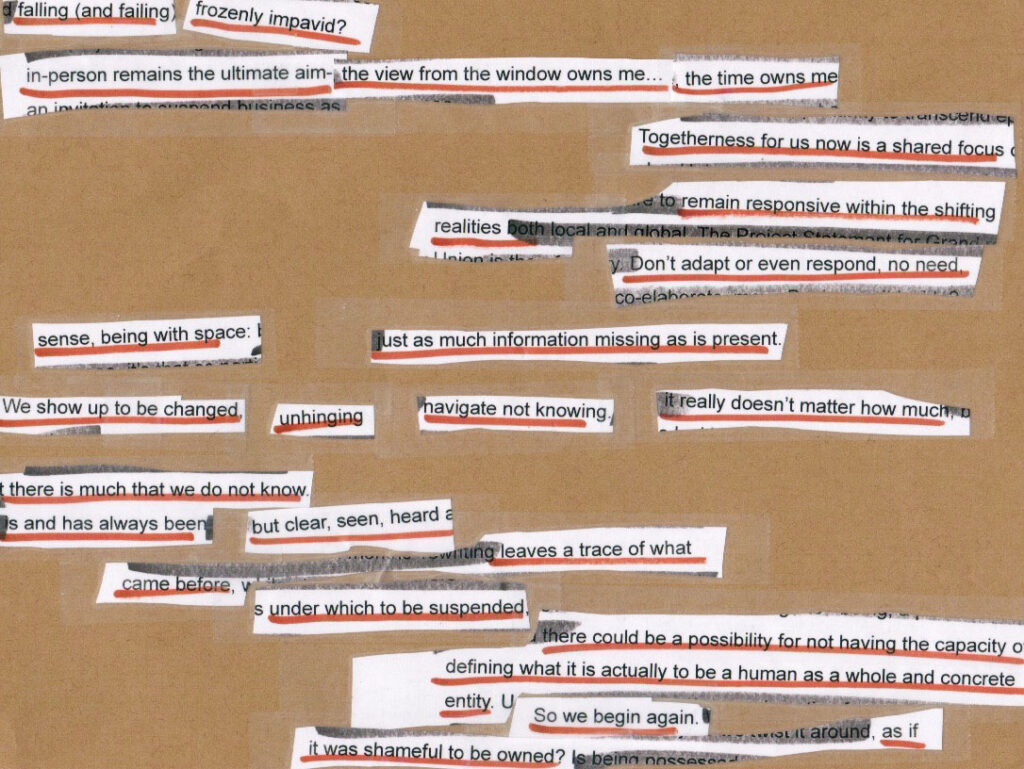
Image description: Scanned brown paper with many taped on strips of black text underlined in red on white paper. The text reads, “falling (and failing) frozenly impavid?
in-person remains the ultimate aim- the view from the window owns me… the time owns me
Togetherness for us now is a shared focus
remain responsive within the shifting realities
Don’t adapt or even respond, no need,
sense, being with space: just as much information missing as is present.
We show up to be changed, unhinging navigate not knowing. it really doesn’t matter how much,
there is much that we do not know.
and has always been but clear, seen, heard
leaves a trace of what came before under which to be suspended,
there could be a possibility for not having the capacity of defining what it is actually to be a human as a whole and concrete entity.
So we begin again.
as if it was shameful to be owned?.”
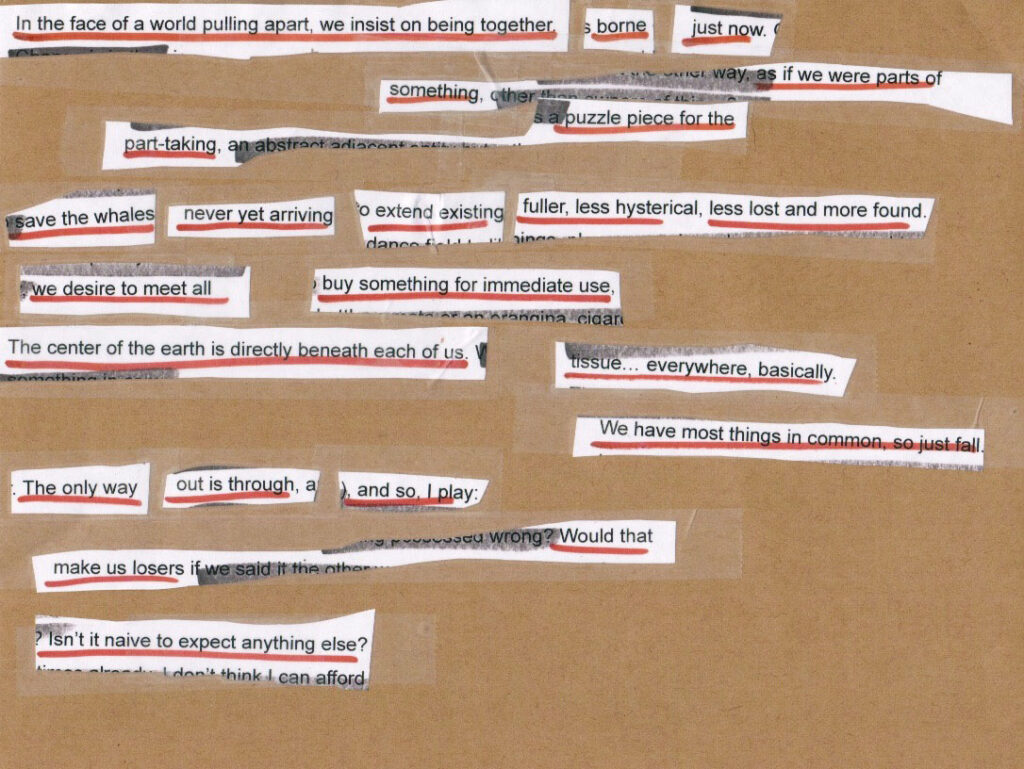
Image description: Scanned brown paper with many taped on strips of black text underlined in red on white paper. The text reads, “In the face of a world pulling apart, we insist on being together borne just now.
as if we were parts of something, a puzzle piece for the part-taking,
save the whales never yet arriving extend existing fuller, less hysterical, less lost and more found.
we desire to meet all
buy something for immediate use,
The center of the earth is directly beneath each of us. tissue… everywhere basically.
We have most things in common, so just fall.
The only way out is though, and so, I play:
Would that make us losers
Isn’t it naive to expect anything else?.”
Grand re Union Statement
see all versions
Watching It
Happen
Wednesday
Nov 4th, 2020
7:30am
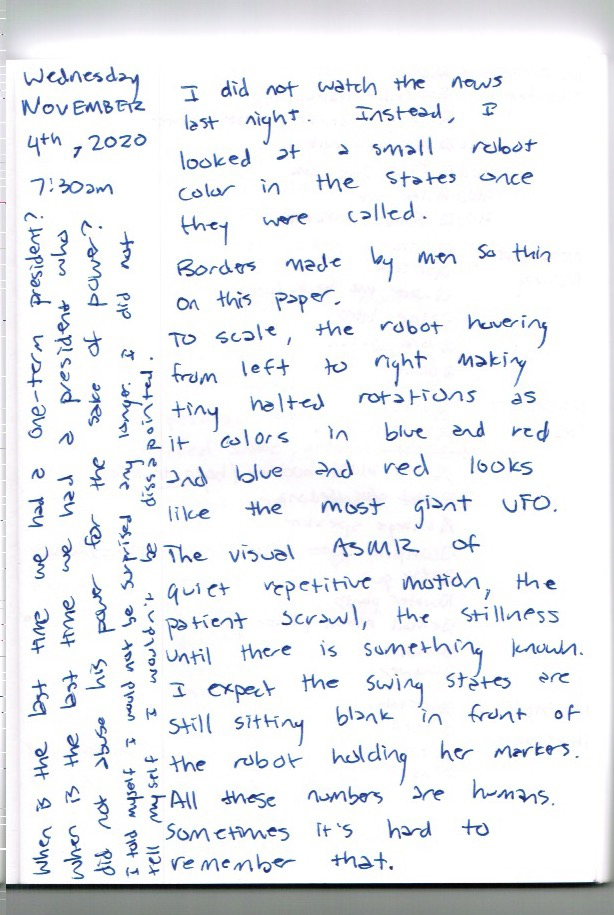
I did not watch the news last night. Instead, I looked at a small robot color in the states once they were called. Borders made by men so thin on this paper.
To scale, the robot hovering from left to right making tiny halted rotations as it colors in blue and red and blue and red looks like the most giant UFO. The visual ASMR of quiet repetitive motion, the patient scrawl, the stillness until there is something known.
I expect the swing states are still sitting blank in front of the robot holding her markers. All these numbers are humans. Sometimes it’s hard to remember that.
(When is the last time we had a one term president? When is the last time we had a president who did not abuse his power for the sake of power? I told myself I would not be surprised any longer. I did not tell myself I wouldn’t be disappointed.)
Thursday
November 5th, 2020
9:15am
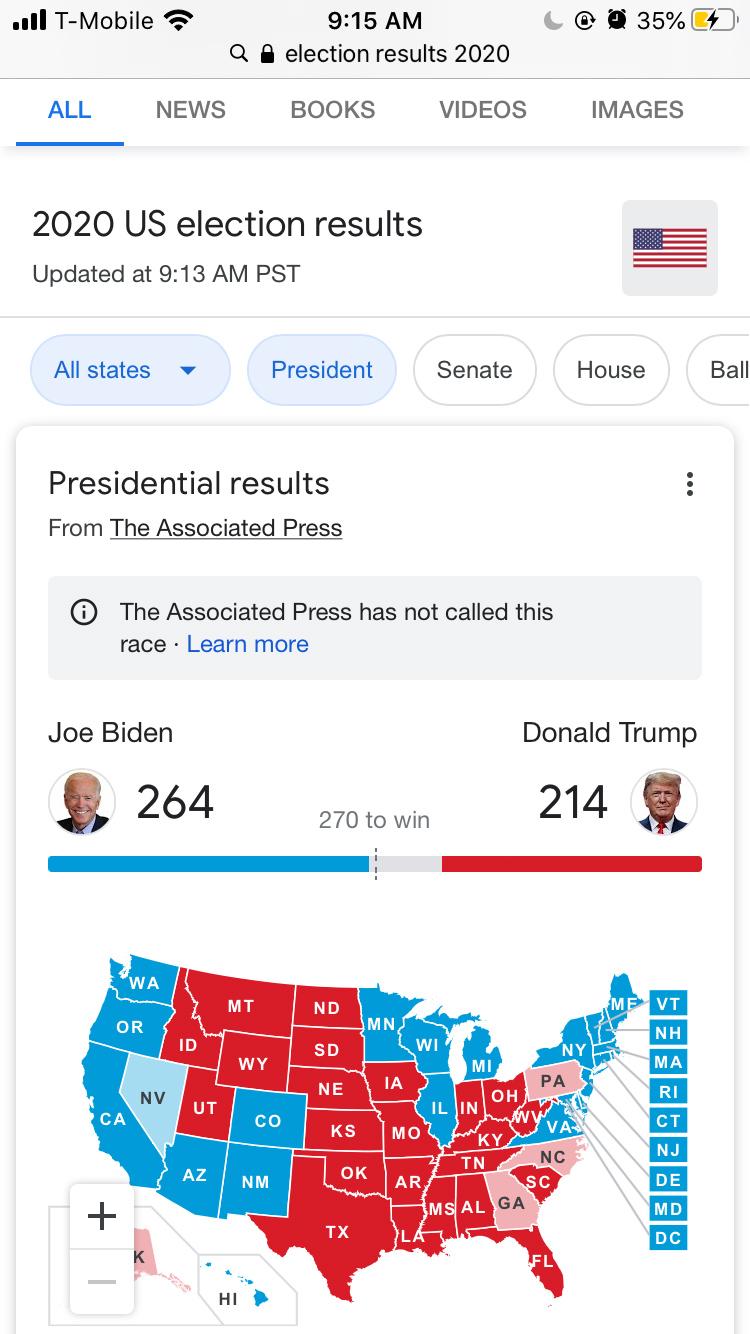
Friday
November 6th, 2020
8:00am

Saturday
November 7th, 2020
7:53am
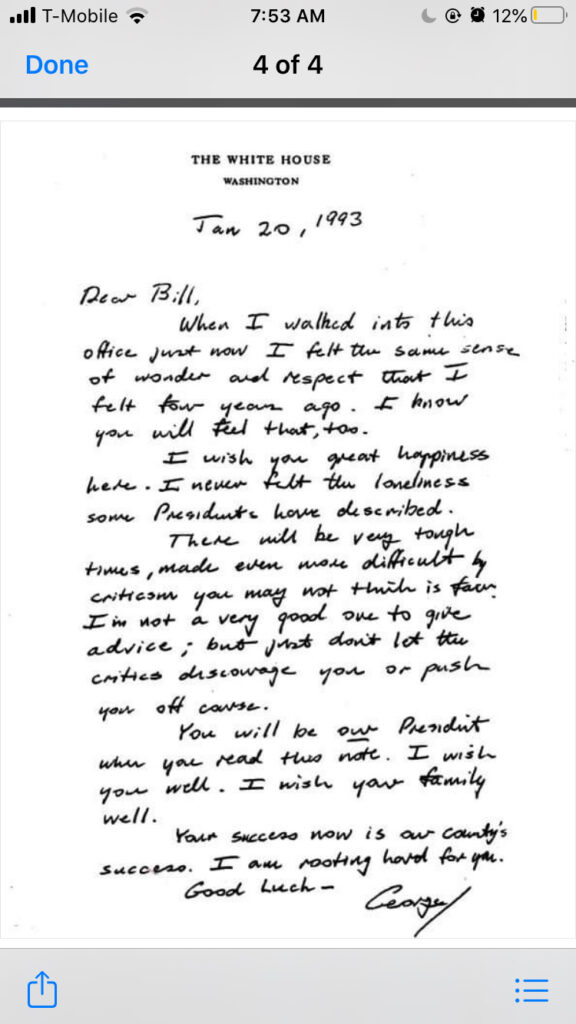
Sunday
November 8th, 2020
8:00am-ish

Yesterday I taught a 4 year old girl how to do her first forwards roll.
You begin with waking up the body, leading warm-ups where we touch ourselves, feel the warmth of our palms, squeeze the mass of our muscles. I ask, “how does that FEEL?” You stretch, sing songs, get to know the ground. You sneak in some rock and roll’s, asking her to hug her knees to her chest and tip backwards, feeling the spine roll against the ground, falling off your center of gravity, allowing the world to go slightly upside down just for a moment.
Then we practice strength, testing our arms ability to hold our body off the ground even when we lift our feet away. You teach bear walks (grounded yet inverted), monkey jumps (trusting the hands and arms with the weight of the body, but briefly), then donkey kicks (more trust of the upper body, more inversion to upside down.)
You ask her, “would you like to try a forwards roll?” She says “no.” You say “Okay! We don’t have to, let’s try this instead.” You take three steps onto the mat, stretch up high, tuck down low, then with hands and feet firmly on the ground, you lift your hips to the sky, open a window between your knees, peek your head out, and give the flipped world behind you a wave. We practiced that up and down the mat, up and down the mat. You have to see the world from an entirely new perspective and feel that you are safe there. First, we have to take a timid peek out of the window and realize that the frame of our bones and blanket of our muscle still holds us together.
I ask, “would you like to try a forward roll?” She nods. I ask, “is it okay if I touch your back?” She says “yes.” She reaches up high, tucks down low, peeks between the window of her legs. I hold the back of her neck and the back of her thighs and gently press forward. She rocks with my pressure and her spine reaches the mat in front of her. A full 360 rotation forwards to flipped to sitting straight again. She smiles, stands, and runs to hug her mom, soaking up the pride.
Is that a transfer of power? Facilitating the moment of four-year-old girl leaves verticality with awareness, support, choice, strength, and joy? Allowing ourselves to be upside down? Trusting that something new is possible but letting it take its time? Changing our minds and giving each other room to do so? Keeping each other safe?
Later that day, I went to my friends house who had a television with the news on. We watched shots from helicopters flying over every liberal city in the U.S. Crowds in the streets waving flags with rainbow stripes, with words “Black Lives Matter,” with the “Biden Harris 2020” campaign sign. They danced with effigies of Trump and signs that read “You’re fired!”
Lesdi, my friend, said that this is what the photos looked like when Nicaragua overthrew their dictator. I saw an article online about how a country collapses while you think about what you’ll eat for dinner.
My partner was upset by the celebration in the streets yesterday. He said, “they think something has changed, nothing will change, it will just get quieter, are they actually excited for Biden?” I said, “we have to allow people their joy, there is no new era dawning, but can we take a day to celebrate an incremental defeat of a violent and hideous man?”
It’s an ongoing conversation. I don’t disagree with him, I just still wish to believe in the power of hope, of joy a fuel for change rather than only discontent.
Thursday
November 12th, 2020
8:42 AM, Sedona, Arizona

I am staying in an Airbnb outside of Sedona, Arizona with my parents for a week. We are here visiting my sister who is here for a month to work and mountain bike.
We drove Highway 40 East through California into Arizona. 12 hours of long straight roads through plateau and desert. Any time we reached a town, we saw a billboard advertising rest stops to truckers and we saw Trump flags.
I always wonder how people handle groceries when they live in these places. The nearest grocery store seemingly hours away. I imagine stockpiles of canned food and an entire cow in the freezer or I imagine only ever eating what you can find at a gas station.
We’ve had this trip planned for about a month. In the days leading up to and after the election, my mom said she was nervous to go if Trump won. If Trump won, we were a mixed race family walking into a gas station with our masks on in Ludlow, California where everyone voted for Trump and even if we were white as day a mask could give us away.
We were still that, but if Trump won something would have felt different about power.
Of course, my mom is the one who fields every scowl and has to respond to the man that says “you need to buy something to use the bathroom” with, “my HUSBAND outside is pumping gas.” Finding whatever identity signals she can that gives her more power is a survival mechanism. Relying on cis-hetero identity to align her with a dominant norm.
We posture for power in small and large ways, constantly playing into a set of social rules that are both completely arbitrary and hugely impactful.
In the bubble of the Bay Area, we can play with our relationship to the norms, we can perform our queerness or our nativeness or our ambiguity for social capital and acceptance. We can be identity rebels, proud of the ways we give the finger to the mainstream. We refer to our cis-gendered male “husbands” or “boyfriends” instead as “partners” because it feels more true, more level, more queer, and less heteronormative. But the moment we find ourselves needing to pee in Ludlow, California we posture towards any thread we have of the mainstream.
Of course, my mom cannot lighten her skin, I cannot straighten my hair, and neither of us can fully shake off whatever air of otherness we so clearly exude in this place. Relative to so many people, we are privileged to find some ways to pass. We are not Black and that is meaningful.
Biden won, we took the trip gazing out the window at Trump flags flying. We packed our own food.
Friday
November 13th, 2020
12:00pm
Saturday
November 14th, 2020
2:30pm
Tuesday
November 17th, 2020
1:00pm
Wednesday
November 18th, 2020
1:00pm
Friday
November 20th, 2020
America Called
and Wants its
Oligarchy Back
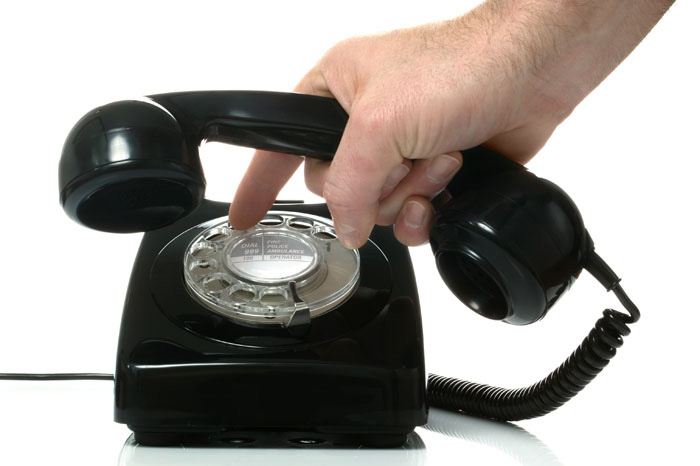
Burn the Flag
11/01/20
I have never really been a flag waver, and after these last four years and in particular the months leading up to the election, I am much more at home with flag burning, than flag waving. In fact I have burned many flags in dance settings, over the years. (always burn cotton flags, rather than nylon fabric flags). And I think it was right at the end of the first 2020 presidential debate, that I suddenly flashed on David Gordon’s flag dance. That put a grin on my face… for a minute.
Not Invested
11/03/2020
Just because I am really invested in Trump not being reelected, doesn’t mean I am invested with Joe Biden. I like Kamala for the obvious diversity, sanity, intelligence, class, gender, and point of view that she brings to this election. And of course she will be making history as the first BIPOC woman Vice POTUS. With all this said she has made some pretty questionable – fucked up prosecution, and legislative moves as San Francisco DA and Later as the CA. DA. Her congressional record is OK.
Voting for Normalcy
11/03/2020
Not so sure if I am voting out of revenge, as much as I am voting for a return to normalcy. Nothing normal with this election though. I never thought I would be craving normal. Bring back the normal.
A More Sober Outlook
11/7/2020
OK, now that my euphoria of Trump not being reelected (fingers crossed), has passed, and I have sobered up a bit, I have to say, “NOT HAPPY” with my country. We must (everyone) embrace the fact that this nation is a plurality. The founding fathers were products of a colonial mindset, slavers, and want-to-be imperialists. Our history is seldom heroic and less inspiring than what is taught in schools. We need to forget about great men and their works, and move on to what we can do as a nation for not only ourselves, but the whole world and all of its people.

Hard To Swallow
The following statements are meant to be printed as messages in fortune cookies.
Note: the cookies should be extremely bitter tasting, to the point of nauseating
Never thought I would be nostalgic for presidential “business as normal” in a candidate.
I really hate this fucker and his whole grifter family. I am trying to not harbor hate, but I fucking hate him/them. Am I brainwashed by all the hate video games, harsh sci-fi stories and the personal experiences I share with so many friends. (with the type of bigotry and theocratic terror valued by Trump and his supporters).
What about the environmental and other legislative gains that Trump and crew have weakened or done away with. Those were years in the making. An ignorant man did away with them in a moment.
I don’t want a great president that is hobbled by an unfriendly senate blocking everything the good president does. Remember how Obama was dis-empowered by the GOP?
Let’s make history again, by electing the first BIPOC woman VP, even if it is Ms. Harris.
Fuck the DNC for not letting us have Bernie Sanders.
Fuck the GOP, just because.
Handmaiden Tales is like an advertisement for SCOTUS Barrette.
Q. How can I dance when shit like this is going down?
A. How can I not dance?
Went to bed on election night, with Trump falsely claiming he has won. WTF?
Woke up to threats tweeted by POTUS to not count all votes. Disenfranchise millions of voters, many of whom are in service. Stationed abroad.
Now he wants to count the votes.
I just want to live in a country that embraces DEI, values a healthy planet, believes in science and maintains separation of church and state.
Theocracy here we come.
It sucks that millions of votes could be ignored, and six votes from a discredited SCOTUS will decide the election.
I will not falter – I will write everyday. In particular on days I don’t want to write. I can write about the blockage.
It really should be against the law for politicians to knowingly lie about and distort issues.
End career politicians, and lobbyists.
Overjoyed Sarah Macbride is the first elected trans person to congress from Delaware. Amazing news overshadowed by the angst of the recount.
Never really loved this country USA, but I have loved being in a place (sf) that was open to change, and making things better through restorative justice, environmental justice, social justice.
OK. Just had a phone call with my older bro, in NC. – he voted Trump and is so brainwashed – i ended up crying during the call, he hung up on me. I blocked his number, he then called from his son’s phone, he was angry and confused by our fight. He wanted to say he loves me, we love each other, how can he be a Trump supporter?
I am trying to be in my body right now. Just can’t do it. The political body seems just impossible to connect with too.
Writing this shit down is a bummer. Trying to find joy in daily life is trying, while I recalibrate to capture what is good, because there is a lot of good, it’s just covered in shit and obscured by what is going on.
It’s shitty.
I think of David Gordon’s Flag piece and I feel really better – maybe that would be a great project to recreate the dance or better yet make a cover of it on a queer multigenerational, diverse bodied group with a wide sensory modalities and physicalities?
The radicalism of the 60’s in dance, theater, visual art and experimentations in group living, that gave birth to the Judson Church Movement, The Living Theater, and other amazing expressive forms is really needed again. Also this should be required study for all arts based education.
I am so disgusted with the new normal – covid and America returning to a land of overt racism, bigotry, incivility and hyper capitalism. Lying is a valued ability in public discourse.
Bye Marriage equality, and a woman’s right to choose, clean water, land and air, among other precious rights I take for granted.
My back hurts, my legs hurt and my heart is just feeling sad. That’s my embodiment. And it’s not from being 60 yo. It’s from all of this uncertainty. What it is like to be American.
The GOP is batshit crazy, and has at least 70 million hardcore voting adherants. Huh.
Joe and Kamala sound so intelligent, sane and serious when compared to Trump and Family.
Where I go to vote is 666 Ellis street, 6th floor. Not kidding, this is the truth.
On 11/3 2020 all of the pole workers at my voting location were Russians. Not kidding, this is the absolute truth. These new Americans are really into it. Kudos Folks.
Fuck the Electorial College, honor the popular vote.
It ought to be a serious crime, for people running for election, to purposely lie.
I am OK with contradicting myself. Quite comfortable, in fact.
Casters
(The Nightingale)
I.
When they pressure-washed the pigeon nests the finches came out to sing
You can hear dominance invert in melody
I’ve been thinking about how birds screech to assert healthy strength
A dignified prowess until their mortality vertebrates
And makes drywall bones crumble to dust
You watch our planes fracture in opaque omission
The more complex the birdsong, the softer linen curtains fade to ghost
Eyes blurred to stratus and violets burn the sun

A performance begins –
Witnessed by you through a vortex of perennials that we planted in stone
As a premonition of lilies turned compost
I learned that birds sing to attract mates, to rein power
Pitches altar to sirens when they call out for danger
The migrations metastasize every winter, and please not now
I can’t tell this music apart from the elegies
Afraid the violin can’t cry any louder
The extension cord they brought won’t reach your window
So the strings stretch and splice before the instrument is set down
In deafening silence we danced
Like sordid marionettes, we danced
And acorn eyes applaud along to sullen chords
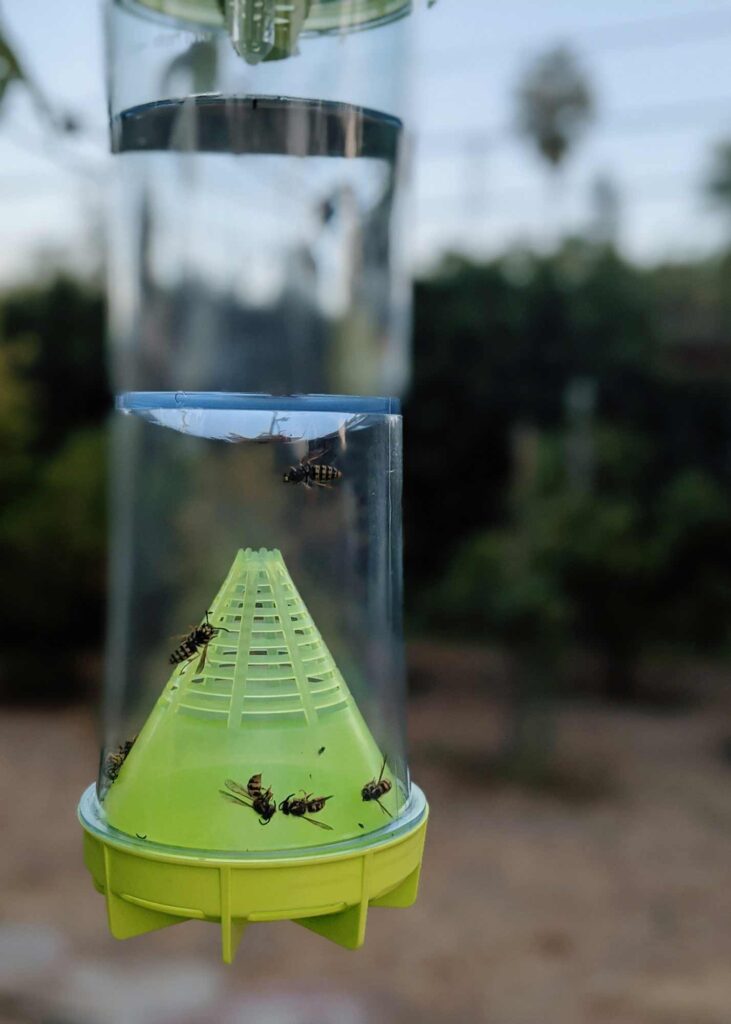
That day I hung a wasp trap on a branch
And watched insects eat their trap and die
Watched thoraxes snap like synapses
Asters can’t pollinate the bees circling your food as you grey
We were an audience of clenched fists – hummingbirds perched on spines
Wings muted by the heartbeat of a doumbek
Phantom sitars strum along ligaments
We are all no longer here
We are all no longer
Wine pours out like blood and we sit with nightingales as the music plays
I watch your alias wither into mist into
Dandelion kisses blown from rolling casters
It gets late and the sky drowns to cerulean
Bees fall with their stingers left on
Until birds forget melodies at dawn
II.
In my dreams I often sit with you in a broken Acura engine sputtering battery fading power ceasing all around us and the election never ends and the SUV’s fulcrums break to seismic faults while we watch Fox News on torn upholstery and outside the windshield appaloosas run towards their death some in ebullience some in defeat a mirage of elected officials are refracted rotten refuge I ask if I should turn the key and you say we can’t leave this house because casters stop spinning at the driveway like shopping carts so the next day I celebrate alone in the Castro confetti paints the streets smash the piñata head of a forgone leader in dispirited elation “Fuck T**mp” they cheer everyone is happy everyone is drunk everyone is back to quiet systemic racism and normal white supremacy back to ignored foreign affairs war criminals bombing cities not too far away from where you were born
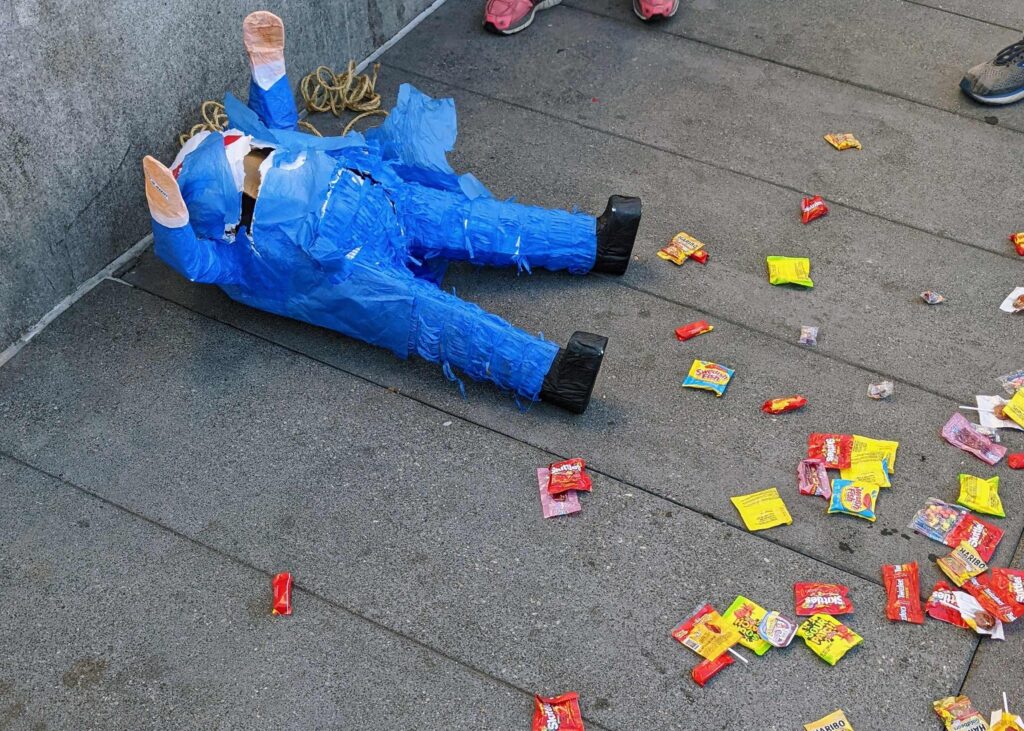
III.
One late night I returned to San Francisco and my apartment was filled with mud.
Gnarled roots grew through the furniture like veins growing out skin.
All the windows were open, the ceiling gone, and brown water poured through the rooms with a suicidal drive to be earthbound.
I dragged my feet through sludge blanketing paisley rugs to find respite.
Thought it was quicksand, yet I could wade in this filth forever without drowning.
That morning the gardener told me he can’t find wood for the planter box, said he drove everywhere and meanwhile the perennials lost posture.
We convinced ourselves that if we kept buying fresh flowers eventually some would be planted.
By who, we didn’t know, and the stone was too deep to be excavated.
We needed more time.
Tried chipping away with shovels till our backs ached, the friction of our coats against the caustic winter.
You could hear the phone left off the hook.
The dial tone was an unspoken pact we dared not listen to.
A thousand miles away an election halted.
Committed as we were to our shared blind garden, the gardener came back silently one night and gathered his tools and never came back.
The azaleas faded in their soil but we had to go to work in the morning.
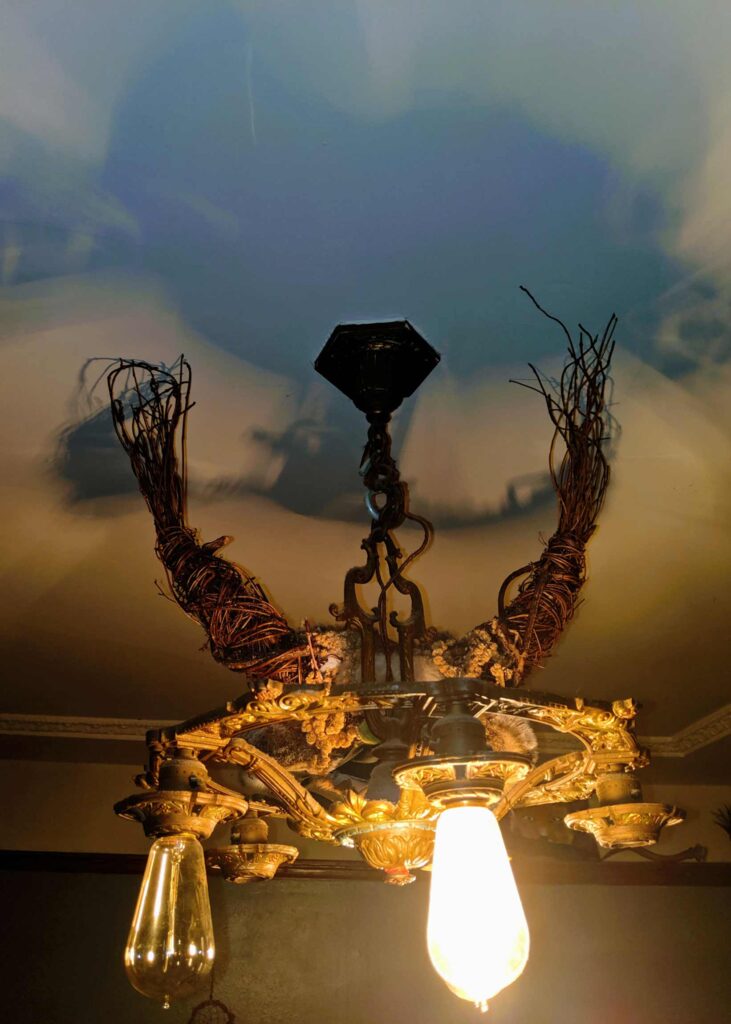
IV.
And so we stand as question marks as stalagmites politely fall on grieving spines.
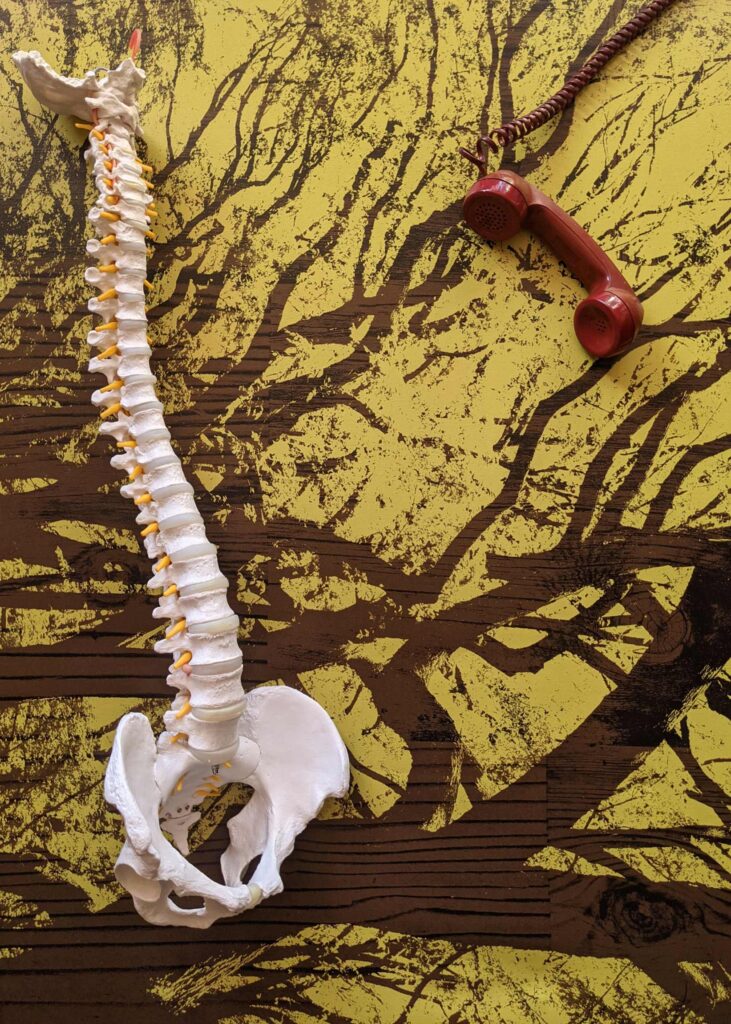
V.
Louisa writes me a poem:
I can place silk around my curves
Gather tinctures to bear this reality
Soften my skin and bring luster to my hair
Maybe procure a cushion to rest upon
What gentle traps I place my limbs within
Instead I chew my tendons and tissues free
Almost everyone I know has decided to die
I hope whoever eats me, chokes
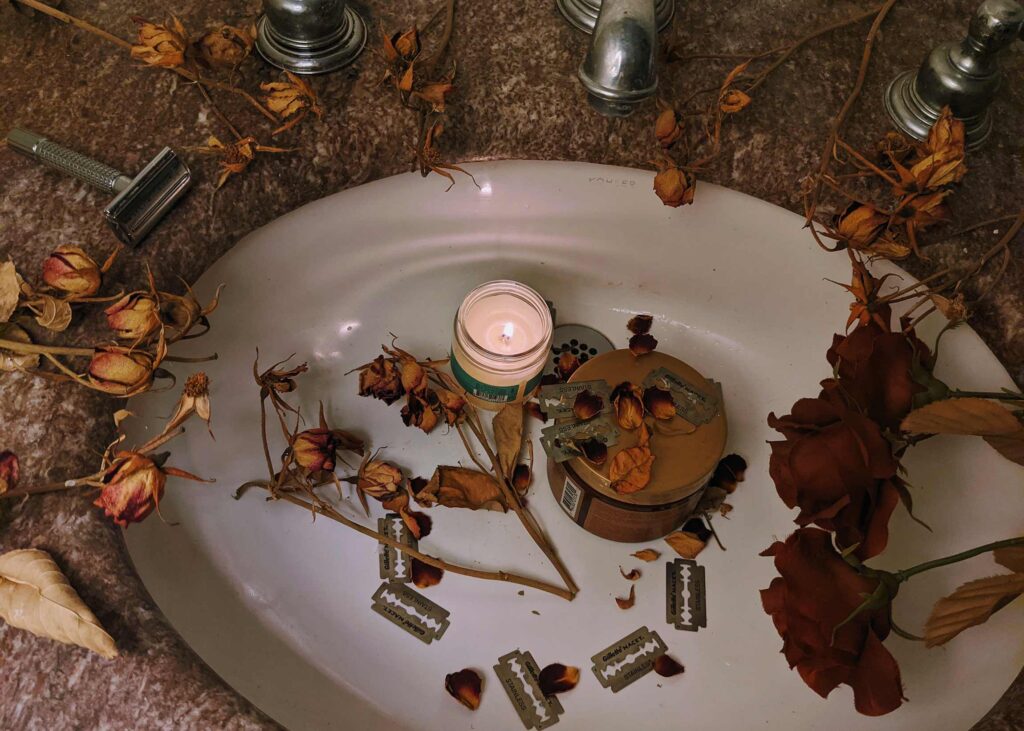
In Jewish law, all personal pleasures should be denied during a 30-day period of mourning. This includes bathing for comfort – washing the body with hot water for an indulgent amount of time. So too do Jews refrain from oils, shampoos, body wash, face lotions, perfumes, hair creams, mouthwash, skin tonics, nail polish, make up, deodorant, clipping nails, shaving. It is all part of the general pattern of forsaking personal appearance and grooming, giving away power against the sins of society, and ultimately, permitting your body to its earthly expressions. Some might call it disheveled. Naturally, the mourner must enter a state of complete withdrawal, nearly a recluse, avoiding human interaction as nails and beard grow with abandonment. The permission of hygiene and grooming is allowed only when others begin to comment on their unkempt appearance, then a spiritual power is restored and mourners can arise from the shadows.
VI.
With little time left I archived a soundscape of the yard
A vocalized map of the echoes that surround us
The Bosavi people of Papua New Guinea pray to birds during funerals
Gone reverberations, they call it
The voices of ancestry is alive in birdsong
Absence turns presence in chorus
I planted the ladder in dirt and recorded noise heard from cellophane skies
Listened to wings sweeping static screams of our past
The muffled calluses from generations of scalding Earl Grey
Centuries of unibrowed women & Haft-sin
Grass blooming in rivers every Nowruz
Birds crying lineages of wishes made in sabzeh knots
I tried to document all the wishes you’ve left Suddenly the sky was black with crows orbiting boom mics
The choreography was deafening –
An agoraphobic wind poisoned the audioI deleted the archive and said I forgot to hit record
VII.
A vacancy grows inside you. It lingers hungrily, in need of nourishment, and you feed it scraps of remedial pleasure, like a starved albatross finding trash in vacant thickets. You indulge in tinctures and tonics that were forbidden for a month. Read Internet tantrums as the world yearns for a fascist to concede, for power to rescale. The first downpour of the year comes and you run through mud with revived limbs. Ride your bike until tires lose tread, legs drain strength, the chain, mangled deliberately – just to have something to fix. Eventually you begin to chart destinations and the pedaling feels less aimless. Meadows, post office, little free libraries, that coffee shop you keep cancelling shifts from. You replace your cell phone with wind chimes and listen to the sky. Listen to the birds, predators turned prey. Silently you sprawl through deciduous forests blooming out of urban streets. You surrender your ability to walk behind gentrifiers at their leisurely pace, nowhere to go, and strip honey bears off windows with a grin. Ferries resume traveling across the Bay yet the pandemic never ends. You look at the sun differently, from polar points on an axis, with a newfound admiration of Galileo’s geometry that you never quite grasped in school. You make a phone call. An old lady recognized as now alone answers without saying a word. You could feel the power in her voice abandoned, though not buried, and you set your car in motion – wheels spinning like casters – and drive down to see her.
VIII.
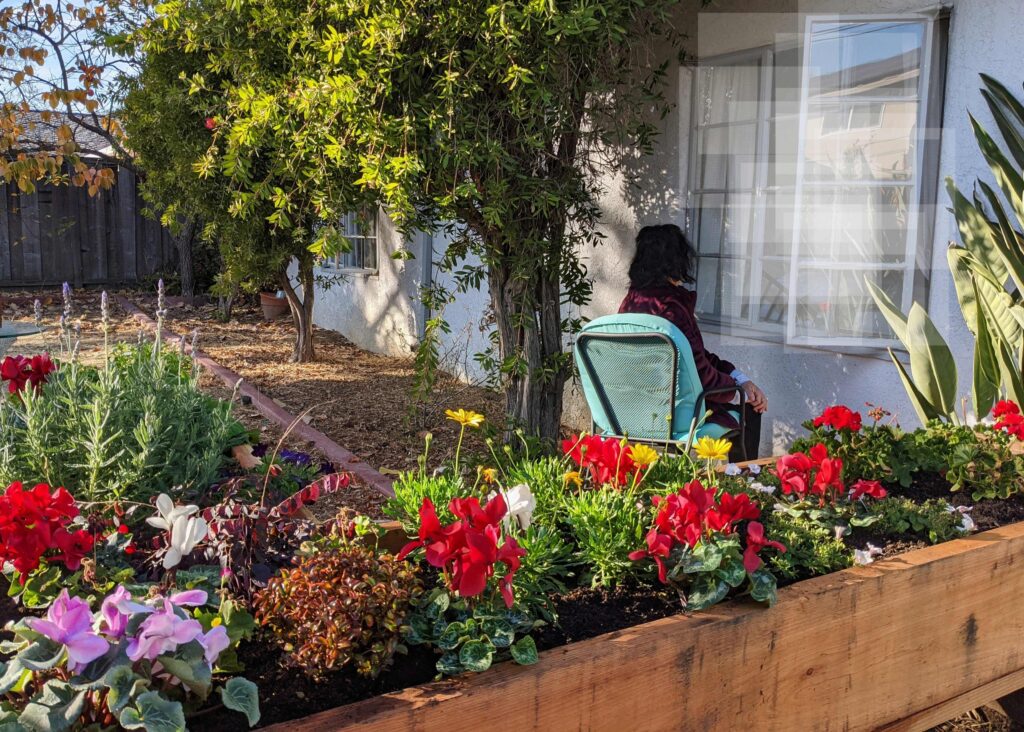
No More
Presidents
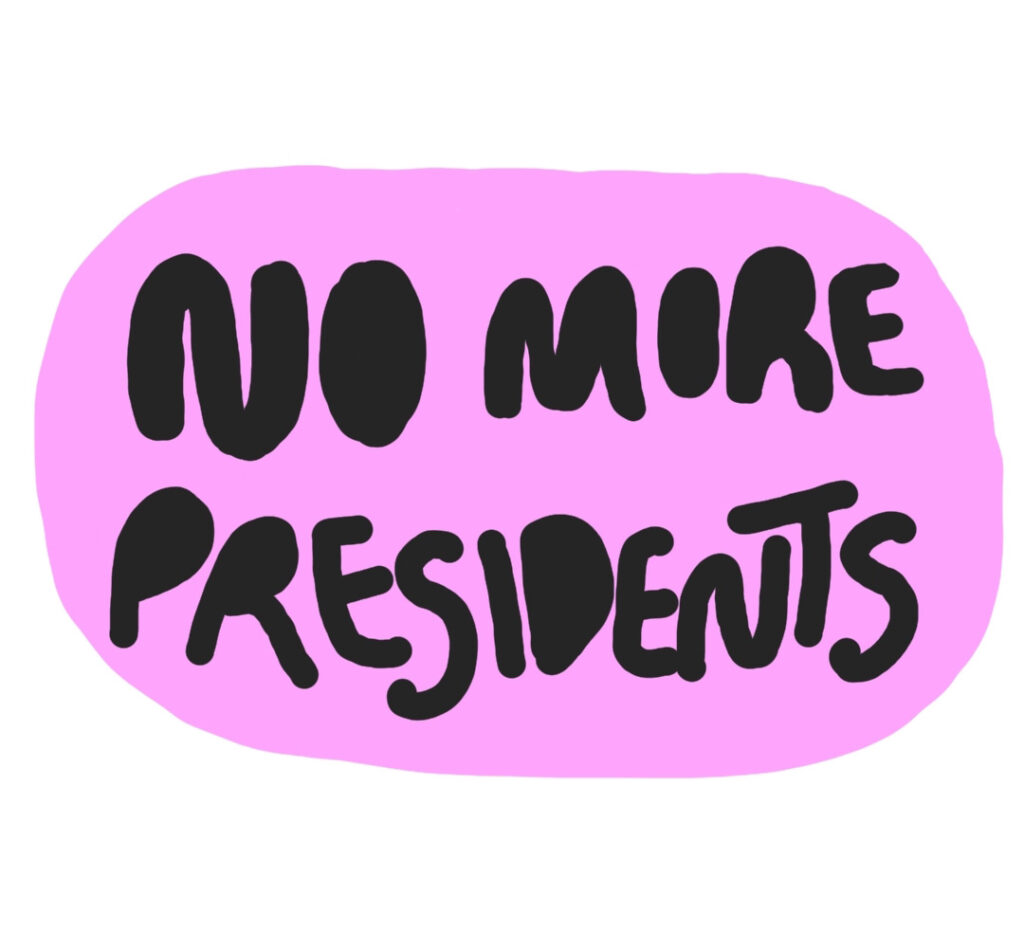
Jeff gave me a wand. It’s gold and silver tinsel taped to a long plastic stick. Later that night it felt like my flag, one I can feel proud to twirl. The way the light sparkles on the tinsel is enough to make me smile.
I hate the u.s flag.
I don’t think people realize we are in an active occupation, an active genocide. The nationalism makes me sick. It’s that nothing I can do will ever be enough feeling, it’s the spiral that more generations will die so white supremacy can live feeling. Democratized genocide. For now I twirl Jeff’s wand in the air, like I’ve seen the queens do, to make my girlfriend laugh as I dance in my room. I dance to feel invincible. I dance to move the fear through and out my body. I dance to sustain.
I am too numb with anger to move. Like I don’t have enough time to process what it means to have half our country vote for another four years of facism. Are white supremacists the minority, I’m uncertain. It feels like facism is taking over globally.
While liberals are cheering for Biden, I am still too angry to celebrate. I know we need a win. I know we need to celebrate together. To be in a room together. To dance together. Oh fuck, it’s been so long since i’ve been in a crowd.
It feels like nothing I can do will be enough. Enough to house my neighbors, enough to provide food and shelter to everyone facing eviction. Ok but what can I do and with what time? I have to get to work.
While I spin my wand like a drill team captain, she says “we can’t lose it all, unless we are ready to lose it all”. Am I ready to lose it all? If it means everyone has a warm bed, then yes. What are we holding on to? What are we holding on for? When will risk become irresistible? I think of the ancestors that fought for my existence and I think of our ancestors, I will fight.
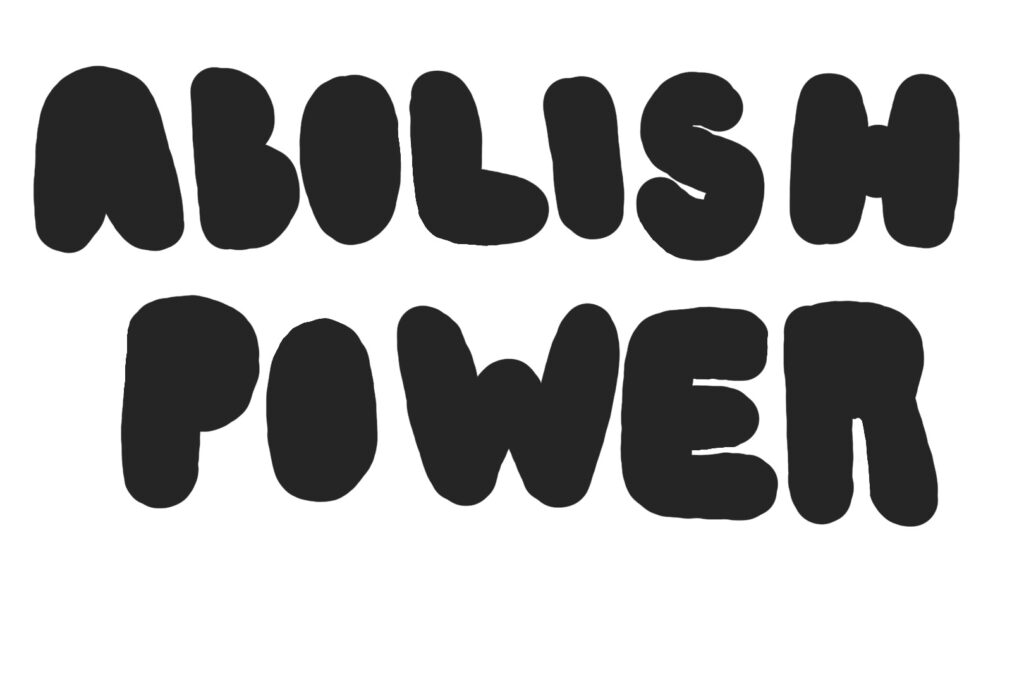
Meditations
on the Movement
of Power
In response to the invitation to share my reflections on the movement of power immediately following the recent presidential election in the USA, I broke out and literally dusted off my copy of Freedom Dreams: The Black Radical Imagination by Robin D.G. Kelly. I recorded my favorite excerpts so that I could listen to the text while undertaking daily activities in the pregnant days awaiting election results. I listened to these words again and again, while taking a bath, while meditating, and – as you’ll see in the video – destroying a ballot that never reached its owner. I became hungry to feel the theories of the book, to – as the author urges – actually believe that something other than the dominant world order is possible. So I began listening to the excerpts while dancing, attempting to invite my body to know the theories outlined in the book. I have a belief that concepts such as power, movement, freedom or love cannot be understood without the body. My hope became that by dancing to the visionary words of Kelley I could access this type of embodied knowing and displace legacies of systematic social trauma inscribed on my body (proactive epigenetics?). Perhaps dance could allow passage of Kelley’s ideas into my cells so that all my life force might become enlisted to render a world according to such freedom dreams.
Parallel
Perspectives
to Power
On November 1st, 2020, five colleagues agreed to individually reflect on “the transfer of power” between November 4th and December 1st. This window of time began with the U.S. Presidential election and ended with the first day of December. Here is a collection of reflections as the staff experienced this moment in time together and apart. By Hannah Ayasse, Rick Darnell, Zerena Diaz, Justin Ebrahemi, and Julie Phelps.
aTONEment
for Vibrational
Shifts
As Black women, we are known to undersell and over-deliver. The price of the undersell is our well-being and the cost is our well-being. Who are we becoming now that we have granted ourselves the understanding of the depth of our value? What rung of the economic ladder are we holding onto? How is the triage of financial and social welfare decided during this global pandemic? Who will be saved and spent? Is the labor(physical, emotional and spiritual) of Blackwomen due for compensation? Amends? Reparations? Reward?
“The ethics of affluence insist upon civic obligations and when we assume that obligation we reveal not our solitary goodwill but our dependence on others… None of us is alone: each of us is dependent on others – some of us depend on others for life itself.”
Toni Morrison, The Price of Wealth, The Cost of Care, May. 9, 2013
“Poor folks been passin the same dolla’ back n forth tween us as long as I can remember. Just got to know who got the dolla’ this week.”
Rosetta Hicks 1964
Background
House/Full of Blackwomen began in December 2015 as the vision of choreographer and Deep Waters Dance Theater founder Amara Tabor Smith, in an ongoing collaboration with theater director Ellen Sebastian Chang. We sit at the literal table in conversation, in grief, in laughter, in questioning and many times in awesome wonder with abolitionists, dancers, nurses, architects, musicians, somatic PhD Scholars, video artists, chefs, teachers, healers, athletes, survivors of sex trafficking and anti-trafficking organizers. We create Episodes – public processions, installations, and performances – that represent the private rituals of healing and wellbeing for Black women and girls.
Developed through intimate dialogues, rigorous research and skilled intentional creative practice between the collaborators, these performed rituals address issues of displacement, erasure, the sex-trafficking of Black women and girls in Oakland California, ignited by the core question, “how can we, as Black women and girls find space to breathe, and be well within a stable home?” All House/Full of Black Women episodes are envisioned and presented throughout Oakland, CA. Our goal is to effect change and create a “vibrational” shift through ritual performance dance/theater and song, bringing awareness to the displacement of Black women and girls with regard to housing security and trafficking.
We have held space and are in an ongoing collaboration with sex trafficking abolitionist, Regina Evens of Regina’s Door, who hosted our first episode, we are here/to stay in 2016. Some of these episodes have been “publicized” but most have been transmitted through word-of-mouth by Black women and/or via Oakland’s First Friday or anti-trafficking events. We have created 13 Episodes, 90% have been FREE to attend.
Within a rapidly changing landscape during an avalanche of uncertainty, the House/Full of BlackWomen continue to labor towards our collective health and well-being.
Support us because you already know, at your core, how you directly benefit from the Love that Black Women create.
Will you contribute financially to these efforts?
Will you contribute in-kind to these efforts?
Our creative spirited life forces are prepared for this moment as we reimagine the work in the face of COVID 19, the aggressive uptick of violence against black bodies, and the need to shelter in place.
We continue…
shadow work
care work
investigative quiet work of Black womanist interiority
We understand the change needed begins only with our well-being through…
security of housing,
security of fresh food, clean water, and air,
security of health care,
security of honest education,
security of recognition of our contributions and
security of the fullness of our diversity.
Where are you now in this arc of history? How will you respond to the call to support Black lives when no one is watching or applauding? What will you do to create transparent equity, restorative justice, reparations, and space for Black lives, especially Black women and girls?
Now is the time to acknowledge the depth and generosity of labor, emotional insights, and sheer joyful life-giving beauty of Black women/girls/transBeings that have always moved the dial of humanity forward.
How do YOU honor that?
Do you center yourself?
Or…
Do you humble yourself to investigate, where, what, when and how to support
the lives of Black women?
Will we together enter an age of real change?
Or…
Will this be another phase of performative anti-racist lip-service?
Ask Black women…
What do you need?
When do you need it?
How can I serve your needs?
And be ready to RESPOND!
Before the pandemic was fully realized in the United States we crafted a crowdfunding campaign that would launch on Valentine’s Day 2020 to support the invisible genius/creative labor and the appropriated brilliance of Black women. We hoped to raise $100k in financial or in-kind donations to fund the completion of House/Full of Black Women’s Episode 14, The New Chitilin Circuitry: Reparations Vaudeville and now the final Episode 15 “this too shall pass.”
We financially compensate the Black women of House/Full to do this critical work! We also offer stipends, meals, and healing circles: this is “shadow work,” quiet work, work that happens over time and space and in respect to the (un)recognized creative service and brilliance of the unnamed Black women and girls who inhabit and fuel our imaginations.
We hope that someone(s) with access to wealth will choose to support our ongoing efforts. We hope that someone(s) will invest in our well-being as an asset, a blessing and a service.
Donate
New Chitlin Circuitry, Reparations Vaudeville
Act II:
Return to sender
With great respect to the crown of your re-birth
With love from the hot new world of possibilities
This story ain’t yours
It’s ours
all ours!
Told like a rope that we toss to lift us out of sorrow’s well
And we laugh!!!!!!
While we reach down to pull you up!
It’s a bawdy tale
full of half truths,
unpaid bills,
patchwork dreams,
and lies so bold, they ring gospel!
In the worst of times
we laughed often
slept a lot
ate recession stew
and giggled in spaces so dark
only the scent of sweat gave you away
It is in these spaces
Where the spells
cast by lady boys
daddy wimmin
and the mothers of us all
undid the plot
these are the times of erosion
time itself eroding
disappearing
taking with it the myths and bibles
that erased her name.
Writing from House/full of Blackwomen Project Episode 14: The New Chitlin Circuitry/A Reparations Vaudeville
The Land
You are On
We are all on Indigenous land. Whose ancestral land is this? How did we get here? What is the story of the place we are? How can we recognize responsibiliity in the lineage of displacement, colonization and genocide that our country is founded on?
This short multi-media piece examines history, place, responsibility, and rematriation through voices from Sogorea Te’ Land Trust.
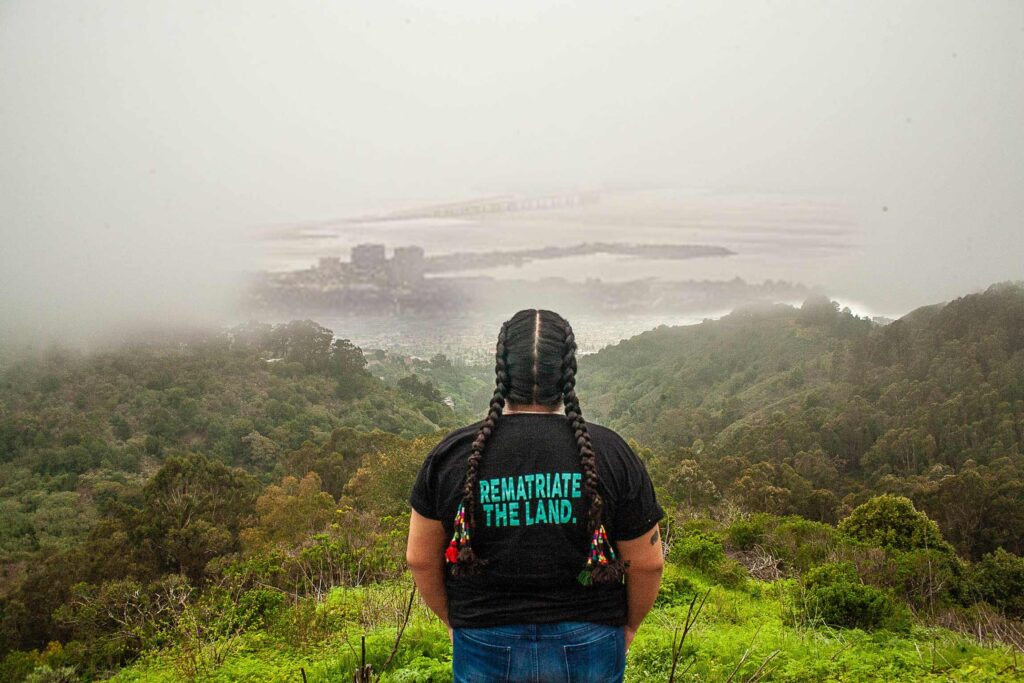
Inside
Power Shift
A Conversation on Distributed Leadership and HMD/The Bridge Project
Introductions
Introductions Footnotes
1. HMD is working with consultant Safi Jiroh (LeaderSpring Center) on developing a model for its transition to distributed leadership.
2. Power Shift: Improvisation, Activism, and Community, the Bridge Project’s 10th Anniversary program, concluded in November 2020. Visit bridgeproject.art for a full archive to this and other Bridge Project programs.
Question #1
What role does deepening distributed leadership within HMD play in dismantling white supremacy?
Question #1 Footnotes
1. A description of the characteristics of white supremacy culture, by Tema Okun.
Question #2
What overlaps have you experienced between our conversations around distributed leadership and your current art practice?
Question #2 Footnotes
1. Cherie Hill IrieDance company.
2. Choreography by Hope Mohr.
3. A record of Karla Quintero’s artistic work.
4. Cherie Hill’s photo and essay response to the Aesthetic Equity workshop, co-facilitated with Liz Lerman & Paloma McGregor, and co-presented with Yayoi Kambara’s Community Engagement Residency “Aesthetic Shift”.
5. A recording of the Conversation on Aesthetic Equity, presented October 2020 as part of the Festival Power Shift: Improvisation, Activism, and Community.
Question #3
What is gratifying for you about how we are working with artists?
Question #3 Footnotes
1. HMD’s Community Engagement Residency was founded in 2007. The program provides year-long support for select artists, especially those historically marginalized, to engage their communities in social justice oriented art. Core values of the residency include equity, dialogue, process, artist autonomy, the intersection of art-making and activism, and building relationships among artists.
Question #4
In the past 6 months, many art organizations have issued statements of solidarity with the Black Lives Matter movement, and calling for diversity, equity, and inclusion in the field. What do you make of these calls to actions? What do you think art organizations need to do to make solidarity meaningful?
Question #4 Footnotes
1. “I Said, Can You Hear Me Now?” A letter to the white American dance community from the International Association of Blacks in Dance.
2. “Why I Resigned From The California Arts Council In The Middle Of A Pandemic” by Sarah Rafael García.
3. “The Failure of Arts Organizations to Move Toward Racial Equity”, Op-ed by Quanice Floyd.
Question #5
If the performing arts shifted so that every organization, theater, artist, and funder implemented equity-driven models of leadership, programming, and practice, how would the field be different? What would it look like?
Question #5 Footnotes
1. Iris Crawford writes about Power Shift’s closing workshop, The Keystone of the Arch: Embodied 100 Years Vision, co-facilitated by Yalini Dream & Tammy Johnson.
2. What Happens when a Group of Artists is Put in Charge of a Presenting Organization?, an article about Performance Space NY (PS 122) sharing 2020 initiative to shift organizational resources into the hands of artists.
3. Performance Space New York Hands Budget and Keys Over to a Group of Artists, more on the abovementioned initiative.
Shifting Power
Towards Collective
Liberation
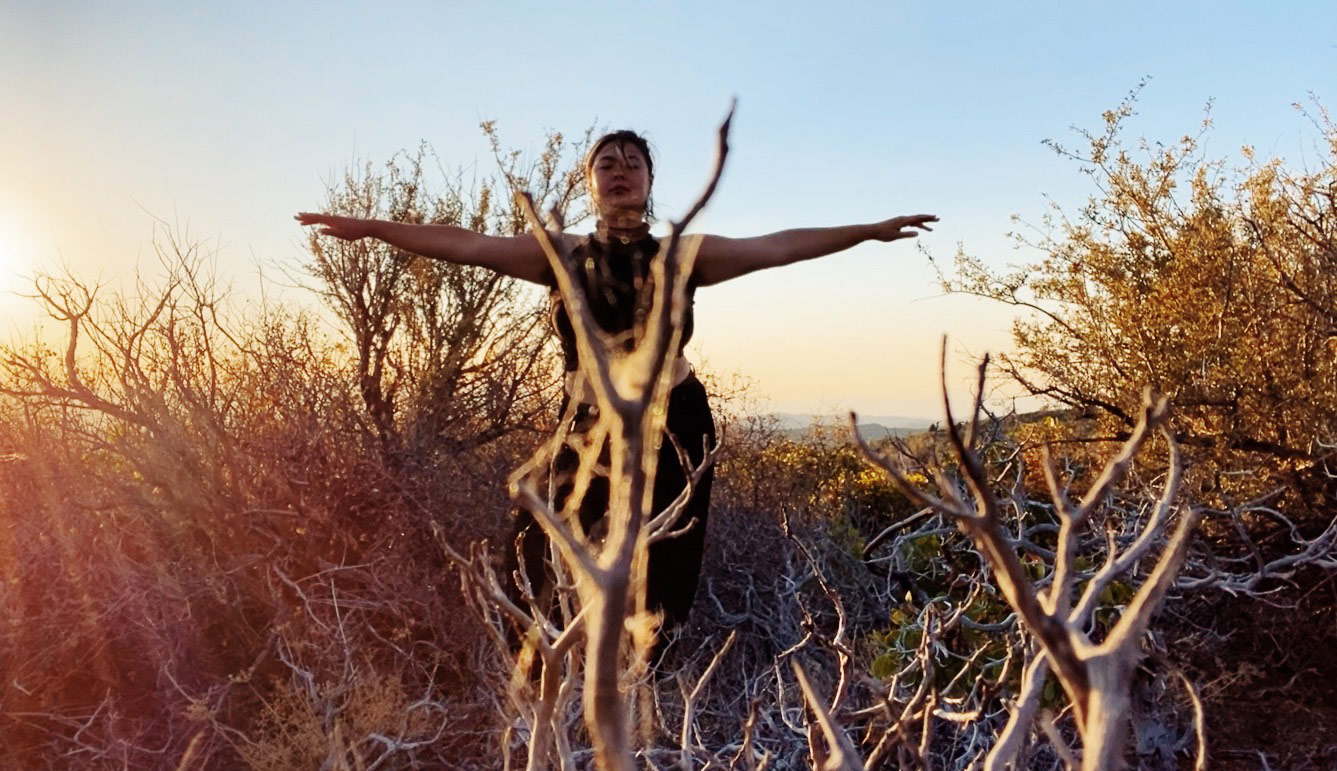
This workshop explores the intersection of the body, Power, and liberation. Together, we will begin to address and unpack Power in the body as we divest from patriarchal expressions of Power that make liberation next to impossible. Through a combination of lecture, writing, reflection, and dance improvisation/embodiment exercises, participants will explore their personal relationship to Power. Together, we will begin to establish new ways to move our internal and external expressions of Power to align our actions in the best interest of our collective healing, liberation, joy, and transformative potential. No dance experience necessary, all bodies welcome.
Embodied
Divination
REPAIRations, and Collective Response(ability) in the Afro NOW
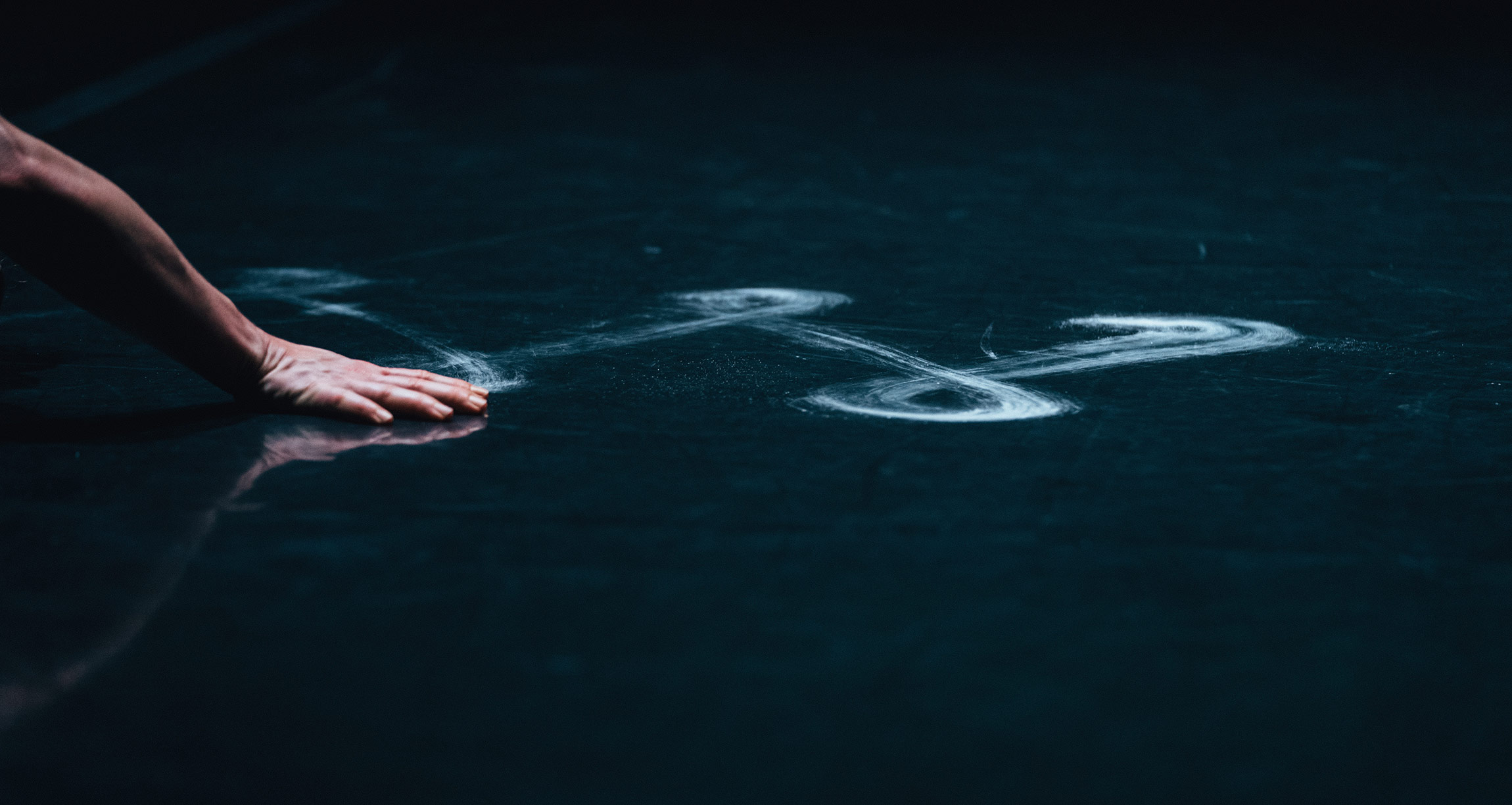
In this hour and a half together,
you are invited to contemplate your body as oracle,
as compass,
and site for social repair.
A short journey together moving with
oppression
privilege
dying
rebirth
isolation
connection
and the liminal space of now
hold on to your breath
freedom is not free
Please wear clothes to move in
a notebook
water to drink
any talismans/crystals that you work with or that offer you protection
Practice Prayer
Dancing
with Ideas
A Conversation on Consent
How do we understand consent, power, and agency in dance from the rehearsal to the class to the nightclub? You are invited to listen in on a roundtable discussion on issues of consent in dance featuring perspectives from choreography, contact improvisation, dance education, and nightlife. If we choose to ask our body and the bodies of others to create our art/work/joy, we must also choose to build our muscle of communicating about consent.
Statement
Re-write
November
To save the world, to change the world, to save the planet, to save ourselves, to save the ones we love, to save the whales, to save the coral reef, to save the dying, to save the starving, to save the suffering, to change the world.
It seems we would like to live in a fairer, better world, where for instance art is run differently, it is taught differently, has different purposes and different operational structures. But are we ready to REALLY check out of the ever so quickly spinning art market of today and refuse to compete according to existing rules? According to what rules would we compete then? Would we not compete at all? No matter how relieving it sounds, isn’t that against human nature?
Doesn’t “the change” mean just “the exchange” of one set of powermongers to another? Isn’t it naive to expect anything else? I have been naive so many times already, I don’t think I can afford one more time, I am too traumatised, too cynical, have too much scar tissue… everywhere, basically.
The change is not only to be expected, it is first of all to be made, why should we be the ones to work for it? During what time? Not to mention that “the project does not really have a budget”, or “has a very small budget” – it seems to be another one of those.
And last but not least, taking democratic principles seriously, the change requires a radical shift in beliefs and opinions of the others and they are so many. Why should we even attempt to do it, shouldn’t it be their own responsibility? Can we really change the opinions and beliefs of the others? We cannot, cannot, cannot…
Maybe it was in the summer, maybe in the winter, maybe it was last year, or the year before, it really doesn’t matter.
I am waiting at the counter of a “late shop”, one of thousands of such shops in Berlin, to buy something for immediate use, a beer or a bio riesling in a small bottle, a mate or an orangina, cigarettes or a lighter or both, it really doesn’t matter.
There is a guy in front of me, who is also buying something like that and he is already paying. He is going through his pockets, looking for the money to finish the purchase, some money is on the counter already, it really doesn’t matter how much, but some is still missing and he is looking for that missing amount. The shop owner, me, people behind us are all waiting. After a while it becomes clear, he is not looking just for any money, he is looking for some specific coin or bill. It is important for him to finish the transaction in a predetermined, planned, designed by him manner. And that takes time. Nobody is angry or impatient, or grumpy or annoyed. We are all silently witnessing this act of searching, executed with focus, attention and a large investment of energy. Finally, he finds what he was looking for and puts a 10 euro cent coin on the counter with the loud clunk and a triumphant smile, and we all laugh – the shop owner, me, people behind me and the guy himself. We are all relieved and happy it worked. The microcosm of searching was recognizable and full of meaning to all of us, thus we all crossed our fingers for him, patiently waited for this process to end well and not as we all, knowing fully well, it may not have.
I thought to myself, what a storytelling gem, performed in seconds really, but clear, seen, heard and understood by everybody and even climaxed perfectly with the clank. In such moments, I feel this world has patterns and senses which just sit there and all I need to do as a human and as an artist is to spot and embrace them, to ride them like a surfer rides the ocean waves. And if I do just that, all will be ok…
My city, my dog, my lover, my brother, my killer, my country, my dance, my curator, my time, my values, my rules, my family, my cat, my beach, my hotel, my doctor, my dentist, my boss, my dancers, my likes and dislikes, my coffee shop, my laundry shop, my ice cream shop, my street, my park, my river, my view from the window.
Day after day, endlessly, we express our feeling of owning stuff, accompanied by the deep satisfaction drawn from that feeling. We are proud and passionate about possessing this and that,we emphasise our owning as the opposite of somebody else’s not owning: mine = not yours.
The declaration of ownership and the success of possession make us feel better, fuller, less hysterical, less lost and more found. However, all those things, places, people and concepts, ownership of which we claim, actually own us, not us them. So why do we twist it around, as if it was shameful to be owned? Is being possessed wrong? Would that make us losers if we said it the other way, as if we were parts of something, other than owners of things?
The city owns me, the dog owns me, the lover owns me, the brother owns me, the killer owns me, the country owns me, the dance owns me, the curator owns me, the time owns me, the values own me, the rules own me, the family owns me, the cat owns me, the beach owns me, the apartment owns me, the doctor owns me, the dentist owns me, the boss owns me, the dancers own me, the likes and dislikes own me, the coffee shop owns me, the laundry shop owns me, the ice cream shop owns me, the street owns me, the park owns me, the river owns me, the view from the window owns me…
Berlin, November 2020
Grand re Union Statement
see all versions
Guided
Choreographies
for the Living
and the Dead
2019-2021
Beginning in 2019, Driscoll began a new series of audio works titled Guided Choreographies for the Living and the Dead. Some of these choreographies have been presented to audiences live in theater and experienced collectively, others as part of her solo exhibition Come On In at Walker Art Center, and still others offered online to be listened to at home.
Please find a quiet and comfortable place to listen, put on headphones, and allow 15 minutes for this shared journey with the artist.
Created and Performed by Faye Driscoll
Digital Interface by Studio-Set
Video Production by Daniel Jackson
Production and Management by George Lugg
The material has been shared thanks to the courtesy of Faye Driscoll, for the purpose of Grand re Union project.
The Dance
That Will Have
Happened
I
EARTH / HUMAN BODY / UNIVERSE
Score
Close the eyes to see
Root the body
Down to the Centre of the Earth
Up to the Centre of the Universe
Let the movement travel through
Let the form re-act and re-member
Listen with the hair on your legs
Taste with the hair in your ears
Smell with the hair on your eyes
See with the hair on your skin
Sense / feel / touch with your organs
Let the movement travel through
Let the form re-act and re-member
Allow the shape to blur
Allow the shape to fade out
Enjoy the shapelessness
Enjoy the limitlessness
Keep on dancing the dance of your movement
Let the dance happen between known and unknown and let the movement flow
When it is finished
Lie down for as long as needed
Let the body dream what was and what is coming
With the next breath end and begin
II
Text
Sitting by the water, I shift the perspective and lie down. The water becomes a wall or a door I could possible walk through. The sky becomes the surrounding, and the cold ground a prolongation of my body. It is early fall and the temperature dropped drastically. My eyes cannot stop wandering into the fabric of water, and the overwhelming strength of it. My body remembers. I can still feel the sensation of my naked body swimming in those very waters yesterday. The ecstatic pleasure of adjusting to low temperature. The moment of acceptance to the surprising new experience and the overwhelming pleasure of crossing the line from comfortable to the unknown. This time, through my eyes, my body is experiencing the memory; the embodied experience is incredibly present and real. It reaches such an intensity that the actual blurs out and all that remains is the water embodied in me.
Twenty-first century, the year 2020.
The future is here, the wonders of the year 2000 have happened, and the collective body of the Earth keeps dreaming its future. What is its responsibility in the act of imagining? Where does the act of imagining situate itself in in the body as we know it? What is the technology of the human body in the XXI century? The technology that humans create out of the body is evolving rapidly. What if the technology of the body was a priority? How will the senses of the body evolve in the future we are creating today? “When one sense stops working the others get stronger”, they say. Maybe in the XXI century humans could start using the sensorial side of the body to its fullest capacity. How would one function if the skin could feel the movement of the other-than-human, of the being that is not physical, like the coming rain? What would it mean to choose an environment in which the body gets the chance to evolve the most? Paradoxically the less “I do”, the more the body gets a chance to develop. The concept of “active non-doing” of Tao philosophy could be a take on how the technology of the body works, the body that is actively occupied with ghost-like activities, invisible but tangible, as a goal for future human body technology. The invisible knowledge constantly accumulated by the body with the use of its senses could be easily missed, just like the presence of a ghost. Could the sensorial experience be the invisible tool to help the body evolve?
As we pass each other, my whole body knows. We stop, take each other’s hands, I recognise the temperature of your body, the softness of your hand. As our eyes meet, we close them and allow our lips to meet. Remembering the kiss, the touch of the lips, the taste and the smell. As we pass each other, I realise our eyes meet and all of it happens, but not in this time slot. This time our eyes just meet and our bodies remember. Maybe another time.
What is the embodied dream our body is dreaming, for today, for tomorrow and for the future we are living? Radical Imagination would be a way in which the act of imagining is challenged and does not follow “the logical”. A year ago it would have been very difficult to imagine that the global economy would be closed for few weeks—yet it has been proven differently. It became a permission to go wild with the way we create fantasy. How does one imagine now when everything is possible? What would be the greatest desire of one’s heart to imagine? Are we ready to do so? It may be the greatest responsibility of ours. It used to be so easy and comfortable to stay with our limited imagination. But what effort does one need to make to envision a great solution, a great next step of this situation, a wonderful other norm than the one we were educated into? How could one imagine with the body and what could the embodied fantasy of tomorrow be?
Touch
My body, a human body, the shape I carry around and I am recognised by. What happens when the skin stops being its boundary? What happens when the senses of the body reach far beyond the skin? What happens when I allow my mind to forget that my shape has limits and let the sensory information flow?
Walking on the streets, I realise there is not even one part of my body that is exposed. It is cold outside and my skin is covered from my toes to the top of my head. Even my face, as I am wearing a mask over my mouth and glasses. Not one bit of my skin can feel the air, can experience the temperature. I take my hands out of the pockets, to quickly hide them back in as the cold hurts my skin.
Does the body remember every touch it has ever experienced? Every wind blow? Every nettle it has walked through? All the waters it has swam in? What is its knowledge? What is its memory? What is its wisdom? The knowledge of the body is built from its memory. Not only remembering the experience but creating embodied wisdom from it. Understanding its surroundings and creating the language to communicate with the other-than-human. A language based on touch and the skin’s sensation. Communication with the ghost experience of the body, with the information invisible to the eye but surely tangible to the skin or any other layer of the body. What would it mean to allow the organs to communicate with the plants in the middle of the forest and to differentiate what is nutritious from what could become poison?
There are stars in the bubble coming out of my body as it lays down. When the sound changes, snakes come and clear the space out. At first, they fly all around me, but then they start crossing my shape as well. It is a big relief. Since they can travel through it, my body merges with its surroundings. It is very freeing to be the “empty space”. I feel calm; my whole body gives into this sensation. My body fills up the whole room and the room fills up my whole body. The sound changes again. The snakes, the bubbles, the emptiness all disappear. My eyes want to remain closed. My mouth is eager to let the sounds out. It is too easy for the body to recreate its shape again.
Smell
The sensorial way of discovering the future.
I put my nose too close to the rose blooming in a public park. It is safe to smell a public flower? Part of me wants to check if my nose is still capable of recognising a fragrance. Part of me wants to feel the flower and let it take my existence for a journey, albeit one that will last only a few seconds. But the desire for colours, shapes and sensation the fragrance creates is stronger. My eyes close and I am quickly transported into the rose dimension.
Hearing
My ears are covered and can barely hear what a friend next to me is saying. Luckily, at the sunset hour the birds in the city park get loud and sing their songs with enormous power. My whole body enjoys the inner dance with these black creatures in the sky. My blood gets warmer and goes faster. I am part of this party. My feet can feel the strength of the trees’ roots all around. We are all having a last dance before the night takes over.
“Spiders listen with the hair on their legs”, she said… Can my body also do that? I will only know if I keep trying.
My ears hear a multiplicity of sounds: some are coming from surrounding reality, some from other places, there is no selection. They hear the silence. Ah, how beautiful silence sounds. But not for too long; the next layer of sound opens up. The micro noises and the sounds from far away sing a song and accompany the inner sounds of the body. The heart is keeping the bass, the breath is keeping the rhythm.
The silence of a phone or computer is very loud.
The journey continues on to hearing the visible and the invisible, as to the ear there is no difference. Only the audible counts.
Taste
As I taste flowers and fruits that are unknown to me, my brain gets high, my body wants to move, the level of excitement rises. There is a need to process the surprising experience. Everything changes. The new information opens up new habits.
What if I could deliver presumably one new sensorial experience a day? What if such a challenge was the basis of a daily practice? If the body could be recognised as a tool for constantly discovering the reality around it? What if there are more tools in the human body that might have been forgotten?
I reach the river. I drink the water that I am standing in. I lay down and the river covers my body perfectly in a way that my nose stays above the surface. I can sense the same water flowing within and all around my body. My whole body, inner and outer surfaces, can experience the taste of this very water. It does feel ecstatic. The shape of my body is gone; there is only movement. My eyes wonder into the tops of the trees of the jungle and into the sky. The form of me is gone; there is only movement.
Vision
There was a vision in each of us for this year. There was a feeling in our bodies a year ago. There was some kind of stability and obviousness of logic, some sort of predictability to the reality that we got used to. Then the surprises began.
My eyes keep looking at the computer screen—“I am working”. Simultaneously, my body sees a very different situation. It can see it with its whole skin, it can see it with its organs, and the vision is as strong and present as the screen in front of me. I look around but the image I am seeking is elsewhere, yet visible and present. My body knows I am not the only one in the room. My heart is calm, as it feels cared for. I want to keep playing the role of a human working on her laptop. But my whole being is enjoying the encounter with this ghost being, ungraspable to my eyes yet strongly experienced and recognised by my body. I let my eyes close. The sensation comes and goes just like waves on a calm sea. Until eventually it goes away
What if the body could give the vision a rest and allow it to be lazier? Sometimes it feels that my eyes forget how to see and they just scan the surface. There are days when the eyes see more when they remain closed most of the time. My eyes get tired of recognising shapes; they long for blurry vision, for unrecognised patterns, for soft edges…
At night I open the door and the light from my room lights up the tree in front of the house. There is no other light as far as the Tatra Mountains. There are only stars in the night sky, showing the Milky Way. On the lit tree I recognise the shadow of my body. It is bigger than the one I am used to. The tree becomes the canvas for the shape I am projecting into the night. I see this shape of mine, but need a moment to get used to it. I am within the tree. I know this view so well in the daytime. How come it feels so different? My mind cannot explain the difference. My eyes are hypnotised and do not want to stop seeing it. I close the door and go back to sleep.
The body communicates its needs all the time. I learned to recognise some of them, others I learned to ignore. Now I try to be aware of the difference between the two, and to recognise the voice of my own body.
The body remembers, the body knows, the body dreams.
I am walking barefoot. It has been a few weeks that I walk barefoot daily in the forest. I leave the house barefoot to go to the beach. I cross the warm pavements in the city barefoot. Walking through the river with no shoes on is part of my walk. I step into a cafe and order my coffee barefoot. Walking with no shoes on makes me realise the importance of the ground I step upon. The soft surface of the mud, the bottom of the lake, the water on the kitchen floor, the snail in front of the house, the stones by the sea, the hot sand by the ocean, the wet grass in the morning. So much information available to me. My body experiences a lack of breath when the surrounding is covered in concrete. My feet miss the exchange with the soil, my body longs for the memory of oxygen exchange. My legs take me once again into the reality of “normal life”, away from the city, where my feet can breathe, where my body can forget its boundaries, where I lose my shape and gain the sensorial experience of being.
III
DREAMING THE FUTURE
Exercise
Next time your Eyes are closed
Imagine your most desired future Self
Imagine the most desired feeling that your Body wishes for
Imagine the most desired sensation of your Interconnected Body
Imagine the most desired state of your Earth Body
Imagine the most desired experience of the Cosmic Body
Imagine your most desired future Self
IV

proofreading: Angelica Sgouros
Whale Fall
Whale came to visit me today
Whale said,
Hey do you have a moment?
I didn’t know what to say because
I had never been visited by a whale before
whale said
I’m here to show you how to live and die
I’m going to take you to the depths, to the place
Where my body falls after I die
I said,
Whale, I cannot go to the depths
I won’t be able to breath there
Whale said
You can’t breath here on earth.
Your ancestors sent me here to remind you of your impossible existence.
Whale said
When you fall, you will die and be reborn again
You will replenish the ocean with your cellular body
And you will mingle with the cellular bodies of your ancestors before time
Whale said
Whale fall with me to the bottom of the sea
I said
I’ve given up the ghost before and I can do it again
Whale said
It is better to know the ghosts that you’ve given up
It is better to know
“Alas the Heart
is not a Plant”
Excerpts from the Diary of a Sick Detective
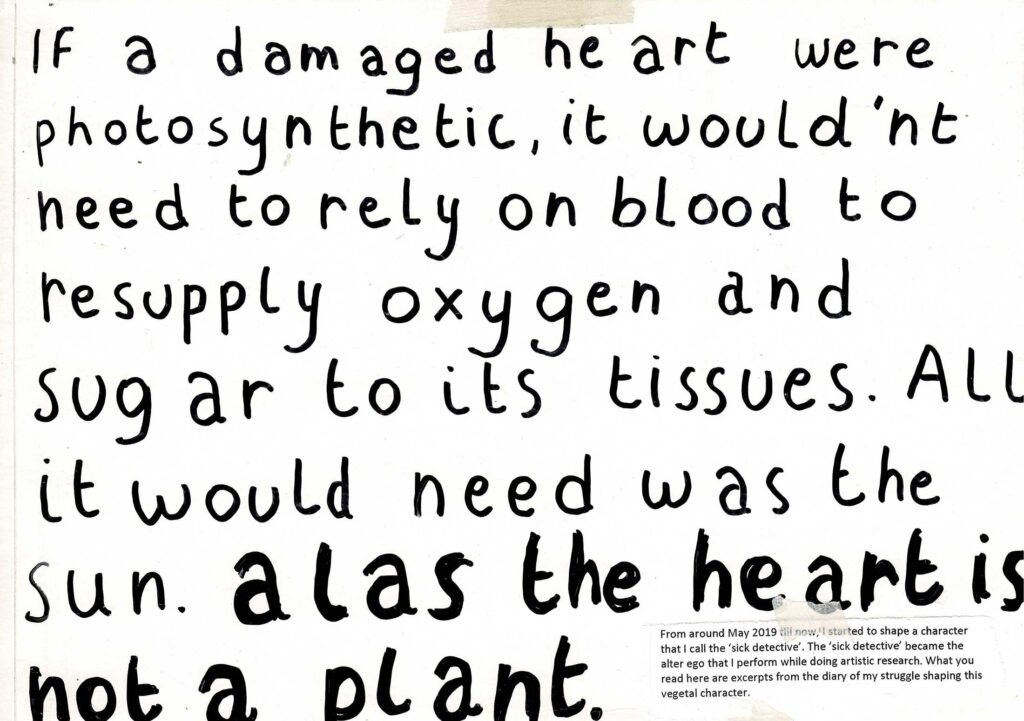
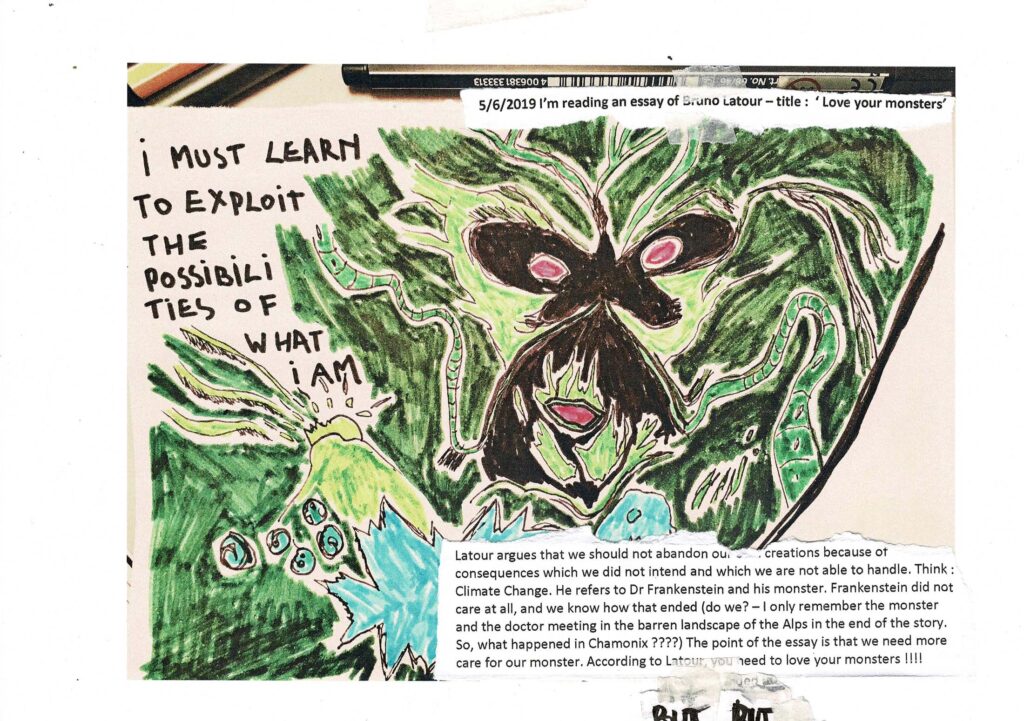
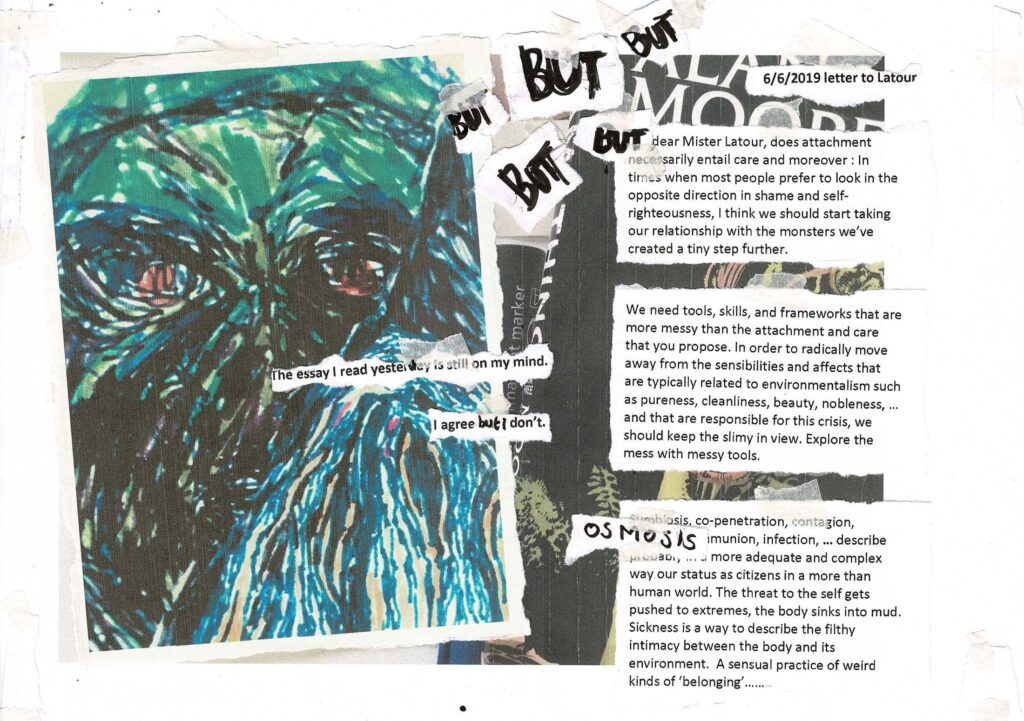
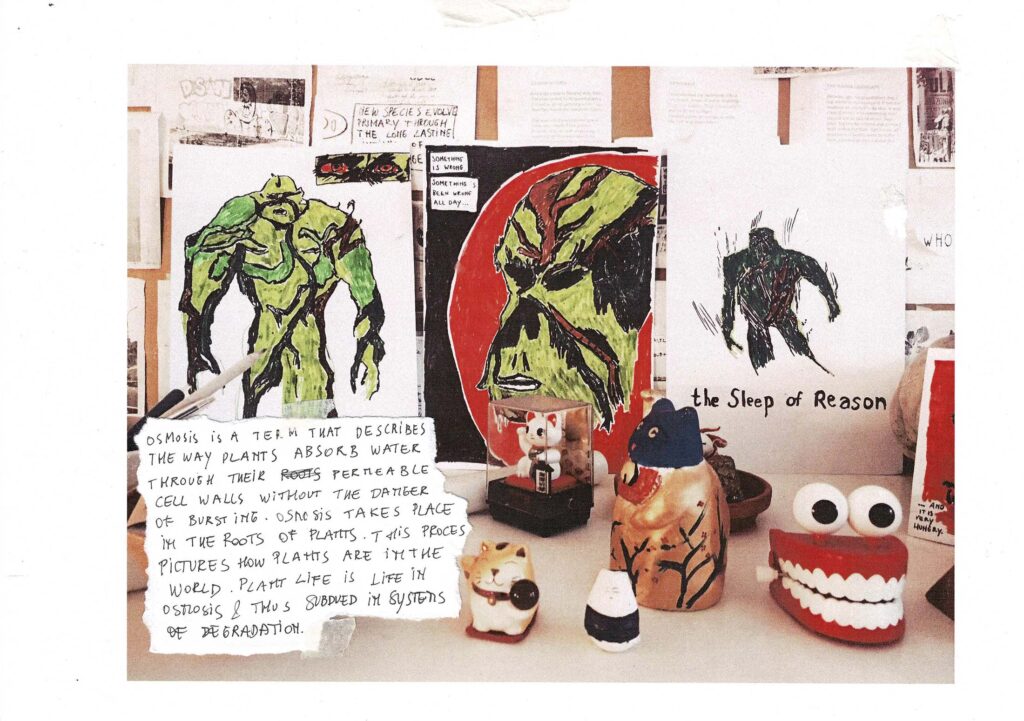
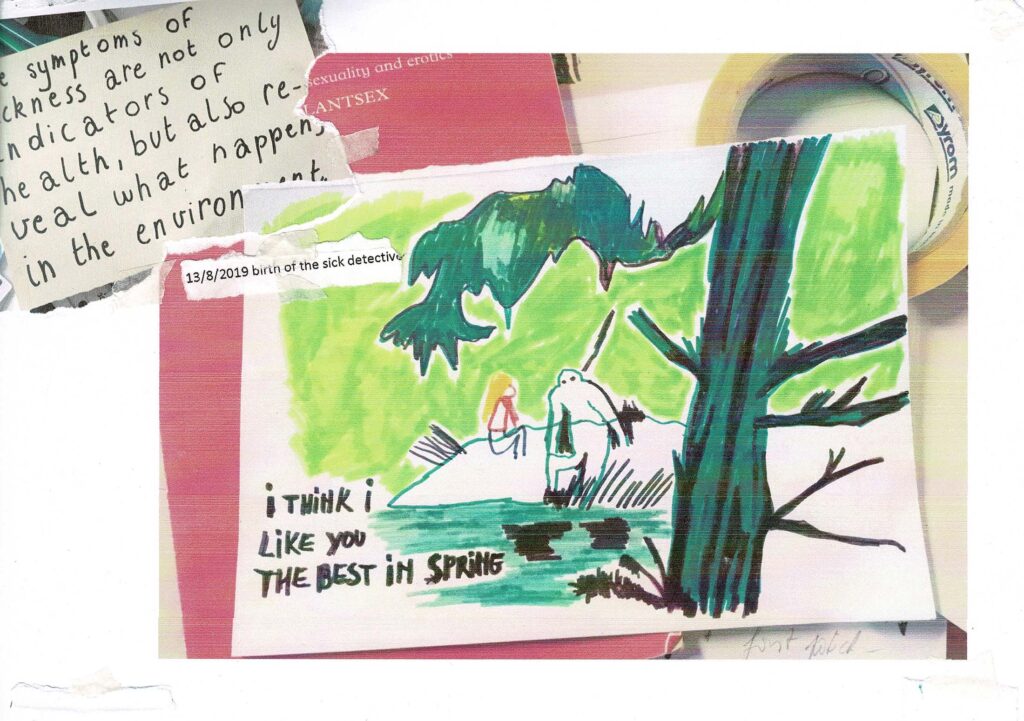
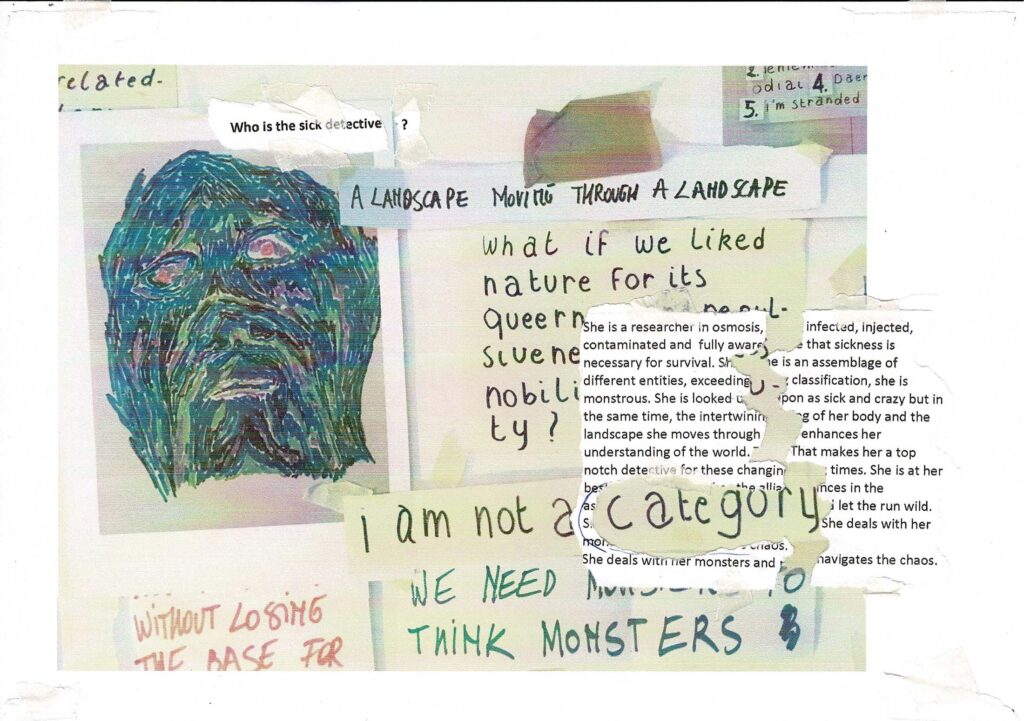
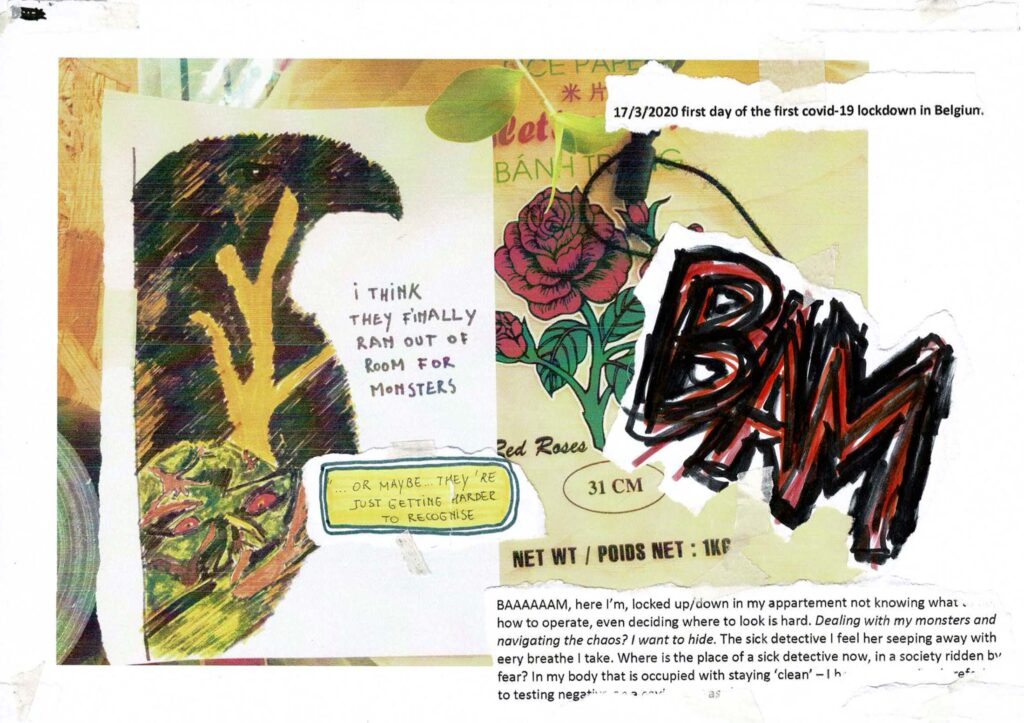
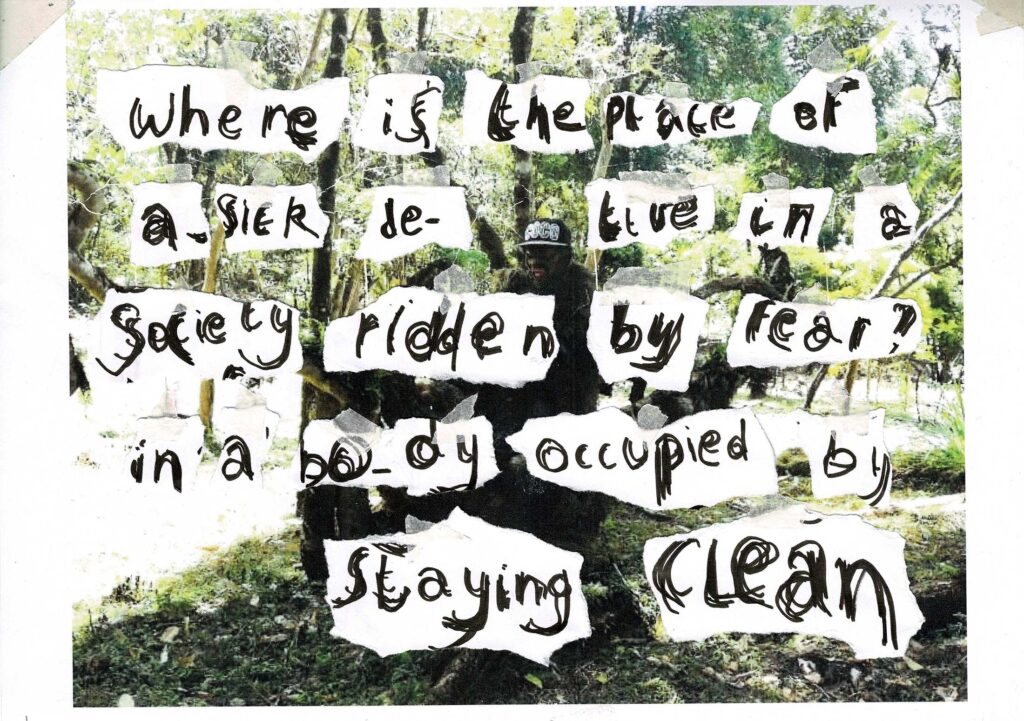
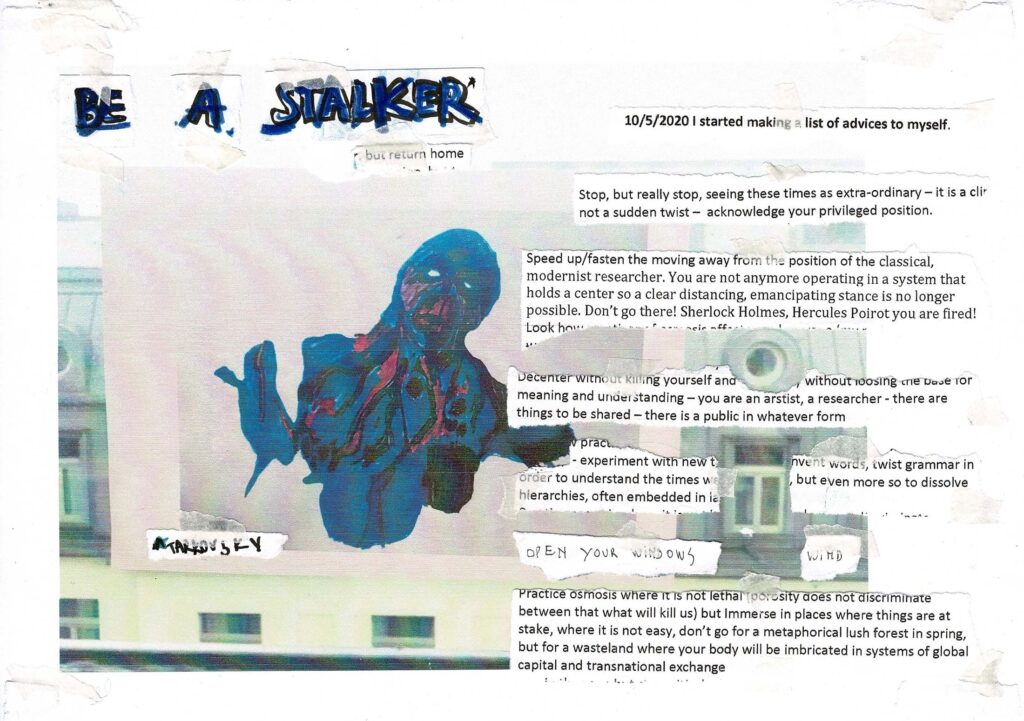
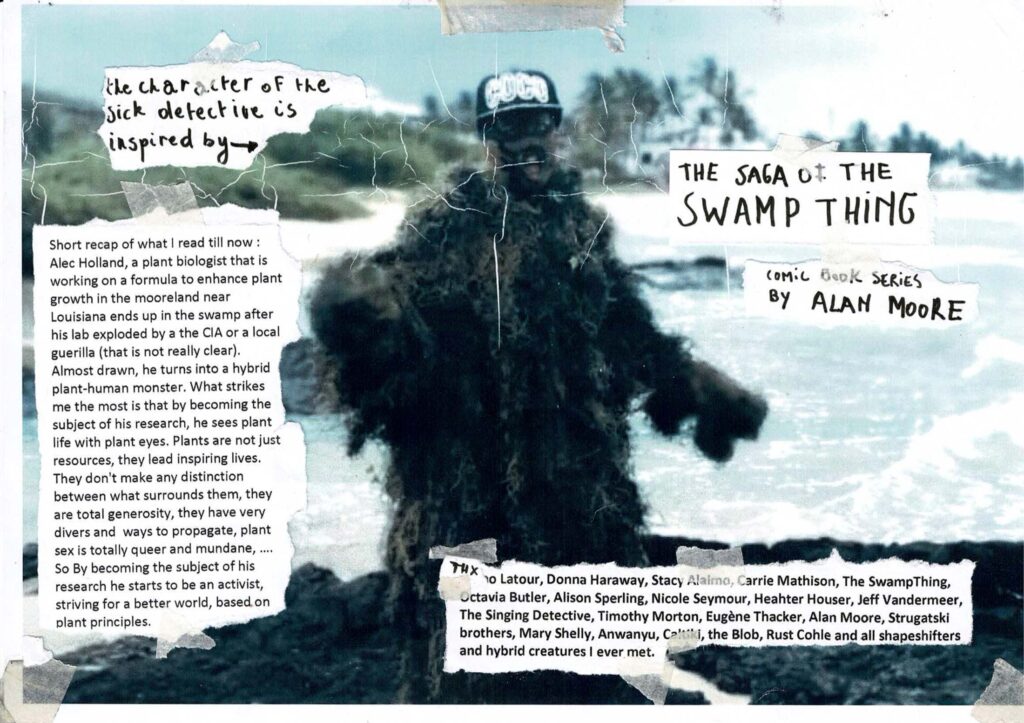
Desire-gram

We meet. On a disorienting walk. I notice you immediately.
Spiral into you. Looking up at me. There is desire.
To spend time. To get to know you. I’m curious.
If we could work together. We go back to mine. I lean you
against the wall. To understand. How best this could be digested.
I want to know what you want. I don’t want you to be just an object.
We’re quite different. I begin to think about this space between us.
Where we meet. I hold you. At a distance. With both hands.
Holding you right. I draw you close to me. Your teeth bared.
It’s something we can do. Together. Intended. I wonder how it feels
to be held by me. My hands imprinting on soft skin. I fold over
the experience. Turning it inside out. A map of sensation. Trying.
To bridge this gap. It takes time. Gets messy. Stopping and starting.
To let it settle. I peel back the surface. See what has materialised.
And gather up the pieces.
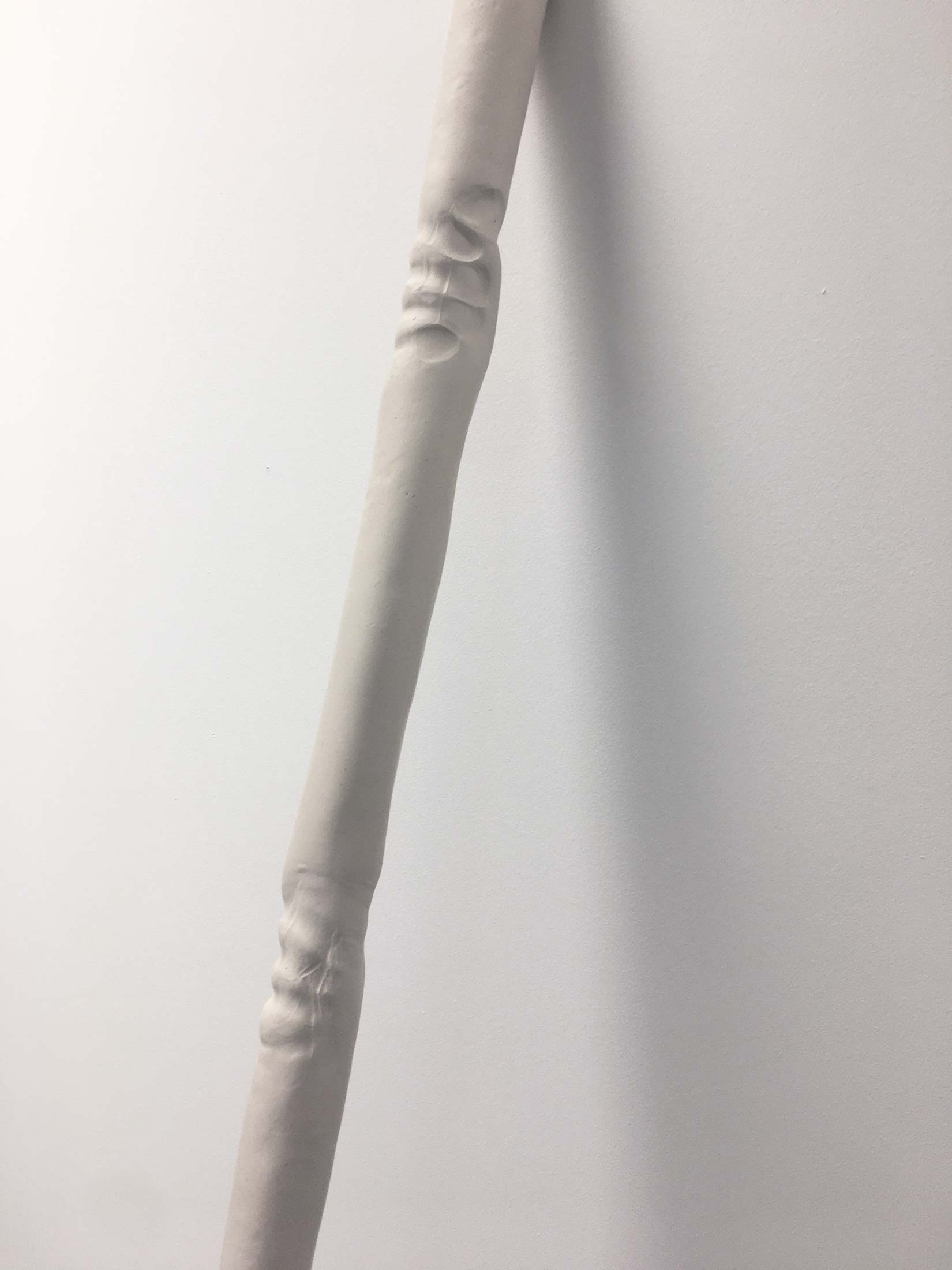
“how the terms
‘mind’ and ‘matter’
are abstractions which
in their concreteness
are identical”
Stories as worlds inhabited by things that keep slipping beyond our grasp. Things which lurk at the back of our mind, on the tip of our tongue, just out of reach. Stories with protagonists that can only be known as gaps in being. The spaces they leave. Not here and not quite there yet. Dwelling on the peripheries of the sensible, speaking in glimmers, shimmers, suggestions.
These stories may not even have words. They might be felt rather than told. In sound, scent, touch and light. The stories might be experienced at the limits of the visible spectrum, pulsing at ultraviolet or infrared frequencies. They might inhabit the radio spectrum or create divergencies across the spectrum of acceptable behaviours. Spectral stories, stories of cosmic spectra and planetary spectres. The folk tales of unquiet matter.
I have sought to show how the terms ‘mind’ and ‘matter’ are abstractions which in their concreteness are identical
Peter Sjöstedt-H
Buy Digital Track
at bandcamp.com
Recorded and composed in the Sonoran Desert, Seili, the Kii peninsula, Istria, Helsinki, Brussels and Elsewhere during 02018 and 02019 by Maja Kuzmanovic and Nik Gaffney.
With thanks to Taru Elfving, the Bioart Society, spectral interferrences from Seili, the kami of 熊野古道 and the seething scope of sentience.
Supported by CAA Contemporary Art Archipelago, Saaristomeren tutkimuslaitos and the Panpsychic Development Fund.
Flow & Flex
Reimagining forms of relation entails imagining new genres of experience
Sex, or the Unbearable — Laurent Berlant and Lee Edelman
Materials in the collages have been collected from educational booklets on nature, science, guides on hiking and fishing, an illustrated guide on weight lifting, all printed in the socialist period. They we all found in Estonia, in Massiaru school, in Massia project space (massia.ee) in August 2020.
Flowing and Flexing are on my mind.
When do we flow?
When do we flex?
When do we harden?
When do we let go?
When do we stay raw?
Ebbing and flowing are on my mind.
Change as a constant is on my mind.
Entanglement is on my mind.
These “unprecedented times” are on my mind.
They have been before. There was a precedent.
There have been multiple precedents.
Seeking adaptogens is on my mind.
Seeking my most masc is on my mind.
My body is seeking them equally.
Breaking down and being goo is in my mind.
Death is on my mind.
Alchemy is on my mind.
The body moves the pain around
In body-mind
The mind moves the pain around
In body-mind
They call it fibromyalgia
I call it living
Sur-living
Sus-living
Surviving
Thriving
this plant
who is a ghost
When a specter haunts, who or what returns? In what way? Is it the form of a bygone existence? Its content? The mind or the body? Or does something of the relation between them survive, tense as that relation may have been?
The revenant is immaterial, but we often imagine it as having a shape, vaguely reminiscent of a silhouette, which used to belong to the deceased. Typically, this shape is human; occasionally, it is recognizable as an animal (think back to Sir Arthur Conan Doyle’s The Hound of the Baskervilles, inspired by a posthumous legend of Squire Richard Cabell, whose ghost was periodically spotted leading a phantom pack of hounds). But what about plants? Is the fact that they do not seem to merit the status of specters not a symptom of their exclusion from the realm of spirit? Can a plant haunt? Does it ever return, and, if so, from where?

Whatever the outlines of a ghostly figure, the logic driving its apparitions is rigorously animalistic. An organism perishes as a whole and, thereafter, its spiritual form, too, returns as a whole, as an ideal unity of vitality that pulled together and bestowed meaning upon the material substratum of life. Organismic life and death are consistent with animality and with the logical principle of noncontradiction, admitting no middle states. The revenant’s silhouette is a trace of mortal totality that complicates this bifurcation after the end, rather thanin the middle, of a life.A “pure” organism, separate from its tissues and organs, viscera and limbs, is thus a ghost, a shadow of its material self without anything or anyone casting this shadow. It is the metaphysical matrix of biophysical reality, gathered into a hierarchical organic unity. If this is the principle of spectral logic, then, indeed, plants do not fit the bill: they neither live as an organismic totality nor do they die all at once.
The patchy nature of plant life and death need not bar flowers, trees, shrubs, and even the grass from joining the ranks of ghosts. Quite the opposite: at its most intense, spectrality is vegetal.
The confluence of living and dying in the “same” space and time of existence supports the hypothesis regarding the vegetal nature of spectrality. The collective being that is the plant consists of living, dying, and dead members. Its kingdom is as much biological as it is thanatological. More to the point, vegetal life is haunted by vegetal death: it lives off the decaying and decayed plants turned into compost, including (in the case of a tree) its own fallen leaves and fruits. Such haunting is nothing “spooky”; it does not pose a threat to the living but, on the contrary, provides them with the material necessities of life. It is the crossroads of growth and decay that traverse all forms of existence, not just that of plants.
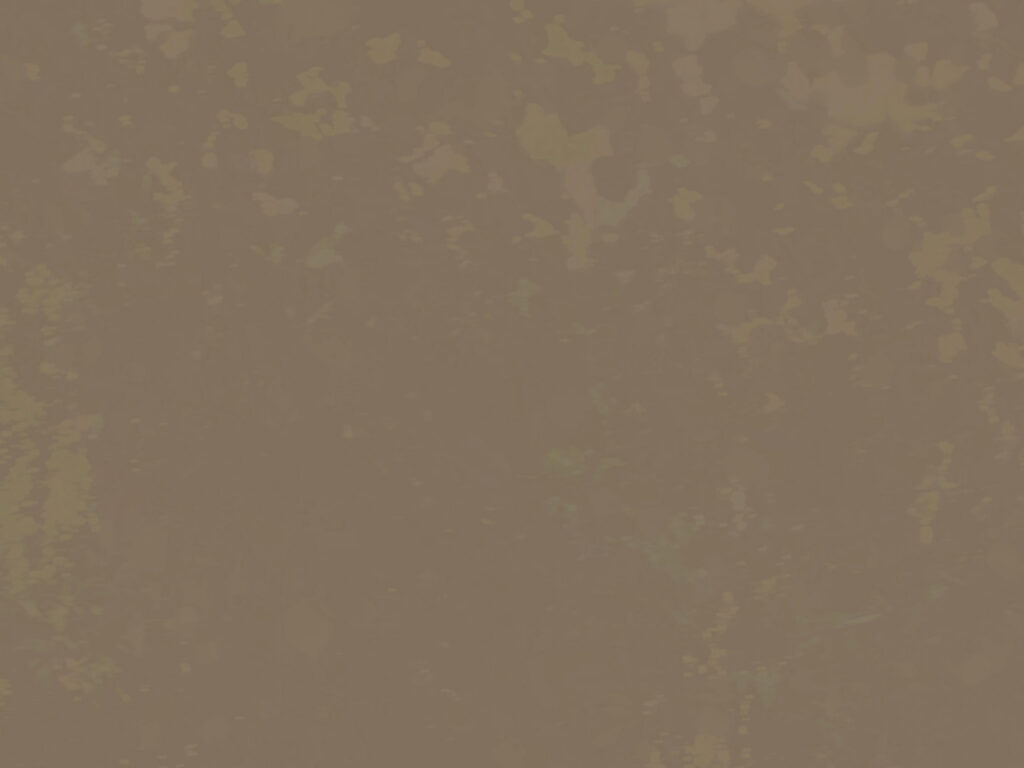
Every kind of life is haunted by vegetal death. Receiving nourishment from animal or plant flesh, we metabolize the rot that fed plants that fed animals… in a shorter or longer chain of ghostly transformations. It is due to this excess, something over and above (or below) life in vegetal life, that plants spook us and are represented as zombie-like in horror films and fiction. Animals and humans likewise contain such an excess, but its hiddenness from sight means that they come back to disturb the living after their death. The underside of life is merely more accentuated, its demarcations starker, in the case of plants.
Seeds are tiny specters waiting on the sidelines of time to make their comeback. Dried or deep-frozen, they may delay the renaissance of the plant they issued from by hundreds of years.Between their release from the mother plant’s pod or cone and the instant of their germination that may never arrive, they linger in the grey area of living death. From there, they haunt the possibilities of survival, capable of overturning the historical verdict, according to which their species becomes extinct. Seed banks are the communities of ghosts, rather than the sites for accumulating natural capital condensed in vegetal DNA.
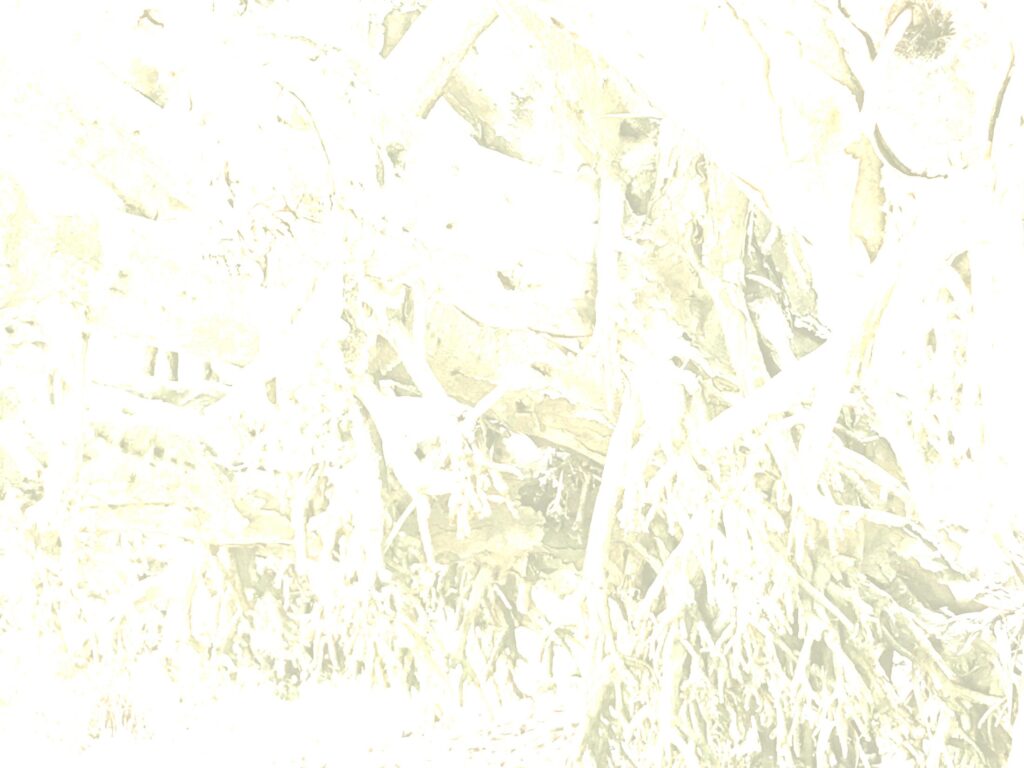
If, as Derrida was fond of saying, a ghost is a host, who not only revisits a house but opens it up for habitation, then vegetal ghosts are the perfect hosts. Providing the atmospheric and nutritional conditions for human and animal vitality, they welcome life and hold the keys to the biosphere. Theirs, moreover, is a hospitality without interiority, a subjectivity without an inner self withdrawn from the world. And the dwelling they haunt, the ecology they dream up with their lives or deaths, is equally exterior, extraverted, stitched of uneven and disjunctive surfaces they gather together: rivers and mountains, fungi and bacteria, birds, butterflies, and bees, you and me.We are not the hostages of our vegetal hosts or ghosts: instead of holding us inside a haunted house, they keep us in an adjacent garden without walls (a garden without guarding), the one we are actively changing into a barren, world-encompassing desert. This garden is the oikos of ecology, the house, from which humanity has been trying to escape from millennia by fabricating a closed dwelling for itself.
The very air we inhale is the expiration of plants, their after-breath. The exteriority of the atmosphere entering the lungs is the vegetal specter in us. Given that, from Athens to Jerusalem, the ancients deemed the soul pneumatic, made of or related to air, this physiological fact is not trifling. The breath of life in Stoicism and in the Book of Genesis is a conduit from a corporeal to a spiritual reality, with vegetal, oxygen-generating respiration for a vanishing mediator, a bridge suspended between these shores of being.
“OK,” you might say. “But animals and humans do not die—and, therefore, do not live—the way plants do. Unlike them, we pass away (a euphemism that already envisions the return of a specter) in one piece, now alive and dead the next moment. Does this basic difference not proscribe all speculations on the vegetal core of spectrality as such?”
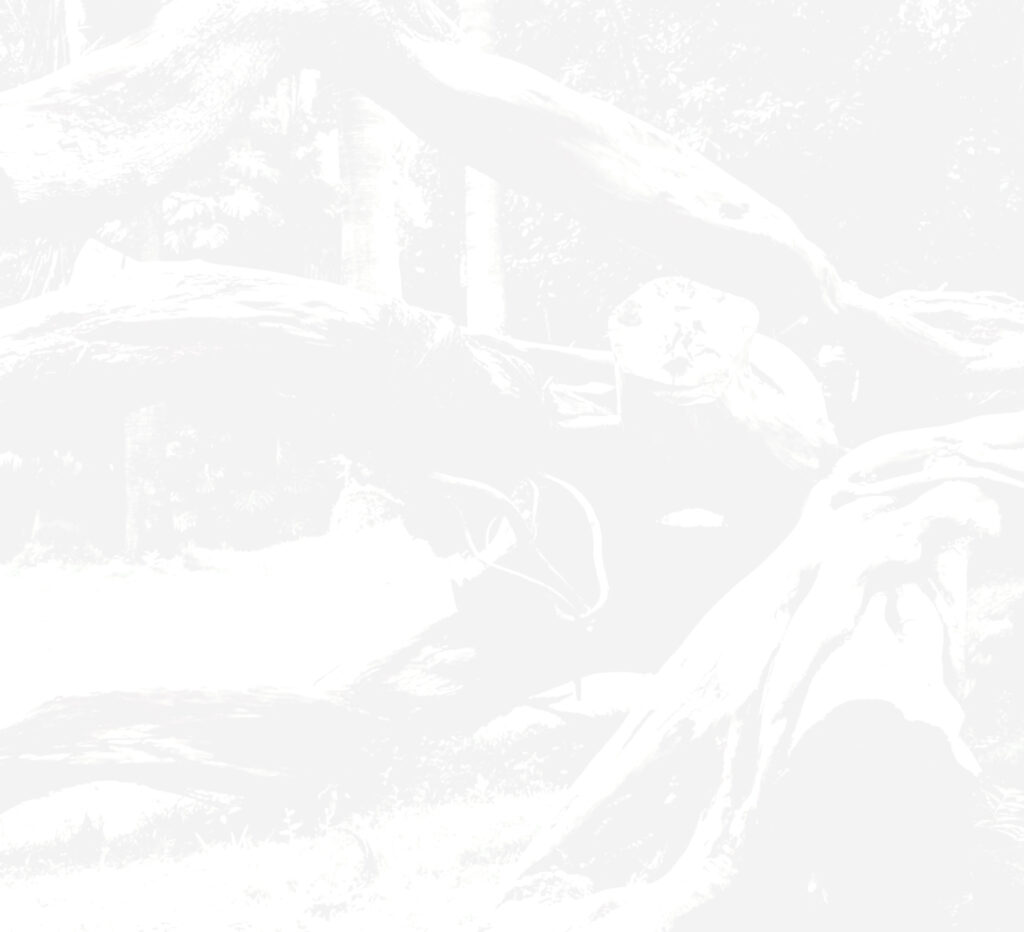
What the obvious rejoinder forgets is that behind the monolithic narrative construction of human and animal deaths, we share a much more fragmentary style of finite existence with plants. Our cells and tissues continually renewed, we die and survive bit by bit. The skin, the body’s largest organ, is akin to a tree trunk: a dead layer of keratinized squames on the outside, actively dividing basal cells on the inside; hard bark facing out, pith responsible for new growth tucked in. The growth of fingernails and hair has been traditionally seen as a reminder of potentially limitless vegetal proliferation in human anatomy and physiology. The objective traces of our activities—some as beautiful as a painting or a sculpture, others as monstrous as carbon emissions—are also parts of our piecemeal survival, lingering on well after our physical deaths.
And that is the elephant, or the giant sequoia, in the room: the carbon footprint. Exactly whose footprint is it? Who leaves it with what, or with whom? Burning fossil fuels, we conjure the ghosts of long-dead plants and prompt them to upend the breathing of those living today, while choking animal and human existences.The combustion of natural gas, oil, or coal sets plants against plants. As the atmosphere fills with greenhouse gasses, a spectral struggle ensues between the respiration that gives the gift of air and the exhausts that take it away. Before pneumatomachy can signify the denial of the Holy Spirit’s divinity, it names a battle over breath, for or against the possibility of breathing, the battle wherein humanity takes the side of breathlessness, aggravated by a drastic deforestation of the planet. In a crowning moment of Western metaphysics, the breath of spirit that momentarily resurrects dead vegetal and animal matter only to throw it onto the pyre of energy production leads directly to physical suffocation. The vegetal specter in our lungs is double: a specter and the specter of this specter, oxygen and carbon emissions, a past suffused with futurity and a futureless past.
Re-Membering
the Self
There are parts of oneself that are unseen, left behind and forgotten. They come out at night, calling for one’s attention in dreams. If one responds to the call, one can re-member oneself and redirect the newly gained energy to a new place within and without. If one keeps neglecting the call, it becomes a nightmare, haunting oneself in dreaming and waking realities.
This one-hour meeting will work with participants’ night dreams to communally address, hear and respond to the needs of the forgotten parts of the self. It will provide basic tools for sensing, feeling and understanding one’s own dreams and re-turning to them as to a source of infinite, abundant, embodied knowledge.
For the participants: Bring into the session a recent dream.
A Gathering
of Ghosts
We live in a haunted world. Our present is imbued with ghosts speaking from both past and future. They are a paradox, an absence, human and other-than-human, that is nevertheless eerily present and influential. They might point out that something is missing, something is wrong. Ghosts show us that time is not linear, but entangled, thick and layered.
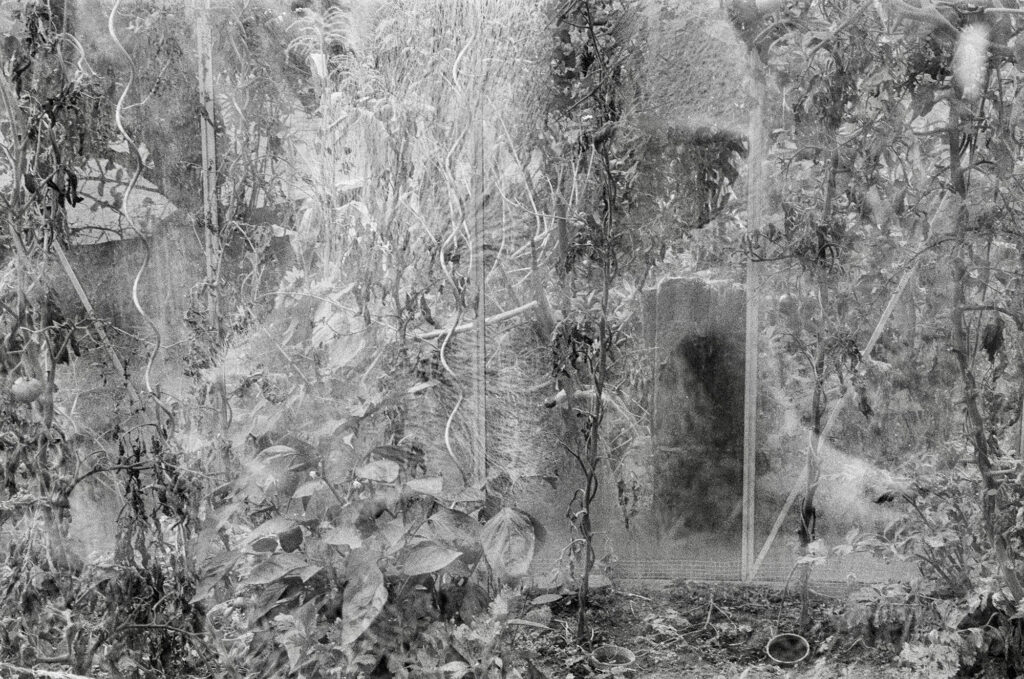
Ghosts open up a potential for other stories of the now, the past and the future. They might provoke in us the desire and tools for living otherwise. Recognizing ourselves as haunted and haunting, makes our understanding of the present, and ourselves in it, permeable. By inhabiting this ghostliness we may recognize a different proximity to each other and what surrounds us.
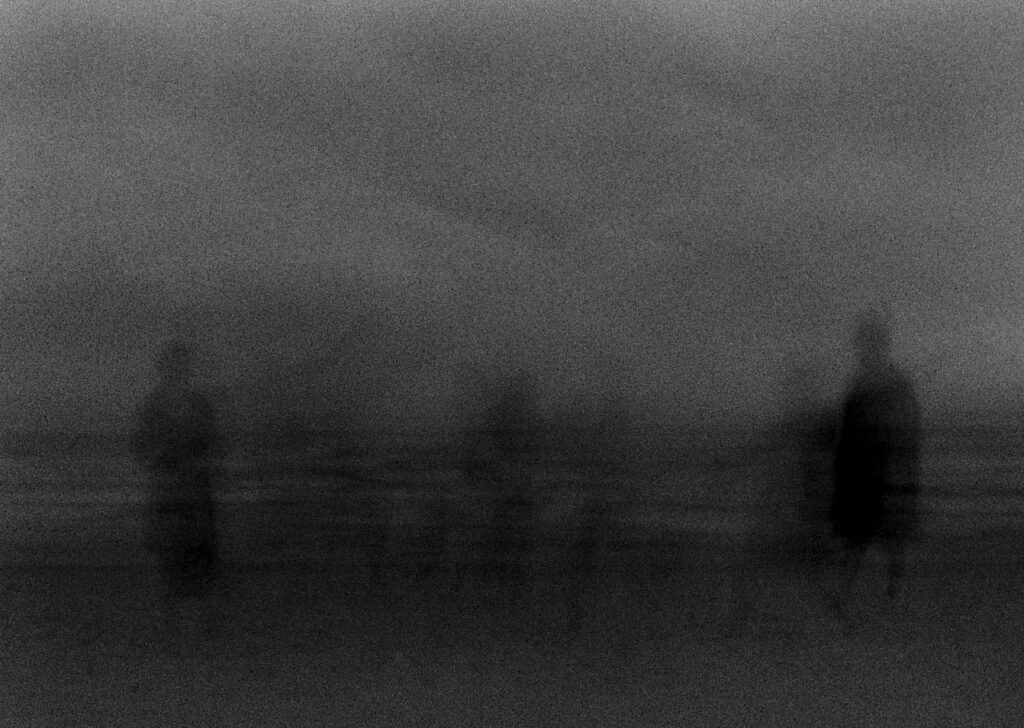
In the past two weeks eight artists have gathered spectrally, together with a ghostly partner, on invitation of WP Zimmer, a workspace for artistic development in Antwerp. Ingrid Vranken (FoAM Zenne) will invite us into a spectral ‘studio visit’, opening up the investigation into ghosts and the haunted corners of our worlds.
CoFestival
The Amplifiers of Voice
The Grand Re Union team invites all the colleagues, friends and from partners to join CoFestival program, that this year will happen partly online (in November) and live (in April in Ljubljana). Below you will find more information on the online program, which thematic scope, The Amplifiers of Voice, resonates strongly with the November magazine issue, focused on Ghosts.
CoFestival: The Amplifiers of Voice
Due to the actual circumstances of Covid-19 pandemic, the regulatory measures that different EU states took and disciplinary cautions we have been faced with in the months from the beginning of 2020, the CoFestival co-curatorial team decided to take into account a human voice (a medium of subject) that seemed to erode in the contemporary dance to much greater extent than almost in any other contemporary artistic practice. Much less protected than traditional artistic practices and disciplines, it seemed to be vanished from the public (cultural) sphere to a critical extent.
Once the body is publicly regulated and physical contact limited to zero, dance doesn’t loose only its primary source, an instrument, a medium of expression, action or movement but in the context of an artistic labor also the working territory and therefore its political voice. In the given circumstances the latter could be considered as recognized only, once it is counter-balanced by the systemic measures of the cultural and social policies: considered and included in the measures taken by them in order to reduce the negative consequences of the deficit of dance labor.
CoFestival team would like to thank the team of Grand Re Union, for the exchange of program and for creating bridges in the impossible times.
More information
Atelier – in collaboration with the European Dancehouse Network
Moderated and led by: Irena Tomažin-Zagoričnik, Jasmina Založnik and Rok Vevar, members of the co-curatorial team of Cofestival 2020.
Therefore we decided to introduce the topic of a voice in contemporary dance as our common case study, problem, topic and question in another edition of EDN Atelier. The two days programme combines theory and practice, historical and contemporary examples and offers lectures, workshops and debates on the proposed topic. The EDN Atelier is recommended for dramaturges, artistic directors, programmers, curators and producers.
Registrations for the Atelier
Friday, November 20th, 2020
Slot 1: 10:00 a.m – 1:00 p.m CET
Slot 2: 2:00 p.m – 3:30 p.m CET
10:00 a.m – 11:15 a.m CET
Irena Z. Tomažin, Rok Vevar: A Mapping of Voice in Contemporary Dance, lecture
11:30 a.m – 12:30 p.m CET
Luka T. Zagoričnik: A Counter-Voicing in the Avant-garde and Experimental Music (selected cases), lecture
We will try to speak through multitudes of voices and utterances of different voices in different strategies in experimental and avant-garde musical traditions, pop music, performance art, sound art, sound poetry and multimedia art: Voice in relation to sound, noise, silence, space, resonance, immersive experiences, subjectivity, body, image and gender roles.
12:30 p.m – 1:00 p.m CET
Questions and Debater with Luka T. Zagoričnik, Irena Z. Tomažin, Rok Vevar
2:00 p.m – 3:30 p.m CET
Voice, Body and Dance: A Selection of the Examples (selection made by curators); optional
Saturday, November 21st 2020
Slot 1: 10:00 a.m – 2:00 p.m CET
10:00 a.m – 10:30 a.m CET
Questions from Previous Day moderated by Irena Z. Tomažin, Rok Vevar
10:30 a.m – 12:00 p.m CET
Jule Flierl: Choreo-Voicing, practical workshop
Is the voice a part of the body, or does it become its own player as soon as it becomes audible and detaches from the body? In this short Workshop we will look into the ways how movement and voice support and contradict each other. We will explore how voicing is a movement and what dance practice can offer as an inspiration for the larynx and vocal apparatus.
12:15 p.m – 1:45 p.m CET
Igor Dobričić: Dramaturgy and Approaches to Voice in Contemporary Dance, lecture/workshop
As a dramaturg or a teacher Igor Dobričić has been at various occasions involved in devising the choreo-voicing practices and works. Recently he collaborated with his former student at SNDO Amsterdam and an internationally acclaimed choreographer Alma Söderberg on the piece The Listeners for The Cullberg. In his Atelier session, Dobričić is going to share with us some of his invaluable experiences in working with the voice and body.
1:45 p.m – 2:00 p.m CET
Wrap-Up by Irena Z. Tomažin, Rok Vevar
Video discussion about Anna Halprin by Vala T. Foltyn | Valentine Tanz and Rok Vevar
Monday, November 23th, 2020
8:00 p.m CET
As the introduction into the film on life and work of the American icon of postmodern dance, Anna Halprin, A Breath Made Visible, Vala T. Foltyn and Rok Vevar will discuss about regular visits of Vala to Anna Halprin, about their long-term relation and Halprin’s pedagogical and artistic work.
The link to the discussion
The event is free of charge.
Anna Halprin, A Breath Made Visible by Ruedi Gerber, movie (2007)
Monday, November 23th, 2020
9:00 p.m CET
An excellent documentary, entitled Breath Made Visible (2007) about the life and work of Anna Halprin, an American choreographer and dancer who celebrated her 100th birthday this year and who, like Valeska Gert, has only managed to establish a suitable historical recognition in recent years. Having spent the most part of her life in the dance community of San Francisco, she was very well known exclusively to the artists themselves, especially those who resorted to her for dance skills, but less familiar to a wider audience. Over the past two decades, that has changed. For our regional context, it is particularly important to note that in 1963 her ensemble performed in Zagreb at the Music Biennial with her neo-avant-garde dance work, and it was exactly this performance that led Zagreb artist Tom Gotovac to the decision to dedicate himself to performance in his life.
The access to the tickets
When the show’s about to start, the link to join will appear on your ticket, or you can access the stream link that we’ll email you on the day.
The streaming will be available for 45 minutes more after the show finishes.
Statement
Re-write
October
In the midst of this shifting and falling (and failing), it is very exciting to handle (meaning: an instrument for effecting purpose) a proposal for playing.
Somehow convinced that in order to transit or cross paths it is essential to un/de-mark (dissociate) oneself, as a self-proclamation practice (as reclaiming a territory), and so, I play:
Co-elaborate: not actually a mere taking part, as a puzzle piece for the part-taking, an abstract adjacent entity but rather being (as a co-existence) an integrated part of something, a constant continuous becoming (coming to being), indeed an elaboration.
In that same sense, being with space: becoming space is also an act of resistance; you see, it’s that co particle that persists on those pulls and pushes.
Re-sist: re-exist: becoming present at all times through the intentional and purpose-ful act of existence, as a forceful decision to exist. The self-proclaimed “I” enables; craves movement and opens up to Desire as a transdisciplinary, intergenerational,… Inter-gener>rational.
Co/Trans/Inter/Multi… What’s the added value of these particles to meaning?, what is it they are pushing, pulling, centering? Can we push, pull, center some more, or maybe just not at all and remain frozenly impavid?
(Note to self: play with the structure, even up to the point of no meaning).
Alternative: other ways, shapes and forms of being native, or potential to exponentially becoming from or for. Shaping the sense of belonging, maybe in a somewhat longing flare of part-take.
When being(us) is in a constant coming> to> being, a potential not jet consumed there could be a possibility for not having the capacity of defining what it is actually to be a human as a whole and concrete entity. Un/De-mark of the self. A proclamation for an existence as a political practice in constant becoming, could be found by exercising the simplest tasks,… Therefore the notion of Alternate, would really like to be engaged with the term of alternating current, simple as that.
Again a particle, the co particle: Co/mapping. Trans-misting. Alternative trans-mitting/meeting and the idea of value to disrupt. Existing in a constant movement of Becoming, opens up a possibility of a none product lead practice. Could this idea even be considered and confronted at the same time?
Togetherness: (to gather ness, to gather the nous) as frameworks for one another, co-elaboration of (not for, as the for could imply other types of emotions and product lead) existence.
We have most things in common, so just fall.
In-sist(sit): a practice of just sitting inside, come and sit as a practice as an opportunity, as a coming together, as friction. Or In-sight (just because). There is a place for Desire in practice, a subtlety of space perception, as a de-marc-ation (pull the limit to nation/notion). Don’t account tenderness-radically display, become.
Ground desire, ground the unknown, cultivate state of awareness and interaction through uncertainty. Don’t adapt or even respond, no need, maybe extend (stretch). Let’s co-elaborate, move Desire or sit inside? Let’s become as a possibility of “being on the come/coming to being” never yet arriving.This text, rather these words thank you for baring with this disrupted flow, terms that sometimes are even made up or forced to co-exist. Bold letters and other shapes used appreciate your welcoming them in this, to some extent, rumbled threaded rewrite.
Grand re Union Statement
see all versions
The Reading
Station
Agnès Benoit from „books on the move” and Peter Pleyer invite you to a reading and listening room. In the first part they will present and read from books that are meaningful to them, from the past and the present – for the future. In the second part you are invited to share with the group a reading from a book or a magazine of your choice.
Sci Fi Anatomy
This workshop focuses on creating a dialogue between the matter of the body and the sea of our thoughts and imagination. Through mouvement,sounds and words. Working with casual epicness, craftsmanship of the body and magic.
A guided somatic trip where the content slides from anatomical references onto the slippery slope of science fiction with no holding back. We use bodywork and storytelling as tools to inspect our narratives of touch (what we touch, how we touch) and ways of imagining the body and physical sensations. Contradiction, otherness and diversity can cohabit and our realities can melt, shape, reshape and melt again. If reality is a fiction, can we make our fictions a reality?
PREP:
Make the space cosy (Blanket and warm clothes) and make sure you can move around a bit (2-4 m2 is enough) more is also good! –
Notebook or some paper and pens (different colors and textures is great)

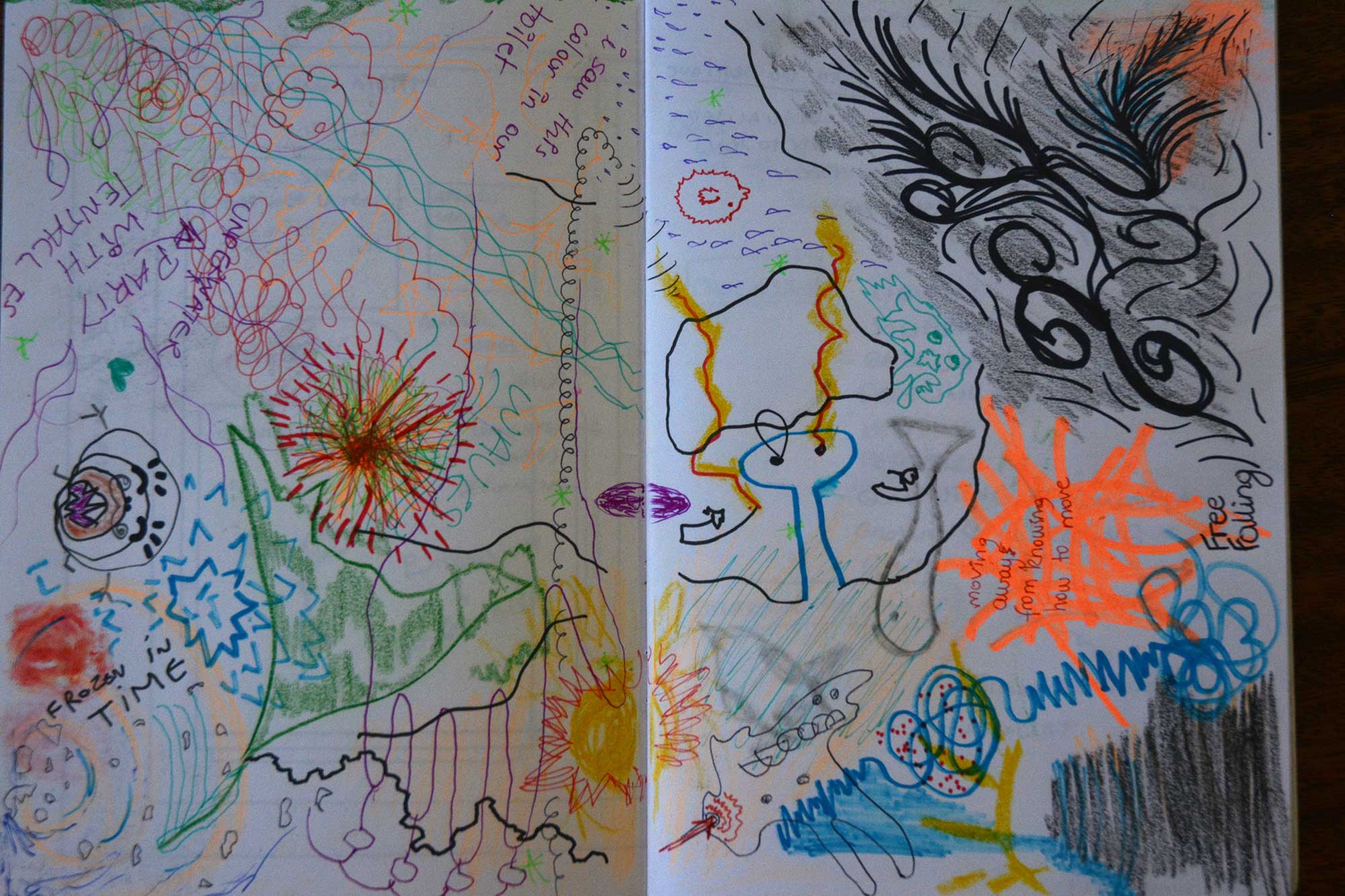
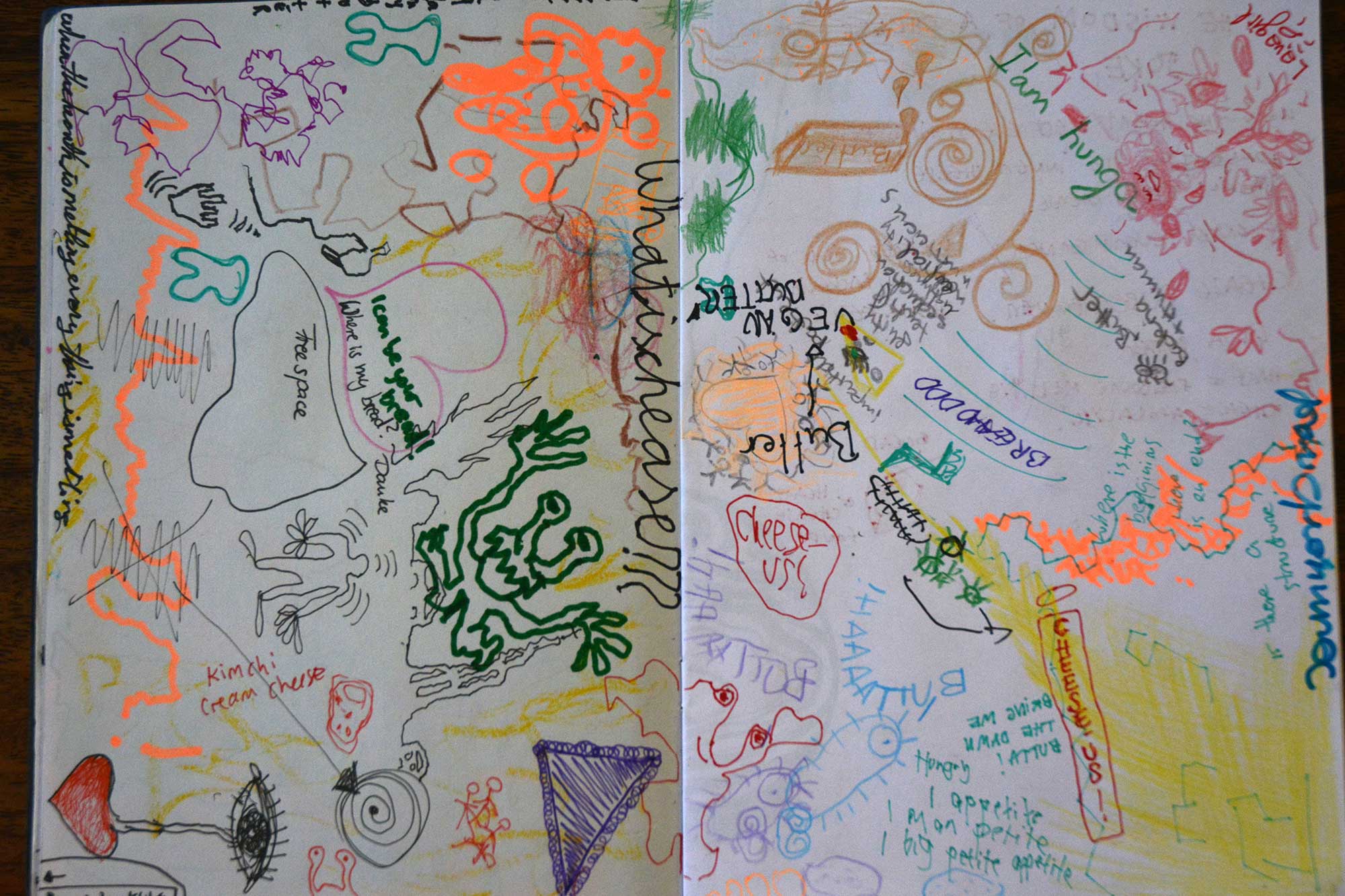
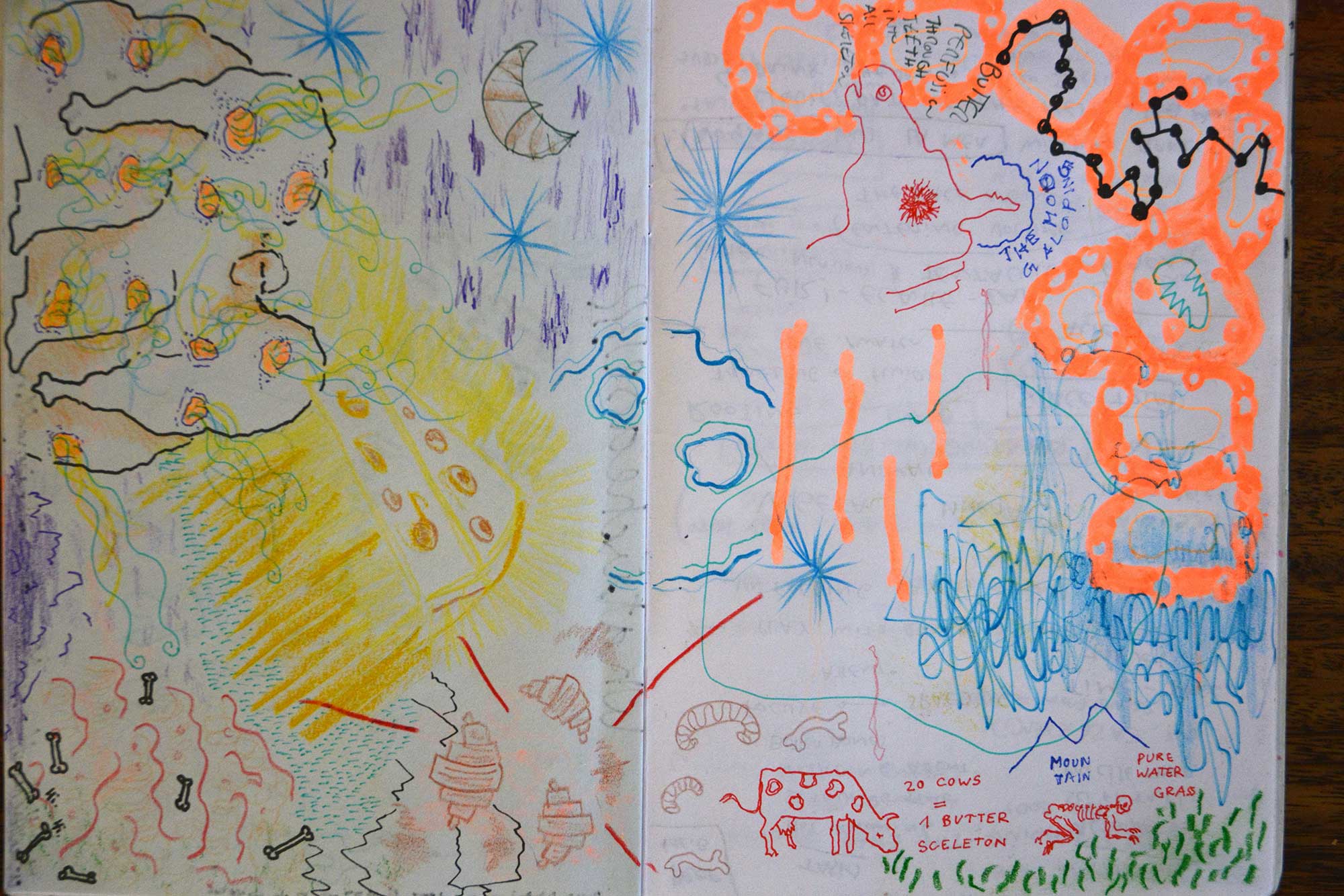
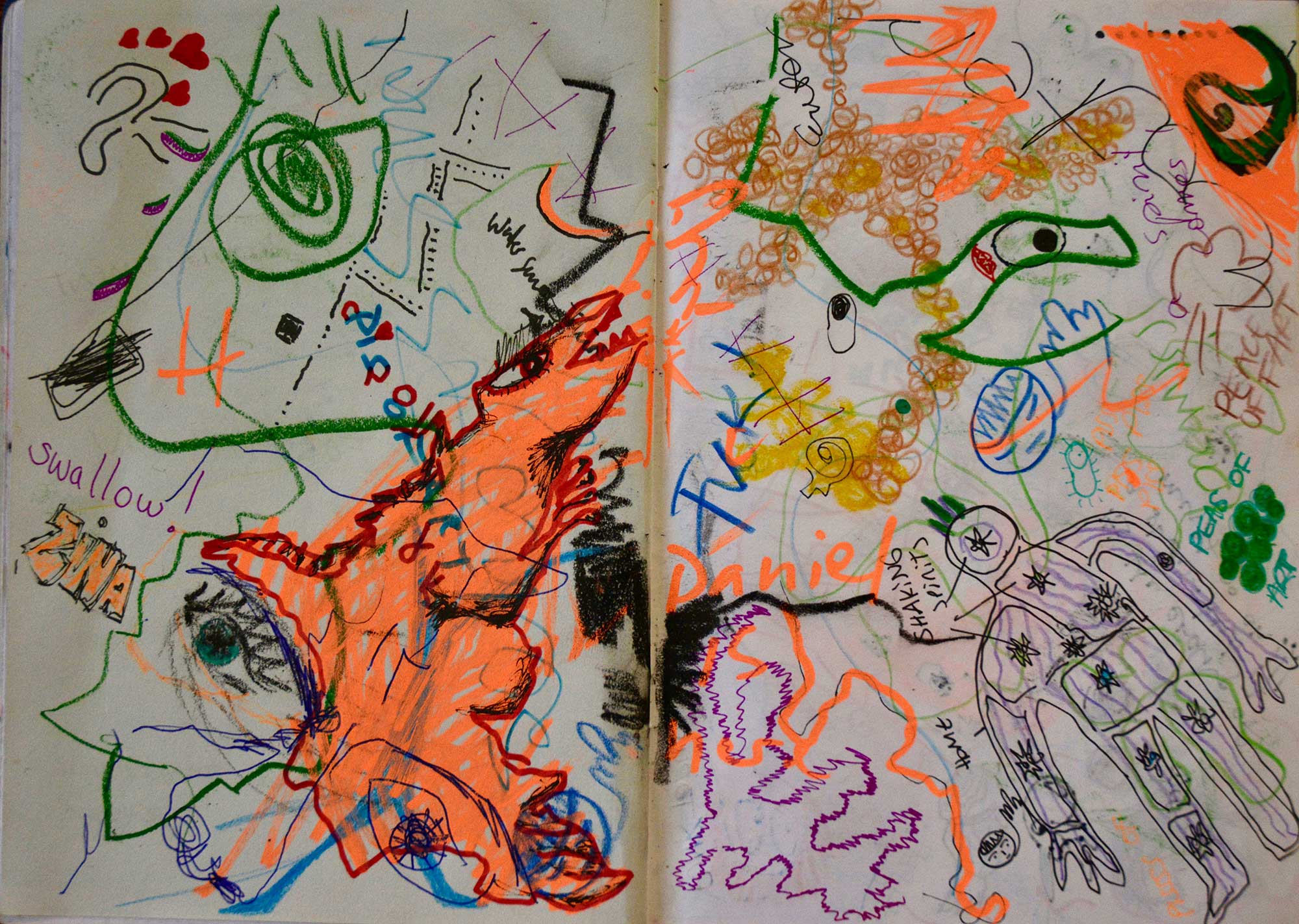
Trio Talk Rhizome
#3/6
Marina-Dragana-Anna
Trio Talk Rhizome
#3/5
Nina-Hadar-Ola
Trio Talk Rhizome
#3/4
Anna-Fredrika-Marcia
Trio Talk Rhizome
#3/3
Kevin-Nana-Geoffrey
Trio Talk Rhizome
#3/2
mayfield-Jumatatu-Randy
Trio Talk Rhizome
#3/1
Roshana-Jennifer-Mariana
Trio Talk Rhizome
#2/3
Karen-Anna-Kevin
Trio Talk Rhizome
#2/2
Eszter-Nina-Marine
Trio Talk Rhizome
#2/1
Eva-mayfield-Roshana
Trio Talk Rhizome
#1
Eva-Eszter-Karen
Letter from
Quarto
We are in a place of uncertainty.
In between or before or after. Not now. Now, more than never.
Living the lack of life before the pandemic, absence of meetings with inspiring people, that we hug with our chest. Those that make our world, and with their absence life becomes lonely, desert like & dry. However, it has been already a while we have been questioning the sustainability of this previous style of life. But now?
Now we trying to fix it.
We are a generation that did not take the world so seriously.
We should have changed the course before. We should have been more aware.
We have messed something up. The 20th century governed by white men feared new ideas.
The complexities of 21st century demand new and good ideas from all of us, ideas that will set the new paradigms.
The generation that was born in the 90ies and year 2000 has found this messed up, devastated world.
And this same generation is trying to do things that will make a difference, Greta Thumber is an example of that.
We need a different rebellious way of thinking
We need to be rebellious.
We need an innovative way of thinking.
We need a whole new range of possibilities.
We need a divergence.
We need a way of thinking that includes others.
Last century skills are not valid anymore in the 21st century.
This new world needs a new vision, but we are still insisting in maintaining the old ways.
‘NOS’ in Portuguese means ‘knots’, but ‘Nos’ also means ‘We/Us’
Would we be ‘knots’ or ‘us ‘of this world?
One thing seems certain to me, the world has changed and we need to untangle ourselves, unravel ourselves, undo ourselves.
We are in transition, in the place in between
We are in retrograde, but at the same time we are in urgent need of important change.
Looking into the eye of the hurricane.
For use that make a living from imagination and subjectivity this is surely not an easy time, it hasn’t been easy earlier either.
The neoliberalism usurps everything, and has also usurped our so esteemed imagination.
It wants us to believe that we need to sell our merchandise as ready and packaged goods and that the law of the market is like this, without any other possibility or alternative. The ultra neoliberalism is violently taking possession of everything we have.
We are thinking from a personal perspective, but also from a shared perspective at the same time.
We have been in a long quarantine for 5 months.
The quarantine as a political and religious division. The ‘Bolsonarism’ has hit us hard, how could we have avoided it? Many of our friends have been crushed by the ‘Bolsonarism’, and there is much more to come. We need to act. This dissent of opinion needs to clean up everything, needs to be violent, it needs to be, otherwise it will not work. It needs to appear with the same strength as the object that imposes this division.
For all of us that live a radical life, that we work together, live together, raise children together, work on projects together, work in the same office together etc the quarantine wouldn’t been so challenging if it didn’t become an object of a political dissent.
But it also has been time of looking after each other, caring in the family, it has been and still is a time of affection.
It has been time of yoga, meditation, reading, writing, music, of hugging and gratitude for everything.
And not only due to the co-living in an apartment.
It could have been another experience from a horny, adventurous, overwhelming perspective of life that we share.
But the worse politician of the quarantine has been a funeral shout against the irresponsible government that until this day has neglected 136,000 lives.
The future seems uncertain to us.
We live a live between two continents, we have done it for over 17 years.
We live the utopias from this place, between
Those places that we inhabit, today, become places filled by political disasters, a succession of political and humanitarian disasters.
How to counter this? How to resist against neoliberal desires, denialists and far-right fascists? How to exist, share and collaborate? How does this potential space of interconnectivity, of resistance, sharing and collaboration look like?
We still do not know, eventhou that we are here, but we do know that our place needs to be defended. The culture of sharing needs to be defended, the culture of We/Us needs to be defended and soon.
Which are the abilities that we need in order to tackle the current issues and those that are yet to come?
Will are be able to save the world? I believe so. I also believe that in the times of suspense such as these, every kindness is a toast to life.
Jim Jarmusch, wrote, nihilistically:
Nothing is original. Steal from anywhere that resonates with inspiration or fuels your imagination. Devour old films, new films, music, books, paintings, photographs, poems, dreams, random conversations, architecture, bridges, street signs, trees, clouds, bodies of water, light and shadows. Select only things to steal from that speak directly to your soul. If you do this, your work (and theft) will be authentic. Authenticity is invaluable; originality is non-existent. And don’t bother concealing your thievery – celebrate it if you feel like it. In any case, always remember what Jean-Luc Godard said: “It’s not where you take things from – it’s where you take them to.
Portugese
Nós estamos no lugar das incertezas.
Entre o antes e o depois. No agora. Agora, mais do que nunca.
Vivendo a abstinência da vida antes pandemia, abstinência dos encontros com gente inspiradora que abraçamos em direção ao peito. Gente que o nosso campo abarca e que na ausência a vida se torna mais solitária, desértica, árida. Porém, já faz algum tempo que questionamos a sustentabilidade dessa vida do antes. Mas e agora?
Agora estamos tentando concertar.
A gente é de uma geração que não levou o mundo tão a sério.
A gente precisava ter mudado a direção, antes. A gente deveria ter estado mais atentos, antes.
A gente fodeu muita coisa. O século 20 dos homens brancos tinha pavor das novas ideias.
As complexidades do século 21 exigem de todos nós boas e novas ideias, ideias que compreendam os novos paradigmas.
A geração nascida nos anos 90, 2000, pegou esse mundo fodido, arrasado.
E essa mesma geração está tentando fazer coisas que façam alguma diferença, Greta Thumber é exemplo disso.
Precisamos de um pensamento dissidente
Precisamos de rebeldia.
Precisamos de pensamento inventivo.
Precisamos de novas possibilidades, em todos os sentidos.
Precisamos de divergência.
Precisamos de um modo de pensar inclusivo.
As habilidades do século passado já não funcionam pro século 21.
Esse novo mundo precisa de visões novas, todavia, estamos sempre fazendo o possível para mantermos as velhas certezas.
NÓS (Knots) em português, também significa Nós (WE/US)
Seríamos NÓS os nós do mundo?
Uma coisa me parece certa, o mundo mudou e precisamos nos desenredar, nos desemaranhar, nos desfazer.
Estamos na transição, no lugar entre.
Estamos no retrocesso, ao mesmo tempo em que estamos também diante da potência da mudança urgente, necessária.
Olhando no olho do furacão.
Pra gente que vive da imaginação e da subjetividade esse não é um momento fácil, já não estava sendo.
O neoliberalismo usurpa tudo, e também usurpou a nossa tão estimada imaginação.
Quer de todo modo nos fazer acreditar que devemos vender nossas mercadorias como produtos prontos e embalados e que a lei de mercado é assim, sem nenhuma outra possibilidade ou alternativa. O ultra neoliberalismo apodera-se violentamente de tudo que nos pertence.
Estamos pensando de um lugar pessoal e, ao mesmo tempo, também compartilhado.
Passamos por uma quarentena longa, de cinco meses.
Quarentena como cisão político-religiosa, o Bolsonarismo nos atingiu com força, como não atingiria? Muitos dos nossos amigos foram esmagados pelo Bolsonarismo, e há muito ainda por vir. É necessário reagir. Essa dissidência de opinião deve varrer tudo, deve ser violenta, precisa ser, do contrário, não é nada. Ela deve estar na medida exata e surgir com a mesma força que o objeto que provoca essa cisão.
Pra gente, que vive uma vida radical, que trabalha junto, vive junto, cria filho junto, escreve projeto junto, entra em estúdio junto, viaja junto etc., a quarentena não teria sido tão desafiadora se não fosse isso ter se tornado um lugar de dissidência política.
Mas foi também um lugar de cuidados com o outro, com os nossos, foi também, e está sendo, o lugar do afeto.
Foi também o lugar da Yoga, da meditação, da leitura, da escrita, da música, dos abraços e da gratidão por tudo.
E não menos por essa convivência dentro de um apartamento.
Poderia ter sido mais uma perspectiva desse lugar tesão, aventura, avassalador, potente, que é a vida compartilhada que vivemos.
Mas o teor político da quarentena foi um grito fúnebre contra um governo irresponsável que até o exato momento negligenciou 136.000,00 vidas.
O futuro nos parece incerto.
Vivemos uma vida entre dois continentes, fazemos isso há 17 anos.
Vivemos com as utopias desse lugar, entre.
Esses lugares que habitamos, hoje, tornaram-se lugares povoados por catástrofes políticas, uma sucessão de catástrofes políticas e humanitárias.
Como contrapor isso? Como resistir na contramão dos desejos neoliberais, negacionistas, fascistas de extrema direita? Como reexistir, compartilhar, colaborar? Como parece esse potencial lugar de interconectividade, de resistência, compartilhamento, colaboração?
Ainda não sabemos, apesar de estarmos aqui, mas sabemos sim que esse lugar precisa ser defendido. A cultura do compartilhamento precisa ser defendida, a cultura do We/Us precisa ser defendida, e ponto.
Quais são as habilidades que necessitaremos para lidar com os problemas atuais e os futuros?
Será que a arte poderá salvar o mundo? Eu acredito. E acredito também que em tempos de suspensão como esses cada delicadeza é um brinde a vida.
Jim Jarmusch, escreveu, niilistamente:
Nothing is original. Steal from anywhere that resonates with inspiration or fuels your imagination. Devour old films, new films, music, books, paintings, photographs, poems, dreams, random conversations, architecture, bridges, street signs, trees, clouds, bodies of water, light and shadows. Select only things to steal from that speak directly to your soul. If you do this, your work (and theft) will be authentic. Authenticity is invaluable; originality is non-existent. And don’t bother concealing your thievery – celebrate it if you feel like it. In any case, always remember what Jean-Luc Godard said: “It’s not where you take things from – it’s where you take them to.
Letter from
Qondiswa
I’m in a cab in the rain from here to here. The driver has set up a plastic sale mechanism to separate him from the customers, there is this thin opaque sheet between us.
From inside, we’ve been watching things getting back to normal. It has been gradual. Like spring this time. Normally I experience Cape Town in September as a sure and steep incline to summer. This year it is lethargic and heavy, dragging clouds and cold fronts to sputter from gutters into backyards. There is sun only sometimes.
Yes, it continues to be a year.
I was reflecting with friends the other day about the divinity of comedic timing, of a 20Plenty that ends as the fulfilment, finally, of the Mayan predictions re 2012. We’re joking somewhat, but the laughter is cruel truth.
What has happened? What has happened to this place? The oblong earth object, folded flat now to be considered. A global village. Sharing a history and an inevitable prophecy of continuous collision. Conflict. Collapse.
A beginning.
In Wuhan, China in 2019 sometime, at a wet market, a trader contracts a virus from some of the goods on sale. This virus spreads, as viruses do. We can fill in the blanks ourselves. He arrives home that night and his son has prepared a warm fish soup for dinner. It is colder than usual for this time of year, and he worries about his father’s health rubbing scales with the exotic. At this point of course they are unaware that this exotic has come home with the trader on his scales, and today he had thought himself lucky, having sold a bit more than usual. He might have walked home with a skip in his step, feeling stronger than he has in a long time now. His partner, say she’s a nurse, comes home later and warms up the fish stew and brushes her hair sitting at the foot of their shared bed. She climbs into bed next to him and holds him while he coughs and wheezes delicately into the night. The virus slides with the sweat between them and gets inside her body into her bones. The next morning, she goes to work and carries it to the hospital, her son goes to school and carries it into the yard, our trader goes to the supermarket and carries it with him there. We are speaking only in the domestic.
It is tragic, it is comic.
We drive together to the sea, to park at the railing like a cliff. It is sunset. The water is blue-gray metal and shimmering wildly. There is a froth and spray spitting from the ocean’s mouth to us at the shore. Nothing is wet and nothing is warm. People play like vignettes through the windshield. A looking glass. We are talking about friendship. What gets misplaced in the giving. We talk about a desperation for love. Ours, our longing. But also, something else, the vast and complex colour of a love like gunmetal gray in light that shimmers wildly. We talk about violence, and disruption, and rupture. We talk only in the domestic.
What has happened? What has happened to this place? The oblong earth object, folded flat now to be considered. A global village. Sharing a history and an inevitable prophecy of continuous collision. Conflict. Collapse. What has happened here is what has always been happening here.
solidarity always,
Letter from
Zsolt
Hello dear friends in Grand re Union!
A few months have passed since our first meeting in June. I hope this letter finds you in good health both physically and mentally.
Unfortunately it was not possible to meet in person in lovely Poznan and even though it was great and quite exciting to meet online it was just too short to get involved with each other, to start to converse, to share a bit more than what was possible during those few hours and maybe to get to know all of us personally. A few of you I am already very happy to know, but I guess most of you I don’t and you probably don’t know or heard about me either before. Therefore let me say a few words about myself, before I dig a little deeper, let you know what I was occupied with during the last couple of months.
I consider myself a musician playing in first line the saxophone. After I fell in love with the instrument I turned to jazz, a form of musical expression that uses a lot of saxophone as you all may know. Through jazz I discovered quite soon free form of improvisation, which turned into my way for making music. Playing this kind of way I had the opportunity to get involved with dance, an art form I was never interested in, but kept my affection since the first moment. Through dance and creating music with and for dance I received the chance to later pick up other instruments as well, so I started to play electric guitar and different electronics. Dance has also led me onto the field of organisation and artistic management, which I am active at with my artistic partner Márta Ladjánszki. We both have been leading the Budapest based L1 Association, an organisation of and for independent artists mainly from the performing arts field. I joined the NGO for the past 10 years, but have been working with lot of its members already years before.
Let me shortly share with you what I was busy with recently and not so recently – actually since earlier this year.
It has been up until now a very special one in many ways and this is probably something we all share, I guess. Lot of us are situated in countries that faced massive lockdown regulations during Spring. In Hungary this was introduced around middle of March, loosened perhaps early June or so and it is being kind of reintroduced again during these days. I am writing this letter to you from Cologne, Germany, where Marta and myself are working in a new production by the company IPtanz. In approximately 10 days we are planning to travel to Banska Bystrica, Slovakia to play a show by Márta and to lead a workshop around creative processes. For this act we are facing 14 days of quarantine on our arrival back to Hungary, which can be bought off by two pretty expensive PCR tests with obligatory negative results. Yesterday these regulations were softened a bit, so if we manage to document that this travel was out of reason of business or work, we might get the chance to avoid a total lockdown in our home. Total means in this case that you are not even aloud to go on the streets to shop food, you have to appoint someone for this task or have to have food delivered to your flat by people leading a business around it.
Just before coming to Cologne we managed to reach within a few weeks of research a satisfying point to Márta’s new creation entitled UMARMUNG, which will be the newest part of the ‘Series of Dance Performances with and for Naked Audience’ to be premiered Spring 2021. Plus we organised the main annual event of our association the so called L1danceFest, a nonprofit festival event showing international and some Hungarian (mainly L1 members’ and resident artists’) performative works concentrating mainly on the body. Since theaters are not open at this very moment in Hungary yet and since international travel is very difficult to arrange (some countries borders are locked down, no grants or subsidies are available for travel), we decided this year to go online. As a test format beginning of June we filmed and broadcasted through Facebook and YouTube another event, namely this years edition of L1 evenings. At that time we found out that even though we believe in personal, face to face meetings with our audiences, in times of need internet technology can be pretty useful for temporary solutions. I personally felt at that time that I never want to do an online event ever again, but this year’s way of organising a festival consisting of a series of shows and actions felt surprisingly satisfying, easy and smooth, and looking back on that early Summer event I feel quite happy about that one too. Right now I am not completely clear why I feel relieved about this years’ festival, but I for sure know that I feel very excited about playing a show during the day when it is not dark outside yet and I have to admit that the absence of an audience is not necessarily a bad thing either. Perhaps it brings me back that sweet spot in the studio when you are just right before the state of being able to present your work, the one right before you feel its done or it has to be pushed out finally, to that very last precious moment of transition and anticipation of what is going to come but hasn’t happened yet. Don’t know…
Speaking about performing during daytime, I realised that I always loved rehearsing before noon. Up until today the late morning hours are my favourite time of practicing my instrument, too. This is also what I was doing during the weeks of lockdown. Since all shows, concerts, travels got canceled I lost basically all work. Of course there is always a lot to administrate (voluntary based) if you have to deal with the affairs of an organisation, but since there wasn’t really no activity possible at all I gained a lot of time for the saxophone – something that I have been missing for quite a while in recent years. It was a pleasure to be able to play the instrument each day as long as I wanted to, or the neighbours were appreciating it. As of recently work started to pop up again the time for this important practice or ritual has started to shrink, but I hope I will manage to get back to those amazing hours somehow soon.
Finally I could be writing to you perhaps about Sars-Cov2, what I think and feel about what has been happening closely around it. I have experienced connected to it so much anxiety, anger, fear and panic, that I find it difficult to keep a clear head and not to get too emotional talking about it. For this reason I rather choose to skip it in this letter. I also think it probably would need another one dedicated only to these things and I am afraid I still wouldn’t be able to go as deep as wanted too. And my English is simply just not good enough for that and I have the feeling we are unfortunately not at the end of the tunnel yet, so I ask you to excuse me this time. What I hope for though is, that from here our societies won’t turn to total surveillance and control.
Another topic I would like to avoid is all those political events that shook us and are still shaking us at this moment around the globe, except one thing that is happening in my place: At this moment around 200 students of the Theater Academy in Budapest have occupied its main building protesting against the attempt of the regime to expand its control over another part of society. This resistance could be the beginning of positive changes in Hungary, but we yet have to see as we say.
Dear people! My letter is coming slowly to its ending. I am pretty sure that I forgot to write about quite a few things that might be of interest or importance to you. Let me know what has been on your minds during recent times. Hope to receive a few lines from you, but do not hope to meet you in person soon.
Wish you great days!
Your friend
Letter from
Yuliya
Past
I am sitting in my apartment in Warsaw and reading the news. The court sentenced to 10 days of arrest the sound engineers who played “Khochu Peremen!”* (“Changes!”) by Viktor Tsoi in Kievsky Park and interrupted the pro-Lukashenko concert with this song. It has already become an anthem for change and resistance in Belarus. I’m watching the video of this event and realize that people lost their fear. There is courage, hope for change and a sense of unity. I am deeply touched by what is happening now in Belarus. I have been living abroad for 10 years and I thought I was no longer emotionally connected with my country. It was the day when I felt a deep connection with my past and my national identity.
Elections
I cannot vote at the embassy. There is a huge line. They let in only one at a time. 3000 people want to vote. The authorities did everything possible to prevent people from casting their votes.
Evening.
News.
I can’t believe my eyes.
Police violence, a huge number of victims, missing persons and also several deaths..
The belarusian government started a war against belarusian people.
The Internet does not work in the country.
Chaos.
I can not sleep.
My body is here, and my mind is there. Separation.
Daily life
The situation in Belarus is insufficiently highlighted in media. The political response of the international community is painfully slow and clearly insufficient. There is genocide, torture, violence in a neighbouring country.. I feel that the only thing I can do in this situation is to write on social media about what is happening, talk with friends, participate in fundraising campaigns and protests. I feel profound solidarity and support. There is no room for indifference.
Women
I admire belarusian women! Women power, women marches. All generations, different social groups. Inclusiveness. All together. I feel a huge surge of energy when I see how the belarusian women sweep away the riot police chains and shout “WE ARE THE POWER HERE !”
My body
All day long I live in the news space. I can’t concentrate. Hope and strength combined with fear and anger. My body walks the streets of Warsaw and senses danger. I look with danger at the police cars. Although there is no real danger (?) (Recent events related to the LGBT+ community in Poland make one think)
Protests
For three days I’m taking part in the protests in Warsaw. A huge amount of energy and strength. We walk from the center of Warsaw to the Belarusian embassy. Being with other people, walking in a crowd, screaming – all this helps the body to transform everything that has accumulated during this time.
In the center of Warsaw, in the quarter of the streets Marszałkowska, Świętokrzyska, Nowy świat i Al.Jerozolimskie people gathered in a chain of solidarity. People in white clothes, with flowers, flags and posters. We decided to go around the quarter on bicycles with a flag, looking people in the eyes and shouting “Жыве Беларусь!” (“Žyvie Bielaruś!”/“Long Live Belarus!”). An incredible exchange of energy, emotions, solidarity and everything that words cannot express.
Future
Three weeks have passed, and the protests are becoming even bigger. Mass marches are going on in Minsk and other cities of Belarus. International attention and solidarity are very important now.
Belarusians began a process of change.
Freedom and solidarity.
Жыве Беларусь!
Long live Belarus!
* Viktor Tsoi “Peremen”
“Changes!
It’s the demand of our hearts.
Changes!
It’s the demand of our eyes.
In our laugher, in our tears, and in the pulse
of our veins.
Changes!
We wait for changes…”
Russian
Прошлое
Я сижу в своей квартире в Варшаве. Читаю новости. Суд приговорил к 10 суткам ареста звукооператоров, включивших “Хочу перемен!”* в Киевском сквере и прервавших провластный концерт. Эта песня уже стала гимном перемен и сопротивления в Беларуси. Я смотрю видео с этого мероприятия и чувствую, что в людях больше нет страха. Есть смелость, надежда перемен и чувство единства. Я глубоко тронута происходящим. Мне казалось, что живя 10 лет в другой стране, я уже не связана эмоционально с Беларусью. Это был день, когда я почувствовала связь со своим прошлым и национальной идентичностью.
Выборы
Я не могу проголосовать в посольстве. Очередь огромная. Впускают по-одному. 3000 человек хотят проголосовать. Власти сделали все возможное, чтобы люди не успели отдать свой голос.
Вечер.
Новости.
Я не могу поверить своим глазам.
Насилие со стороны полиции, огромное количество пострадавших, пропавших, и также несколько погибших..
Власть начала войну со своим народом.
Интернет в стране не работает.
Беспредел.
Я не могу спать.
Моё тело тут, а мысли там. Разделение.
Повседневность
В международных СМИ недостаточно освещается ситуация в Беларуси. Политическая реакция международного сообщества крайне медлительна и явно недостаточна. В соседней стране геноцид, пытки, насилие.. Я чувствую, что единственное, что я могу сделать в этой ситуации – это писать о происходящем в социальных сетях, разговаривать со своими знакомыми и участвовать в сборе средств для пострадавших, ходить на протесты. Я чувствую огромную солидарность и поддержку. Равнодушию нет места.
Женщины
Я восхищаюсь беларусками! Женская сила, женские марши. Все поколения, различные социальные группы. Инклюзивность. Все вместе. Я чувствую огромный всплеск энергии, когда я вижу, как беларуски сметают ОМОН и кричат ” МЫ ЗДЕСЬ ВЛАСТЬ! “
Моё тело.
Целыми днями я живу в новостном пространстве. Я не могу сосредоточиться. Надежда и сила в сочетании со страхом и злостью. Моё тело ходит по улицам Варшавы и чувствует опасность. Я настороженно смотрю на машины полиции. Хотя реальной опасности нет (?) (Последние события, связанные с LGBT+ сообществом в Польше заставляют задуматься.)
Протесты
Три дня я участвую в акциях протеста в Варшаве. Огромное количество энергии и силы. Мы идём из центра Варшавы к посольству Беларуси. Быть с людьми, идти в толпе, скандировать – все это помогает телу трансформировать все, что накопилось за это время.
В центре, в квартале улиц Marszałkowska, Świętokrzyska, Nowy Świat i al.Jerozolimskie собрались люди в цепь солидарности. Люди в белой одежде, с цветами, флагами и плакатами. Мы решили объехать целый квартал на великах с флагом, смотрели людям в глаза и кричали Жыве Беларусь! Невероятный обмен энергией. эмоции, солидарность и все то, чего нельзя описать словами.
Будущее
Прошло три недели, а протесты только усилились. Вчера в Минске и других городах Беларуси проходили массовые марши. Сейчас очень важно международное внимание и солидарность.
Беларуски и Беларусы начали процесс перемен.
Свобода и солидарность.
Жыве Беларусь!
* Виктор Цой “Перемен”
Перемен!
требуют наши сердца.
Перемен!
требуют наши глаза.
В нашем смехе и в наших слезах,
И в пульсации вен
Перемен!
Мы ждем перемен…
Letter from
Shira
Hello dear,
This is a letter from me, Shira, from my home in Jaffa, as I am sitting in front of my computer, in my body.
How do you start to describe what has been happening, here, in my thoughts, in my heart, and in Israel/Palestine?
I would like to initially share that within my quarantine, I dove deeper and deeper into the Hebrew language, hence a lot of information in this letter is lost in translation.
Hebrew is full of inner wisdom. Every word has a root that connects it to other words and concepts, and if you listen to the language, to the letters, it reveals teachings about the reality that we live in. The slowdown was my heart’s wish, on a personal level, in between my humbled soul and body, staying at home and the being in the unknown, helped me open a sacred quiet space and it taught me a lot. It was something I truly longed for. Time to stop, to observe, to stay in. As a person who’s usually attentive and aware to what is happening around me, the quiet that the was created by the lockdown was a blessing, a time to withdraw into myself and my inner world.
Since 2014, I have been running, barely spending time at home, flying a lot, touring, performing, giving workshops, working endlessly… I didn’t have a day off for Shabbat or holidays, I was constantly in motion. I loved it and feel blessed and privileged to be doing what I love. My soul and my art united. Amen. I love you art, mother art, a beautiful, soft mother.
I had a wish to slow down at some point, to be at home more, not to know what would be my next creation. To be truly in between, between processes, so that I can enable a new and different dimension to open within me. Maybe, to be Shira for a moment (Shira in Hebrew also means poetry), and not Shira who serves the art faithfully.
The COVID-19 period started for me with quarantine with my husband. After returning from Ethiopia we spent one and a half months quarantined together, in complete isolation. No one comes in, no one comes out. Miracles happened. We decided to throw a quarantine party, every day at 7:00 pm, so we won’t go crazy, to keep our sanity. The quarantine parties are also part of my art, As someone who’s researching celebration dances, watching traditions of “owning” and finding interest in all kinds of cultural bodies of knowledge of celebration.
In my practice, I practice joy and traditional dances as a form of resistance. This practice started as part of my research into my own Moroccan heritage, researching my traditional body of knowledge. This is our way to object, to dance ourselves fully, to be joyfull! No one can take the movements of our soul from us, our freedom to move as we wish. Every day we uploaded long filmed sections from our daily quarantine party and it became a living space full of love, laughter, nonsense, and also of pain, togetherness and self-humor.
People would see us every day, and write to us how much it touched them and that it feels so vital in this time, how it lifts them up. After receiving this feedback from people I started to send my energy, dances and gaze directly to people through the screen, sending my spirit to their hearts.
I realize now that this letter will go on forever if I will elaborate on what happened.
So what now? I will elaborate a bit more…
After one and a half blissful months, the government decided to take violent acts against the citizens. The lockdown along with the way the Israeli government treated the Covid-19 crisis were revealing to be a coup, it was used to tighten the State’s control on the citizens, to frighten us, and what seems like the establishment of a dictatorship. There were a lot of scary moments, violence against elderly people who didn’t wear masks on the streets, and police officers who harmed citizens without any legal measurements. The government enabled Israel’s secret service to start keeping an eye on everyone, tracking movements and activities of the population without the approval of elected officials. There was never real democracy, we live in occupation, occupying the Palestinian people, who don’t have full rights here. Now the power of the state, the police and the military is turned against us, the Jewish population.
There is a saying in Hebrew that says “Do not do to others what you would not have them do to you”. Do you get it now Israelis? Some were amazed that it happened, but unfortunately, I wasn’t. “What did you think was happening?” I thought to myself in response to the reaction of some of my friends. When there are people amongst us, who are not seen as equals, dehumanization is the norm.
Slowly, more people are awakening, realizing that the government has become a one man regime- Bibi’s.
In Hebrew, “Bibi” can be translated literally to “in me- in me”. It describes him very well. The Media started lying as well… but what made me stop breathing was what had happened Eyad al-Hallaq, a 32-year-old autistic Palestinian man who was shot and killed by Israeli Police. He was shot by the Israeli border police for supposedly not stopping when ordered to do so. As a person with special needs, he didn’t understand what they were asking him, when the policemen ordered him to stop he was afraid and kept going his way. In response, the policemen shot him dead. He had no bad intentions. All he was “guilty” of was not understanding what they wanted from him. The story is even more cruel and difficult, but I will save you from the details. It was painful and revealed the essence of the reality in which we live, clear for all to see. A human being was murdered because he was Palestinian, by the Israeli border police, without any real cause or suspicion. The incident was well documented and filmed, but the Israeli government refuses to release the video. My heart is still aching. There is no justice for Eyad and no comfort to be found.
In response, Yaniv Segal and I created an event in the public space. we created silence, a stop for an hour and a half, because we just couldn’t go on with our life as usual. It was a moment that we had to stop and rethink, to reflect, and not to let it just go through us as if life can just continue. We did this action several times. We stopped and stood, inviting people to imagine another reality, a different future, to imagine that it can be different here. After years of despair, thinking “there’s nothing to be done, that is just the way it is”, we felt that we must imagine that things can be different here, or else nothing could change. There’s a saying in Hebrew that means “reality surpasses all imagination”. We found how important it is to open our minds and broaden the limits of our imagination. It is our responsibility.
We did we this action for two weeks as the political situation kept on deteriorating. Lockdowns, violence against citizens, Bibi taking for himself even more power, creating greater divides between right and left, feeling that we are heading towards a civil war, casting fear, placing our democracy at stake. The demonstrations outside the prime minister’s house started gaining momentum. Weekly, demonstrations were taking place, people sleeping on the street outside his house. The media kept underestimating the amount of people taking part in these demonstrations and lying about their intentions, portraying a bad image of the protestors, stigmatizing them, calling them “anarchists”, who came there to wreak havoc, portraying them as angry and hateful lawbreakers.
However, the demonstrations outside the prime minister’s house created a space of creation, meditation was taking place in the open, a place for prayers, circles of discourse, public song, and a mass cry. People came there to say they’ve had enough of the corruption. Bibi is standing trial for taking bribes and breach of public trust. His action have been maneuvers to prevent the trail from happening disguised as motives for the public wellbeing. Every evening he would give a speech to the media and talk about himself, refuse to take questions and rather to assail anyone who is against him. People were arrested for no reason, sometimes because of a post on Facebook, or due to police provocation to initiate violence by protestors. The government versus The protesters.
The demonstrations continue, with more and more people joining every week, outside the prime minister’s house and across the country on every major bridge there are protestors standing, children, elderly and adults.
Meanwhile, the lockdown continues in many cities, people are still lonely. Too many suicides due to the political and personal situation, there is no financial relief for those who lost their jobs. People are depressed, anxious and unnerved.
The old systems are breaking down, more and more into the unknown. The world of art and performance has been completely shut down. Live shows and performances not allowed, no theater and no music concerts. A dictatorship does not want people to gather, to criticize it, or to encourage free and open minds.
Throughout this time, I created an additional space. In general, I felt that there is a need to be in new spaces, and that we need to create new spaces where we can be together. How do we spend time together now? I decided to open my home for a week, as part of a project that I called “Reflecting Happiness”, which is the opposite of sitting in mourning. In Judiasim, an important custom following some’s death is to sit in morning for 7 days (sitting Shiva). During this period of time, a person in mourning is confined to their home and all of the person’s family and friends come to visit them in mourning. Visitors try to console them, to show support and to cheer them up by telling stories about the passing person, listening to their stories and to their pain, to laugh and to celebrate life and to support to just be, the people and just being are together.
In my “Reflecting Happiness” project, I created a space to celebrate life and our togetherness, a place to just be. As more people were forced to enter self- quarantine I invited people to join my quarantine space. We missed being together. To see each other with our eyes, to truly see each other, to meet, to listen, to share new knowledge we discovered.
I invited people to ask me for whatever they need from me. They were given the option to choose from a “menu” of the projects, or to arrive and to be together without knowing what they want in advance. Of course they received coffee, tea and homemade sweets that I made..
A lot has happened between the walls of my home: we danced, we practiced rituals and prayers of giving thanks, we held ceremonies for asking for a new apartment, we discussed art, politics and where we find ourselves within it all. We ate dinner together and talked about our the pains withing our heart, about Judaism and spiritual journeys. We shared insights on how to cope with everyday life. Guests included Palestinians, old and young women, a boy and his mother, a transgender, a disabled woman, people with different occupations and diverse life stories… The space was very inviting and open for everyone, enriched with the finest of human creation. I experienced so many moments of grace. Amen and thank you. Amazing encounters, of new possibilities, possibilities of being together.
Speaking of Thank you, I created a space for giving thanks, a ceremony of praise, where people practice thanking as a space of healing, recognizing all of the blessing in our lives, nothing should be taken for granted, and everything can change, and there is so much that we have to be thankful for. To celebrate what we have, as long as we have it, and not wait till it’s gone, to be able to appreciate it. Life is too short for that. There is a demand to find spaces of healing, to cope with the new situation that we live in. In addition I have started to bless people via Instagram and to share my presence with them, to look at the person who is looking at me, to be with them, breathing. Reminding myself and others to breath, returning the light of the moon and the sun, creating a space of reflection.
During this time an additional horrifying rape story was published in the newspapers: A sixteen year old girl was raped by thirty men in a hotel in Eilat. A flood of pain filed my facebook page, and people, my heart and body ache with the pain present in the public space. Resulting in thousands of stories of women telling their story for the first time. It has helped to uncover the inner sickness within the Hebrew speakers. Men have also started dialogue about male stigmas and machoistic belief systems. We are thousands of light years away from the light of the world, still captured in a machismo way of thinking, making women smaller, still within a space where a man owns a woman, of male violence against women, a very limited ways of thinking. The rape is appalling, the heart agonizes. We still have a lot of work to do. People are meeting and creating discourses on how we behave, on sexuality, on power relations. Every moment there is more news, changes are happening.
We are approaching the Jewish high holidays, the beginning of the new year, Rosh Hashana. I started learning Kabala and to deepen my understanding of Jewish wisdom, it fascinates me and helps me grow. I have experienced deep spirituality of expansion. Amen, that a deep change will come to Israel. Amen. Amen. Amen. It feels like there is a vast divide between people here, as if there are multiple Israels on this land. People are so different from one another, of different cultures, and much disagreements. We don’t even have a stable government with no one party or fraction successfully winning an election for the past two years.I can keep writing this letter forever, telling more and more stories, getting into more details…
now?
now?
now?
now?
We continue. Thank you for reading, for listening, thank you.
We will keep on fighting for life, for everyone that lives on this soil, Amen, for equality for every soul and soul that was born in a body on this Earth.
Amen. Amen. Amen.
Sincerely yours,
Letter from
Salome
Dear Grand re Unioners
I am Salome Sordia, independent curator and cultural project manager based in Tbilisi, Georgia. I have more than 10-years-experience, in both visual and performing arts, so basically this is the field I’m so passionate about. However, suddenly I woke up in the reality, where the human existence was totally uncertain and that made us question everything, reshaping views on everything, not to mention art itself, that became less of a priority for the governing institutions.
On March 21, state emergency was announced in Georgia. Georgian government took harsh measures from the beginning: borders were closed, flights canceled (they are still limited) and public spaces like service centers, state institutions, art galleries and libraries were closed. Although I was already kind of prepared for the pandemic, it was very hard to cope with the lockdown, because of my dynamic lifestyle. So, I decided to spend this “uncertain amount” of time in a quiet place, close to the nature, where I could contemplate in piece about everything. Thus, I sheltered myself in my home town, where my parents live and prepared to watch lots of movies, read lots of books. But soon I faced different reality. I was not able to enjoy my free time. I was stuck watching TV the whole day, listening to the apocalyptic stories about number of deaths, fearing for the elder people, etc. I felt ground crumbling under my feet and the future appeared to be uncertain. Isolation and forced social distancing left me even more frustrated, where I could not share my feelings with friends in these difficult times. Even though the digital world became much more of a reality for me, it still could not replace the sense of ‘being together’ that is vital for our social life. I could not even think what could happen to the artistic world, although I felt that this could be a very important turning point in this field.
Later on, I got used to this situation and I started to cope with the new reality as a new challenge and after quarantine ended, I returned to the capital. But the streets were empty and somehow, I felt alienated and stressed, as if I had to learn communication all over again. Furthermore, all my projects were cancelled or delayed and as I work as a freelancer I was left with no income. Georgian government elaborated economic solution project for various sectors, but it didn’t include cultural enterprise as needed.
Cultural and creative industries as one of the most important and vulnerable sector was endangered heavily in all over the world. Consequently, many developed country understood existing situation and created solution programs for every vital sector including art and cultural institutions. In Georgian reality, we see contrary – official authorities have not come up yet with the specific plan in order to deal with crisis of cultural and artistic industries. The importance of culture was not mentioned in state programs at all. Announced open calls for art projects were rescheduled multiple times, which resulted in unemployment and incertitude in cultural sector. On April 24, Georgian government presented anti-crisis plan, which considered art as one of the commercial sectors like hotel services and casinos and were left closed until July of 2020.
Soon after this announcement, I came across to the petition named COVID-19 and the Crisis of Cultural Sector by initiative group, which addressed Ministry of Education, Science, Culture and Sport of Georgia. The petition addressed the government to initiate a decisive plan regarding art sector to overcome crisis of a post-pandemic period. Also it insisted to defend interests of art organizations and employees. Initiators of petition are active members of cultural sector. They established Culture Professionals’ Network of Georgia and are actively promoting the solution about concerning problems. I found this initiative very significant and of course I signed the petition.
Despite of this critical situation, artistic activities did not stop, but transformed its forms of expression. Educational and artistic institutions started to operate online.
Shortly, the first Georgian online exhibition was presented as a video-game, which was created during the lockdown. In this new reality, Mariam Natroshvili and Detu Jincharadze created digital platform Home Alone. We read at the beginning of this game the title: “All this might be a dream”. The action is happening in digitalized world of real location Art Villa Garikula. There is presented a group-exhibition of Georgian artists. A “spectator/participant” can observe each art work online. Here we see the artworks that were not created specifically for the digital space.
This project somehow replaces real life with playful interaction and introduces us to new ways of artistic self-expression. The instructions of this interactive exhibition is easy and the aim is to find all art works in given territory.
If you’re interested to see more about the Georgian contemporary art project online please click here
One more interesting project called Men with a Webcam | Digital Oases was realized at these period. It represented 18 art works created by 33 artists. Web-exhibition was supported by Goethe Institute Tbilisi and curated by independent new media art platform In-Between Conditions. Conceptually it was an attempt to react on unexpected critical changes in our social system. Men with a Webcam | Digital Oases is the first complete and experimental attempt to integrate art exhibitions and art works in digital space. Therefore, all the presented artworks were created specifically for the web space.
It is a fact that web and digital interaction formed a new configuration of human’s psycho-physical behavioral modality – a human in front of the screen… a human with a video eye. The exhibition studies creative possibilities and boundaries of the web as a medium and a space in relation to existing territorial and global contexts.
In the end, I would like to mention my ongoing project as well, which is initiated by Friedrich Naumann Foundation for Freedom in South Caucasus and Europe-Georgia Institute. Open call of the project touches topics like: Art&Freedom /Civil Rights at the Times of Crisis.
I am the curator of this project and I decided to look at all this situation a bit differently: meaning that I was very interested what artists created during these difficult self-isolation times and especially artworks that were created only for the digital spaces, and to bring them physically to the audience. In terms of perception, along with the virtual space, I think it is significant to keep art in the physical world as well. Organizing exhibition these days is very risky in terms of constantly changing pandemic situation, however, actual gathering of artists not only fostered discussions, the sense of unity and the concept of this exhibition, but also initiated many other important future artistic projects.
This artistic gathering was the very first physically held project since the lockdown. Selected artists visited Art villa Garikula, which facilitated creativity, made possible to share their own experiences and thoughts related to critical conditions. Problems, that emerged during these conversations were various and referred to the economic crisis, social inequality, violence against women, etc. but mostly concerning problem arose about art institutions and cultural politics, as well as possible transformation of art and role of artist during the crisis. Also, I found very interesting that the pandemic’s personal impact on artists differed: some artists faced severe existential issues, fears whereas other artists, surprisingly, found this time very comfortable and productive for not only in personal but in professional terms.
The exhibition of this project is yet to come. As an art curator it is quite interesting for me to make my contribution in such a necessary project for nowadays.
Historically, during critical situations in medieval times or in period of the great depression art always played a vital role in human life. It always remerged with unique forms and expressive means, which developed art itself and at the same time impacted on an environment by creating new possibilities and chances.
Thus, above mentioned individual initiations in this field is what I consider very crucial and helpful to enlarge forms of cultural expression and to better shape cultural policies affected by the pandemic.
Stay safe and healthy,
Warm wishes,
ძვირფასო
მე ვარ სალომე სორდია, დამოუკიდებელი კურატორი და კულტურის მენეჯერი თბილისიდან. მინდა გაგიზიაროთ ჩემი ისტორია კარანტინიდან. მოულოდნელად ისეთ რეალობაში გავიღვიძე, რომელშიც ყველაფრის თავიდან გადააზრება მომიხდა. პანდემიის შემთხვევამ ნათელი გახადა, რომ სახელოვნებო სფერო სახელმწიფოსთვის ნაკლებ პრიორიტეტული იყო და როგორც ამ სფეროს წარმომადგენელი ჩიხში აღმოვჩნდი.
21 მარტს საქართველოს მთელ ტერიტორიაზე საგანგებო მდგომარეობა გამოცხადდა. მთავრობამ თავიდანვე მიიღო მკაცრი შეზღუდვები: ჩაიკეტა საზღვრები, გაუქმდა ფრენები და დაიხურა საზოგადოებრივი სივრცეები, როგორებიცაა საზოგადოებრივი დაწესებულებები, საგანმანათლებლო ინსტიტუციები, მუზეუმები და გალერეები. მიუხედავად იმისა, რომ თითქოს უკვე მზად ვიყავი საგანგებო მდგომარეობისთვის, ჩემი ცხოვრების რითმიდან გამომდინარე, მაინც რთული აღმოჩნდა ამასთან შეგუება. გადავწყვიტე ეს დრო წყნარ და მშვიდ ადგილას გამეტარებინა, წავსულიყავი მშობლების სახლში. გადმოვწერე ფილმები, წავიღე წიგნები. მაგრამ, სამწუხაროდ სხვა რეალობაში აღმოვჩნი. არაფრის კეთება არ შემეძლო, მიწევდა ტელევიზორის ყურება, სადაც აპოკალიფტურ სცენებს გადმოსცემდნენ. ვგრძნობდი, რომ მომავალი გაურკვევევლობაში იძირებოდა. იზოლაცია და იძულებითი სოციალური დინსტანცირება სასოწარკვეთაში მაგდებდა. მიუხედავად იმისა, რომ ჩემმა რეალობამ ციფრულ სამყაროში გადაინაცვლა, ის მაინც ვერ ახერხებდა ჩაენაცვლებინა ის განცდა რასაც ფიზიკური ურთიერთობიდან ვიღებთ ცოცხალი, სოციალური არსებები. წარმოდგენაც კი მიჭირდა, რა ცვლილებები შეიძლება მოეტანა ამ ყველაფერს სახელოვნებო სფეროსთვის, მაგრამ ვგრძნობდი, რომ იგი ისეთი ვეღარ იქნებოდა როგორც მანამდე იყო. თუმცა, მალე შევეგუე სიტუაციას და ამ ახალ რეალობას როგორც გამოწვევას ისე შევხედე. კარანტინის დასრულების შემდეგ ჩამოვედი ქალაქში, რომლის მიმართაც სრულ გაუცხოებას ვგრძნობდი. მიჭირდა ადამიანებთან ურთიერთობა. თითქოს საუბარს და ადამიანებთან კონტაქტს სრულიად გადავეჩვიე და თავიდან მიწევდა სწავლა. ამ ყველაფერთან ერთად, ყველა ჩემი პროექტი გაუქმდა, როგორც ფრილანსერი, შემოსავლის გარეშე დავრჩი.
კრიზისმა მკვეთრად წარმოაჩინა საქართველოში არსებული სტრუქტურული პრობლემები და ისევე როგორც ყველგან, გააუარესა სოციალურ-ეკონომიკური მდგომარეობა.
საქართველოს მთავრობის მიერ წარმოდგენილი ანტიკრიზისული გეგმა კულტურის სფეროს არ ეხებოდა. კულტურა და შემოქმედებითი ინდუსტრიები, როგორც ერთ-ერთი მნიშვნელოვანი და, ამავდროულად, სისტემურად ძალიან მყიფე სფერო, განსაკუთრებული საფრთხის წინაშე დგას. ოფიციალურ პასუხისმგებელ სამთავრობო სტრუქტურებს ჯერ კიდევ არ წარმოუდგენიათ კონკრეტულ ხედვაზე დამყარებული სამოქმედო გეგმა კულტურის და შემოქმედებითი ინდუსტრიების მიმართულებით კრიზისის დაძლევის თაობაზე.
დაგეგმილი კონკურსების არაერთხელ გადაწეულმა ვადებმა გაურკვევლობა გამოიწვია და რეალურად გაზარდა უმუშევართა რიცხვი ქვეყანაში.
2020 წლის 24 აპრილს საქართველოს მთავრობის მიერ წარმოდგენილი ანტიკრიზისული გეგმის მიხედვით კულტურის სექტორი მოიაზრებოდა გასართობი, სასტუმროების და აზარტული თამაშების ინდუსტრიების გვერდით და საშუალება არ ეძლეოდათ სფეროს წარმომადგენლებს, 2020 წლის ივლისამდე განეხორციელებინათ რაიმე სახის საქმიანობა.
ანტიკრიზისული გეგმის გამოცხადების შემდეგ მალევე გადავაწყდი პეტიციას სახელწოდებით COVID-19 და კულტურის სექტორის კრიზისი, რომლის ადრესატიც არის საქართველოს განათლების, მეცნიერების, კულტურის და სპორტის სამინისტრო, საქართველოს მთავრობა.
პეტიციაზე ხელმომწერები ადრესატებს მოუწოდებენ რომ მაქსიმალურად სწრაფად შეიმუშაონ კულტურის სფეროსთვის კონკრეტული კრიზისული და პოსტკრიზისული ხედვის სამოქმედო გეგმა და საზოგადოებას წარუდგინონ; ასევე, დაიცვან სფეროში მომუშავე ორგანიზაციების და დასაქმებულების ინტერესები.
პეტიციის შემქმნელი არის კულტურის სექტორში მოქმედი საინიციატივო ჯგუფი, რომლის შემადგენლობაშიც შედიან: ალექსი სოსელია, გიორგი სპანდერაშვილი, მარიკა ჯაბუა, ხატია ჭოხონელიძე. რომელთაც მოგვიანებით შექმნეს ასოციაცია კულტურის სექტორის ადვოკატირებისთვის საქართველოს კულტურის პროფესიონალთა ქსელი, ისინი დღემდე აქტიურად განაგრძობენ მუშაობას.
ბოლოდროინდელი მოვლენების გამო, მაშინ როცა თითოეული ჩვენგანი გაურკვეველი ვადით სახლში გამოკეტილები აღმოვჩნდით, ჩვენმა სრულად ინტერნეტსივრცეში გადმოინაცვლა. ახალ რეალობაზე გადაეწყვნენ საგანმანათლებლო და სახელოვნებო ინსტიტუციებიც, რომლებიც ყოველდღიურად ახალი ვირტუალური სასწავლო კურსებისა და გამოფენების შესახებ გვატყობინებდნენ.
მალევე, პირველი ქართული ონლაინ გამოფენა ვიდეო-თამაშის სახით დაანონსდა, რომელიც სწორედ კარანტინის დროს შეიქმნა. ამ ახალ რეალობაში, მარიამ ნატროშვილი და დეთუ ჯინჭარაძე ქმნიან ციფრულ პლატფორმას მარტო სახლში, რომლის შესასვლელშიც გვხვდება წარწერა: ეს ყველაფერი შეიძლება სიზმარი იყოს. მოქმედება არტ-ვილა გარიყულას ციფრულ ასლში მიმდინარეობს. “მოთამაშე”- დამთვალიერებელს კი საშუალება აქვს თითოეული მათგანი ვირტუალურ სამყაროში თავადვე აღმოაჩინოს. ამ პლატფორმაზე არ არის წარმოდგენილი მხოლოდ ციფრულ, მედია თუ ინტერნეტზე დაფუძნებული ხელოვნება.
„აქ ვეცდებით არავირტუალური ხელოვნება ვირტუალურ, ონლაინ სამყაროში წარმოგიდგინოთ“ – წერენ მარტო სახლშის შემქმნელები. ვირტუალურ გალერეაში ბევრ უკვე ნაცნობ ნამუშევარს გადავაწყდი და თითეოული მათგანი განსხვავებულ პერსპექტივაში დავინახე. ეს პროექტი ანაცვლებს რეალობას თამაშისებრი ინტერაქციიით და გვაცნობს ხელოვნების თვითგამოხატვის ახალ გზებს. გამოფენა-თამაშის ინსტრუქციები მარტივია, ხოლო მისი მიზანი ყველა ნამუშევრის პოვნაა. თუ გინდათ გაეცნოთ ქართულ თანამედროვე ხელოვნებას, შეგიძლიათ ეწვიოთ ამ ბმულს.
მინდა მოგიყვეთ კიდევ ერთ მნიშვნელოვან პროექტზე სახელწოდებით ადამიანი ვიდეო-თვალით | ციფრული ოაზისები, რომლის იდეაც პანდემიის დროს დაიბადა, ის ვირტუალურ სივრცეში თვითიზოლაციისას შექმნილ 18 ნამუშევარსა და 33 ავტორს აერთიანებს. ვებ-გამოფენა წარმოადგენს საქართველოს გოეთეს ინსტიტუტის და პლატფორმა “მდგომარეობებს შორის” ერთობლივ პროექტს. გამოფენის თემის ირგვლივ შექმნილი ნამუშევრები ცდილობენ უპასუხონ გარემოების ცვლილებათა ჯაჭვს, რომელიც მოულოდნელად დაატყდა სამყაროს.
ადამიანი ვიდეო-თვალით | ციფრული ოაზისები ეს არის პირველი სრულფასოვანი და ამავდროულად ექსპერიმენტული მცდელობა საქართველოში, ნამუშევრების და გამოფენის ციფრულ სივრცეში ინტეგრაციისა. შესაბამისად, ვებ-გამოფენაში მონაწილე ყველა პროექტი სპეციალურად ვებისთვის შეიქმნა და წარმოადგენს ახალი ფორმებისა და მიდგომების ძიებას ქართულ სახელოვნებო სივრცეში. გამოფენა იკვლევს ვების, როგორც მედიუმისა და სივრცის შემოქმედებით შესაძლებლობებსა და საზღვრებს არსებულ ტერიტორიალურ და გლობალურ კონტექსტებთან მიმართებაში.
და ბოლოს, მინდა გესაუბროთ პროექტზე, რომელზეც ახლა ვმუშაობ. ფრიდრიხ ნაუმანის ფონდმა თავისუფლებისთვის და ევროპულ-ქართულმა ინსტიტუტმა გამოაცხადა ღია კონკურსი ხელოვანებისთვის, რომლის თემატიკაც არის: თავისუფლება და ხელოვნება / ადამიანის უფლებები კრიზისის დროს. როგორც ამ პროექტის კურატორმა გადავწყვიტე, ყველაფრისთვის სხვა კუთიდან შემეხედა. გამიჩნდა სურვილი, ნამუშევრები რომლებიც შეიქმნა თვითიზოლაციიის პერიოდში, თუნდაც ციფრული პლათფორმებისთვის, ფიზიკურ სივრცეში გადმომეტანა. მიმაჩნია რომ ვირტუალური სივრცის გარდა ხელოვნება რეალურ სივრცეშიც უნდა დარჩეს. მუდმივად ცვალებადი ეპიდ-ვითარების გამო, პროექტის არსებობა რისკის ქვეშ დგას. თუმცა, არტისტების ერთად შეკრებამ არამხოლოდ განავითარა ახალი დისკუსიები, ერთიანობის განცდა, არამედ მრავალ სხვა მნიშვნელოვან პროექტს ჩაუყარა საფუძველი. აღსანიშნავია, რომ პროექტის ფარგლებში სახელოვნებო რეზიდენციაში დაგეგმილი შეკრება, იყო ერთ-ერთი პირველი შეხვედრა ფიზიკურ სივრცეში პოსტპანდემიურ პერიოდში. შეხვედრები შედგა არტ-ვილა გარიყულაში და ხელი შეუწყო შემოქმედებითი პროცესის განვითარებას, შესაძლებელი გახდა გამოცდილებებისა და შეგრძნებების გაზიარება. წინა პლანზე წამოვიდა ისეთი საკითხები, როგორიც არის: ეკონომიკური კრიზისი, სოციალური უთანასწორობა, ქალთა მიმართ ძალადობა და ა.შ. განსაკუთრებით გამოიკვეთა პრობლემები რომლებიც დაკავშირებულია სახელოვნებო ინსტიტუციებთან, კულტურის პოლიტიკასთან, ხელოვნების ტრანსფორმაციასთან დაკავშირებით და არტისტის როლზე კრიზისის დროს. პანდემიის პერსონალური გავლენა სრულიად განსხვავდებოდა, ზოგი ხელოვანი რთული ეგზისტენციალური პრობლემების და შიშების წინაშე აღმოჩნდა, მაშინ როდესაც, არტისტების ნაწილისათვის ეს პერიოდი სავსებით კომფორტული და პროდუქტიული აღმოჩნდა. ეს გამოფენა პროცესშია, და ჩემთვის როგორც კურატორისთვის საკმაოდ მნიშვნელოვანია ამ პროექტში ჩართულობა და კონტრიბუცია.
ისტორიულად, კრიტიკულ პერიოდში, შუა სააუკუნეებში, შავი ჭირის ან დიდი დეპრესიის დროს ხელოვნება ყოველთვის სასიცოცხლო როლს თამაშობდა. ის ყოველთვის აღმოცენდებოდა უნიკალური ფორმით და ახალი გამომსახველობითი საშუალებებით, რომელიც ახალი შესაძლებლობების შექმნით ავითარებდა ხელოვნებას და ამავდროულად გარემოზე ახდენდა გავლენას. შესაბამისად ინდივიდუალური ინიციატივები, რომელიც ზემოთ ჩამოვთვალე, ვფიქრობ ძალიან მნიშვნელოვანია და ხელს შეუწყობს კულტურული გამოხატვის გაფართოებას.
Letter from
Neemias
Selfie in quarantine
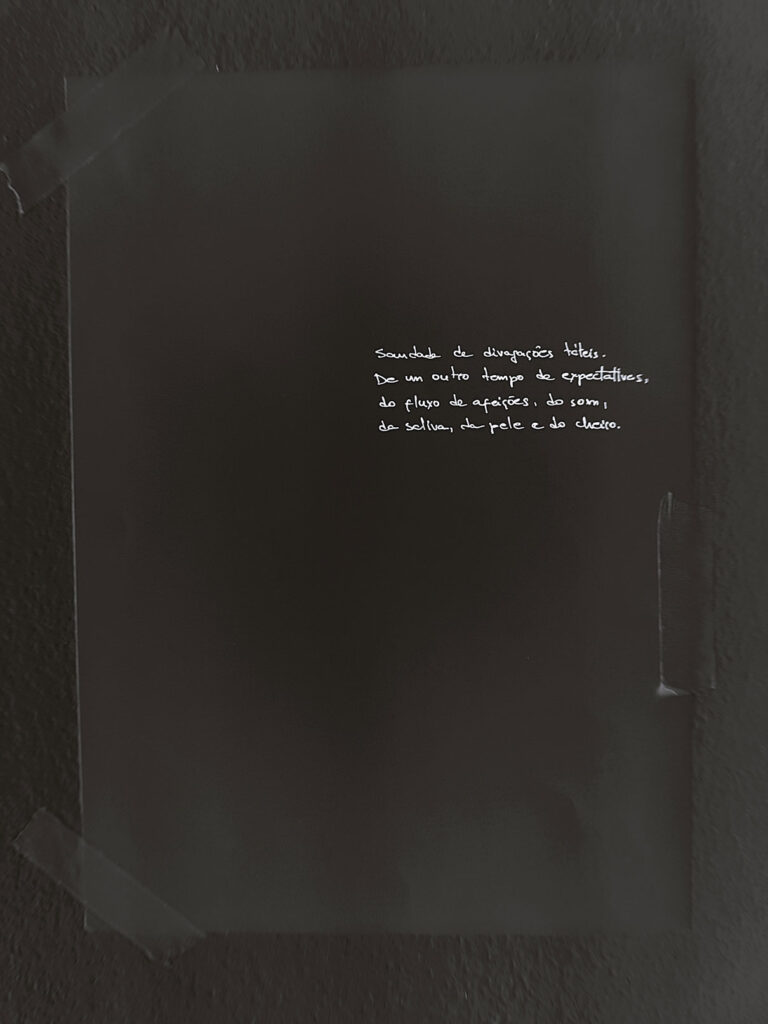
We miss palpable digression.
The time of expectations,
the flow of afections, sound,
saliva, the skin and the smell.

Nothing is more permanent than the impermanence of things. At this rate, I am more used to the speed in which the things have changed. I needed to tackle this reality and created spaces of escape. But this is a privilege.
Everytime when I talk to someone we first talk of how everything changes in a uncontrollable and rapid manner. The moods, desires and the future possibilities. There is no solid ground to step on. Everything is always changing. The only moment where to be is the present, and it has never been more obvious than now.
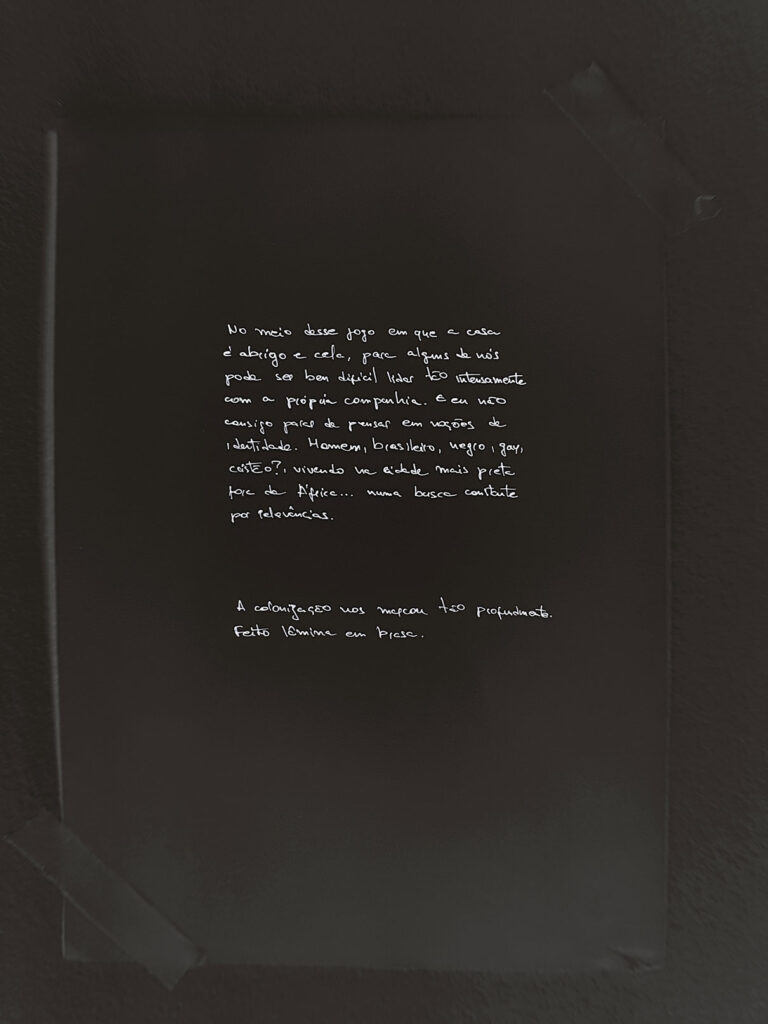
In the middle of this game when the house becomes a shelter and a prison cell, for some of us it can be difficult to handle our own company in such intense dosage. And I cannot stop thinking about aspects of my indentity. A man, brasilian, black, gay, cristian (?), living in the blackest city outside of Africa…..in the constant seach of relevant things.
The colonial period had marked us so profoundly. Like a red hot blade.

Without even realising, crossing the ocean journeying to the north become a ritual. This is how I had felt in the last few years: going north to dance the dances that bring me back home. I only go out in order to return.
This year I was not able to go out. Therefore I do not know when I will return.
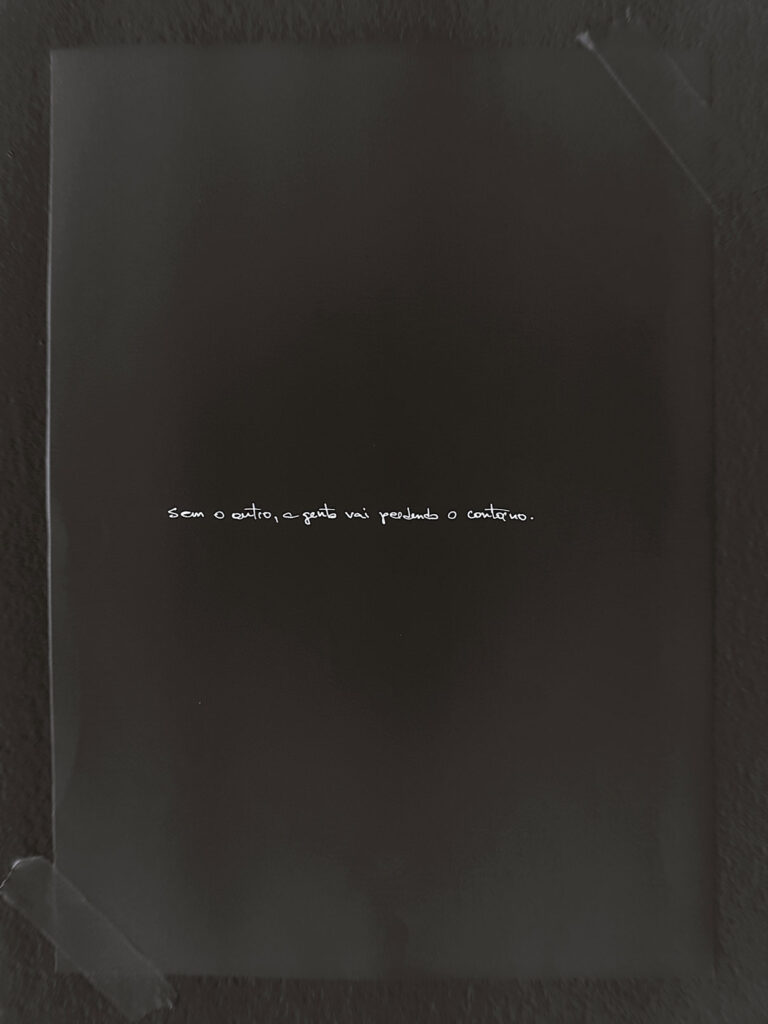
Without others, we are loosing the context.
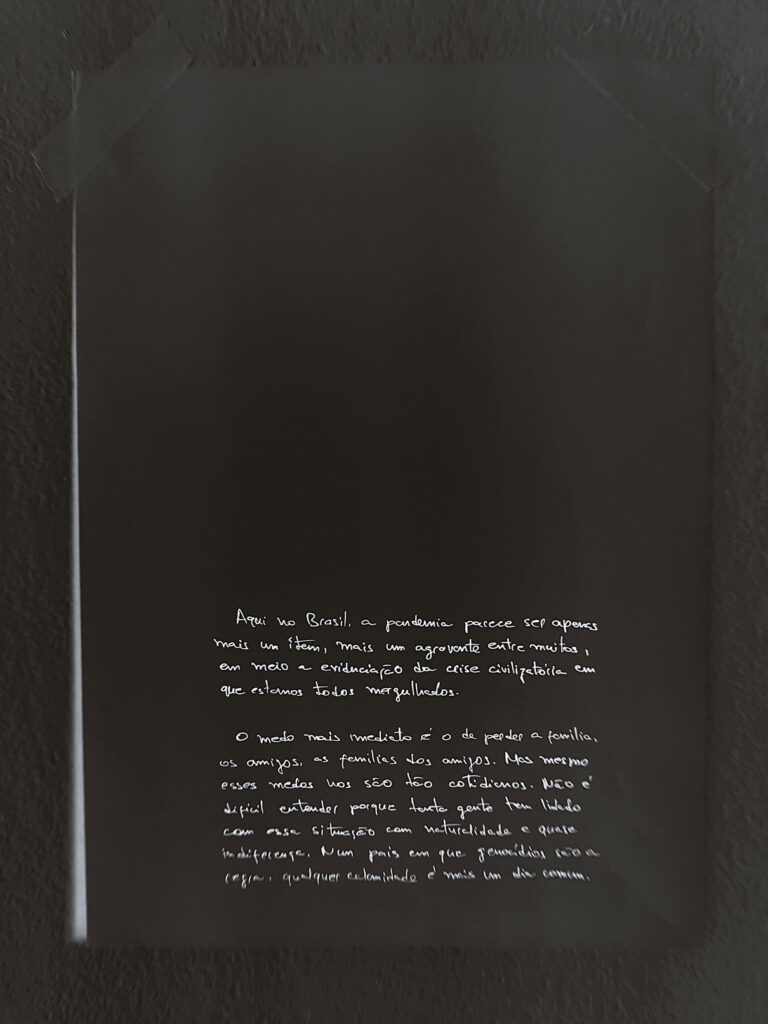
Here in Brasil, the pandemic seems to be just one of the topics, another difficult topic among others, in the middle of this obvious crisis of civilisation in which we are all submerged.
The most prominent fear of loosing our family, friends, friends’ families. These fears are not even so common. It is not difficult to understand why so many people have managed to handle this situation in a natural way and almost with indiference. In a country where genocide is almost a rule, any other atrocity is another daily thing.
In Brasil we have lived a crucial moment and this is beyond this tragic episode of the pandemic.
Finally, the talks about racism had took a dimention out of control, and had spread and grown in all the layers of the society.
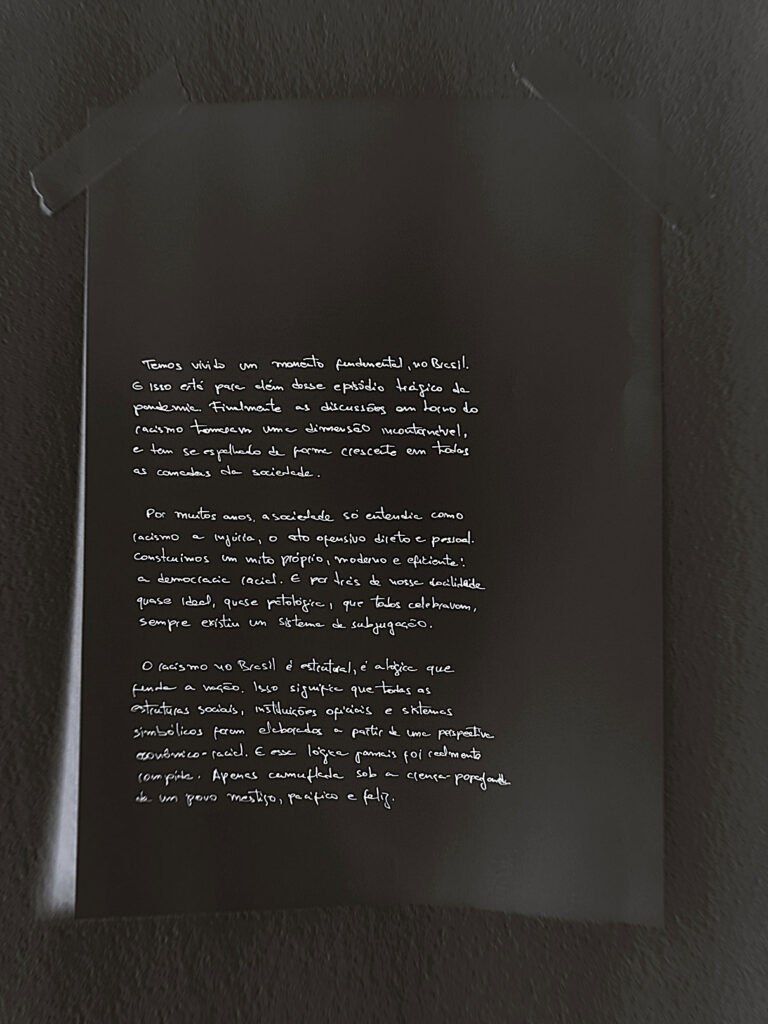
For many years in Brasil, the society had understood racism as an injustice, a direct and personal act of offence. We have build our own myth, a modern and efficient one: a racial democracy. Behind this generic sweetness, almost idilic, almost pathological, that for us constitues a world that we cherish, a subjugation system always existed.
The racism in Brasil is structured, it is the logic that provides foundation for this nation. This means that all the social structures, official institutions and symbolic systems were created from the economic and racial perspective. And this logic has neven been broken. It has been hidden as a belief-advertising of a mix race, peacefull and happy nation.
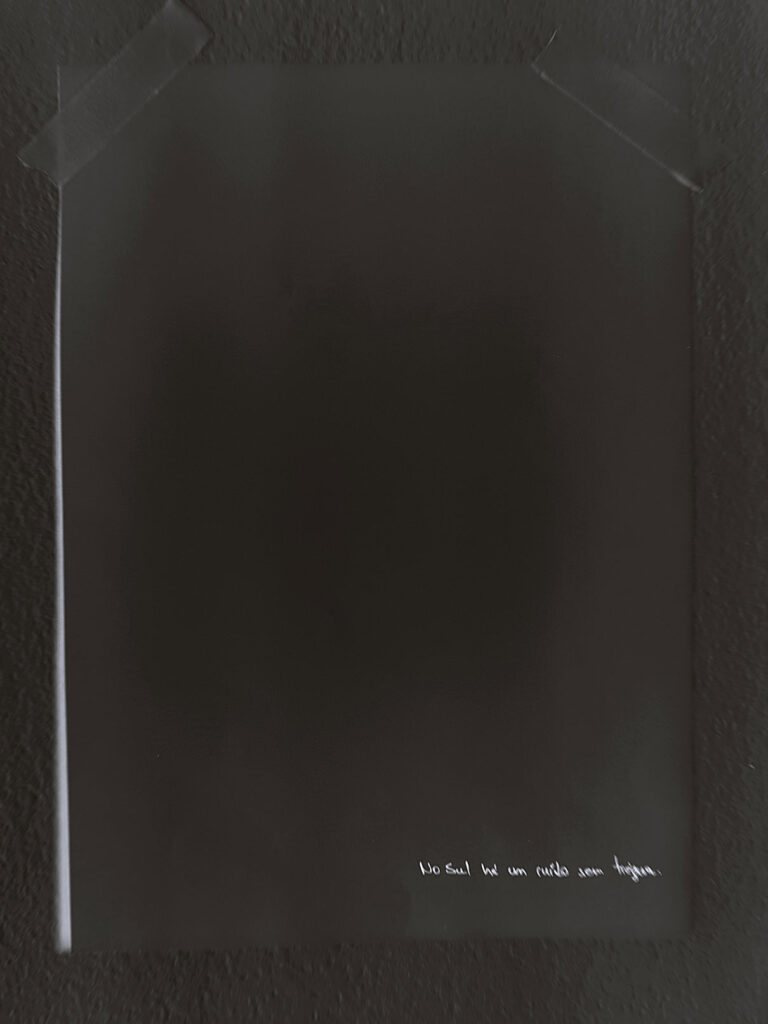
In the south there is a noise without a cease.
Letter from
Mariana
September 2020
Dear;
While fixing one of my face masks (literal translation in colombianism tapabocas: mouth-coverer), I think… it rains again.
(…)
Well, as I was saying. while fixing one of my tapabocas, I think, with a bit of rage, how ridiculous! I think about having a transparent one, one that could be un-use(full). Better said, that actually didn’t cover the aseptic function that is being forced upon. Talking from rage as someone that doesn’t like obeying.
(ehm mm)
(…) thought that this letter was going to come fast, but it was not the case. Day by day I wrote a sentence, only to annul it. Self censor and new beginning.
(…)
Things here are very strange, they have always been strange.
It’s like there is a contained emotion, as always.
Not always… but yes, always.
Things are complicated and people don’t have how to cope, they try, but they don’t have the hows. Everything is filled with “forms” and manners.
Those “forms” (and yes, I mean forms as in overly stylish “shapes”) help tolerate. Tolerance regarding daily violence, state violence; but it’s everywhere.
Like an exuberance that sprouts and sprouts everywhere, as if part of nature itself,…
While here, I think, better said, while writing I think:
since this whole thing started -oh how I like to live!
Actually, How do I like to live? What is that thing that I wouldn’t negotiate? What is it that I WON’T give up?
Conversations.
(…)
It is still strange to talk to something (through a medium), even paper.
Without conversations there is just a monologue.
So,I won’t negotiate.
Oh Dear, the conversations; so this is an invitation: would you want to converse? Give me a word, a sound of a voice.
I’ll be waiting, I don’t ask for a thing, I’ll just wait.
Hoping to meet with grace.
At this very same address, the same.
Sincerely
Septiembre 2020
Queridos:
Mientras arreglo uno de mis “tapabocas”, pienso primero que…otra vez está lloviendo
(…)
Bueno, iba diciendo. Mientras arreglo uno de mis tapabocas pienso con un poco de rabia, ¡qué ridículo! Pienso que quisiera tener uno que fuera transparente, uno que fuera más como in-sevi(ble). Mejor dicho, que no cumpliera esa función aséptica que nos ‘mandan’. Hablo un poco desde la rabia de quien no quiere obedecer.
(ehmmm)
(…) pensé que esta carta me iba a salir muy rápidamente, y no fue así. Es como que día a día escribo una oración/ la anulo. Me auto-censuro y vuelvo a comenzar.
(…)
Las cosas acá están muy raras, siempre fueron raras.
Siempre hay como una emoción contenida.
Siempre no…, pero si.
Las cosas son complicadas y la gente no tiene como, intenta, pero no tiene como. Todo está lleno de “formas” y formas.
Formas que ayudan a tolerar más que nada. Tolerar la violencia que se vive cotidianamente, la violencia del estado; la que está en todo.
Es como una exuberancia que brota y brota, es como si ya fuera parte de la naturaleza,…
Mientras estoy por acá pienso, mejor dicho, mientras escribo estas líneas pienso: desde que empezó todo esto pienso: como me gusta vivir.
¿Como me gustaría vivir? y ¿qué es lo que no quiero negociar?
¿Que NO voy a negociar?
Las conversaciones.
(…)
Sigue siendo extraño hablarle a algo, así sea un papel. Sin conversación todo es como que suena a monologo. No quiero negociar.
Las conversaciones, entonces queridos, queridas, querides; esto es una invitación ¿no querés conversar? Dame una palabra, el sonido de una voz.
Estoy esperando de este lado, no pido nada/solo espero/
Espero encontrarme con la gracia.
Es a esta dirección, la misma.
Atentamente
Letter from
Wojtek's Mother
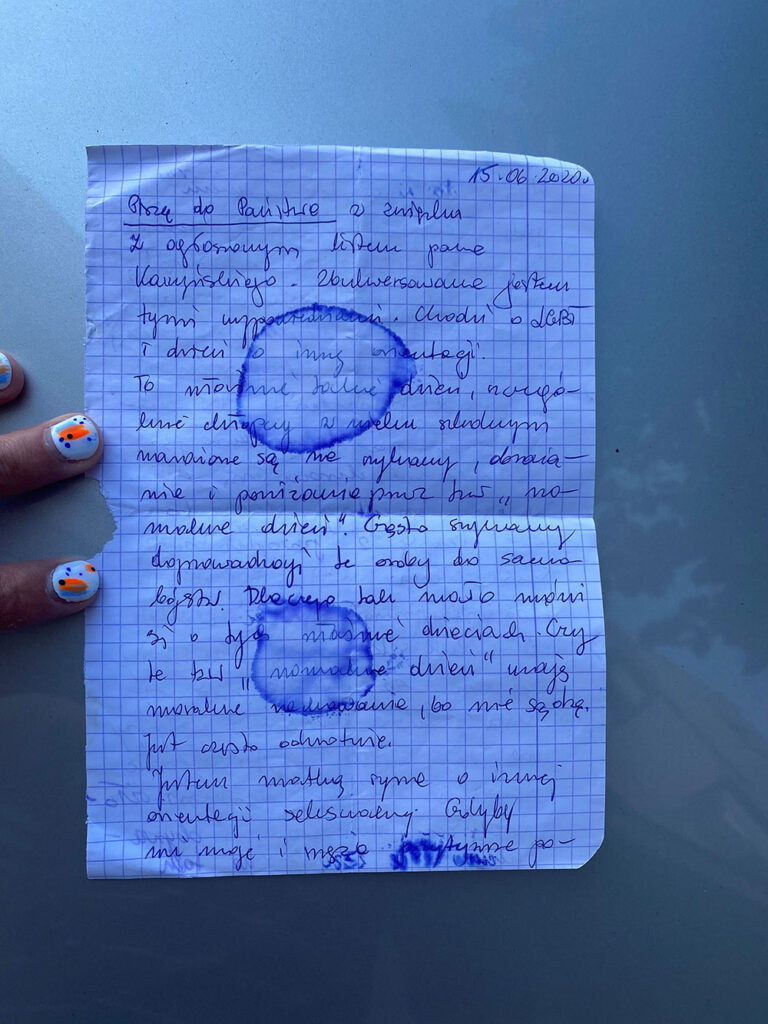
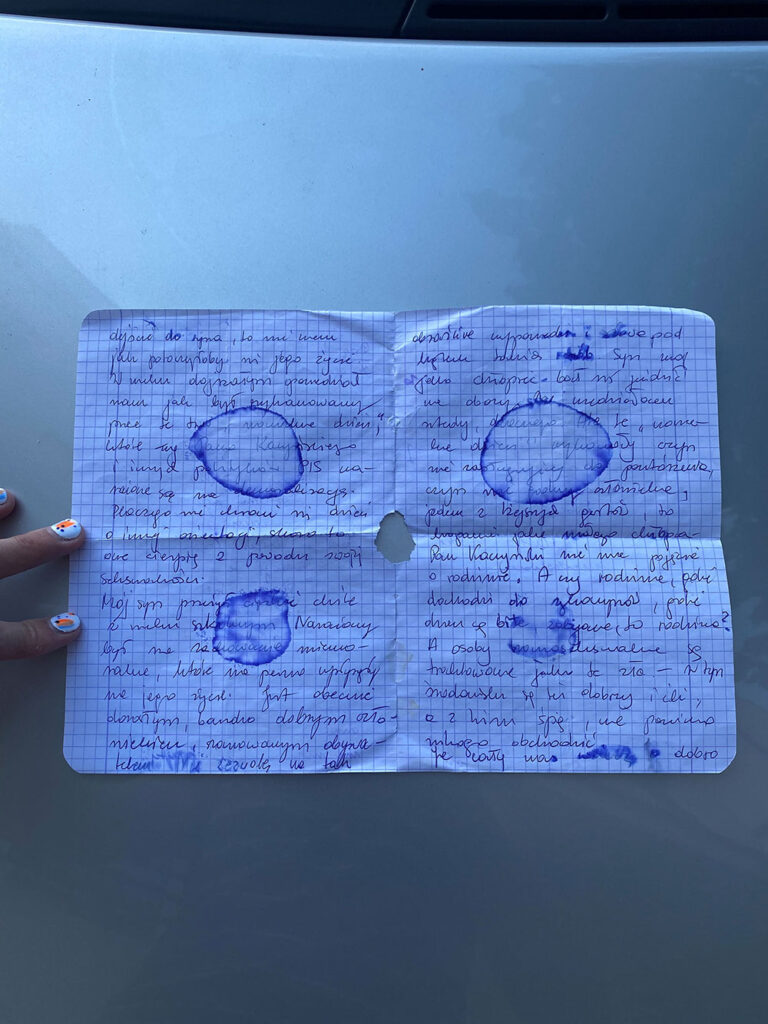

English
15 June 2020
I am writing to you in regard to the official letter of Mr Kaczyński. I am shocked by its content. The letter concerns LGTB and children of different orientation. These children, especially school-aged boys, are exposed to bullying, abuse and humiliation by the so-called ‘normal children.’ This type of bullying often leads children to suicide. Why is there so little talk about these children? Is there any morality in the ‘normal children’s’ behaviour? I do not think so. In fact, it is often the other way round.
I am the mother of a son of different sexual orientation. If it were not for my and my husband’s positive attitude to our son, I do not know how his life would have turned out. As an adult, he told me how he was bullied by the ‘normal children,’ who, according to Mr Kaczyński and other politicians from the Law and Justice party, are exposed to demoralisation. Why are children of different orientation not protected? It is them who suffer from lack of acceptance. My son had a very hard time at school. He was exposed to immoral behaviour, which undoubtedly affected his life. He is now an adult, a good person, a respected citizen, and I will not allow such offensive words to be spoken about people like him. As a boy, my son was afraid to go to summer camps. I did not know why at the time. But those ‘moral children’ behaved despicably, did vile things that no human should do, things that should never happen again. One of the lighter examples is kicking a little boy.
Mr Kaczyński has no idea about family. Is a family where there is violence, where children are beaten, are killed, still a family? But homosexual people are regarded as the bad ones. Yes, there are good and bad people in this community, but no one should be interested in who they sleep with.
I am fighting for these people all the time. I defend them.
Today, during the election campaign, things have gone too far. I believe that parents, people who are against homophobia should get together and fight. Let us not leave things as they are.
Letter from
Katja
Minsk, Belarus
Wednesday morning, I’ve been falling asleep accompanied by the explosions of noise bombs for three days, there is a constant hum in my ears, there is still no Internet. I am preparing a white dress for me and my friend, fortunately there are fresh flowers at home. It’s not far from my house to Komarovsky market, we catch a couple of strange glances on the way, we want to get to the place as soon as possible. At first, we are not too many, apart from the white clothes and flowers, we are distinguished by an embarrassed, slightly depressed, but generally joyful spirit. We do not talk to each other, we don’t know each other’s names, there is no leader who coordinates the process. We stand in line and hold our hands, I feel a slight tingling sensation from the tips of my fingers to the top of my head, I’m shaking a little, I’m scared. This was the first action, the action of silent solidarity and pain. For me, it was a kind of transition from the position of a victim to a person who takes responsibility for his own destiny. The action triggered a strong wave throughout the country, the next day we were moving in a column of thousands across the city, meeting new groups of protesters on the way, getting to know each other, sharing common pain, looking for a way out and light. Now the protest is gaining momentum, more and more people are choosing to live honestly according to the law and not according to the concepts. Every day someone is detained, fired, called for interrogations, intimidated, almost the entire company of the country’s main national theater is fired. After August 9, a lump of pain settled in my chest, and every day it becomes bigger and more dense.. For the first time I strongly experience pride in my nation, its courage, intelligence and cordiality. Meanwhile, illegitimate President Lukashenko is flying over the city with a machine gun, puts on a military uniform on his 15-year-old son and gives him a weapon, military aircrafts shoot down balloons near the Lithuanian border. All personal goals, ambitions and desires have lost all its value, there is only one thing left – I want to live freely in my country.
English
Minsk, Belarus
Wednesday morning, I’ve been falling asleep accompanied by the explosions of noise bombs for three days, there is a constant hum in my ears, there is still no Internet. I am preparing a white dress for me and my friend, fortunately there are fresh flowers at home. It’s not far from my house to Komarovsky market, we catch a couple of strange glances on the way, we want to get to the place as soon as possible. At first, we are not too many, apart from the white clothes and flowers, we are distinguished by an embarrassed, slightly depressed, but generally joyful spirit. We do not talk to each other, we don’t know each other’s names, there is no leader who coordinates the process. We stand in line and hold our hands, I feel a slight tingling sensation from the tips of my fingers to the top of my head, I’m shaking a little, I’m scared. This was the first action, the action of silent solidarity and pain. For me, it was a kind of transition from the position of a victim to a person who takes responsibility for his own destiny. The action triggered a strong wave throughout the country, the next day we were moving in a column of thousands across the city, meeting new groups of protesters on the way, getting to know each other, sharing common pain, looking for a way out and light. Now the protest is gaining momentum, more and more people are choosing to live honestly according to the law and not according to the concepts. Every day someone is detained, fired, called for interrogations, intimidated, almost the entire company of the country’s main national theater is fired. After August 9, a lump of pain settled in my chest, and every day it becomes bigger and more dense.. For the first time I strongly experience pride in my nation, its courage, intelligence and cordiality. Meanwhile, illegitimate President Lukashenko is flying over the city with a machine gun, puts on a military uniform on his 15-year-old son and gives him a weapon, military aircrafts shoot down balloons near the Lithuanian border. All personal goals, ambitions and desires have lost all its value, there is only one thing left – I want to live freely in my country.
Larysa Hienijuš
Lyrics
From a strong wind gust
Apples are falling from a tree today
Heavy, like a gold bar,
On our hospitable table is a gain.
As a gift, in the palms of my hands
Antonovka is falling today.
Decorates the feast of the masses,
When the field turns white.
Solid, fragrant, juicy,
Pleases my heart and my eyes.
From a tall tree, like from the sky.
No, other “missiles” are not needed!
Letter from
Kasia &
Ania
Dear All,
it is 2020, the year in which I’m celebrating my last twenties. Well… there’s a saying that life starts after thirty. Mine for sure. For last two years I am fighting against my stroke-ness and I’m finally starting to win, walking out my disability. I’m doing small steps – more and more – all by myself ; and I’m waiting impatiently for the future which I finally see so clear.
With greetings
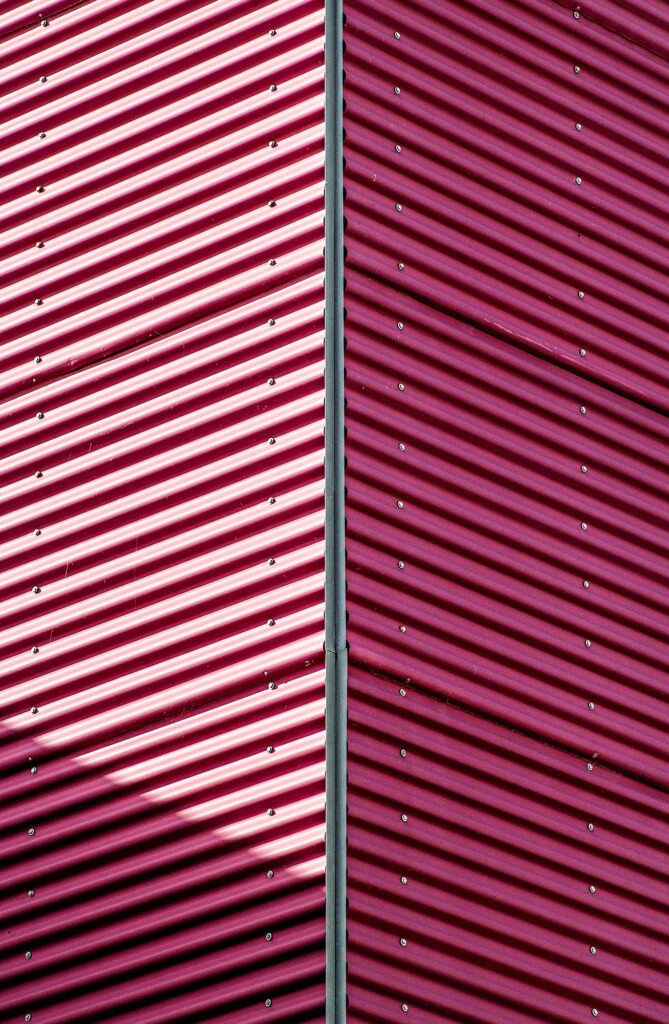
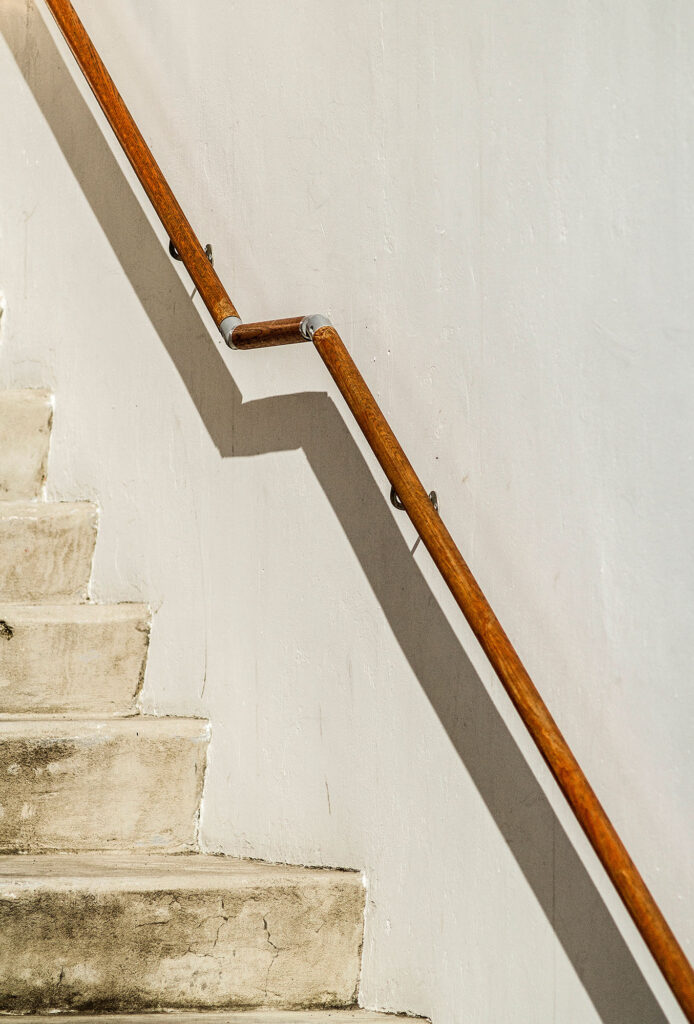
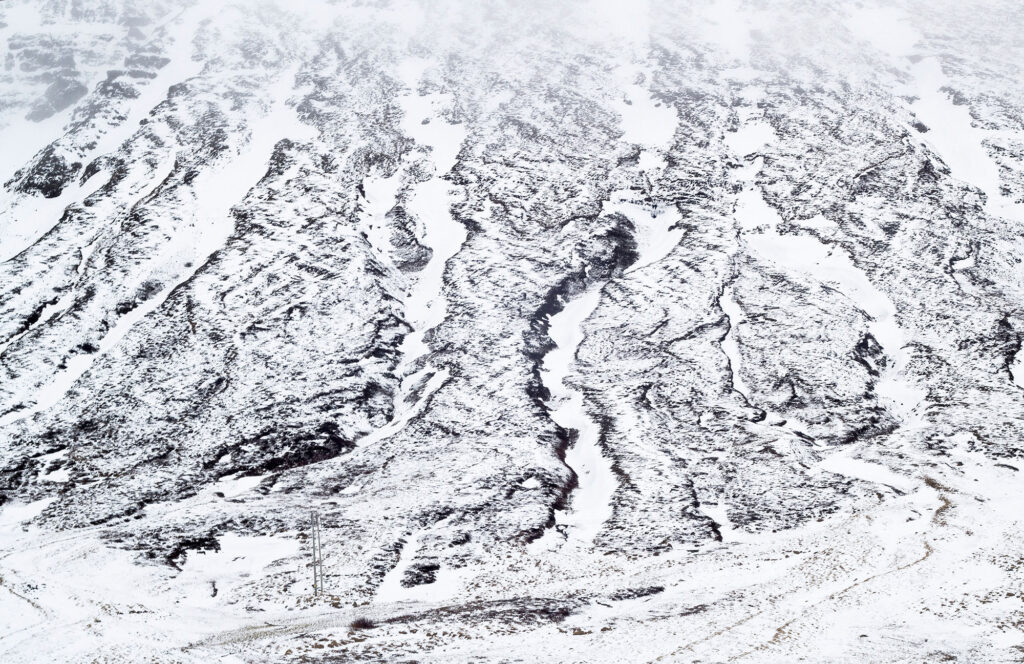

Transcript
I’m Kejti.
Officially: Katarzyna.
I’m 29 years old.
Two years ago I had stroke.
My passion is photography and music.
I know that many people say so.
But photography is also my profession. And I play drums.
I mean, well, not currently.
Currently, together with my fiancé, I live in Bydgoszcz.
Because of rehabilitation.
Polish people call Bydgoszcz by a nick name: Brzydgoszcz (after “brzydki” meaning ‘ugly’ in Polish)
but it is really nice and pretty city.
We love living here. And we plan to stay here longer.
(…) two women living together might turn out a disaster. But here our life is awesome. And we are awesome. (…)
I would not change Ania for anybody else.
Not even for young Kate Bush.
I think our biggest dream is to be back in Iceland. At least for a visit. I call Iceland my promised land. Another big dream of ours is to live in seclusion, surrounded by nature. That’s very important for us. And my personal dream is that out cat that we were forced to leave at my parents, that it still puffs at me few times and scratches me well again.
Life of disabled person is not easy and certainly it’s pissing me off. I never thought dependency is in fact so irritating.
Hey,
I’m Ania and I’m Kejti’ (Kasia’s) fiancé. We are together since 5 years, and currently we live in Bydgoszcz. I’m originally from Poznan. And I will be 28 this year.
I studied economy, I worked in hotel business, and now, since 2,5 years, I help Kasia in the everyday functioning, cause at this moment she still needs help 24/7.
When the stroke happened, we were paying Easter visit to Poland, but our home, residence place, was Iceland. It was March 2018.
We are in Bydgoszcz since the rehabilitation started. It is already 2,5 years being back in Poland. Bydgoszcz was not really our choice of preference, simply: the best in the country rehab for Kasia is placed here. But it was very positive surprise for us to discover Bydgoszcz as a nice place to live. I’m a driver and it’s great for driving. Everything is close. And we won’t hide that it is for us, in our situation, a super important thin. And Bydgoszcz’ old town is beautiful. It’s called “Venice of Poland”. Great to spend time in.
But still, living in Poland is not our choice. We moved to Iceland and we wanted to live there for few, or maybe even longer, for dozen of years… Iceland is very tolerant, very open, ethnically and socially very diverse, people’s views on many issues are so different than in Poland. That’s why we left. And also, Iceland is our special place, we fell in love with this country, it’s the place we simply felt good to be in. I think the place of birth is for us important, and surely and mostly the people in Poland are important, and since they are living here so we do consider Poland our place too, but Iceland.. Iceland is our home of choice, if I may say…
… I guess, year 2018 was critical. Beginning of some new era, new chapter. Surely for me. And now current pandemic, it has changed so much: in the human relations, in the way we see certain issues, in economy, in the whole system. Those incredible 3 months of the hardest lockdown, how much they twisted everything. I do not want to complain, and during pandemic we were ok: we had a place to live, we had food, we just had to stay calm and endure.. Of course it was.. challenging.. mentally. And for all of us. I think we all went through ups and downs. Impossibility of meeting people, our families, that was very difficult. I missed real contact with others, our usual daily rhythm, the routine of preparing for leaving the house, going for rehabilitation. It was a crazy time.
Also, some issues got reevaluated in our heads. One appreciates more simple possibility of getting out, of taking a stroll, of being in nature… Now we really try to stay close to nature more often… and we do appreciate so much more the meetings with family and time spent with friends; and we try to use it the best way, to live our life more, to enjoy the moment..
And now, when everything seems to come back to some kind of (still new but) normal, it is more difficult for us again. More trouble to organize any charity event for example; we do understand that people lost means and money, so they cannot support us,
it is then harder…, but anyway, of course, we continue to operate…
For me personally, a life in Poland is ok, I try not to grumble too much..
But still, there are issues that concern and touch me deeply..
like impossibility to legalize our relationship.
Usually, when in marriage, when one partner gets sick or has accident, the other one who suddenly needs to become caretaker, to quit job, there is always a support from government.. an insurance… and in my situation, I am denied any possibility of formal help. And that creates extra burdens, extra troubles in this already quite tough situation.. there is a whole list of them… and the disability becomes even harder.. So, same sex marriages, small issue, seems to so many such an irrelevant problem, all the whys? What fors?
And actually, for us, it would change so much … Really.
I still believe there’ll be the change one day. I believe we will get to the moment equal rights for every relationship will be provided. And I think that is my main dream for today: to witness this change asap. To see everybody understanding we are all equal.
And another dream, and it can still wait a bit but: I really really would love to come back with Kasia to Iceland. I know coming back for good (to live there, to work) that might not be possible anymore.. But at least holidays… that would be already enough.
Yes, so.. that is my dream: a trip with Kasia to Iceland.
Letter from
Inna
Belarus. Summer 2020
It feels like an eternity… Nobody could have imagined that we would face an even more difficult challenge after the coronavirus. A summer of incredible discoveries, queues, pain, fear, tears, constant inner choices and titanic work to achieve acceptance.
This summer, the following words are often heard in our vocabulary:
- violence
- provocation
- falsification
- avtozak (a prison van for transporting suspects and accused persons)
- tikhar (a nark, an unnoticeable person in the crowd, sent by the authorities to collect information, to initiate provocations or detain people)
- OMON (Special Purpose Police Unit)
- khapun (a round-up, sudden detention of people in the street, in a café or some other place by plain clothes officers who use cars or minibuses, often without number plates)
- fascism, lukashism (Lukash(enko)+(fasc)ism)
- Okrestina (the most horrifying detention centre for offenders, named after the street where it is located). Things that happened there after the elections can be likened with concentration camp atrocities.
- Shame! Let them go! Go away! Tribunal! (most common demands shouted by people during peaceful protests)
- Verim, mozhem, pobedim (We believe, we can, we will win – a slogan of Svetlana Tikhanovskaya’s election campaign)
- chain of solidarity
- solidarity bicycle race
A short summary of events
Alexander Lukashenko has been President of Belarus for 26 years. He built a tough vertical structure of power, and a dictatorial regime. During this most recent election campaign, the country saw the emergence of alternative candidates that people wanted to vote for. This was evidenced by the long queues to the places where support signatures were collected for those candidates. The authorities were scared. Opinion polls were banned. Two candidates were sent to prison on fabricated charges, and a criminal case was instigated against the third one. Peaceful protests were organised by citizens across the country. People participated in solidarity chains or bicycle races of solidarity, they wore clothes with political symbols but this was suppressed by the authorities. Anyone could end up in prison, even when popping round to the shop that sells Belarusian and political symbols. More queues, this time at the Central Electoral Commission and post offices. People lodged complaints about the authorities’ illegal actions against the candidates who could not run for president. Thousands of unanswered complaints.
Svetlana Tikhanovskaya, the wife of one of the candidates who was put in prison, was accepted and could run in the election. She decided to do so out of love for her husband. The authorities did not take her seriously, which turned out to be their fatal mistake. This event was a source of inspiration for the whole country! Maria Kolesnikova and Veronika Tsepkalo, who represented the candidates that fell into disfavour, decided to support Svetlana and unite in the electoral struggle. Competitors turned into allies! The photo of these three women made the headlines around the world! Despite the provocative actions undertaken by the authorities, thousands of people gathered at rallies in support of Svetlana, even in small Belarusian towns! Realising that the vote would be rigged, as was the case many times before, a team of IT specialists came up with an online project called GOLOS (voice/vote) for alternative vote counting. The supporters of Tikhanovskaya agreed to wear white bracelets on their wrists as a hint for independent observers during the voting process.
Elections on 9 August 2020
Queues at the polling stations, both in Belarus and at Belarusian embassies abroad. Everyone wants to contribute to the legal change of power. The country had never seen anything like that before! Independent observers are not allowed into the polling stations, so they carry out their mission in the street. Some have been sent to prison directly from the polling stations on false charges of petty hooliganism and resistance to the police. Horrible pressure on those members of election committees who refuse to participate in falsification. Unprecedented falsification of election results! Votes get stolen. People take it to the streets and gather on city squares.
9–13 August 2020
During those days, access to the Internet was shut down throughout the country. Those who used a proxy server shared terrible news. On 9–13 August, the country saw the most brutal mass arrests of citizens, and not just those who took part in peaceful protests. People were caught in their yards, near a shop, in a café or even in their own homes! Thousands of people were detained, badly beaten, morally and physically humiliated, tortured and convicted without guilt. Doctors, whose calls were not answered by the police, were in horror to see people with grave bodily injuries and bullet wounds being admitted to hospitals. More than 7,000 people were detained throughout the country on 9 August and the following days. Over 80 people went missing. There were also some fatalities. People who were leaving Okrestina were telling stories that left listeners in horror and tears. The police turned from protectors into punishers. The court, the investigation committee and prosecutor’s offices ceased to perform their constitutional roles. People turned out to be completely defenceless against those who wanted to retain power at all costs. We recalled the actions of the Nazis during World War II and the Stalinist repressions. It was hard to believe that all this was happening in our country in the 21st century! We couldn’t understand that our compatriots were capable of such cruelty and ready to follow criminal orders. After all, they had sworn an oath not to one man, but to the people of Belarus!
At some point, it seemed that we became broken by the cruelty, lies and evil that surrounded us. And then a miracle happened. On 12 August, the first women’s protests took place. It is not clear where this idea originally came from. Girls and women would put white clothes on and, with flowers in their hands, formed a human chain in cities and towns across the country, in solidarity with detainees and victims, demanding end to violence. It was scary to stand there, and the police threatened to detain them because the initiative was allegedly unlawful. But the women did not give up. In some incredible way, those actions restored hope and strength.
Protests continued. Workers’ strikes began. Honest journalists, lawyers, investigators and policemen—those who could not lie and follow criminal orders—were dismissed. Pavel Latushko, director of the Yanka Kupala National Theatre, spoke out against violence. He was dismissed, and all of the artists working at that theatre followed suit. The country’s main drama theatre is now empty. Right from the first days when violence started, the Catholic Church offered support to civilians. Now the head of the Roman Catholic Church in Belarus, archbishop Tadeusz Kondrusiewicz, a citizen of Belarus, was not allowed into the country after his visit to Poland. In mid-August, the head of the Belarusian Orthodox Church also called on the authorities to stop the violence, after which he was transferred to Russia to serve as a priest there. A hundred of young talented holders of the presidential scholarships waived their benefits. More than 400 athletes joined the protest, reporting that they would refuse to compete for Belarus as long as A. Lukashenko stays in power. Former graduates abandoned their diplomas and gold medals at school entrances to protest against election fraud (polling stations are mostly located in school buildings, with teachers being members of election committees). Ordinary citizens and the Belarusian diaspora established a support fund for victims. Funds are allocated to pay fines imposed for participation in rallies, for lawyers’ services and medical treatment. Financial assistance is provided to those who lost their jobs after speaking out as citizens. Official media in Belarus and Russia continue to lie. Political technologists and TV journalists from Russia came to replace the dismissed Belarusians. Not a single criminal case has been instigated for inflicting bodily injuries or causing death of civilians. Moreover, Alexander Lukashenko handed out awards to 300 OMON officers “for excellent work.”
All these events are only part of what we have experienced and are still experiencing this summer. Each day brings news that seems beyond common sense: the director of the Opera and Ballet Theatre and the director of the Cardiology Centre were dismissed, the OMON blocked the doors of Red Church in Minsk with people inside, some missing people were found dead, and a woman was tried at court for wearing a white-red-white dress.
The following symbols have gained a special significance this summer:
- a white bracelet, a white balloon, white clothes (a symbol of honesty and voting for Tikhanovskaya in the election)
- a painting entitled “Eve” by Kh. Sutin (linked to the name of one of imprisoned presidential candidates)
- the white-red-white flag (historical flag of Belarus)
- the song entitled “Peremen!” (“We want change!”, by the legendary Russian singer Viktor Tsoi)
- the song entitled “The walls will collapse” (based on the anthem of the Polish “Solidarity” movement, with lyrics by Polish bard Jacek Kaczmarski, and music by Catalan author Lluís Llach)
This summer, before going out, we might ask ourselves:
- Should I put on court shoes or trainers (to run faster in case of danger)?
- Should I take a toothbrush and a jumper with me (it could be cold in prison)?
- Should I delete all correspondence and photos from my phone as they give away my political views?
- Should I wear a white bracelet or better not take any risks?
- Should I leave more food and water for my pets, just in case?
According to psychologists, all people who seek counselling these days say the following:
- I’m afraid to leave the house, something may happen to me, I might be detained, beaten up; people in uniforms or in plain clothes may break into my house through the balcony or through the door. My head is filled with scenarios of what might happen to me or to my loved ones.
- I am very embarrassed that I am not as brave as my friends.
- I can’t work, I can’t concentrate.
- I don’t sleep much, and my sleep is poor.
- I’m going to emigrate from this country if things stay as they are.
- I quarrel with my loved ones when we talk about politics.
- I’m worried that if these people stay in power, we may be “picked out” and punished individually for what we have posted online, for taking part in rallies.
- When I walk down the street and see a minibus or the police, I get scared.
- I check the news feeds every five minutes. I tell myself to stop, but I can’t.
Most of us experience bodily and emotional traumas as a result of the current events. During the free dance classes and body practice sessions that we are now offering to everyone, people share their feelings. Many people experience constant anxiety and tension in their bodies, especially in the chest area. I come to the rehearsal and just lie on the floor for hours, trying to feel my body, its boundaries and centre. For the time being, it seems impossible to dance like I used to. When the group gathers together, a sense of security emerges and our bodies open up more quickly. Making healing sounds, and singing in general is very helpful. For a long time, I would walk with a white balloon tied to my backpack. One day, I was attacked by Lukashenko’s supporters on a bus. On another occasion, the church sextons did not let me in when I wanted to pray. A few days ago I saw a message on the Internet about a woman who was detained in a shop for carrying a white balloon. I’ve noticed that my thoughts and a portion of my attention are constantly focused on analysing and experiencing the situation. Sometimes, after reading the news, I find it very difficult to cope with the surge of hatred. But we all realise quite clearly that we can only win by sticking to acceptance and love. Some people are thankful for the situation since it made us more aware and has inspired change within us. One feels better after prayer and meditation: there seems to be a lot of bright light over our country, and this whole nightmare will soon be over.
We all try to overcome our fears. On Sunday, at a peaceful women’s rally in Gomel, where I live, the police demanded that we should go away. A female police officer took a camera and walked along the entire human chain, filming each participant’s face. Psychological pressure is very difficult to withstand. Knowing about our action at the church, the authorities brought several buses with opponents of change with red-and-green flags. They surrounded us, stood behind us, and shouted slogans in support of the incumbent authorities. Our attempts at getting into dialogue with them didn’t work out. When we tried to move away or cross the street, the red-and-green group would follow us. We decided to go to the city centre, but the police also followed us, continuing to make threats that we would be detained. More people joined us along the way and, eventually, there were so many of us at the central square that we finally felt safe. It is always difficult for me to be in the crowd, I am very sensitive. That day, I had the opportunity to compare how I felt among a large number of people who profess different values. For me, all things that are happening now are not about politics anymore. The whole thing goes much deeper. In my subjective perception, the energy of the red-and-green crowd is rigid, aggressive, tense, blind, insane. Their main slogans are: “We are Belarusians” and “We support Batka” (Lukashenko). The energy of the white-red-white crowd is all-embracing, kind, smiling, hugging, accepting, supportive. At present, two flags, red-and-green alongside white-red-white, coexist peacefully within that crowd. The main slogans are “Zhyve Belarus” (Long Live Belarus) and “Verim, mozham, peramozham” (We believe, we can, we will win). The red-and-green rallies feel like a job you hate: they suddenly end at a certain point. In contrast, white-red-white protests last for hours, they are spontaneously organised, with people moving around the city streets.
We struggle to come to terms with our feelings when we hear cynical lies from the authorities. They tell the public that all these rallies with thousands of people are inspired by drug addicts, the unemployed, prostitutes, foreign agents of Lithuania and Poland. A 16-year-old boy who ended up in intensive care after being tortured for refusing to sing the OMON anthem, was officially reported to have used drugs, although the information in his medical records was quite different. It is hard to imagine what the mothers of such victims are going though, or what goes in the minds of people whose relatives went missing.
It seems that the Belarusians knew nothing about themselves before this summer. Many thought that most of us were passive, overly patient, unable to unite. Perhaps we were looking at one another through the opaque glass offered by the government and its institutions. And only now have we seen the kind of people who surround us. Unbelievable mutual help, creativity, great manners, courage and acceptance! People refrain from hatred and from responding to violence with violence. Peaceful protesters never smashed a single window or store display, they never damaged a car. No lawns were trampled and no litter was left behind in the streets. Belarusians take off their shoes before they step on a bench during rallies. Relatives of the victims say that when they had to stand at the prison walls day after day, people who lived nearby would bring food, tea and warm clothes. Doctors replace the teeth that had been knocked and perform facial surgeries out at no expense for the victims. There is a sense of some unique experiment that we are all witnessing. We do not have an obvious leader: things happen in a stream of collective consciousness. It feels as if the society is implementing an idea that was previously conceived by some contemporary artists. There is an alternative way of organising the process: instead of top-down management, people rely on cooperation and self-organisation, people listen to the space around them and get a sense of the situation. This renders the most harmonious response. Many people say that the protests in Belarus have a female face. Women play a special role in terms of the energy they contribute. Incredible actions organised by women, the ability to save men from detention, the courage of the legendary Nina Baginskaya – all this will go down in history as the women’s part of the Belarusian civil society in the making. When law enforcement agencies exert pressure, Belarusians come up with ever new forms of peaceful protest: singing together in shopping centres, at underground stations and street markets. An orchestra might play on the steps of the Philharmonic Hall until its members have been dispersed by OMON officers. Dancers would offer street performances, bringing themselves and the space in harmony. People would hang white-red-white flags on their houses. When a long flag was taken away from a multi-storey house, the residents made a new one, using sewing threads, and divided it into 15 parts, one for each floor. Removing such a flag would be much more problematic. On the Independence Square in Minsk, 50 former Okrestina prisoners made an outline of the prison cell for six people and stepped into that space together, as a reminder of the real prison cell. Belarusians retain their sense of humour. They come up with sharp-witted posters and jokes, which is very helpful in difficult moments. “A ready-made nation of about 6 million people, with a president, a high-tech park, medical services, theatre, media, a national sports team and private businesses, is looking for a territory for permanent residence. We promise to keep it clean and pay taxes on time. No dictatorship offers will be accepted.”
We thank the whole world for its support! Actions in Lithuania, Czech Republic (Prague), France, Germany and other countries have been simply unbelievable! Yesterday, on 31 August, about 100 people were detained all over the country again. But we believe that progress cannot be forcefully stopped, and that we can build a new Belarus together. “A country to live in!”
Belarusian
Беларусь. Лето 2020
Кажется, что прошла вечность…
Невозможно было представить, что после короновируса нам выпадет еще более сложное испытание.
Лето невероятных открытий, очередей, боли, страха, слез, постоянного внутреннего выбора и титанической работы на принятие.
В это лето в нашем лексиконе часто звучат слова:
– насилие
– провокация
– фальсификация
– автозак (машина для перевозки подозреваемых и обвиняемых)
– тихарь (человек в толпе, без знаков отличия, посланный властями для сбора информации, провокаций или задержания людей)
– ОМОН (отряд милиции особого назначения)
– хапун (акт внезапного задержания людей на улице, в кафе или ином месте лицами в гражданской одежде, использующими автомобили или микроавтобусы, часто без номеров)
– фашизм, лукашизм (Лука(шенко)+(фа)шизм)
– Окрестина (самый страшный Центр изоляции правонарушителей, назван людьми по имени улицы, на которой находится). То, что творилось там после выборов, можно назвать концлагерем.
– позор, выпускай, уходи, трибунал (самые частые требования людей на мирных протестах)
– верим, можем, победим (лозунг предвыборной кампании Светланы Тихановской)
– цепь солидарности
– велопробег солидарности
Краткое описание событий.
Александр Лукашенко являлся Президентом Беларуси в течение 26 лет. Он выстроил жесткую вертикаль власти, диктаторский режим.
В эту предвыборную кампанию в стране появились альтернативные кандидаты, которым люди хотели бы отдать свои голоса. Об этом говорили длинные очереди к местам сбора подписей по выдвижению этих кандидатов в Президенты.
Власть напугана. Запрещены социальные опросы населения. Двух кандидатов отправили в тюрьму по надуманным обвинениям, на третьего подали жалобу для возбуждения уголовного дела.
Мирные протесты граждан по всей стране. Участие в цепи или велопробеге солидарности, ношение одежды с политической символикой подавляется властями. Любой человек может попасть в тюрьму даже из магазина, где продается белорусская и политическая символика.
Снова очереди – в Центральную избирательную комиссию, в почтовых отделениях. Люди подают жалобы на неправомерные действия властей в отношении несостоявшихся кандидатов. Тысячи жалоб без ответа.
К выборам была допущена Светлана Тихановская – жена одного из кандидатов, находящихся в тюрьме. Она решилась на этот шаг из-за любви к мужу.
Власти не воспринимали ее всерьез, и это стало их роковой ошибкой. Произошло событие, которое вдохновило всю страну! Представительницы штабов опальных кандидатов, Мария Колесникова и Вероника Цепкало, решили поддержать Светлану и объединиться для предвыборной борьбы. Конкуренты превратились в соратников! Фото этих трех женщин облетело весь мир! Несмотря на провокационные действия властей, на митинги в поддержку Светланы собирались тысячи людей – даже в маленьких городах Беларуси! Понимая, что голосование будет сфальсифицировано, как это было не раз, команда айтишников придумала онлайн проект ГОЛОС для альтернативного подсчета голосов. Сторонники Тихановской договорились надеть на руку белые браслеты, чтобы подать знак независимым наблюдателям в процессе голосования.
Выборы 9 августа
Очереди на избирательные участки, как в Беларуси, так и в Посольствах Беларуси за рубежом. Все хотят внести свой вклад в смену власти законным путем. Такого страна еще не видела!
Независимые наблюдатели не допущены на участки для голосования, и они выполняют свою миссию, находясь на улице. Некоторые отправлены в тюрьму прямо с участков, по подложному обвинению в мелком хулиганстве и сопротивлении милиции. Чудовищное давление на членов избирательных комиссий, отказывающихся участвовать в фальсификациях.
Беспрецедентная фальсификация итогов выборов! Голоса избирателей украдены. Люди вышли на площади городов.
9-13 августа
В эти дни был отключен интернет по всей стране. Те, кто пользовался прокси-сервером, делились жуткими новостями.
9-13 августа были самые жестокие и массовые задержания граждан, не только тех, кто участвовал в мирных протестах. Любой человек мог быть схвачен в своем дворе, возле магазина, в кафе и даже в собственной квартире! Тысячи задержанных, избитых, подвергшихся моральному и физическому унижению, пыткам, осужденным без вины. Ужас врачей, на вызовы которых не реагировала милиция, при поступлении в больницы людей с тяжкими телесными повреждениями и пулевыми ранениями. В дни, прошедшие с 9 августа, в стране было задержано более 7 тысяч человек. Более 80 человек пропали без вести. Есть погибшие. Рассказы людей, выходивших с Окрестина, невозможно слушать без боли и слез. Милиция из органа защиты населения превратилась в карателей. Суд, следственный комитет, прокуратура перестали выполнять свои функции в соответствии с Конституцией. Люди оказались совершенно беззащитными перед теми, кто хотел сохранить власть любой ценой. Мы вспоминали действия фашистов во время Второй мировой войны, а также период сталинских репрессий. Невозможно было поверить, что все это происходит в нашей стране в 21 веке! Мы не могли понять, как могло случиться, что наши соотечественники способны на такую жестокость и выполнение преступных приказов. Ведь они присягали не одному человеку, а народу Беларуси!
В какой-то момент казалось, что мы сломлены жестокостью, ложью и злом, окружающим нас. И тут произошло чудо.
12 августа возникли первые женские акции протеста. Неизвестно, чья это идея. Девушки, женщины надевали белую одежду и, с цветами в руках, выстраивались цепью в городах по всей стране. В знак солидарности с задержанными и пострадавшими, с требованием остановить насилие. Стоять было страшно, милиция грозила задержаниями в связи с незаконностью акции. Но женщины не сдавались. Каким-то невероятным образом эти акции вернули людям надежду и силу.
Протесты продолжаются. Начались забастовки рабочих, увольняются честные журналисты, юристы, следователи, милиционеры – те, кто не может лгать и выполнять преступные приказы.
Павел Латушко, директор Национального Театра им. Янки Купалы, открыто высказался против насилия. Он был уволен, и за ним уволились все артисты театра. Главный драматический театр страны ныне пуст.
С первых дней насилия, мирных граждан поддерживает католическая церковь. Сейчас главу католической церкви, гражданина Беларуси Тодеуша Кондрусвича не впускают в страну после его визита в Польшу. Глава белорусской православной церкви в середине августа также призвал власти остановить насилие, после чего он был переведен на служение в Россию.
Сотня молодых талантливых стипендиатов Президента отказались от стипендии. Более 400 спортсменов присоединились к протесту и сообщают, что откажутся выступать за Беларусь, пока у власти находится А. Лукашенко. Бывшие выпускники оставляют у входа школ и гимназий свои дипломы и золотые медали в знак протеста против фальсификации выборов (избирательные участки в основном располагаются на территории школ, учителя состоят в избирательной комиссии).
Простыми гражданами и диаспорой создан фонд поддержки пострадавших. Выделяются деньги на оплату штрафов за участие в митингах, адвокатов, медицинское лечение. Оказывается финансовая помощь уволенным в связи с высказыванием своей гражданской позиции.
Официальные СМИ Беларуси и России продолжают лгать. На место уволившихся беларусов приехали политтехнологи и представители телевизионных каналов из России.
По факту нанесения телесных повреждений и смерти мирных граждан не начато ни одно уголовное дело. Более того, Александр Лукашенко наградил 300 омоновцев «за отличную работу».
Все эти события – только часть того, что мы пережили и переживаем этим летом. Каждый день приносит новости, которые кажутся за гранью здравого смысла: уволен директор Театра оперы и балета, директор Кардиологического центра, ОМОН заблокировал двери Красного костела с находящимися внутри людьми, несколько пропавших без вести найдены мертвыми, состоялся суд над женщиной за ношение БЧБ платья.
В это лето особое значение имеют символы:
– белый браслет, белый шарик, белая одежда (символ честности и того, что твой голос на выборах отдан Тихановской)
– картина ЕВА художника Х. Сутина (связана с именем одного из сидящих в тюрьме кандидатов)
– БЧБ флаг (бело-чырвона-белый флаг, исторический флаг Беларуси)
– песня «Перемен!» легендарного русского певца Виктора Цоя
– песня «Стены рухнут» (основана на гимне «Солидарности», текст польского барда Яцека Качмарского, музыка Льюиса Льяка)
В это лето перед выходом на улицу у нас могут возникнуть вопросы:
– надеть туфли или кроссовки (чтобы быстрее бежать в случае опасности)
– взять ли с собой зубную щетку и свитер (в тюрьме может быть холодно)
– удалить ли из телефона всю переписку и фото, выдающие твои политические взгляды
– надеть ли белый браслет или все же не рисковать
– оставить ли домашним животным больше еды и воды на всякий случай
Психологи пишут, что каждый человек в консультации в последние дни говорит следующие вещи:
Я боюсь выходить из дома, со мной что-то может случиться, меня задержат, изобьют, ко мне в дом через балкон или дверь могут ворваться люди в форме или без. В моей голове прокручиваются сценарии того, что может произойти со мной или моими близкими.
Мне очень стыдно, что я не настолько смелый, как мои друзья.
Я не могу работать, не могу сосредоточиться.
Я мало и плохо сплю.
Я перееду из этой страны, если все останется как есть.
У меня есть ссоры с близкими на политической почве.
Я переживаю, что если эта власть останется, нас могут «отлавливать» и наказывать поодиночке за публикации в интернете, за то, что я участвовал в митингах.
Если я просто иду по улице и вижу микроавтобус или милицию, мне становится страшно.
Каждые 5 минут я читаю новостные каналы. Я уговариваю себя прекратить, но не могу.
Большинство из нас испытывают телесно-эмоциональную травму от переживания текущих событий. На открытых бесплатных занятиях по танцу и телесным практикам, которые мы сейчас проводим для всех желающих, люди делятся своими ощущениями. Многие чувствуют постоянную тревожность, сжатость тела, особенно грудного отдела.
Я прихожу на репетицию и часами просто лежу на полу, пытаясь почувствовать свое тело, его объем, центр. Танцевать в прежнем качестве пока невозможно. Когда собирается группа, возникает чувство защищенности, и тогда тело раскрывается быстрее. Очень помогает пение целебных звуков, пение вообще.
Долгое время я ходила с белым воздушным шариком, привязанным к рюкзаку. Однажды я подверглась нападкам сторонников Лукашенко в автобусе, в другой раз служители церкви не дали мне спокойно войти и помолиться. Неколько дней назад в интернете я увидела сообщение, что в каком-то магазине женщина была задержана за белый шарик.
Я замечаю, что мои мысли и часть внимания постоянно направлены на анализ и переживание ситуации. Иногда, после прочтения новостей, очень трудно справиться с поднимающейся волной ненависти. Но мы все ясно осознаем, что сможем победить, только оставаясь в принятии и любви. Некоторые люди благодарят ситуацию, которая привела к осознанию, изменила нас. После молитвы, медитации становится легче – кажется, что много света над нашей страной, и весь этот кошмар скоро закончится.
Мы все пытаемся преодолеть страхи. В воскресенье на мирной женской акции в Гомеле, где я живу, милиция требовала, чтобы мы разошлись. Женщина-милиционер взяла камеру и прошла вдоль всей цепи, снимая лицо каждой участницы. Психологическое давление очень сложно выдерживать. Зная о нашей акции у костела, власти привезли туда несколько автобусов противников перемен с красно-зелеными (КЗ) флагами. Они окружали нас, вставали за спиной, кричали лозунги в поддержку старой власти. Диалог с ними не получался. Когда мы пытались отдалиться, перейти на другую сторону улицы – КЗ группа перемещалась вслед за нами. Мы приняли решение идти в центр города, и милиция также двинулась за нами, продолжая угрожать задержаниями. По дороге к нам присоединялось все больше людей, и у центральной площади нас стало, наконец, так много, что мы почувствовали себя в безопасности.
Мне всегда сложно находится в толпе, я очень чувствительна. Но в тот день у меня была возможность сравнить ощущения от пребывания среди большого количества людей с разными базовыми ценностями. Для меня, все, что сейчас происходит – это уже не политика, это гораздо глубже. По моему субъективному восприятию, энергия КЗ толпы жесткая, агрессивная, сжатая, слепая, безумная. Их основные лозунги «Беларусы – это мы» и « За батьку». Энергия БЧБ толпы широкая, добрая, улыбчивая, обнимающая, принимающая, поддерживающая. В ней сейчас мирно сосуществуют два флага – БЧБ и КЗ. Главные лозунги « Жыве Беларусь» и « Верым, можам, пераможам». Митинги КЗ – как не любимая работа, в определенное время они внезапно заканчиваются. БЧБ протесты длятся часами, спонтанно организуются, перемещаются по улицам города.
Очень сложно справляться со своими чувствами, когда мы слышим циничную ложь властей. Они внушают населению, что все эти многотысячные митинги – дело рук наркоманов, безработных, проституток, агентов Литвы и Польши. Мальчик 16–ти лет, который попал в реанимацию после пыток за то, что отказался петь гимн ОМОНа, по официальной версии употребил наркотики, хотя в медицинской карте совсем другая информация. Трудно представить, что чувствуют матери таких пострадавших, что чувствуют те, чьи родственники пропали без вести.
Кажется, что до этого лета беларусы ничего не знали о себе. Многим казалось, что большинство из нас – пассивные, сверх меры терпеливые, неспособные к объединению люди. Возможно, мы смотрели друг на друга через мутное стекло власти и ее институтов. И только сейчас мы увидели, какие люди окружают нас! Невероятная взаимопомощь, креативность, культура, смелость и принятие! Люди удерживаются от ненависти и ответа насилием на насилие. Мирными протестующими ни разу не было разбито ни одного окна, витрины, не повреждена ни одна машина, не затоптаны газоны, не загрязнены мусором улицы. Беларусы снимают обувь, чтобы встать на лавочку во время митингов. Родственники пострадавших рассказывают, что когда им приходилось сутками стоять под стенами тюрьмы, люди из соседних домов приносили еду, чай, теплую одежду. Врачи бесплатно вставляют пострадавшим выбитые зубы, делают операции на лице. Есть ощущение какого-то уникального эксперимента, который мы наблюдаем здесь. У нас нет явного лидера – все происходит в потоке коллективного сознания. Будто бы в социуме реализуется идея, которая ранее озвучивалась артистами современного искусства: предложить людям альтернативную организацию процесса, где вместо управления сверху есть сотрудничество и самоорганизация, где слушание пространства и ситуации рождает самый гармоничный отклик.
Многие говорят о том, что у протеста в Беларуси – женское лицо. Женщины играют особую роль с точки зрения энергетической составляющей. Невероятные женские акции, способность спасти мужчин от задержания, смелость легендарной Нины Багинской – все это войдет в историю становления женской части гражданского белорусского общества.
В ситуации давления со стороны силовых структур, беларусы придумывают все новые формы мирного протеста – совместное пение в торговых центрах, на станциях метро, рынках. Оркестр играет на ступенях филармонии, пока их не разгонит ОМОН. Танцоры устраивают уличные перформансы, гармонизируя себя и пространство. БЧБ флаги, которые люди вывешивают на своих домах, похищаются. На одном многоэтажном доме был снят длинный флаг, тогда жители сделали новый – из нитей, разделив его на 15 частей, по количеству этажей. Такой флаг снять достаточно проблематично. На площади Независимости 50 бывших узников Окрестина очертили размер камеры на 6 человек и встали в это пространство все вместе – как это было на самом деле. Беларусы не теряют чувства юмора, они придумывают остроумные плакаты, шутки, что очень помогает в трудную минуту.
«Готовый народ, около 6 млн. человек, со своим президентом, парком высоких технологий, медициной, театром, СМИ, спортивной сборной и частным бизнесом, ищет территорию для постоянного проживания. Чистоту и своевременную оплату налогов гарантируем. Диктатуру не предлагать».
Мы благодарим весь мир за поддержку! Акции в Литве, Праге, Франции, Германии и других странах – просто невероятные!
Вчера, 31 августа по всей стране снова было задержано около 100 человек. Но мы верим, что невозможно насильно остановить развитие, и мы вместе сможем построить новую Беларусь – «Страну для жизни!».
Letter from
Hasmik
From: Hasmik Tangyan / 16.09.2020, o godz. 05:59 / Armenia
Dear,
I have nothing to say with that letter.
sorry for this very late reply. I just wanted to say that I am not at capacity emotionally and timewise and I won’t be able to make anything.
Whatever I do is artificial.
Hope you are well and sending warmth.
Thank you so much for thinking of me and supporting me.
Hugs
Letter from
Hadar
New York, USA
Light showers in early September. Cool drops in the warm air. I have been called whenever it rains to go out, to stand barefoot on the sidewalk in front of my house, or walk down the block. Tonight, I sang with the crickets and the droplets, finding their pitch and harmonizing. I dance with the drops and the squeaking of sneakers in puddles on asphalt. At the corner of the block, a surveillance car takes its stance for the night. I take mine. Defund the police. We will take care of each other. We are learning to take care of each other.
Jewish markers of time have held me, as a full performance schedule slipped away in March. I sing every Sabbath with my synagogue, gathering in time, to notice that passage of one week to the next. We mark out a holy place in time, a pause, a rest, a taste of the world to come. As the situation becomes more deplorable- the US has surpassed 180,000 COVID-19 deaths, fires rage across the west coast, and new names are added to the sacred roll call- Ahmaud Arbury, and Brianna Taylor, and George Floyd, Daniel Prude… I keep my eyes and attention focused on the liberated world we will make.
I am learning to move at what disabled folks call crip time, or is it Indigenous time?
Moving at the speed of trust. I begin to take walks together in time with another artist. With shared attention and consciousness we take 40 minutes to walk and then share. Together in time but not space, I walk around the block. I listen for the call of sticks, and trash, and discarded books. A miniature translucent pink ice cream spoon,a trampled blue face mask, a dried flower nestled in the cavern of the sidewalk, the package of a single aspirin from the corner deli, and a new leaf growing directly from the wide trunk of a sycamore says ‘It’s never too late to start new growth’. I ask a seed pod if I can take it home. I practice choreography in photography, in the measure of time around the block, in the change of my gait to match rather than pass my neighbors, on the way to nowhere.
Early in March I watched the trains from my window bereft of passengers. But continuing to spill through the city’s veins and rumbling the wooden floors of my apartment. There is a small sway, when I am still lying on the floor. I feel what we movers often harken to- the way the floor, two stories up and atop a basement, is founded in and connected to earth. To notice makes it tangible.
The trains sound louder now than they did in the spring. I learn that humidity quickens the speed of sound waves. Like those waves, emotional waves are traveling faster too. My morning panic turns to anger, and with practice toward immense gratitude, to joy amidst frustration and the waves keep coming. The seasonal sound score shifts. I hardly hear birds anymore, which all New Yorkers were amazed to hear when quarantine stopped our movement in April, when hundreds of New Yorkers were dying every day. The epicenter of the epicenter. Now daily deaths are in the single digits. My teachers’ friends are fighting for continued remote education. During the day cicadas pass their calls to each other across the street, back and forth like old neighbors. At night the crickets near and far offer a steady shimmering stream. I’ve never been home enough to notice.
Though I notice her more, I am reminded that nature has not had a full rest or rejuvenation, because not all her workers have. The people who continue to work have always been essential but are only now being called so. In April, I earnestly anticipated a Jubilee- rest for workers and land, debt forgiveness, and land redistribution. It felt imminent. On the day the world will be one. But economic self interest marches on. At the height of the pandemic, in Washington Heights, the trains were still packed with the most vulnerable communities of workers, in elevators going down twelve flights to subways platforms, the city’s arteries, to service the needs of the rest.
When I am prey to discouragement, I recall the generosity that emerged: a testament to our true human desire to care for each other. In Brooklyn this desire takes the shape of neighborhood mutual aid groups, buying and delivering food to those who need it, the speed with which bial funds overflowed, the networks of friends who quickly found housing for refugees, the care with which folks past out sunscreen, hand sanitizer, sandwiches and rice balls, masks and gloves at protests, the text threads we maintained to keep eachother safe when we are in the streets, the normalization of talk of community safety and abolition and reparations. The bright vision of young Black activists who brought us to this resurgence and are leading it forward now, and the guidance of revolutionary predecessors who remain steadfast.
And there are those ancestors who are gone, who could have learned from us. I recognize my grandparent’s martyrdom in me when people started leaving the city- the tangle of anger and disdain for those who stayed in facist Europe, or who abandoned the fight in Palestine. I feel you, and hear you in the rock doves. I learn from you, and I invite you to learn from me. We who stayed to fight in solidarity. In June and July I joined as we flooded streets and bridges and parks. We- white, black, brown, indigenous, queer and straight, cis and trans were lead by Black trans women, by the thousands in front of Brooklyn Museum. We repeated the words of Raquel Willis as sacred oaths. “I believe in Black Trans Power.”
I decided to study one of my ancestral languages, to speak to these ancestors more directly? It takes me off the streets to learn Yiddish for six weeks. And now the collective momentum has shifted. Protests still occur daily. But most of the energy like the trees, is contracting (not dissipating) into the ground. I say goodbye to summer on the beach at dusk with a group of Jewish friends. We welcome a season of reckoning in the Jewish calendar, a month of self reflection and appraisal as we move toward The Day Atonement. For the first time in months, I experience multiple voices harmonizing in the same space at the same time. We call out our desire to dwell in truth always. Then on Yom Kippur, we’ll take collective inventory. There is so much for which to atone.
I dreamt that I called my own name and I heard myself as though calling myself from outside my body.
It was stern, but not unpleasant. Come. Wake up.
Intention. sound. I sometimes dance. But I sing often.
I am learning to feel energy through the screen. I have become more adept, even, at teaching my students to feel sound in their body. I direct with clarity and love the pitch from my body to theirs. With each repetition of the liturgy I teach them, I try to find my own intention and connection. I used to scoff at US bar mitzvah rituals- an empty recitation of words that USers don’t understand. Now I think it is a precious passage- the only direct transmission of an ancestral embodied culture most of my assimilated students will get. The tonal scales, the shape of the Hebrew letters, even after attempts at white washing them, even though these Jews are now white, somewhere in these phonemes are the last vestiges of ancestral, collective and sacred knowledge. Now, that I hardly think of my dance career, every moment is a place to be in time and space, in consciousness with my body and with other mind bodies, and it was actually always this way. The temple has been destroyed. The presence is everywhere.
It is not without pain. My body is aching, from sitting, from prioritizing study. The twist in my thoracic spine has increased. The asymmetries grow. I fight them, and then welcome them. I stay curious, another layer revealing itself.
Alongside intuition and listening. This is the daily balm: Wake up, mumble a prayer, learn a new nign,or teaching, or movement. Listen, call the prayer to listen, give something to someone- a song, a love note, a note of thanks, give attention, give money, give food, or time. Choose how to spend my energy today to make the world the liberated space I dream of with others. Learn to move through the day with more ease and/or increase stamina for discomfort. Open my heart when it wants to shrivel and remember the preciousness of time and the possibility and urgency of change.
Serafim
chanting of liturgy that I mention- this section is about six winged creatures called serafim
Horah Medurah/Horah Fire
I wrote in May- reinterprets an Israeli folk song of the same name to call for freedom in our hearts and the world, also layers in some Jewish mysticism, and a folk song/prayer I used to sing with my grandfather, in Hebrew.
Davnen/We Pray
is a Hasidic folk song in Yiddish- I learned from Loren Sklamberg at YIVOis a Hasidic folk song in Yiddish- I learned from Loren Sklamberg at YIVO
Letter from
Filip
Dear friend,
Let me start with a memory.
I remember writing articles about modern patriotism in high school. I argued with my colleagues that there was a certain attachment to the nation and even a patriotic duty. I defended the idea of attachment to the nation, its culture and traditions. With sadness, and even anger, I watched the wave of emigration from country at the beginning of Poland’s presence in the EU.
I consciously chose that I want to stay in Poland. I felt that as a person working in culture it had to be like that – language, symbols, roots were the foundation of my work.
I spent here the last years. Entering the profession, finding appropriate company, surrounding myself with people who are usually favorable to me, but also trying to be myself. I was come out in public, I do not hide my opinions, I am a redhead gay without a hand, which is an interesting mix of identity.
I never wanted to be afraid to live here.
And I lied to myself for a long time that everything was OK.
Until this summer, I noticed that suddenly, casually, before going to bed, I was thinking about where I would run if there were gay pogroms. Pogroms! In 2020! What an idiotic thought. It appeared unbidden by anyone. It was in time of our presidential campaign, full of brutal anti-LGBT agitation and slogans of the “LGBT plague” and “ideology, not people” rumbled from government media.
When packing for vacation I took my passport with me if I had to run away.
Traveling by the train on election day, I hid my rainbow mask thinking about what if President Duda’s victory would give people an impulse to murder gays.
I saw with the eyes of my imagination the assassin killing a candidate from the opposition at a convention.
Talking to my grandmother, I heard that I was a shame for my family.
I fell asleep thinking what I would do when I get a call from a boy saying he was beaten.
Can I fit under the bed? Will I climb onto the wardrobe and cover it with a blanket?
Absurd. Absurd. Absurd.
Meanwhile, President Duda won. After months of fueling aggression against LGBT people, I thought they would probably give up now with it. Nut not. A few weeks later, the media reported that activists were arrested who hung rainbow flags on Warsaw monuments. The hate campaign is being fueled again – I hear about homoterrorists again from the propaganda media, vans are still circling the streets, calling for gays to be pedophiles, and subsequent municipalities are declaring themselves LGBT-free zones. It has been our everyday life for several years, but recently it has become very intense again.
When I read on Facebook that the police intend to arrest one of the activists for two months, after one of her actions after work, I run to a manifestation of solidarity with her. I’m on the tram and I feel like crying. My partner wrote to me to be careful.
I joined the peaceful demonstration – I sat in the street blocking the police car with the detained activist. There were rainbow flags around, media and MPs arrived. The atmosphere was good, although we saw that there were more police than demonstrators. The gravity of the situation hit me when they handed me a marker pen to write the lawyer’s phone number on my shoulder.
Moments later, the police tore our chain of people without warning.
Farther on, already in a powerful adrenaline – screams, running, commotion, the police throwing people off the street and some powerful energy.
As I ran with the activists to block the police car taking Margo away, I felt anger rising inside me. I, a calm man who always tries to mediate in crisis situations, stood in front of an armed policeman and was ready to start fighting. I was all shouting and anger. I was yelling at him, a random policeman, an impersonal representative of power. I poured out fury on him at the people who had been beaten, for my fear, for the feeling that they were taking my future in my country. Some part of me even wanted it to be even harsher then. That they would start shooting. For people to leave their homes. Make everyone scream. That it would decide whether I have the right to live here or not.
However, this did not happen. I calmed down and the police pacified the demonstration. I was held in custody for 24 hours, I have a criminal charge of attacking property and police officers despite the fact that my only act is shouting and sitting in the street. I’m facing 3 years in prison, I’m waiting for the trial.
50 people were detained. We were made hooligans.
I have no more strength. I am still trying to be well-mannered, calm, substantive and consensus-seeking – even at the police station, even though the police used excessive force. They stopped me for no reason, and even when I left, I thought, “It’s not their fault, they were following orders.”. No! I have no more strength.
And I remember now the anger that broke out in me during the manifestation. This irrational fear of falling asleep. And this pride when I was talking about Polish culture during foreign exchange. These emotions start to be mutually exclusive; I start to get lost in them.
I haven’t cried yet after I got out of jail. I cannot.
They broke me. They did it. I want to leave here. I don’t want to live here; I don’t want to be afraid. I don’t want to answer the phone calls of my teenage brother and mothers who are crying and begging me to run away. I don’t want to be afraid to touch the boy’s hand on the tram. I don’t want to wait for the pogrom that has to come. I have no doubts anymore. this country doesn’t want me. People from here don’t want me. My bubble is not enough for me, I don’t want to hide.
For the first time in my life I think about emigration. I feel like an uninvited guest in Poland. I don’t have the strength to fight anymore. Also, no one has the right to ask me to be a victim.
This is not a trip. It’s an escape. From everything – from photos of friends beaten for different appearance, from stories about women in a wheelchair raped in gynecological surgeries, from expropriated tenement houses, from “we still have to wait for our rights”.
I’m ashamed of myself. I’m privileged and after all, nothing is happening to me. Many are systematically beaten, commit suicide, and have no support from the community and family. Yet the years of fear made themselves felt. The thought that I have become scared scares me. For the past few weeks, everyone has been talking about leaving.
I stopped being surprised at them.
Letter from
Dragana
“Perhaps the true society would become BORED WITH DEVELOPMENT, and would out of freedom leave possibilities UNUSED, instead of storming alien stars under a confused compulsion”
Theodor W Adorno “Sur l’eau”, in “Minima Moralia”
Dear Anna,
It is your birthday today. I don’t know which one, but this in your case really doesn’t matter – you are timeless. Stay healthy, stay beautiful and I send you so much love from my home. Happy birthday!
Joanna had invited me to write a letter. I decided to write to you, hoping to get your response, knowing that this writing is between my private space and something to be perhaps read by others too.
We have been in touch lately, but not so often, and I would be interested to hear what is happening with your heart, with all your activities, how are you doing, how is it going?
I am thinking about the destiny of the places some of us around the world have been developing for a decade and a half and how it is possible that things take so much effort to be built, only to so easily implode, that we are used to this discontinuity as a general pattern? How can we be so easily persuaded into believing that we are too many, that there should be fewer artists in this world? Nobody ever said that there should be fewer millionaires, less bankers, less tax officers, or that there are far too many politicians or policemen… While in fact what we see lately disguised as economic crisis, ecological crisis, migrant crisis, or the last one – health crisis – is clearly a crisis of imagination of a better world. Of collective imagining of something that is lying directly/right in front of us. What I mean is that besides imagining we should perhaps also practice different scenarios, and I mean from the inside. I feel we have lived in the wrong political dimension for too long, and we have inherited it on all other levels of our lives: we have lived in a corrupt, shameful and unforgiving world, which was very rigid in the wrong places and also extremely flexible in other wrong places. How can we imagine another future, unless we dive into the everydayness and employ all our knowledge and demand the continuity?
Throughout the last two years, and also in the beginning of March I was working intensively with a group of dancers and choreographers, on a project choreographed and organized by Snježana Premuš. I think I maybe told you about this work when we last met. All of it is based on a very specific kind of BMC, long-term research with a group of 8 artists, which is a huge success in the independent scene, to be together for more than 2 months and also in this dedicated and continuous way. Then with the audience it becomes some kind of social experiment, where we are navigating this performing situation, but actually everyone in the room is in charge of choreography/aesthetics/results of these very special performances. It is a deep research of social tissue through the laws and principles of human anatomy, a sensory, somatic and deeply personal work. But also very relatable to society, to all of our roles and our decisions. Snježana is researching how all this can be continuously shared, experienced by others, reported, and related to other knowledge (science, history of art, theory of society) so that it never becomes hermetic or impermeable. The beginning of isolation caught us just at the end of an intensive period of work during which we were touching and sensing each other’s bodies for hours every day, and we were also almost starting residency in Berlin from 13th to 23rd March. So you can imagine what a deep and painful hole this isolation made in us.
I was wandering how to overcome this. I had the feeling that some parts of me were missing since all these people who inhabited my inner space were missing, and something had to be done about that.
Also, the fact that we were closed into our nuclear families, mainly in our biological families, made me go crazy. I love my family, but I did not know what to do with the fact that I feel some other people were also my family and that I need their closeness as much as I need my “real” family? I don’t know about the rest of the world, but the lockdown in Slovenia was taken really seriously, in a literal way, without any line crossing and we were all very religiously obedient. I had a problem with that, with the fact that we are not breaking any rules and that we are not fighting for what we need at all. It seemed too easy to take something away from us, something vital and irreplaceable.
I stayed at home with Dejan and the girls. I was even happy at moments that I can cook as much as I want, that I can do small house movements, because for these I usually never have time. We were connected in a new way and I could appreciate this. I would also rediscover something for myself in this domestic idleness, in this privacy, which I so rarely have. I could not really rest or “work on myself” as I felt imprisoned all the time, and in this anxiety of a prison I could only stay alert and small and try only to survive. In order to make use of extra time, one should feel free and one should chose to isolate, rather than be forced into isolation.
I read again Giulia Palladini’s text about domesticity, her work about the need to reformulate the domestic as a pre-condition to our living of a desirable life, a life worth living[1]. She is speaking about all of us (or at least about all of us who have a home and some kind of a family) and how we can and should actually practice the political functioning inside our homes, and how this functioning can very easily and directly be connected to being political in the public sphere. That home and public spaces are indivisible, inseparable and the ways we act in one relates and translates immediately to the other one. I started thinking about these roles we are assigned or we assign to ourselves, how to practice these roles inside of our most intimate surroundings and it seemed like something as important as changing the government or protesting or any other kind of political activism. Because – if and how we submit ourselves, how we delegate the power to someone else, even to those closest to us, how we delegate even the enjoyment and joy and anything else, all this seemed suddenly even more important than changing the political party in power. Because it seems like an important foundation for any other political work and thought.
Unfortunately, my work was not only introspective and intellectual and domestic, unfortunately the same day of the beginning of the quarantine was also the first day of the old/new extreme right wing government in Slovenia, who was not even elected but came to power through some kind of merchandise of votes that can happen thanks to the crisis of representation in our current political global story. That is why starting from mid April we are all protesting in the streets, trying to gather some kind of collective voice against the toxic and destructive political reality we are living now. But what can I tell you, you who are from Poland, other than “we are there with all these oppressed people now”? Or is the oppression of the neoliberal system only more visible now? We are looking at Turkey, at Hungary, at Croatia, at US and Brazil and we are also arriving there, trying to understand how it can be possible that the rights and standards once established can be lost so easily and almost overnight. We see the violent erosion of public institutions; we see the heavy downgrading of public speech, of the offending of common sense and human values every day anew. This is nothing new to you, I know, but I am wandering what should be happening in order that we take some things into our hands, what level of humiliation and offense should happen so that we feel we have to take some action. Also, what about us, who through our arts bring about the further anesthetization of any given issue, maybe taking some weight away from it and making it more light, more digestible? I am observing the protests in Ljubljana and I see the theatre, I see colors, ideas, and aesthetics. I am not sure what to do with it. It is for me but another layer of interpretation, of making something nice, something less disturbing. I am not sure.
It is not very clear what action we could take, in which direction. We seem to be too confused; the knowledge of what our situation is seems to be constantly shifting and diluting. Instead of fighting for the realization of the truth, we are offered two different lies to chose from, which of them is truer. Is choosing between bare biological life and multidimensional life really our only possibility? Is seeing the other as a threat truly our only future? Do we want to accept that we do not have any voice in the creation of our own future, as individuals and as collectives? Is this excessive political and police power what is really protecting us, and from whom? How will we treat information from now on? How can we keep our right to imagine and to imagine collectively?
I have so many questions and no answers for now. And I hope it will stay that way, for some time at least. I feel that the only ones among us who can at least touch the answer at this moment are the philosophers, knowing that all that we live is a consequence of concepts, constructs and ideas of how the world should be. This does not make me calmer, but it gives me hope that among philosophers there will be courageous people, not only those who are also afraid for their bare life.
Do let me know how you are. Let me know what you are dreaming of and what is happening in your dreams.
I miss you so much this Indian summer, on Sept 8th 2020
[1] I want to reclaim the word domestic taking into account such burden of historical disdain and countering the idea of the ‘domestic sphere’ as something opposed to creativity, anomaly, estrangement and the unknown. As Kresny suggests, today more than ever we need to reaffirm that ‘the domestic is political’.[1] At the same time, in putting forward the idea of ‘domestics’ I also wish to open up the domestic to what it does not usually mean, and what it might, in fact, stand for: a domain of radical immanence, a possible alternative to the globalised flexibility of relations and labour, an outpost to rethink what a home might be. I want to invent a different politics of use for the domestic, mending the fate of its predicament and imagining a possible future of redemption for all the activities which this word might evoke.
I also wish to uncouple the idea of domestic from the notion of ‘domestication’, understood as a process of restriction, control and limitation, according to the meaning which is emphasised, for example, by Deleuze and Guattari, who often ridicule the ‘domestic’ (in particular, but not only, when discussing animals) in their conceptual landscape, counterposing ‘a domesticated individual to a wild multiplicity’ and associating the domestic with traditional family and psychoanalysis.[1] Here, I wish to call for a non-domesticated domestic, for a wild domestic, for an imaginative and unpredictable domestic. I wish to conjure a domestic beyond family and psychoanalysis, a domestic that already in fact exists in many realities, one built, defended and sustained by a multiplicity. A domestic not based on identity, but on a mode of being which makes human life possible and desirable. (Palladini, Notes on the Domestics of Performance p63, in Live Gatherings ed A Vujanović & L.A.Piazza)
Letter from
Anderson
Message from Dandara
Camaçari, State of Bahia, Brasil
My name is Anderson Santana Dantas
and in this moment I am a piece of myself in anyone I have ever ‘touched’.
I am a body, isolated from others, some sort of a scientific experiment over myself.
Going to a shop nowadays it’s some sort of adventure.
A gay man, a Drag Queen, an artist, a black man, using a mask to protect myself
can be frightening.
I have been thru this a few times.
4 September 2020.
I am looking thru the window, I can see the bars in the window,
and thru them the sunlight comes thru.
It’s 5.20pm,
I didn’t sleep well,
I didn’t have lunch yet,
my head is in a pulsating agony.
I am not sure if this is due to the storm of thoughts, uncertainty of life
or simply
because I have used my cell phone too much.
There is a link between my thoughts, the window, the news about COVID 19, politics, racism, homophobia and corruption…..
so I stop.
My cat keeps me company.
I look in front of me and I find a headache pill.
Maybe there is also a solution to all my problems right in front of me.
ACTION!
So many plans, desires, projects….
Everything now is an uncertainty.
The only certainty for me now is that I want to spread my voice out there.
I want to see the wind to find its path.
A rainbow leading to the jars of gold.
I want to be a key that opens doors.
To be a lighthouse,
I am writing this text, summoning all those who believe in change.
I have spent too long online.
Now I want to be together in all possible ways.
Camaçari, Bahia, Brasil
Eu Sou Anderson Santana Dantas
e neste momento eu suo um pedaço de mim em cada um por onde passei.
Me encontro agora corpo isolado dos outros, uma espécie de experiência cientifica de mim mesmo.
Ir ao mercado, nesse momento, é se aventurar.
Um homen gay, Drag Queen, artista, preto usando mascara pra se proteger pode amedrontar.
Passei por isso algumas vezes.
04 de setembro de 2020.
Eu olho pela janela: vejo uma grade mas por entre elas refletem raios de sol.
São 17:20 eu não dormi direto, inda não almocei, a minha cabeça dói e pulsa.
Não sei se por pensamentos acelerados, pelas incertezas da vida ou simplesmente por usar tanto o meu celular.
É uma espécie de conexão entre meus pensamentos e essa janela as noticias: COVID 19, política,,racismo, homofobia, corrupção… Eu paro.
A minha gata me faz companhia.
Olho a minha frente e vejo um comprimido pra dor de cabeça.
Talvez esteja na minha frente a resolução para os meus problemas
AGIR!
Tantos planos, vontades, projetos… Tudo isso é incerteza.
A minha única certeza de agora é que eu quero ser muitas vozes ecoando por aí.
Quero ser vento encontrando caminhos.
Arco-íris levando muitos aos potes de ouro.
Quero ser chave abrindo portas.
Ser farol.
Escrevo essa carta manifesto, convocando aqueles que acreditam na mudança. Passei tempo demais conectado. Agora de todas as formas possíveis quero estar junto.
The Post
Station
Agency
of Silence
Two choreographers for whom the voice is a crucial medium contemplate silence, its physicality and its political agency. Dialoguing on and deeply listening to the current troubled times, they are examining silence as a physical practice, meticulously weaving polyphonic sensorial compositions of voices and thoughts of generations of artists, thinkers and activists. Questioning silence’s presence and absence, its non-obvious qualities as well as the political dimension of speaking up or abstaining from speech in the reality we live in, they unfold a multilayered spectrum of what silence can be or serve for.
Rainbow Letters
from Warsaw
Choreo-graphics created in texts are based on one simple principle and limitation: they are created only with the characters and symbols available on the keyboard and in Word (offline mode).
14 June 2020
This is:
//////////////////////////////////////////////////////////////////////////////////////////
//////////////////////////////////////////////////////////////////////////////////////////
//////////////////////////////////////////////////////////////////////////////////////////
//////////////////////////////////////////////////////////////////////////////////////////
//////////////////////////////////////////////////////////////////////////////////////////
//////////////////////////////////////////////////////////////////////////////////////////
rain.
And this is:
_
/ \
bow.
These are:
_
| |
letters
This is Erich:
from
And this is:
%&^^$##))*&!@^!!!!
War Saw
This hot and shimmering with all the colours of the rainbow summer, during the presidential campaign, one of the two main candidates called Andrzej, feverishly informs his heavily right-wing electorate that, in addition to the fact that the prices of mustard and sanitary pads in Poland have fallen, ‘They are trying to tell us that LGBT are people. But it is simply an ideology.’ Thus, he joins the homophobic choir, which has existed for at least several years, with its leading soloists: the hierarchs of the Catholic Church and the ruling political party. In this polyphonic piece, we hear voices like: ‘Poland is the most beautiful without LGBT!’, which we can find on the Twitter feed of a Polish MEP. Or ‘The red plague no longer walks on our soil. But a new neo-Marxist one has emerged, wanting to control our souls, our hearts and minds. Not a red one, but a rainbow one’, coming from the lips of the Archbishop of Krakow. Never mind their names. Smells like shit spirit. I wonder how it’s possible that in the 21st century, words like these in public space go unpunished, despite legal complaints concerning public incitement to hatred.
That day, I practise authentic movement. I turn on Nirvana, I sing from the top of my voice, I dance, or jump, actually. ‘Raapeee meeeeee … I’m not the only oneeee aaaaa,’ then ‘Heyyy, wait.’ An then from my guts, from the need to calm myself down with the light pulsation of cerebral and spinal fluid waves, I move on to All apologies: ‘In theee suuuun in the sun … I feeel married, burieed, …What else could i saaaayy, everyone is gay.’
I’m lying on the floor, looking at the treetops outside the window. I’m better for a while. For a while.
A
N
VA
NIR
VA
N
A
29 June 2020
Walking across Saviour Square eating a vege-burger. There used to be a beautiful art installation here, Rainbow by Julita Wójcik. It was set on fire seven times by prayer/national groups. Finally, after a few years it was dismantled. Now, the place looks bold bare.
A riddle:
Here’s Rainbow in Herz:
183, 53 Hz > 207.36 Hz > 221.23 Hz > 126.22 Hz > 140 Hz > 141.27 Hz > 140 Hz > 14.25 Hz
Here’s ‘Om’ in Herz:
136, 1 Hz
question: between which colors the ‘Om’ resides? * (look for answer below)
12 July 2020
I am waiting with my friends in Komuna Warszawa (cultural center )for the results of the second round of the presidential election. A DJ is playing outside the window. After the results are announced, Der Mother will perform their musical show where the leitmotif is ‘choose me, choose me not.’ We don’t know yet if we’ll be dancing in ecstasy or digesting the energy of loss. If, as a society, we will have chosen normality and human rights, or if we’ll be starting the final episode of leaning towards intolerance based on lack of education, superstition and minds that have gone through the mill by social engineering.
And here I am, looking at two bars on a graph, which literally differ by a little over one percent. The national television announces the victory of the Law and Justice candidate, Andrzej Duda, and we are now looking at the following choreography: Silence in the courtyard. The VJ mixes the campaign footage with psychedelic images displayed against the backdrop of a school wall. Der Mother transforms the sounds of shock into the rhythm of something larger than politics: the rhythm of the earth, the heartbeat. And this is the only thing that lets us survive this moment. In the hall, the iconic 1980’s surreal comedy Teddy Bear is being shown, which somehow soothes the tragedy of the situation a bit. The president’s daughter, all dressed in white, speaks to the people, speaks to the electorate. Silver moondust is spilling from her mouth, rainbow soap bubbles in the shape of unicorns, magnanimous words: ‘I appeal to you. No one in our country should be afraid to go outside, because no matter what we believe in, what colour we are, what views we have, what candidate we support, who we love, we are all equal, we all deserve respect. No one deserves to be an object of hate. Absolutely no one. Let us respect each other.’
What do I feel? Absolutely four out of the six basic emotions: fear, anger, sadness, repulsion. Without any shades in between. I’m scared to hang a rainbow flag on my own house. Every second banner in my small community shows Andy’s power-pointed smile. Yes, I dream of experiencing the other two emotions, joy and surprise, more often.
A few weeks later, the President’s daughter is silent, just like her also white-dressed mother. When the protesting LGBT+ supporters are brutally beaten and removed from the streets, there is no white dress anymore, no lofty speech based on London savoir vivre scenarios for the royal family, no hands spread wide. There is also no Mayor of Warsaw, no Prime Minister, no nothing, only silence in the streets. Only a few left-wing or liberal party members and MPs are there. The rest are on vacation from democracy. Only the police does not rest.
Vacation from democracy
or
democratic v-action
6 August 2020
Today, a rainbow choreography happened in the Polish parliament. It was beautiful! The inauguration of the President. Left-wing women MPs dressed in colourful suits which form a rainbow when they are sitting down. Anti-covid masks on their faces. One of them, dressed in black, takes out a banner which says: ‘Perjurer.’
An excellent piece of performance art.
The rainbow is not offensive. Yet the photos from the inauguration where you can see the rainbow-clad women are removed from the national media.
7 August 2020
With no more powers in me left, I’m looking at one of the saddest street choreographies I have ever seen in my country. I feel so helpless. People have come to Krakowskie Przedmieście street in a gesture of solidarity with the arrested Margot, who is becoming the voice and body of LGBT+ affairs.
I have already asked myself a thousand times: How can we undo the equation of LGBT with paedophilia. Invented by the worst type of social engineering, transmitted to the world every day through the cable-veins of all the government media outlets. Directly into the minds of people who are vulnerable to collective hypnosis. Have they replaced the word ‘priest’ with ‘LGBT ideology’ in this riddle? How veeery veeeeery clever. Divide and rule. Masters in creating a mental chasm.
Margot can’t stand it. Her justified anger leads her to damaging a van that drives around Warsaw with slogans like: ‘The LGBT Lobby wants to teach 4-year-olds masturbation,’ ‘See the relationship between paedophilia and sexuality’ or ‘31% of children raised by lesbians and 25% of children raised by pederasts are sexually abused.’ The evil of misinformation in pure form.
Someone says that Margot has broken the law by demolishing property and hitting the driver. I ask: How can you break the law in a situation that’s already breaking the law? And how can the slogans on these vans be legal?
They put Margot, who is a remarkable person, in a men’s cell. I must point out that from the perspective of current psychological knowledge, this procedure is equal to violence.
I make a FREEZE-frame shot. I don’t curse. I do one asana, and then another one. I find Jarosław in my tendons. I stretch the painful fascia that surrounds them. In the shortness of my breath, I find the ministry of environment. I exhale and do a pranayama. In the palpitations of my heart, I find the ministry of justice. Poland is my body. My body.
Unfortunately, I am far from Warsaw. Meanwhile, the activists are showing unstable phone-camera images on their FB walls. You can see a dance macabre with police vans driving into the crowd. A woman with blood marks on her forehead. Her arm twisted. Her body on the ground. A policeman pressing her face to the ground with his knee. A man sits on the ground with his friends. All of a sudden, he is pulled from the huddling circle by four cops. They grab him by the arms and legs, like in scenes from the darkest times of communism and the militia. You can hear someone saying: ‘Well, then just catch at least three of them!’ And after a while, you can see policemen attacking passers-by. Kinga writes that her niece and her boyfriend, the embodiment of kindness, are in the TVPiS coverage with a ticker saying, ‘Aggression and provocation from LGBT circles.’
I cry and feel great love for all the activists who are there. They need lawyers. I call the lawyers I know, as well as psychotherapists to provide psychological support to the families. The best documentary filmmaker in the world, Anu, reports that the detainees will be tried on a 24-hour basis and that there are still not enough lawyers. He is exhausted by collecting evidence of violence, of abusing detention regulations. I talk to one of the detainee’s mother. She is petrified because she doesn’t know what’s happened to her son.
10 August 2020.
Today, I am practising telling fact from interpretation.
Facts:
A spokesperson for the Krakow police does not rule out the possibility that the young people who hanged a rainbow flag on the Wawel Dragon may be accused of ‘placing objects in the wrong place.’
A few days later, the spokesperson announces that this time, ‘due the insignificant social noxiousness of the act, the case is likely to be dropped.’
Interpretation:
A spokeswoman for the Krakow police came to the conclusion that a rainbow hanging on the Wawel Dragon monument offends the feelings of the Wawel Dragon.
After a couple of days, the police come to the conclusion that the Dragon didn’t feel offended.
Well, the Dragon does live in the Dragon’s Den, where, as legend has it, there used to be a brothel. The Dragon has probably seen much more than a rainbow flag.
11 August 2020
Ewa is a street artist. She models magical balloons into figures. She models the balloons in all directions bending the space-time continuum, until some unusual form emerges: a cat, a clown, a teddy bear, a heart, a devil or an angel.
Today, she has posted on Facebook:
I’ve just read a text from my co-landlady (I signed the lease with her sister, but she owns 50% of the flat): ‘Please remove all the coloured balloons from the window.’ The text obviously alludes to removing the rainbow which I put in the window like all my earlier balloon figures … Do you think I should expect a visit from the police? A rainbow on a dragon is a misdemeanour… Is a rainbow in a rented place too?
B”îîOOPz puffff
18 August 2020
The European Union is withdrawing funding from municipalities that have tagged themselves as ‘LGBT-free zones.’
And what does our Justice Fund do? It grants them money as compensation. The Minister of Justice explains his support for the municipalities saying that he supports family and rejects any ideology that is contrary to Polish culture, including the LGBT ideology.
I’m so scared of Polexit.
23 August 2020
Is society negatively biased? Nah…
Quite accidentally, a cyclist from Wrocław demolished the stand of an organisation that promotes replacing old coal furnaces with new, more environment-friendly ones. In Polish, the catchphrase ‘Replace your furnace’ (Zmień piec) looks very similar to ‘Change your sex’ (Zmień płeć). The stand was placed outside a church. The aggressor misread the text and started yelling: ‘You do this even in front of a church?! Get the fuck out of here!’
As you can imagine, there was no end of fun with memes on Facebook.
24 August 2020
I am walking down the street with my girlfriend. A neighbour passes by and shouts: ‘Hey, babes! Fancy a ménage à trois?’ I stumble. I don’t say anything. I fall face to the sand and dust that come from under the wheels of his BMW.
S
D
R
A
W
P
U
G
N
I
L
L
A
F
I wonder if my relationship with this country is not a typical one based on the Stockholm syndrome. Sometimes it’s quite cool here. Then, boom, it’s shit. Then it’s cool again. Beautiful nature, mountains, forests, the food is so good, the bread is real. And then boom again, it’s even shittier, because next to the real bread, the only real family is a man and wife.
I don’t want to dance to Martha Graham’s Lamentation anymore. I want to see what’s new on the NASA website. I want to be the next child Madonna adopts and perform in her videos. I want to be an academic teacher and choreographer just doing my job. I want to make a musical about cats.
I desperately scan my body and mind: ‘What can I do to make things change? Maybe my country will change,’ I tell myself like the wife of an aggressive drunk.
What can I give? I can only listen (or really listen). I can simply be here. Be as I am. Don’t get the fuck out of here. Be a salt in the eye, a pain in the ass, when in fact, I am a child of Polish women and men who wanted a free and tolerant Poland.
I’m looking at a great photo of my friend on FB, a talented dancer, actor and choreographer. The photo shows him during the ‘You will never walk alone’ demonstration of solidarity with Margot. He is holding a banner. The banner says: ‘One day, you will apologise to me for this, Poland.’
Yes. One day, you will apologise to me for this, Poland.
25 August 2020
A black series. The outstanding Polish singer Ewa Demarczyk dies. And then one of the greatest Polish minds, Maria Janion. Once, on the basis of her book Uncanny Slavdom, among other things,I choreographed Summer Solstice, a performance staged with Zorka Wollny and Anna Szwajgier, under the wings of Joanna Leśnierowska and Art Stations Foundation by Grażyna Kulczyk. It was presented in the Old Brewery during the Malta Festival. It was an honour to connect with Maria Janion’s thoughts and translate them into the language of movement and emotion. Till the end of my life, I will remember the words of this outstanding critic of Polish literature, author and mainstay of all minority movements in her opening letter to the Culture Congress in 2016: ‘I will be straightforward: Messianism, and especially its official and clerical version, is the curse and doom of Poland. I sincerely hate our messianism.’ And another one, from Uncanny Slavdom, which gives me strength and motivation to remain in my home country: ‘I believe that the foundation of the humanities is the story. It is not enough to see, experience or even understand something. You still have to be able to tell it.’
28 August 2020
For a year, the Polish Episcopal Conference worked on their ‘Position on LGBT+’ to release it today in the form of a public document. Like a rotten fart from under a medieval soutane, where the fetor of ignorance and violence hovers. Catholic priests, who are unable to deal with the enormous problem of paedophilia and bribery in their organisation, are fervently calling for a ‘cure’ for homosexuality and transgenderism. They write that ‘it is necessary to set up counselling centres (supported by the Church or its organisations) to help people who want to regain their sexual health and natural sexual orientation.’ All this, despite the fact that they are promoting conversion therapy, which its creator refuted when he came out as gay and concluded that homosexuality cannot be ‘cured.’ Despite what the Polish Sexology Society says about its ‘[incompatibility] with modern knowledge of human sexuality.’ Despite Sexologists’ warning that it can cause ‘serious adverse psychological effects.’
It makes me sick.
My mother asked me not to apostatise. Now, it is ‘no fuckin, mercy.’ I won’t contribute to their statistics.
So, the LGBT+ community doesn’t have full rights in Poland: rights to partnerships, to inheritance, to a partner’s health information, to adoption. Even according to the Liberals, ‘as a society, we are not ready’ for adoption rights (we aren’t ready for democracy either; does this mean that the system is totalitarian?) But why should I care? Maybe this should also work the other way round? Maybe we shouldn’t have to pay taxes if we don’t have the same rights? Maybe if I am sick, I should be on a pension? I would be happy to go on sick leave. I would be happy to be exempted from listening to this nonsense.
On my favourite director David Lynch’s website:
Fix your heart or die.
30 August 2020
A peaceful pride march takes place in Krakow in a happy atmosphere. At the front of the counterdemonstration, organised by nationalistic youth groups, the head of the local school authority is shouting: ‘Mary will win over Satan!’ Her solo resounds against the background of other slogans: ‘To hell with you whores!’ and ‘The Market Square in Krakow will never be gay!’ Earlier, she expressed her views in a slightly more ‘reasonable’ way, explaining to Polish men and women that ‘the LGBT environment has one goal. To destroy the world we live in, and to build a neo-barbaric world on the ruins of this world.’
31 August 2020
Together with the HOTELOKO Movement Makers, we are preparing for a mini tour with our show Absolutely Fabulous Dancers at Kaleidoscope Festival in Białystok, Cracasonne Festival in France and Mandala Festival in Wrocław. I have the impression that our performance has become even more significant in the context of the recent events.
At night, in a nightmare, the right-wingers from Białystok shoot us during the performance.
A bullet for criticising Polish education and the Catholic Church, which doesn’t give a shit about the teachings of Pope Francis.
A bullet for gender
A bullet for LGBT +
During a rehearsal, one of the male dancers, who performs in a tutu and a dress, shares with us exactly the same fear. That they will insult us, that they throw eggs at us or that some maniac will throw a knife at us.
Are we exaggerating?
No. I look at the pyramid of hate and I know we’re not exaggerating. In my country, some citizens have already become so prejudiced by politicians and the media that they have gone from neutral (I don’t give a shit), through biased, to hating (they told them that LGBT+ is a threat to children, striking the most sensitive chord in the minds of heteronormative families).
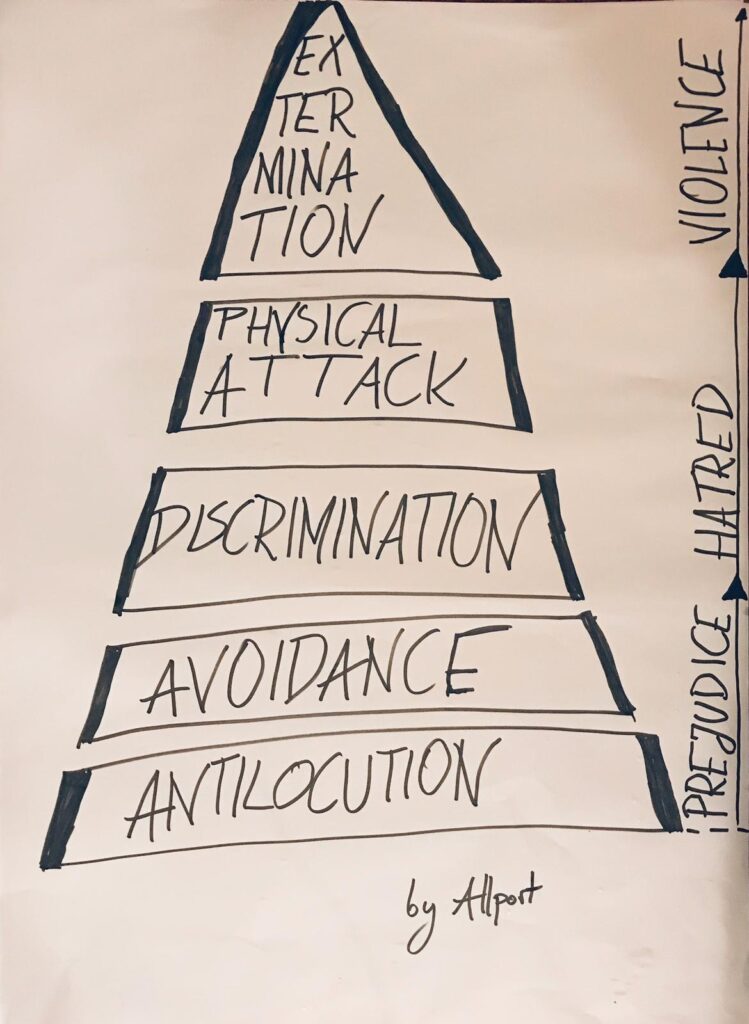
SŁOWNY BRAK AKCEPTACJI = ANTILOCUTION
hate speech, language of exclusion, language of hostility, disseminating myths/stereotypes/hearsay, malicious jokes, display of concealed or indirect prejudice
UNIKANIE = AVOIDANCE
marginalisation, isolation, dehumanisation, demonisation
DISCRIMINATION
inferior treatment, unequal treatment, exclusion, persecution
PHYSICAL ATTACK
assault, acts of vandalism, rioting
EXTERMINATION
assassination, genocide, arson, bombing attacks
PREJUDICE -> HATRED -> VIOLENCE
For the past two weeks I’ve been suffering from stomach-ache. Marta Graham again, but not in Lamentation this time, but in contraction.
My instinct whispers: ‘Get the fuck out of this country.’ But this is my country and I won’t run from it. When I get back from the tour, I will do something about this. I promise.
This really is the last moment to do something.
E
OV
OFL
PYRAMID
4 September 2020
PS. There was a wonderful atmosphere at the Kaleidoscope Festival: after the Covid-19 suspension of festival and dance life in Poland, we all jumped at each other like hungry dogs. The audience is wonderful, safe environment, the city running on the last bits of still holiday energy, as if nobody gives a f..ck on politics. I am probably in a sociological bubble and if I went to a different pub than the post-performance conversation space, maybe it would be lost as well. But so far, let’s this moment of normality last… hold on.
5 September 2020
PS.2. My joy lasted two days: at the other end of the country, in my home town Krakow where I run workshop right after festival, the first image that greeted me were the (in)famous banners on the “LGBT Lobby”, right next to St. Mary’s Church, and held by two young men with a radiant smile.
7 September 2020
I’m packing for the Carcassonne Dance Festival in France. I fantasize and visualize Emmanuel coming to our show and adopting me like Madonna did her kids. Renata, who studied in Montpelier and her husband is French, she sends me maps of French regions in which it is worth establishing a settlement.
* ‘OM’ resides between green and blue
Polish version
download PDF
The Art
of Listening
Easy or not so much?
Listening seems dead simple, doesn’t it? But is it really? Check with some short exercises. Spend one minute experiencing it. I will set our timer. Don’t do anything during this time, just listen to the sounds of the world you are in. Your only task is to listen. And then we continue.
…
So, how was it? When I first did this exercise, it seemed to me that this was the longest minute in my life! I recalled a long list of things I had to do and my thoughts were running towards planning and recalling events from the previous day. I started feeling annoyed that I was wasting my time and actually became a little bored. It is not easy to focus attention on the very physical act of listening, let alone when the other side is a living person, and when we want them to show that they matter to us. Or even worse, when we don’t agree with them at all!
Just Listen
Are you surprised by the fact that the most valued conversation is the one where people feel that somebody is “simply” listening to them? The need to be listened to is connected with a strong sense of acceptance, respect, being taken into consideration. When – for instance – I conduct mediation, even in the most difficult matters, there is a moment when one side becomes curious to hear what the other side is saying. Do you know when? When a given side feels heard. When they are not heard, emotions like grief and anger or fear are on the surface.
Often, reproaches about a lack of understanding concern the quality of being listened to. “You don’t understand anything at all”, is quite frequently a complaint that somebody avoids eye contact during a conversation, or glances at the newspaper or phone, averts their eyes and does something else or pretends that they are listening but in fact all they want to do is force their solution. When somebody has the impression they are not being listened to, anxiety can be triggered, lowering self-evaluation, and there is a rapid drop in this person’s willingness to connect with the other side and even to consider them. It is worth remembering that listening has rewarding and empowering significance and is an effective motivational tool.
When are we sure that somebody is listening to us? This is my list of signals of mindful listening.
“The Happy Seven”
things to be a Good Listener
1. Being silent
The first prompt is slightly banal, but proven: speech is silver, silence is gold. When you listen, the majority of your attention is focused on the interlocutor, so by the force of things, you use fewer words. Have you noticed that closed-mouth people are usually believed to be the best listeners?
2. Nurturing connection
The second one seems quite obvious: people tend to believe that we are listening to them when we are in eye-contact with them and we send non-verbal signals of our interest (nodding the head, leaning forward towards the listener, facial gestures in harmony with what we are hearing, focusing on the person speaking). Still, it is not so simple. Everyone of us, with a million things on our mind, their own views on life, a ton of unfulfilled needs, loads of “distractors” (during a conversation can you stand the sound of the phone ringing and not being picked up?) and to top it all – little time, knows how difficult it is to be in full connection and mindful for a longer time in a conversation. It requires quite a bit of energy! Next time when somebody listens to you with their whole self, treat it as a beautiful gift.
3. Following the interlocutor
We very often think that we know our interlocutor, so we know what they feel, think and need. Secondly – that during the conversation we think we also have to take a stand, to do something, we have to help. We don’t. People don’t always expect advice. When somebody expects it, they ask for it themselves (“What would you do in my place?”; “What do you think about it?”; “What should I do?”). If people don’t ask for it, you can assume that this person simply wants to be listened to. This never hurts and is the sacred foundation for future conversation.
4. Helpful words
The fourth prompt leads us into the land of words. Just a small hint here. Although silence is gold, in order not to lose the track of the conversation or help another person get in contact with what’s important for them, it is sometimes worth using helpful phrases. They also give your interlocutor certainty that you are listening to them carefully.
Helpful phrases:
- So, let me just get it straight … (say it in your own words what you heard e.g. “Do I understand you well that in your opinion there are mistakes in this report?”).
- You said that … (say in your own words what you heard e.g. “You said that I made a lot of mistakes in this report…”).
- When you say … do you mean that … (and summarise from the conversation what is the most important and try to refer it to a specific detail, e.g. “When you say that I completely let you down, do you mean that I made a mistake in the report?”).
- From what I hear, … (refer to the emotional state of your interlocutor (e.g. “From what I hear I feel you are sorry”, “From what I hear, you are upset”).
- Summing up … (you collect information, e.g. “Summing up, I made two mistakes in this report, one is the data in the table, and the other mistake is the description, and I have to correct them within one hour”).
5. Understanding ≠ not agreeing
Sometimes we think that showing understanding means that we agree with something somebody says. But what about when we do not agree with the complete rubbish somebody says! Still, showing understanding means that our intention is to listen to how somebody sees a given issue without immediate evaluation. During difficult conversations it is hard to put one’s emotions on hold, not to start presenting your own standpoint, solve somebody’s problems, defend or accuse. If we do manage to have such a conversation, we tend to remember it for a very long time. Active listening with the intent to understand the other side is already giving somebody empathy, and this is one of the most magical of communication tools.
How to show understanding? Lucyna Wieczorek, my friend, the founder of the School of Empathy Trainers and author of a book on empathy “Don’t say ‘I am sorry’, don’t say ‘I love you’”, once shared with me a simple and effective sentence that most people take as a sign of understanding. The sentence is: “That’s awful”.
The next time your mother tells you about her back pain, and you feel like telling her she has only herself to blame because everybody has told her not to dig the garden, try to think how bad that sounds to someone with back pain. Try instead: “That has to be awful”. And then see what happens. I hope the conversation will take a different path.
If you want to show understanding, all QUESTIONS such as “I hear that you are sad about it”, “It must be hard for you now”, “That must be very unpleasant” etc, will also be useful. It is worth giving them a tentative go. Otherwise we might be perceived as wanting to “talk somebody into” feeling something or that we know better.
6. Expressing yourself
When practicing listening, a question often crops up: “Is there a place to present my point of view?” Yes, by all means! The possibility to express your feelings and needs is as important as listening to the other side. If you feel that you cannot listen to somebody any longer or that something has deeply moved you, say it openly (“You know what, I need a break for a moment, let’s come back to it later”; “What you say is difficult for me, I will try to listen to you to the end, because I want to understand you well”; “I hear your point of view. I see it differently. Do you want to know how it looks from my side?”).
7. Being aware of your own needs
Be a good listener and at the same time be good for yourself.
Nobody is perfect. If you get carried away and the conversation doesn’t go as you wanted, remind yourself that an important need wants a voice. Discovering it will help you come back to the conversation from a completely different place.
You have for sure by now noticed that in emotionally difficult situations we are able to listen actively only for a certain amount of time. Then we need somebody who will give us their attention and listen to us. If there are a lot of difficult conversations ahead of you (e.g. somebody in your family is seriously ill or when misunderstandings show up at work), take care of yourself and find another person who will have time and space for you.
When my father underwent serious surgery, I asked three friends to support me. I arranged with every one of them that I would be able to call and cry and share my fears, and that they would simply listen. I did not want to overwhelm others with continual sad phone calls. This proved to be very helpful – throughout this time I had the sense that I had somebody I could talk to and at the same time I was calm and I did not abuse anybody’s good will.
Exercise: The Magic of Listening
This is an exercise Lucyna Wieczorek shared with me, giving us a chance to feel the power and magic of listening in a tense situation, in a conflict or criticism:
You hear an accusation or words which hurt you. Give yourself a moment to react consciously, not automatically. Take a couple of deeper breaths. Try to hear what this person means. Repeat in your own words what you heard. At first, it might be difficult and you may feel higher tension, more emotions will show up, and as you go on listening the tension will decrease. Wait until the moment your interlocutor gives you a signal that they feel heard. You will recognise it by the fall in tension, a calmer tone of voice, a deeper breath, relaxation in connecting with the other person. Now there is the moment when you can ask the question: “Would you like to hear how it looks from my side?”
The Art of Listening is a chapter from the Polish book “Ewka what has bitten you? How to communicate and understand each other” by Ewa Tyralik-Kulpa.
Chi
This Chi tutorial is a short introduction to series of movement/breath exercises that articulate the spine, work the muscles, touch all the meridians and will raise your physical energy and your consciousness building strength and vitality.
camera/edit: Tori Lawrence (camera/edit)
Taking emotions
seriously
On empathy and politics
Enemies of democracy have always manipulated feelings. Yet what we need today is a passionate defense of liberal democracy and the liberal order. We also need to embrace the feeling of loss and translate it into something positive and enriching, into a feeling about political community: empathy.
The Listening
Station
Dear All,
Welcome to The Listening Station.
This is the place to listen to stories and
to tell stories.
You are invited to come in and listen or
To come in and tell me a story.
Any story
a funny story, a sad story,
a story from the past, a story from today, a story of the future,
your story, another’s story, any story.
I can listen to any language
however
I only understand English.
You are welcome to come under your real name or
Under any other name of your choice
You are welcome to leave your camera on or put it in the off mode
Dear Listeners,
This is a listening space – please mute yourself whilst you are in the room,
Let’s allow The Storyteller to continue without interruption.
and
When you want to tell the story ….
Please, write it down in the chat box
and prepare to be asked to be next …
Dear Storytellers,
Welcome!
Come in
Make yourself at home
relax
take a moment
Then
When you are ready & only when you are ready
Tell me a story
When you have finished please say “The End”
Stay with us to listen to other stories,
And of course, You may also leave.
now
let’s
breath deep and
listen
Story #1
Story #2
In-spiration
Ex-piration
Co-spiration
Inspiration, Expiration, Co-spiration is a somatic lecture, an online class and a choral experience of practicing gas exchange together.
Audio Recording
We cannot help but breathing. And still respiration is a movement, a rhythm and a nourishment, that changes with the stories we decide to tell about it.
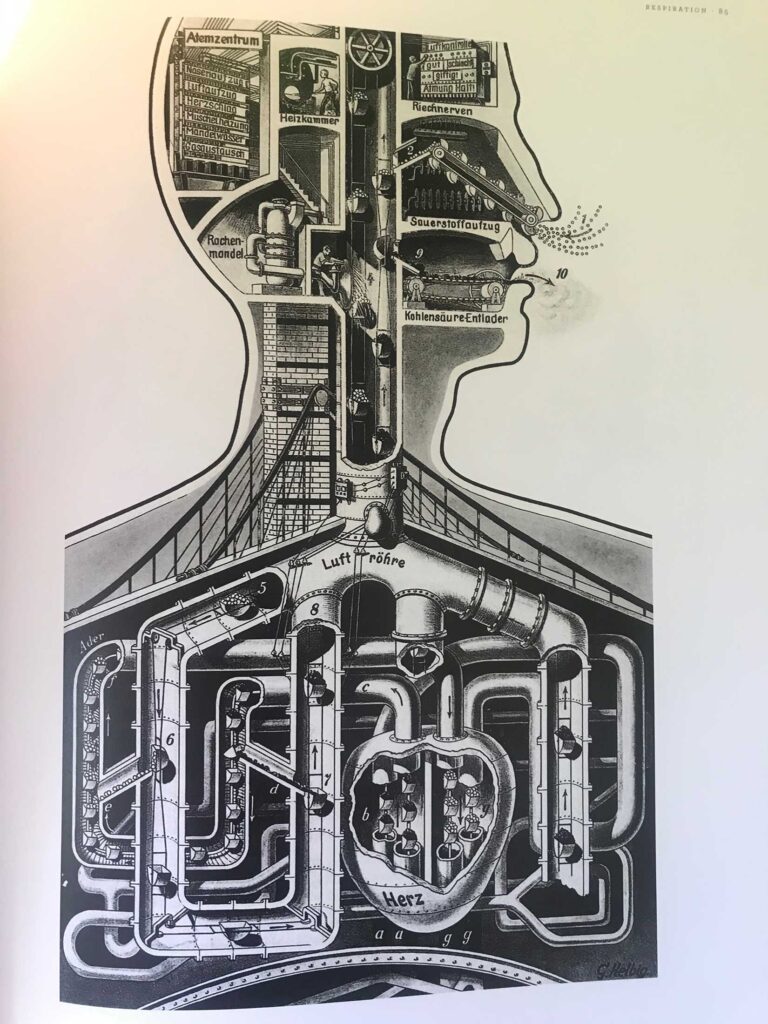
Body Industrial Palace by Fritz Kahn 
Plant Human Glass by Fritz Kahn 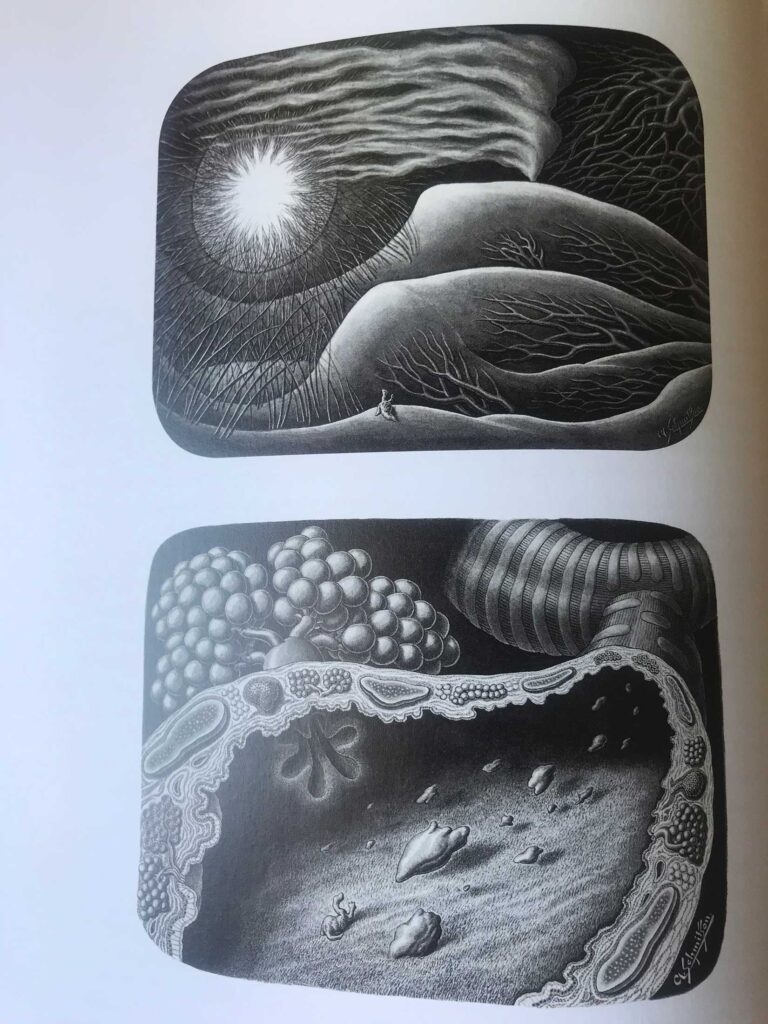
Inside of Nose by Fritz Kahn
Grand
VR Union

grand-vr-union.glitch.me
enter
We are recommended using Google chrome browser and using desktop computer/ laptop
Kick Off
Offerings
Planned initially as a live gathering, Grand re Union was slated to gather dozens of artists and thinkers of different disciplines in Poznan, Poland. The group was to spend 10 days full of dancing, thinking, talking and sharing practices, engaging in discussions, and exchanging ideas and dreams. To hold to the spirit of this initial idea, we invited this same group to virtually gather for a Zoom encounter on June 20th, 2020 and to make a small offering of something they would like to share with others on the occasion of inaugurating the project. Below are those offerings.
They are varied and personal ranging from food for thought, to poems, to physical scores. This collection is a manifestation of the belief that sharing is caring for each other. Please enjoy peeking into each of the pages below to meet a new person and engage their offering.
A
B
C
D
E
F
H
I
J
K
L
M
N
O
P
R
S
T
W
Z
On Art
& Activism
A Statement
Most of you have had a long commitment to activism, some of you have inspired my own, so I am not sure that I will be offering anything “informative” or revelatory, but perhaps this is a way to anchor us and to connect in this time of uncertainty – or more frankly, in a time of upheaval and chaos.
The past few weeks have been difficult and the complexity of my feelings cannot be overstated. Much of it I know is a deep ancestral sorrow that has been shaped by a long and relentless cruelty, by a bigotry that is both dehumanizing and crippling.
In this moment, we find ourselves in what Dr. King called the “Fierce Urgency of Now.” He said that “In this unfolding conundrum of life and history, there is such a thing as being too late. This is no time for apathy or complacency. This is a time for vigorous and positive action.”
This sense of urgency catapulted me into the center of protests that brought my body, my black body, into a space with others who demand justice and structural change in this country. For me it was not a choice, it was an act of survival. And it was an act of honoring my ancestors who struggled and died to ensure that I had a place at this virtual table.
But we are in a world of struggles – from police violence, to homophobia, to misogyny, to xenophobia, to racism, classism, fascism, genocide, poverty, climate change, extinction of the animals, and now all shrouded in a deadly pandemic. There is so much to do, so much to conquer that it is overwhelming and sometimes debilitating.
So what do we do? What can we offer as artists that can make a substantive contribution to political and social change?
All of us know that art making is not just about creating a product, a dance, or an event. It is a process through which we discover and understand ourselves and the world around us. But it is also a process where we transform concepts into embodied experiences that our audiences can feel and empathize with. This moment of exchange and shared experience with others, with an (intentional) assembled community, has the potential to shift personal and collective perspectives and create change, lasting change.
This is at the very root of activism, bringing people together to take action toward political and social change. Art has the capacity to humanize an issue, activism translates an issue into a concrete action that changes policy and social behaviors. Together they are a powerful force.
The idea of being an activist was always intimidating to me. I couldn’t get past the enormous responsibilities of organizing campaigns, meeting with political leadership, drafting manifestos and losing my privacy.
But once I understood that social change requires a sustained commitment (I believe a lifetime) and that the scale of my actions can be variable, many opportunities were revealed.
Here are a few examples:
I collaborate with others.
For the past ten years I have collaborated regularly with a civil rights law firm that works to influence legislation on issues and litigates cases that I feel are important. Where the law firm provides legal strategies aimed at ending discrimination and inequity, the art practice and body provide a poetic lens through which the issues can be viewed and understood empathically. The power of this combined force outweighs anything that a PowerPoint presentation can do in effectiveness. It offers an alternative mode of listening – to reach back into Lisa Nelson’s talk today on her Tuning Score.
I try to create a more thoughtful and extended engagement around performance.
In February I presented my work based on W.E.B. DuBois’ book The Souls of Black Folk in Great Barrington, Massachusetts, Dubois’ hometown. His book speaks so eloquently about the dilemma of the two identities that we, as African Americans, negotiate in this country and the tragic consequences it implies, particularly on black bodies which continues to be demonstrated. In collaboration with Jacob’s Pillow, The DuBois Center, the local NAACP and Multicultural Bridge, an audience engagement was created that included distributing 200 copies of DuBois’ book in the community prior to our performance. These books were read, re-read and passed on to others. As it turned out, the majority of our audience had read the book, had discussed it extensively in small groups, which in turn created a deeper discussion about race in the community circles afterward.
I don’t have to move a mountain. Activism can be small, but still resonant and impactful. Our bodies can be a site of our activism.
I am mentoring several young beautiful women who are coping with coming of age in this crazy time. We dance together, discuss the challenges of the day and draw comfort and perspective from both personal experience and history. We walk in nature and remember that we are animals! We learn how to reclaim our breath stolen from the stress we are under; we examine how our bodies engage, respond to and record our histories; we wonder what movement patterns have been passed down to us over the generations? We concentrate on healing our bodies from holding the weight from 400 years of oppression.
There are many ways to be an activist.
The best start is to find your righteous self and include it in everything you do. Join others as there is plenty of evidence that there is power in numbers.
For my bit of activism for the day, I would like to add one assignment for all of us.
Ask yourself how you are as an individual, and as an artist, and how are we as a community of arts institutions participating in, support or benefit from white supremacy, oppressive capitalist structures, and from the convenience of our own ignorance (or blind-spots) that keeps us in a state of complacency.
How does this register in the way you move, the way you move in the world and in your communities.
Think about it, write about it, talk to others and make the changes and realign as you need to.
I’ll end with a quote by DuBois. It is from the last chapter of the Souls of Black Folk called The Sorrow Songs. He writes,
“Through all the sorrow of the sorrow songs, there breathes a hope – a faith in the ultimate justice of things. Thin minor cadences of despair change often to triumph and calm confidence. Sometimes it is faith in life, sometimes a faith in death, sometimes an assurance of boundless justice in some fair world beyond. But whatever it is, the meaning is always clear: that sometime, somewhere, men will judge men by their souls and not by their skins.”
Delivered at the inaugural Grand re Union online gathering, June 20, 2020
Wake Up
What is present for you in your thoughts, feelings, sensations? What is the question you are asking yourself these days? Write it down on a piece of paper and browse through a stock of magazines, newspapers, old books, flyers, teabags tags, random slips of papers, chocolate silverware that you already have. Notice what attracts your attention. Fish it out. Cut it out. Assemble it. Start putting it together in an order, experimenting with a kaleidoscope of configurations. What kind of images and stories arise on a paper? What are they telling you? Listen to their colorful response and take action.
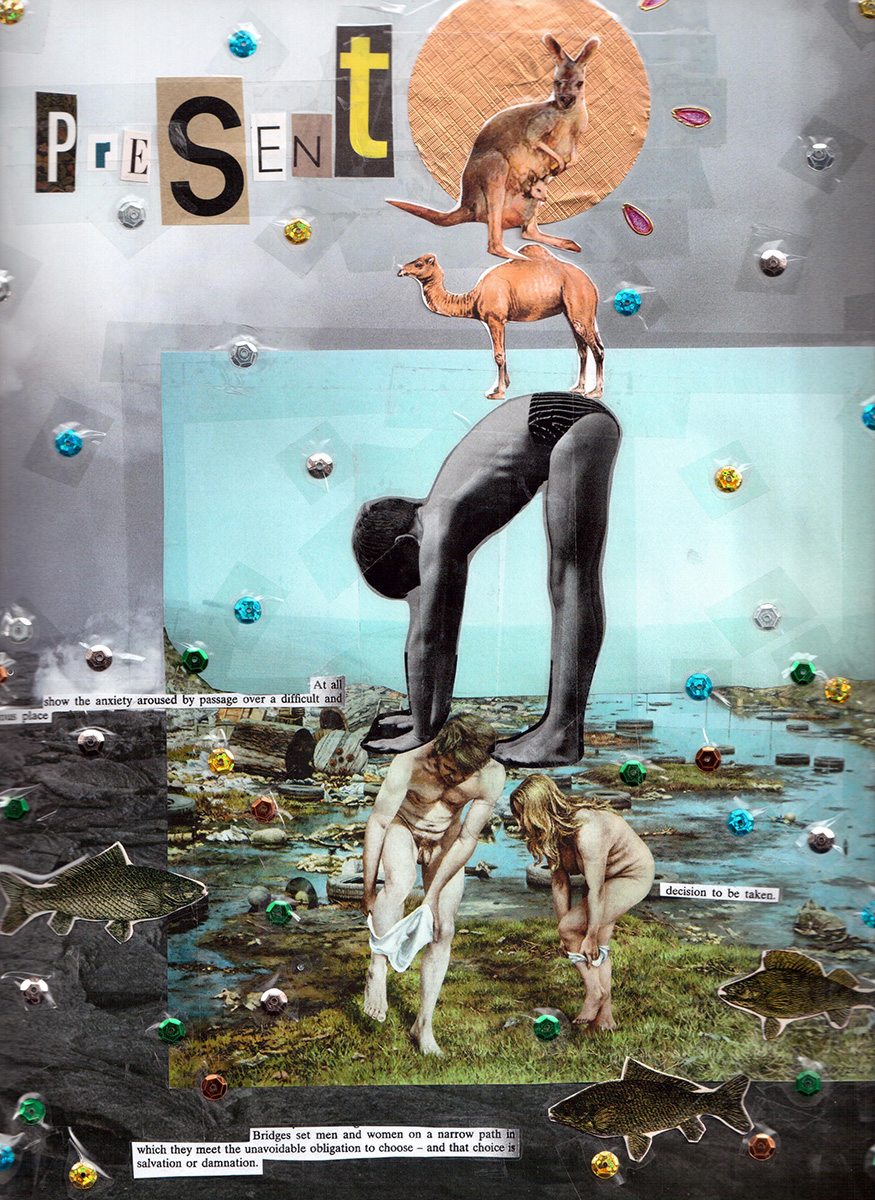
Sitting
and Breathing
to lengthen
spine practice
This practice can be done anywhere, at any time you find you have a few minutes to spend with your breathing.
Upwording
Transcript
Hello, Good afternoon, morning, evening – wherever you are in the world right now, listening,
I feel excited to be sharing with you my very first Audio Recording of Upwording, created for the launch of the online platform of the international, intergenerational conference the Grand Re Union.
My name is Rivca Rubin, I created Upwording in 2016, and further developed the practice with various fellow thinkers and practitioners. I like to particular thank my collaborator Charles Lauder for his ongoing support and engagement, and Simone Forti whose purely descriptive approach to giving feedback was a seminal experience for me back in the early 90’s, deeply informing my life.
This is the 1st of a series of podcasts to follow, it’s in 3 parts and subsections, about 45 minutes and true pandemic style – home recorded, on my mobile telephone, complete with technical imperfections, additional sounds :-)).
Part 1: A brief Introduction to Upwording
Part 2: The Practice. I will ask some Questions and invite you to make Notes of your responses
Part 3: Insights, Intentions & Invitations
Part 1: Introduction
Words create worlds and Words Change Worlds
“…it’s people and the oppressive systems they uphold that creates social division”
Charlene A Carruthers
We are living through a moment of unprecedented change, which holds the potential to abolish systems of superiority and oppression. The systems within which we have been living are neither inert nor inevitable. We can acknowledge our active part in co-creating and maintaining the worlds within which we would like to live.
“We cannot solve a problem with the same kind of thinking that created it”
Albert Einstein
I instigated Upwording, foregrounding focus on words and phrases habitual in our everyday communications, when I kept noticing how much we continue contradict ourselves, without even realising it.
Now I‘m telling you, don’t let anyone tell you what to do!
You Should never say should
Even in ‘Liberate yourself’ style books and podcasts:
To truly be in charge of your life, and stop doing what others tell you too, you must follow this seven-step program.
To liberate yourself from stress, you need to start doing abc, and you have to let go of xyz.
Why you should stop giving advice.
The way we think is shaped by our language and our language by the way we think.
Words and phrases are manifestations of learned, inherited concepts and beliefs milling about in our subconscious terrain and conscious minds. We may not have reviewed these for a long time to check if they actually align with our current ethos and intentions.
As much of the way we speak is habitual, it goes largely unnoticed that through our current use of language, we are inadvertently upholding systems many of us are seeking to dismantle. The practice of upwording starts with raising awareness of the underpinning concepts, intentions, and positions taken, implied in habitual words and phrases, and from here make active language choices to align our language with our intentions. This is crucial if our desire is for fresh thinking to create and support lasting change.
5.00 min
Part 2: The Practice
I will invite you to pause the audio by saying PAUSE.
Please take as much time as you like to respond, reflect and make notes before returning to play.
Let’s take a look at our daily communication with ourselves and each other.
Starting with this question:
How do you not like, want, or enjoy being spoken to?
PAUSE
I wonder if some of the following are among your list
Being ORDERED, PATRONISED, MANIPULATED, JUDGED, BLAMED, ACCUSED, THREATENED, IGNORED or not taken seriously. As if Stupid Wrong or Incapable.
How motivated into action, or to enter into conversation do you feel in response?
Not really? Not at all? You do it because you have to?
What are the actual words and phrases you hear when you feel:
ORDERED, PATRONISED, MANIPULATED, JUDGED, BLAMED, ACCUSED, THREATENED, IGNORED or not taken seriously.
Let’s unpack some of these and look at the terminology used.
In this first session, I will focus on examples of three of these themes:
Orders, Judgement, Blame
Gap
First Theme: ORDERS
Orders are Commands and Demands and include phrases such as:
YOU MUST …
YOU NEED TO …
YOU HAVE TO …
Do as you are told!
I invite you write down some of the things you have heard people tell you, you must, have to, or need to do.
PAUSE
And notice how you react.
Yes, it does somewhat depend on the context – with whom and where … I invite you to notice if you tend to veer to one of the following four more readily or frequently.
Do you tend to
REBEL!!!?
This can be a quickfire reaction. You may have wanted to do the task or wanted to engage, though now it’s definitely a NO! When ‘rebelling’ you may think, or even say out loud: Don’t tell me what to do!! Don’t speak to me like that!! Who are you to…? Excuse me?!
Or Do you tend to
RESIST!?
When resisting, you’ll do what is being asked, though slower, later, with less energy and zest…possibly with less care, quality, or accuracy.
You engage in the conversation and action, semi-willingly. You feel coerced to and it’s not worth the energy to address it otherwise.
And at some point, in the future, your pent-up frustration may build up into an outburst.
Or do you tend to
RESIGN…
When resigning, you give in.
You may be too afraid to say something, or feel it is your duty. You may feel you have no right or power to question or challenge; the consequences could be too high. Your response may be to cower.
Or do you REFUSE to engage?
You walk away
What drives these reactions. What’s going on?
Being or feeling ordered threatens some of our basic human needs, in particular
FREEDOM (in which case we REBEL)
EQUALITY (so we RESIST)
SAFETY (and we RESIGN)
WELL-BEING (we Walk Away)
Having explored your level of motivation and your responses to being ordered to do something,
Do you ever talk to yourself like this?
I must, I need to, I have to …?
Sometimes? Often?
How does it feel? What’s the Impact?
Do you find yourself Rebelling, Resisting or Resigning… (in response to yourself?
And Is there anything you, or we, actually have to do?
Let’s explore this
Do we have to get out of bed to go to work, or do we decide to get out of bed to go to work in order to bring in an income?
Do we need to or do we decide and choose to: exercise, eat, work, pay bills, apply for funding, file a report, do homework, rob a bank, walk the dog, meet friends, have a conversation, send emails, pick up the phone, turn up, get drunk, take a break, and so on and so forth.
When we tell ourselves it has to be done, according to whom does it have to be done? Who am I hearing in my head.Whose missives, orders or rules am I following?
You may have noticed how pressure and stress are fuelled, even induced, by an increase in musts, have to’s and should’s, especially when deadlines are looming, or something unforeseen happens. We currently live in a culture where ‘productivity’ is such a strong driver, and stress equates with productivity. Stress is almost celebrated. Yet, we know working under stress has high costs, affecting health and quality of life. Decisions are made hastily, almost everything becomes a ‘have to’. It can feel like living outside of ourselves.
“It’s not the load that breaks you down, it’s the way you carry it.”
Lena Horne
And we may really find ourselves in situations where we have little to no control over what happens to us. In this case, quoting Victor Frankl,
“The last of one’s freedoms is to choose one’s response in any given circumstance.”
Archie Williams, falsely imprisoned for a crime he didn’t commit for 27 year, released in 2019, asked ‘how did you get through’?
“Freedom is of the mind. I went to prison, but I never let my mind go to prison.”
And, do you ever talk to others in this way?
Do you ever unconsciously, or intentionally, coerce, try to force someone, by telling them: You must…, you need to… you have to do it now!
How effective is it?
And if you succeed, and you’ve ‘made them’ do it, is there a cost?
To them?
To you?
To you both?
So, on one hand, when it comes to ourselves we are quite clear about ‘Don’t tell me what to do!’
When it comes to others it seems quite easy to slip into versions of ‘Do as your told’, ‘Do as I tell you’.
And then there are the subtle versions of hierarchical positioning; I let you speak, allow them, we empower people, enable them, give them space …
And what about that hypothetical demand?
‘What you should do is…’, or ‘You should have done it like that’ or ‘It’s obvious, what should be done’
How do these land on you?
It can seem that the person delivering a should is taking a moralistic high ground; they know what is right, good or better for you and bestow their wisdom upon you. ‘Shoulds’ run a high risk of being heard as implications of stupidity, or wrongness when referring to something in the past. Especially when dispensing advice is un-invited.
and, do you ever ‘Should’ yourself?
Regularly?
And Is this internal moralistic voice effective?
Do you do as you tell yourself you should do? Willingly or Begrudgingly?
Or you just don’t seem to get around to doing it. And then do you feel guilty for not doing it, not keeping it up, doing it half-heartedly?
MORALISTIC ‘Shoulds’ and ‘should have dones’ beget resistance and can really breed guilt. And guilt festers.
15.53 min
How can we upword should’s, musts, have and need to’s?
To start with let’s ask:
Do I actually WANT to do this?
Am I / are we prepared to?
Would you be willing to… ?
And I may decide, No I don’t want to, I’m not willing to, actually I like to do it … differently.
A conscious YES choice sounds like:
We really want to do x,y,z
I will do it
I would love to…
I choose to go work because I love our holidays.
I am prepared to exercise regularly because I like feeling flexible and toned.
We want to complete the application because we like to launch the projects, and receive funding to do that.
I want to turn up to the meeting, I want to contribute and hear updates.
I pick up the telephone.
How does that sound and sit?
Instead of pressure and stress, there is a calm.
A friend once said:
“When I live out of having to, or need to, I externalise and give up control and responsibility. When I choose to, I take control of the task, and responsibility for the impact.“
We stand in choice
Note:
An exception around Musts, have tos, need tos, and Shoulds:
If your intention is to get someone to do something, to make them listen, tell them, force them, you are taking an authoritarian position
If instead you are inviting them to join you in something that you find really exciting or important, that is very different, and sounds more like: We must come together on this, we should not long to return, you really need to visit this place, hear this song, see that film. Those are impassioned, rallying invitations.
Here telling turns into inviting. We can really hear and feel the difference.
18.43 min
2nd Theme: JUDGEMENT
Judgments are Evaluations of a Person’s Identity, or Behaviour, Action or Event.
We might call them Labels, verdicts, even diagnosis.
The judgement is in the Dots that follow
YOU ARE… You are a …
IT IS… or That was …
You are the type of person who …
Question: What are some of the negative judgements you have heard people say to you that start with ‘You are…’? You are the type of person who …
PAUSE
And What are some of the negative judgements you have heard people say about the things you do, say, create, produce, like, believe, starting with: ‘It is…’ ‘The way you did that was…’ ! That’s just …. !
PAUSE
And How have you tended to respond when you’ve heard these?
Do you
Rebel ? Don’t tell me who I am, what I like, what i think … don’t squeeze me into a box. Did I ask you for your opinion?
Resist ? Well that’s only because …. , they give me all all the info, I think you didn’t see the whole thing, … that was an exception I’m not usually ….
Resign? You believe it, increasingly don’t trust your own sense of what you do. Your confidence in your abilities erodes.
Refuse to engage. You give no response, ignore the comment.
Do you ever judge or label yourself?
“I am a ….. I am a such a …. , I am not the kind of person who can … ” I’m rubbish at ….” I’ll never be a good …
What impact do these self-evaluations have on you?
I’d like to share a quote from Marshall Rosenberg:
“The most violent thing we can do to ourselves is to think about who or what we are.
The second most violent thing we can do to ourselves Is to think about what others think about who or what we are.
The third most violent thing we can do to ourselves is to feel guilty about thinking about what others think about who or what we are.”
And, Do you ever label and judge others?
“You are a …”
“You are this or that type of person”
As a …… you would think that, believe that
“They are … ”
They are not like us!
This is the basis of othering, and it’s divisive.
“Never be limited by other people’s limited imaginations.”
Mae Jemison
And let us not limit ourselves by job or vocational titles and role labels.
Judgements, labels, evaluations are assumptive, definitive and even predictive. These verdicts limit and divide us. If we believe them they can turn into self-fulling prophecies, and be crippling / debilitating.
“There is no view from nowhere.”
Honi Fern Haber
When Personal beliefs, preferences and opinions are presented as facts, or universal truths.
If I deliver my opinion as universal truth, I (consciously or unconsciously) I assume a hierarchical position as an expert, knowing what is great, terrible, the best, the worst, good or bad, right or wrong, normal or not normal. Notice how easy it is to be drawn into agreeing or disagreeing, be drawn into thinking of this or thatoption. Polarisations are often at play in this thinking, erasing variety and multiplicity. This can easily create static back and forth dialogues; That was a great event! No, it wasn’t, it was awful. And then we go into convincing: It was great because … . Well I thoughtit was awful because … . , back and forth and may end in, well … You’re are wrong, you don’t know what you’re talking about.
Sharing Upwording in many countries around the world, with people of differing ages, backgrounds, jobs, cultures, religions and political views …
I’ve not yet met anyone who says: “I know what I think and what I say is wrong.”
Each one of us believes in what we believe at that moment.
And what about Complimentary Positive Evaluations?
Even complimentary judgements can have a huge damaging impact. Hearing what a genius you are, or how amazing you are at something, can create massive pressure; pressure to perform, live up to, achieve, maintain. It becomes harder to accept anything less than perfect, and a fear of failure can seep in.
Positive judgements can also create dependency or addiction to external affirmation. What happens when there is an absence of; that’s a great question. Well done. You are amazing. The gold star.
Reward and Punishment strongly rely on these identity and behavioural evaluations.
You are bad and need to be reprimanded. If you do well, according to me, I will reward you.
Again to note: If my intention is just to express how much I enjoyed the film, rather than presenting my evaluation of it’s greatness as the truth, then this is likely to be heard as an expression of my enjoyment, regardless of the words I use.
How could we upword judgemental language?
First, I take OWNERSHIP of my PERSPECTIVE
quite simply by just describing what I see or saw, heard or noticed, liked or didn’t.
I saw ….
I heard …
I Experienced ….
I really enjoyed
I didn’t appreciate…
I noticed that for me…
I felt joy when I saw your painting, I really like it.
We could also add context and say:
‘From my view ….’ ‘I currently believe…. , and prefer…’
This is much more likely to facilitate an exploratory conversation where I hear your view, you hear mine, and we may even adapt our original takes. We remain open to listening, seeking to discover multiple views, perspectives and experiences.
27.50 min
3rd Theme: BLAME
And accusations
YOU MAKE ME FEEL xyz
THEY MADE ME DO …
It makes me ….
You give me no choice but to …
When someone says you made them feel or do x,y, or z, who are they holding responsible for their feelings, or actions? YOU! You therefore can and MUST change in order for them to feel or do differently. You most probably feel blamed for their feelings or actions.
How do you tend to react when feeling blamed or accused?
If you Rebel – your reaction may be quite retaliatory: How do you think you made me feel for the last year?!?!?
Resist
You may become defensive, begin to justify, explain, or deny your involvement, part or actions. It’s your problem, your fault, your mess! No I didn’t. It wasn’t me. Not my generation. That was decades ago.
Resign –
You apologise – believing it must be your fault. You may even apologise knowing it is not, simply to keep the peace.
In my experience, RESIGNING is the most erosive to our sense of self; it scrapes away at the confidence in your own actions and decisions.
You Refuse to engage altogether?
Question:
Can I really make you feel a particular feeling? Can I guarantee a particular feeling response?
Sure, we can aim to incite a response by what we say or do, the question here is: does everyone respond with the same feeling? Or do we each have different responses to the same stimulus: one person feels angry, another may be shocked, yet another sad or scared, and another may just shrug it off.
When I apportion blame for my feelings and responsibility for my actions to others, I render myself powerless, and disenfranchised to affect change. My feelings and actions are not in my control, they are created by others. It is your doing, it’s their fault. ‘They’ are to blame. When the power is over there, it is not here, “there is nothing we can do about it, they have to sort it out for us“.
This Cause – Effect thinking is the route of the blame seeking, and finger pointing, we have become so accustomed to in society. It can be quite inflammatory resulting in a battle, denial, and counter blames. We can see this in politics, social media, homelife.
The ‘cause’ is ‘my interpretation’ of your actions or words,
the ‘effect’ is how then ‘i choose to react’ to my interpretation of your action or words.
This is hugely informed by my particular layers of life experience.
Let’s hear that again in slightly different words:
My interpretation of your actions and words
informs what I feel and how I react
based on my personal life experiences.
And
“You don’t make progress when you stand on the sidelines, whimpering and complaining, you make progress by implementing ideas.”
Shirley Chisholm
NOTE:
Even when complimentary – ‘You made me feel really happy’ – I am placing the responsibility for my happiness outside myself.
This can incite pressure for you to maintain my happy feelings, and result in feeling responsible when I’m not feeling happy
We may also begin to believe that we can’t be happy without the other person, or their particular words or actions.
HOW DO WE UPWORD THIS?
Firstly, I check my intention when I want to share my feelings about something related to you with you:
Do i want to blame, accuse, shame, educate, reprimand or punish you?
In which case I will present my emotional state in a cause-effect statement, which will most likely result in your denial, justification, or counter blame…rather than conversation.
Or do I seek a conversation for us to find a different way to do this, a different approach in the future?
If so, I take the blame out of it, and shift the concept of
CAUSE & EFFECT to one of
RESPONSE to STIMULUS
I describe my response to the observation I made (not my interpretation).
Instead of ‘you made me feel…’ I say, ‘I noticed I felt… when I heard you say or saw you do … . Here i use the words I actually heard you say or describe what I saw you do. For instance, when I heard you say ‘go away’, or saw you leave the room while I was speaking with you, or noticed the report was not with me on Friday as we had agreed.
And then I ask what went on for you ?
I take interest in what took place for you. I become curious, rather than furious.
When heard, we tend to feel acknowledged and respected, and much more likely to engage in a conversation that can pave the way to co- explore an alternative, a way forward that suits us both, that can work for all involved. It may be immediate, It may take quite some time and negotiation, yet the very act of co-seeking solutions, moves us, together, co-choreographing potential scenarios and co-creating the future.
35.35
Part 3: Insights, Intentions, Invitations
I’ve not yet met anybody who feels motivated being ordered what do do (unless agreed to being ordered)
likes being judged negatively as to who or what kind of person they are, what they think, like and don’t like, feels supported when told how they should have done it, responds well to being blamed, engages constructively in conversation in response to being accused.
I’ve met many who say they accept being told what to do by a boss or parent, especially if it makes sense to them or if it is part of their job. And Still, they report a reduction in their motivation, when ‘being told’ rather than being asked.
I have met few who remain in the conversation with openness and curiosity, when accused or blamed. It takes a lot of deep breathing, mindfulness, emergency self-empathy, calmness and a super dose of ‘curious’ to remain grounded and take the opportunity to explore. That’s practice. That’s Upwording practice. Peeling off the delivery, to engage with the heart of the content. Courageous conversations.
So, coming to a close
To establish and maintain control, authoritarian systems require obedience, and the terminology to enforce it. Ultimately, the examples and themes we’ve covered in this session are verbal manifestation of these systems. Upwording addresses this terminology and suggests shifts that assist us in building more Egalitarian Systems and nurture Distributive power.
Let’s take the hierarchical rug out from under our feet
I invite you to Imagine
what could happen if we…Ceased promoting obedience,
And trust we can make conscious responsible choices mindful of others.
What could happen if we chose to leave behind the dualistic binary polarisations of right or wrong, good or bad, ideas of ‘normal’, positing our subjective preferences as the objective truth?
and make room for variety, multiplicity, shades, and become more comfortable with ambiguity, new to me, and not knowing yet ?
What could happen if… no one would blame anyone for anything?
If we took responsibility for our actions, decisions and feelings, responding instead of reacting.
And approached conversations with curiosity and the intention to co-create mutually agreeable solutions.
When upwording, curiosity and the want to explore are fundamental when communicating with others. Keeping these intentions alive in the face of criticism and challenges is crucial in the practice of Upwording. This means practising responding rather than reacting, inviting instead of telling, and describing replacing interpreting. From what I have learned and experienced when observing and mediating conflicts, the yield to adapt thinking and change behaviours, comes about when the person feels heard, respected and accepted because someone really listens with kind ears and an open heart. Then realisations and epiphanes land or arise.
Changing habits requires conscious effort and motivation. UPWORDING IS the practice to do this…
Through upwording we can Raise our Awareness and curiously question our Position, Attitude and Approach, Concepts, Words and Phrases
Moving ‘From Power Over to Power With’ Mary Parker Follett
Upwording is a radical liberatory practice, rooted in Non-Violent Communication and informed by many approaches, and thinkers to whom I remain grateful for their contributions.
I leave you with this quote by Sonya Renee Taylor
“We will not go back to normal. Normal never was. Our pre-corona existence was never normal other than we normalized greed, inequity, exhaustion, depletion, extraction, disconnection, confusion, rage, hoarding, hate and lack. We should not long to return, My friends. We are being given the opportunity to stitch a new garment. One that fits all of humanity and nature.”
We can solve these problems with different thinking to the one that created them.
Upwording can lift our thinking quickly, facilitating a collective re-imagining of what else could be possible, to action towards more satisfied, invigorated and sustainable interactions; relationships; family lives; workplaces; societies; cultures; a desirable global world for all.
Words change Worlds
mine – yours – ours
if you would like to join upwording practice sessions, please visit upwording.com or
email [email protected] for details.
They are weekly, co-led, and launch Friday July 3rd 16.00 CET, 15.00 GMT. And they are free :-)).
Thank you so much for listening and engaging.
43.46 mins plus pauses
Moving
the Mirror
2020
Moving the Mirror is an ongoing improvisational performance project initiated by Peter Pleyer in 2016. It brings together dance artists from Warsaw and Berlin and it was performed in Warsaw, Wrocław, Poznań and Berlin. This video – as an alternative to a real meeting – was commissioned especially for The Kick Off Issue of the Grand re Union Magazine.
Moving the Mirror (2016)
Production: Art Stations Foundation, Poznan & Center for Contemporary Art Zamek Ujazdowski, Warsaw
Project curated by Joanna Leśnierowska (ASF & Agnieszka Sosnowska (CSW)
Moving the Mirror special edition 2020 for Grand re Union
elsewhere
and otherwise
pon., 13 cze 2020
liebe agata,
my name is veronika blumstein. I live in southern california. such critical times here. I’ve been gone for so long. how can I really know what’s happening there if I’m here and vice-versa.
peter says we must connect.
i hear you are living in exile and making potent work in berlin.
shall we exchange?
veronika
* since 2006, karen schaffman channels the ghost of veronika blumstein. veronika braves the world dis/order by magnifying dance as a path for experiential transformation. together, karen and veronika imagine and weave historical docu-fictions of traumatic histories into choreographic possibilities.
** veronika blumstein emerged in 2005 during an international exchange between artists in the small village of jagniatkow (poland). funded by the german kulturstiftung des bundes. a group of international-european dancers, choreographers, and theoreticians gathered for a 2-week residency in an attempt to break boundaries beyond national and aesthetic differences. After conflicting ideas inhibited critical dialogue, three of the participants (kattrin deufert, thomas plischke, and pawel gozlinksi) turned to the local church’s patroness st. veronika in hopes that she might rattle the direction of the research. veronika blumstein was conceived, a jewish child who miraculously survived the European holocaust. veronika seized the artists’ imaginations as a vehicle for creative research.
june 13, 2020
liebe veronika,
forgive that i am responding just now. my internet access got cut, my mobile was confiscated as well as my belongings. i spent last 48 hours at the police station. long story.
i am extremely tired, i have a vertigo in my head. i feel a sweat on my t-shirt though i took a shower three times today. i can’t be a good companion for you today.
my make-up is falling from my face.
till soon, dear veronica
agata agata agata*
* agata siniarska is an imaginary character with many talents and a criminal past. She is interested in fiction as a useful instrument for imagining other, possible, future worlds and, hence how it can affect the world today.
pon., 14 cze 2020
liebe agata agata agata,
shit. no need to apologize…i sensed your dis/appearance into the critical conditions.
did the police touch you?
did they “handle” you?
push you to ground?
handcuff you?
feed you?
were you in a cell?
with whom?
what happened?
did they take fingerprints?
do you already have a record?
with love,
veronika
june 14, 2020
liebe veronika,
no, the police didn’t touch me. i am to the certain degree untouchable. my grandmother and my grandfather were working for KGB for many years, during the cold war.
my grandfather died at the beginning of the 70ties, the official information was that he committed suicide. as i said, it is an ‘official’ information.
being a granddaughter of the KGB spy makes me untouchable but kept under control thus sometimes the police, for no reason invades my house and takes me to the station. i got used to these procedures. all my family is on the list of the ‘potential danger’, i have no right to enter united states, my children probably will not see the statue of liberty either. i have never been to united states. i will never see california.
my mother just sent me the present for childrens day, of course it was opened, checked, scanned, etc. there were just leather gloves and for the state it means ‘danger’. many members of my family is/was involved in the arts, that was the best cover for the espionage. when i decided to be a dancer, my grandmother hugged me very strongly and whispered to my ears: ‘you are going to be excellent in this job’. she understood that i am going to continue the tradition of working for secret service. i was trying to explain her that i really want to be an artist. till her death she was hoping i have a double life…
tell me how did you start to dance?
when did you start to dance?
why did you choose it or how did it chose you?
love,
agata
pon., 15 cze 2020
dear agata,
right. there, KGB privilege. here, you and I, we can pass untouchable far more because we’re white. I’m glad you came out of a police exchange unharmed and alive. seems the government has evolved.
you ask if dancing chose me? I started to dance when I was lulled by “graj skrzypku, graj!.” This song played in our kazmierz apartment when my family reunited in 1946. My parents held me between them – very tight – while they wept and danced to polish tango in the small kitchen.
There was only folk dancing allowed during the time of the “people’s republic.” I didn’t like the verticality of the movement, and the shoes were horrible – so I took up gymnastics with spherical tumbling and bare feet. dancing as a force in my life emerged later, after I arrived in nyc in 1968.
oh agata, your grandmother’s whispers and embraces. I’m sorry to hear about your grandfather.
oh agata, art and espionage. double danger. tell me more about how dance is your weapon? yesterday i heard your dialogue on dance is a weapon tv: “on totentanz, dying and undead.” tell me why and when you began dancing? and tell me how you dance?
with love – for love, for the dead, for the living,
veronika
june 15, 2020
dear veronika,
i don’t remember why and when i started to dance. i always wanted to be an architect. i wanted to create spaces for people and between people. it turned out that dance and choreography is not that far from this idea. i place my choreographic practice in a deep interconnectedness between how do we think about the world and how we move through it. it is a place of intersection of somatics and politics – the place where bodily perception meets social engagement – between the somatic landscapes and the environmental landscapes, between the bodies of humans and non-humans.
since few years i am tracing the movement of the entangled contemporary world wrought by climate change, toxic drift, deforestation, oil spills, and the environmental aftermath of war. i am looking at this chain of dependencies from the choreographic perspective, analyzing the movement of our activities and our connections, to gain an ecological awareness through dance practice, asking questions how dance can contribute to the ecological debate, how the ecological processes can be addressed through the performer’s body, what kind of knowledge can we access through the dancing body, how and through which choreographic strategies can i make the violence detectible.
dance is my ‘weapon’ – this sentence comes from my dear friend and comrade, kasia wolinska. i understand the strength of the word ‘weapon’ – there is a fight inscribed in it. I usually say ‘tool’ but I wish to think of it as a ‘bag’, like in ursula le guin’s a carrier bag theory of fiction. Do you know this text?
sending you love from berlin,
agata
Embracing
Complexity
Embracing Complexity introduces the concept of Radical Sociability; a strategy for enacting an intersectional affinity based politics. It is recommended to download the audio file and take a walk with it someplace where you will have little distraction, and hopefully some greenery.
This piece draws on my research and includes many references from contemporary writers. For ease of listening in this format, not all references have been listed in the sound piece, but please see here for a list of quotes and acknowledgements.
I intend on continuing this research, and am very much aware of gaps in my own experiential knowledge. If you have feedback or comments, please get in touch to discuss: [email protected]
The soundtrack features music from: Lamin Fofana, Michael Valentine West, Gamelan Nyai Saraswati, JoAnn McNeil, Likhona Camane, Barraco Barner, Russell E. L. Butler, Forest Management, KMRU
Please visit a full list with links to support the artists directly.
A New Kind
of Wildness
The Rite of Spring and An Aesthetics of Bewilderment
Jack Halberstam, Professor of Gender Studies and English at Columbia University, offered this lecture on The Rite of Spring by Nijinsky and Stravinsky at CounterPulse in June of 2020. Halberstam explores issues at the intersection of queer theory and wildness/modernity.
This lecture is related to a chapter in Halberstam’s latest book, forthcoming in October 2020 from Duke UP is titled Wild Things: The Disorder of Desire. Halberstam is now finishing a second volume on wildness titled: The Wild Beyond: Music, Architecture and Anarchy.
Kick Off
music: Haunted Me – Clearing At The End Of The Path (freemusicarchive.org)
